FEATURING 345 Industry-First Reviews of Fiction, Nonfiction, Children’s, and YA Books


TOMMY ORANGE RECKONS WITH PAST AND FUTURE
The author of There There delivers a stunning novel that is both prequel and sequel
MARCH 1, 2024 | VOL. XCII NO. 5




 FROM THE EDITOR’S DESK
FROM THE EDITOR’S DESK
OPENING DOORS FOR NATIVE AMERICAN LITERATURE
AS WE WERE WORKING on this issue in late January, acclaimed novelist and poet N. Scott Momaday died at his home in Santa Fe, New Mexico, at the age of 89. Momaday, a member of the Kiowa tribe, was the first Native American writer to win the Pulitzer Prize in fiction, for his 1968 debut, House Made of Dawn . The novel tells, in lushly poetic prose with a roving POV, the story of Abel, a young Native man who grows up with his grandfather on the reservation, serves in World War II, and returns to seek his place among his people and in the larger world.
At the time, relatively few Indigenous writers had been published by mainstream houses (House was released by Harper & Row). A New York Times reviewer smugly
declared that “American Indians do not write novels and poetry as a rule, or teach English in top-ranking universities”—Momaday taught at UC Santa Barbara—before conceding that the book was “superb in its own right.” The novel certainly impressed the Pulitzer fiction jury, who praised its “eloquence and intensity of feeling, its freshness of vision and subject [and] its immediacy of theme,” heralding the “arrival on the American literary scene of a matured, sophisticated literary artist from the original Americans.”
Momaday opened the door for wider recognition of Indigenous writers such as Leslie Marmon Silko, Joy Harjo, Louise Erdrich, and the novelist who appears on the cover of this issue,
Frequently Asked Questions: www.kirkusreviews.com/about/faq
Fully Booked Podcast: www.kirkusreviews.com/podcast/
Advertising Opportunities: www.kirkusreviews.com/book-marketing
Submission Guidelines: www.kirkusreviews.com/about/publisher-submission-guidelines
Subscriptions: www.kirkusreviews.com/magazine/subscription
Newsletters: www.kirkusreviews.com
For customer service or subscription questions, please call 1-800-316-9361
Tommy Orange. (His portrait was illustrated by Dena Cooper.) Orange was just 36 when his first novel, There There, took the literary world by storm with its portrait of so-called urban Indians, following a wide range of characters as they prepare for a powwow in Oakland, California, an event that will be marked by a stunning act of violence. There There was a finalist for the Pulitzer Prize and a national bestseller.
Now Orange is back with Wandering Stars (Knopf, Feb. 27), a sweeping novel that is both prequel and sequel to the earlier work. The book traces the lineage of the Bear Shield and Red Feather clans back to Jude Star, a survivor of the Sand Creek Massacre of 1864 and the era’s white-run boarding schools, where the mission was to “kill the Indian, save the man.” Readers also learn what happens to Orvil Red Feather and his extended family in the wake of the powwow shooting. In a
starred review, Kirkus calls it a “searing study of the consequences of a genocide.” Read about the genesis of the novel in Orange’s interview with contributor Mark Athitakis on page 10.
Could the gatekeepers of the publishing world again be opening doors to more fiction by Native writers? Recent years have offered some hopeful signs: Morgan Talty’s 2022 story collection, Night of the Living Rez (Tin House), won the National Book Critics Circle’s John Leonard Prize, and Amanda Peters’ 2023 novel, The Berry Pickers (Catapult), received the Barnes & Noble Discover Prize and the American Library Association’s Andrew Carnegie Medal. Talty’s first novel, Fire Exit (Tin House, June 4), is one of the most highly anticipated books of 2024. Momaday’s legacy lives on.

TOM BEER
KIRKUS REVIEWS
Illustration by Eric Scott Anderson

MARCH 1, 2024 1 KIRKUS REVIEWS Contents Interested in reprints, permissions, licensing, or a framed review? Please contact The YGS Group at 800.290.5460 or email Kirkus@theygsgroup.com. KIRKUS REVIEWS (ISSN 1948-7428) is published semimonthly by Kirkus Media LLC, 2600 Via Fortuna, Suite 130, Austin, TX 78746. Subscription prices are: Print and digital subscription (U.S.) 3-month ($49), 12-month ($179) | International subscriptions are $79 quarterly and $229 annually. All other rates on request. Periodicals Postage Paid at Austin, TX 78710 and at additional mailing offices. PURCHASE BOOKS ONLINE AT KIRKUS.COM ON THE COVER: Tommy Orange, illustration by Dena Cooper, based on a photograph by Michael Lionstar. Background by nadtytok on iStock. One of the most coveted designations in the book industry, the Kirkus Star marks books of exceptional merit. OUR FRESH PICK A writer and artist navigates her Thai and American heritage. Read the review on page 93. FICTION 4 Editor’s Note 5 Reviews & News 10 On the Cover: Tommy Orange 23 On the Podcast: Venita Blackburn 35 Booklist: Novels You Can Read in a Weekend NONFICTION 46 Editor’s Note 47 Reviews & News 52 Q&A: Steve Coll 65 On the Podcast: Curtis Chin 83 Booklist: Books You Never Want To End CHILDREN’S 92 Editor’s Note 93 Reviews & News 112 Profile: G. Neri 123 Booklist: Out-of-This-World SF & Fantasy Tales YOUNG ADULT 138 Editor’s Note 139 Reviews & News 144 Q&A: Traci Chee 157 Booklist: Absorbing Graphic Novels INDIE 158 Editor’s Note 159 Reviews

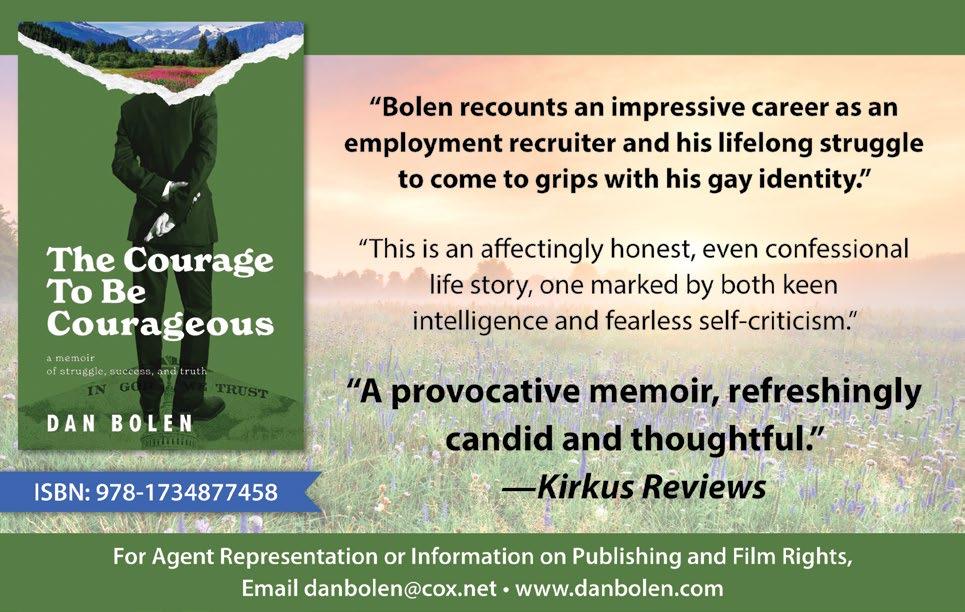
Co-Chairman
HERBERT SIMON
Publisher & CEO
MEG LABORDE KUEHN mkuehn@kirkus.com
Chief Marketing Officer SARAH KALINA skalina@kirkus.com
Publisher Advertising & Promotions RACHEL WEASE rwease@kirkus.com
Indie Advertising & Promotions AMY BAIRD abaird@kirkus.com
Author Consultant RY PICKARD rpickard@kirkus.com
Lead Designer KY NOVAK knovak@kirkus.com
Social Media Coordinator SEYANNA BARRETT sbarrett@kirkus.com
Kirkus Editorial Senior
Production Editor ROBIN O’DELL rodell@kirkus.com
Kirkus Editorial Senior
Production Editor
MARINNA CASTILLEJA mcastilleja@kirkus.com
Kirkus Editorial Production Editor ASHLEY LITTLE alittle@kirkus.com
Copy Editors
ELIZABETH J. ASBORNO BILL SIEVER
Magazine Compositor NIKKI RICHARDSON
Co-Chairman MARC WINKELMAN
Editor-in-Chief
TOM BEER tbeer@kirkus.com
President of Kirkus Indie CHAYA SCHECHNER cschechner@kirkus.com
Nonfiction Editor ERIC LIEBETRAU eliebetrau@kirkus.com
Fiction Editor
LAURIE MUCHNICK lmuchnick@kirkus.com
Young Readers’ Editor LAURA SIMEON lsimeon@kirkus.com
Young Readers’ Editor
MAHNAZ DAR mdar@kirkus.com
Editor at Large MEGAN LABRISE mlabrise@kirkus.com
Senior Indie Editor
DAVID RAPP drapp@kirkus.com
Indie Editor ARTHUR SMITH asmith@kirkus.com
Editorial Assistant NINA PALATTELLA npalattella@kirkus.com
Indie Editorial Assistant
DAN NOLAN dnolan@kirkus.com
Indie Editorial Assistant SASHA CARNEY scarney@kirkus.com
Mysteries Editor THOMAS LEITCH
Contributing Writers
GREGORY MCNAMEE MICHAEL SCHAUB

Contributors
Alana Abbott, Colleen Abel, Mahasin Aleem, Jeffrey Alford, Paul Allen, Kent Armstrong, Nada Bakri, Robert Beauregard, Thomas Beheler, Heather Berg, Kazia Berkley-Cramer, Elizabeth Bird, Sarah Blackman, Amy Boaz, Elissa Bongiorno, Rhea Borja, Kimberly Brubaker Bradley, Melissa Brinn, Jessica Hoptay Brown, Madeleine Brown, Cliff Burke, Timothy Capehart, Catherine Cardno, Tobias Carroll, Ann Childs, Alec B. Chunn, Anastasia M. Collins, Emma Corngold, Jeannie Coutant, Kim Dare, Maya Davis, Michael Deagler, Cathy DeCampli, Steve Donoghue, Melanie Dragger, Anna Drake, Gina Elbert, Lisa Elliott, Lily Emerick, Joshua Farrington, Rodney Fierce, Katie Flanagan, Hillary Jo Foreman, Cynthia Fox, Mia Franz, Ayn Reyes Frazee, Harvey Freedenberg, Jenna Friebel, Nivair H. Gabriel, Elisa Gall, Laurel Gardner, Maura Gaven, Jean Gazis, Carol Goldman, Amy Goldschlager, Danielle Galván Gomez, Melinda Greenblatt, Christine Gross-Loh, Tobi Haberstroh, Geoff Hamilton, Sean Hammer, Silvia Lin Hanick, Alec Harvey, Peter Heck, Mara Henderson, Katrina Niidas Holm, Natalia Holtzman, Yung Hsin, Abigail Hsu, Kathleen T. Isaacs, Darlene Ivy, Wesley Jacques, Kerri Jarema, Lenna Jawdat, Jessica Jernigan, Danielle Jones, Betsy Judkins, Mikayla Kaber, Deborah Kaplan, Tracy Kelly, Ivan Kenneally, Colleen King, Katherine King, Andrea Kreidler, Alexis Lacman, Carly Lane, Christopher Lassen, Tom Lavoie, Judith Leitch, Elsbeth Lindner, Coeur de Lion, Barbara London, Patricia Lothrop, Georgia Lowe, Kyle Lukoff, Leanne Ly, Sandy MacDonald, Kirk MacLeod, Joan Malewitz, Thomas Maluck, Collin Marchiando, Michelle H Martin, Gabriela Martins, J. Alejandro Mazariegos, Kirby McCurtis, Breanna McDaniel, Jeanne McDermott, Sierra McKenzie, Zoe McLaughlin, Noelle McManus, Kathie Meizner, Susan Messina, J. Elizabeth Mills, Tara Mokhtari, Lisa Moore, Andrea Moran, Ari Mulgay, Christopher Navratil, Liza Nelson, Mike Newirth, Therese Purcell Nielsen, Katrina Nye, Erin O’Brien, Tori Ann Ogawa, Connie Ogle, Mike Oppenheim, Andrea Page, Derek Parker, Sarah Parker-Lee, Hal Patnott, Deb Paulson, John Edward Peters, Justin Pham, Jim Piechota, William E. Pike, Margaret Quamme, Judy Quinn, Kristy Raffensberger, Darryn Reams, Arianna Rebolini, Amy Reiter, Amy B. Reyes, Jasmine Riel, Kelly Roberts, Lauren Roberts, Amy Robinson, Lizzie Rogers, Kristina Rothstein, Lloyd Sachs, Bob Sanchez, Caitlin Savage, Meredith Schorr, E.F. Schraeder, Hal Schrieve, Gene Seymour, Jerome Shea, Polly Shulman, Sadaf Siddique, Linda Simon, Julia Sirmons, Jennifer Smith, Wendy Smith, Leena Soman, Margot E. Spangenberg, Daneet Steffens, Sharon Strock, Mathangi Subramanian, Wendy Thomas, Bill Thompson, Caroline Tien, Renee Ting, Martha Anne Toll, Valeria Tsygankova, Jenna Varden, Katie Vermilyea, Laura Villareal, Christina Vortia, Erica Weidner, Audrey Weinbrecht, Amelia Williams, Wilda Williams, Kerry Winfrey, Marion Winik, Dorcas Wong, Livia Wood
MARCH 1, 2024 3 KIRKUS REVIEWS

PROMISING DEBUTS (AND ONE GREAT SECOND ACT)
EVERYONE LOVES A DEBUT, and here’s one that’s not an author’s but a publisher’s: Christina Hwang Dudley’s Pride and Preston Lin (March 19) is the first adult title from Third State Books, a new San Francisco –based publisher devoted to books from Asian Americans and Pacific Islanders. As you can tell from the title, it belongs to the far-from-new genre of Pride and Prejudice updates, and “a new one has to be truly special to stand out,” as our starred review points out. “This one is.”
Dudley’s heroine, Lissie Cheng, is balancing college with work at her aunt and uncle’s restaurant when she makes what could have been
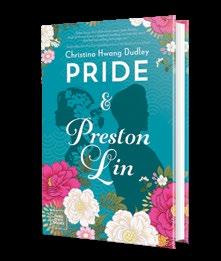
a terrible mistake: She serves a dish with hidden seafood paste to a customer with an allergy. The customer’s friend, full-of-himself Preston Lin, writes an article for the Stanford Daily excoriating Lissie and naming the restaurant. Will they get past their antipathy? Here’s a hint from our review: “Dudley’s contemporary [romance] debut is faithful to its source material but finds clever ways to make it work in a modern setting, while also adding an authentic Chinese American perspective.”
Leanne Toshiko Simpson’s debut, Never Been Better (Putnam, March 5), is a surprising combination of humor and insight, laughs

and pain. Dee Foster, who has bipolar disorder, met her two best friends in a psychiatric ward; now Matt and Nisa are getting married in Turks and Caicos, and Dee is determined to break them up. “Full of sharp, pithy dialogue and farcical scenes that will put a grin on your face, this story about love, friendship, and family also offers hard-won wisdom about mental health and the myths that surround it,” according to our starred review.
Having written two collections of short stories— Young Skins (2015) and Homesickness (2022)—Irish author Colin Barrett has now produced a debut novel, Wild Houses (Grove, March 19), that explores life on the unemployed fringes of rural Ireland. Dev Hendrick is a semi-orphaned 20-year-old living on the dole when he gets involved in his drug-dealing cousins’ scheme to extract money from


a former comrade, Cillian English, by kidnapping his teenage brother. “While focusing on one fraught weekend,” our starred review says, “Barrett takes the time to let the reader get to know the characters involved in this mess in all their complicated and sometimes heartbreaking glory.”
Second novels can sometimes get lost in the excitement over debuts, but I don’t think Xochitl Gonzalez has to worry about that happening to Anita de Monte Laughs Last (Flatiron, March 5), the follow-up to her acclaimed Olga Dies Dreaming (2022). It’s even more timely coming so soon after the death in January of Carl Andre, the sculptor whose acquittal for the murder of his wife, artist Ana Mendieta, provided Gonzalez’s inspiration. In 1985, Anita de Monte is an artist whose success threatens the ego of her husband, Jack Martin, a more famous artist. In 1998, Raquel Toro is an art history student from a working-class Puerto Rican background who’s writing a thesis on Jack’s work some years after Anita fell out a window and died. Our starred review says: “An uncompromising message, delivered via a gripping story with two engaging heroines.”
LAURIE MUCHNICK
Illustration by Eric Scott Anderson
Laurie Muchnick is the fiction editor.
KIRKUS REVIEWS 4 MARCH 1, 2024
EDITOR’S PICK
A family rides the waves of current events and personal conflicts across three generations.
Readers of Kant’s Little Prussian Head & Other Reasons Why I Write (2020) will recognize the autobiographical elements in Messud’s novel, but they are less important than the compelling way she has reinvented her family as fully fleshed fictional characters.
Gaston and Lucienne
Cassare, a French Algerian couple uprooted first by World War II and then by Algerian independence, embody for their son, François, and daughter, Denise, a loving companionship so total that both children will spend their lives looking for its equal. Denise, whose personal attachments rarely work out, clings to her parents’ devout Catholicism; François might have made a
home in America—“its energy, its freedom, its carelessness” thrill him as an Amherst undergraduate—but his Canadian wife, Barbara, objects. Their peripatetic marriage survives her extended absences to care for her dying father in Toronto and the damage inflicted on his business career when she insists they leave Australia, but he can never get over the fact that Barbara always holds part of herself apart from him. Messud portrays the Cassares at key moments in their lives, beginning in Algeria as France falls in June 1940 and ranging across continents and seven decades: Geneva, Toronto, Toulon, Buenos Aires, suburban Connecticut, and New York—wherever their varied fortunes take them, with the author’s fictional stand-in, aspiring writer Chloe, and her sister, Loulou, entering as

This Strange Eventful History
Messud,
Claire | Norton | 448 pp.
$29.99 | May 14, 2024 | 97803936350415
schoolgirls in 1970s Sydney. Messud paints compelling portraits of internal conflicts and tangled relationships, dropping along the way tantalizing references to crucial events that will be clarified later, in a rich narrative that defies summary. The novel reaches a poignant climax as the older generations age and die: Gaston and François succumb to physical ailments; Lucienne and
Barbara descend into dementia. The marriage of François and Barbara, bitterly antagonistic but ultimately loyal, is perhaps the novel’s most wrenching depiction, but Messud’s gimlet eye and quietly masterful way with words make every character and incident gripping. Brilliant and heartwrenching; Messud is one of contemporary literature’s best.
These Titles Earned the Kirkus Star
6 The Ministry of Time By Kaliane Bradley 7 Sharpe’s Command By Bernard Cornwell 7 Weird Black Girls By Elwin Cotman 12 The Stolen Child By Ann Hood 18 Fervor By Toby Lloyd 5 This Strange Eventful History By Claire Messud 19 Daughter of Mine By Megan Miranda 21 We Were the Universe By Kimberly King Parsons 25 The Understory By Saneh Sangsuk; trans. by Mui Poopoksakul 30 I Hope This Finds You Well By Natalie Sue 31 Rainbow Black By Maggie Thrash 31 Long Island By Colm Tóibín 32 A Short Walk Through a Wide World By Douglas Westerbeke 33 Familiaris By David Wroblewski 42 The Familiar By Leigh Bardugo 43 The Weavers of Alamaxa By Hadeer Elsbai MARCH 1, 2024 5 KIRKUS REVIEWS FICTION
Stag
Bahr, Dane | Counterpoint (304 pp.) | $27.00
April 9, 2024 | 9781640096226
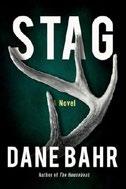
A retired sheriff and a former agent from the Drug Enforcement Administration team up in a remote corner of Washington state in pursuit of a psychopathic killer.
The year is 1989. Ex-cop Amos Fielding left his home in small-town Iowa following the death of his wife of nearly 50 years. He now lives “a life in suspension” on a ranch, where a horse and a mule are his only companions. One-time drug agent Dee Batey called it quits with the DEA after a horrific experience at the Mexican border, where he was shocked to discover that the swaddled babies on a bus were all dead and slit open for the smuggling of heroin. He is now a game warden. Against their will, Fielding and Batey are pulled back into the darkness when young women start turning up dead, ritualistically murdered (as we know from early on) by a twisted soul who films himself in the act. The local police chief is oddly indifferent to the killings, but the aging sleuths, who become fast friends, are able to get help from a quirky FBI agent out of Seattle. As disturbing as these crimes and this criminal are, we’ve seen them before. What sets the novel apart is the unshakable atmosphere of dread and remorse that Bahr sustains, whether the action is taking place in foreboding woods, unlit cellars, or abandoned warehouses. His follow-up to the horror-embracing The Houseboat (2022) grabs the reader with dark, poetic images, including recovering alcoholic Batey’s wish that his gardening wife “could pull out the weeds in me” and falling ashes appearing “like sheds of dead skin.”
Once you’re in the novel’s grip, it’s difficult to break free.
A predator thriller with a difference, by a rising star in the field.
Kirkus Star
The Ministry of Time
Bradley, Kaliane | Avid Reader Press (352 pp.) $28.00 | May 7, 2024 | 9781668045145
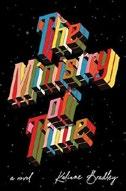
A time-toying spy romance that’s truly a thriller.
In the author’s note following the moving conclusion of her gripping, gleefully delicious debut novel, Bradley explains how she gathered historical facts about Lt. Graham Gore, a real-life Victorian naval officer and polar explorer, then “extrapolated a great deal” about him to come up with one of her main characters, a curlyhaired, chain-smoking, devastatingly charming dreamboat who has been transported through time. Having also found inspiration in the sole extant daguerreotype of Gore, showing him to have been “a very attractive man,” Bradley wrote the earliest draft of the book for a cluster of friends who were similarly passionate about polar explorers. Her finished novel—taut, artfully unspooled, and vividly written—retains the kind of insouciant joy and intimacy you might expect from a book with those origins. It’s also breathtakingly sexy. The time-toggling plot focuses on the plight of a British civil servant who takes a high-paying job on a secret mission, working as a “bridge” to help time-traveling “expats” resettle in 21st-century London—and who falls hard for her charge, the aforementioned Commander Gore. Drama, intrigue, and romance ensue. And while this quasi-futuristic tale of time and tenderness never seems to take itself too seriously, it also offers a meaningful, nuanced perspective on the challenges we face, the choices we make, and the way we live and love today.
This rip-roaring romp pivots between past and present and posits the future-altering power of love, hope, and forgiveness.
Reinbou
Cabiya, Pedro | Trans. by Jessica Powell
Astra House (224 pp.) | $26.00
March 12, 2024 | 9781662602511

Cabiya—a Puerto Rican writer who lives in the Dominican Republic—turns a military thriller about the 1965 Dominican civil war into a contemporary fairy tale about a young boy whose innocent goodness has the power to change lives.
The narrator of this novel, full of “disquisitions and digressions and detours,” is recounting these two stories to specific listeners. While their identities are not fully revealed until much later, from early on it’s clear that they’re hearing a braided tale about their father and grandfather. But this is no Princess Bride
The 1965 uprising was very real, and Cabiya offers an immersion into the Dominican Republic of the time and a history lesson on the U.S.’s problematic role in upending Dominican democracy. In this fictionalized version of events, American officers become involved in questionable schemes involving valuable gold ingots. As a result, heroic Dominican revolutionary leader Puro Maceta, a saintly (fictional) mix of Che Guevara and Jesus—both pointedly referenced in the novel—is betrayed by a Judaslike companion. Puro spends the last hours before his murder making love, and a decade later the son he and his beloved conceived is “perfect,” a mix of sweetness and wisdom beyond his years. Following rainbows caused by sprinklers on a golf course, which is coincidently owned by the people who caused his father’s death, 10-year-old Maceta finds small treasures, discarded everyday objects like a bird feeder, a bicycle chain, and a Magic 8 Ball, that inadvertently transform his neighbors’ lives; the notebook in which
KIRKUS REVIEWS 6 MARCH 1, 2024 FICTION
Maceta names and describes his discoveries is the book’s most charming element. But the villains from the war years continue to prey on Maceta’s neighbors in ugly ways involving sex and money until the convoluted plot concerning those still-missing ingots comes to fruition. Good and evil, love and violence are dualities at play as innocence is threatened but prevails. A sometimes angry, sometimes sardonic, but ultimately optimistic view of humanity.
Rough Trade
Carrasco, Katrina | MCD/Farrar, Straus and Giroux (384 pp.) | $28.00 | April 9, 2024 9780374272685
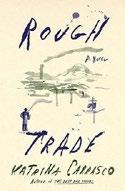
Carrasco revisits the world she created in The Best Bad Things (2018).
When this story begins, Alma Rosales has left her past behind and reinvented herself as Jack Camp, smuggler. In partnership with her former lover, she controls the flow of opium from Canada throughout the West Coast from her base in Tacoma. When a double homicide threatens to put her operation at risk, Alma thinks she has the situation in hand—until it’s clear that she does not. Then two newcomers arrive in town. One is her former partner from the Pinkerton’s Women’s Bureau. The other is a journalist whose interest in the opium trade might become a problem. Carrasco introduced readers to Alma in her last novel, and the sequel is a similar mix of gritty historical fiction and crime. She repopulates the past with the queer people and queer culture that have often been erased from history. Carrasco does a terrific job of conjuring a port city at the end of the 19th century. Her description of the physical world her characters inhabit is evocative, but the carefully rendered setting only underscores
their one-dimensional nature. It’s entirely possible that readers who enjoyed The Best Bad Things will want to know what happens next for its characters, but readers encountering them here for the first time may find them intriguing without being convincing. The author’s penchant for lingering over physical details also makes it difficult to appreciate this book as a mystery. The pace is just very slow—so slow that it’s not easy to stay invested in the story’s outcome. A novel that straddles a couple of genres without quite satisfying the demands of either.
Kirkus Star
Sharpe’s Command
Cornwell, Bernard | Harper/HarperCollins (320 pp.) | $30.00 | April 2, 2024 9780063219298

In Richard Sharpe’s 23rd adventure, he and his fellow British riflemen fight the French in Spain.
In the spring of 1812, General Hill sends Major Sharpe on a reconnaissance mission to check out key bridges across Spain’s wide River Tagus. One French army needs to cross it to regroup with Napoleon’s army to the north, so stopping that connection is crucial to the British. Sharpe is ordered “not to poke the wasps’ nest,” and his subordinate Lieutenant Love notes that the mission “calls for subtlety and forbearance.” But Sharpe sees the need for immediate action, so, like the daring commander he is, he disobeys orders. Blood flows aplenty as his riflemen and members of the Spanish resistance wreak havoc on the Crapauds (pardonnez-moi, that means Toads) with muskets, rifles, and cannons, while the French retaliate fiercely. On a broad scale, the story is about real events, but the layer of fictional characters brings it to life. First, Sharpe’s fans will remember that he’s the son of a prostitute and
is a “natural killer, whether with musket, rifle, bayonet or sword.” He’s married to Teresa, a beautiful and ferocious resistance fighter nicknamed La Aguja, or The Needle. Lieutenant Love, nicknamed Cupid, speaks tentatively and looks like he’ll be a liability but grows into his job. After a dramatic success, he cries out to Saint Barbara in heaven, “Oh Babs!…You glorious bitch!” Most colorful is the resistance leader El Héroe, who strains credulity with his windbaggery. “They fear me!…They stay in their forts and I rule the land!”
Apparently no one has ever seen him fight, and Sharpe’s men refer to him as El Cobarde, or The Coward. “I have the blood of kings and nobles,” he brags to Sharpe, who retorts, “Then I’m glad I’ve got the blood of the gutter in me.” Oh yes, and there’s El Sacerdote, the priest who “gives his French prisoners the last rites before he cuts their throats.”
Gripping action that’s not for the fainthearted.
Kirkus Star
Weird Black Girls
Cotman, Elwin | Scribner (320 pp.) | $17.00 paper | April 16, 2024 | 9781668018859

Seven long short stories that call into being worlds as fantastic as they are real.
As presaged by the title, the stories in Cotman’s fourth collection are splendidly strange. In “Weird Black Girls,” the narrator takes his ex-girlfriend on a trip to Boston, a tourist attraction ever since “the Rupture” in 1702 when “the settlement...rose like a finger pointing skyward to fix at a 45-degree angle above the earth,” an event supposedly caused by a Black witch named Annalee who may still roam Cambridge’s uncanny, and racist, streets. In “Things I Never Learned in
MARCH 1, 2024 7 KIRKUS REVIEWS FICTION
The youngest daughter in a Black family tries to understand her history.
REDWOOD COURT
Caitlin Clarke’s Intro to Acting Class,” the narrator takes a new lover, Leroy, only to discover that whenever they touch he’s transported back in time to inhabit Leroy’s body as he attends an acting class led by the real-life star of Dragonslayer. In “Tournament Arc,” two life-long best friends forced out of their jobs by Covid-19 and culture wars capitalize on their shared obsession for all things anime to run a LARP tournament that attracts a spectacular cast of combatants, most notably a sentient suit of “armor from precolonial Benin.” The stories are gleefully genre-busting in the style of Rion Amilcar Scott or Karen Joy Fowler, yet their invention is always grounded in the tangible struggles the characters face as they define their gender identities, their racial allegiances, and their right to be ordinary in a world that is realistically cruel. In the harrowing “Triggered,” for example, a story that’s markedly realist for this fabulist collection, the toxic relationship between two white Bay Area Occupy–affiliated activists unravels to reveal the depths of the destruction their performative allyship wreaks on the Black and brown communities they themselves have occupied. A reader, acclimated to the exuberant oddity that characterizes the majority of the stories, may find themselves waiting for the surrealist shoe to drop. When it does not and the story grinds to the habitual tragedy of its conclusion, the result is an epiphany about our shared American reality that is all the more startling for its brutal familiarity. Sharp, poignant, funny, and, above all, filled with the joy of invention—a must-read.
Redwood Court
Dameron, DéLana R.A. | Dial Press (304 pp.) $28.00 | Feb. 6, 2024 | 9780593447024

The youngest daughter in a Black family tries to understand her history and her legacy in this touching multigenerational story.
Mika Tabor has to make a family tree for her history class, but as she tries to learn where she comes from a more existential question plagues her: “What am I made of?” It’s a difficult question to answer for Black Americans whose ancestors were forced to the U.S. and enslaved, but Mika’s grandfather, Teeta, tells her that in place of artifacts or records, she has the stories her family has passed down. The novel relays three generations of these stories in a Black working-class suburb of Columbia, South Carolina, told through multiple first-person narratives as well as an intermittent close third person. The family lands in Columbia in 1948, when Mika’s great-grandmother Lady Bolton flees their Georgia hometown with her two children after the public lynching of a neighbor. About six years later, Lady’s daughter Weesie meets James “Teeta” Mosby at a vegetable stand and is instantly smitten; the two eventually marry and settle down in a newly constructed all-Black subdivision, on the titular Redwood Court. Despite the multiple perspectives, Mika is the heart of the novel, and the main timeline tracks her coming-of-age in the 1990s. Mika spends these years collecting memories and life lessons both trivial and essential: At one of Weesie’s summer cookouts, Mika
begrudgingly runs around keeping food and drink in order while Weesie explains the merits of hosting; as she witnesses her parents being attacked with slurs, her father describes the importance of “pick[ing] your battle or your war.” Poet Dameron’s fiction debut is more a collection of snapshots than a straightforward narrative; the timeline jumps and the alternating points of view can be disorienting. Still, the scenes are brought to life by the way the author beautifully evokes the senses and focuses on intimate details, and the depiction of inherited trauma alongside profound love is powerful and moving. Dameron argues that people are made of their stories in this poignant novel about a young Black girl looking for her roots.
The Marriage Sabbatical
Dolan, Lian | Morrow/HarperCollins (288 pp.) | $30.00 | April 2, 2024
9780063270619

A couple married 23 years takes a relationship break—with rules—for one year while the husband travels South America and the wife learns silversmithing in Santa Fe.
Nicole Elswick is 47 and just plain tired after raising two kids, running a house while her husband’s career climbs ever higher, and getting through the pandemic. The last thing she wants to do is go on a motorcycle trip/surfing beach vacation during her husband’s one-year job sabbatical while her kids are studying abroad. Jason, 51, a successful publishing executive, was supposed to take the trip with his best friend, but Charlie died unexpectedly and Jason expected Nicole to step into this trip of his dreams. One night at dinner with the neighbors, they heard about a so-called Five Hundred Mile Rule, where spouses each can have sex with whomever they’d like once they are
KIRKUS REVIEWS 8 MARCH 1, 2024 FICTION
A
thrilling, hopeful retelling of the myth of Daedalus and Icarus.
that distance from home, no questions asked. The next morning, when Nicole tells Jason she doesn’t want to go on the trip even though their departure is imminent, he balks because he won’t be able to have sex for nine months.
(The fact that the trip as originally planned with Charlie would presumably have been sex-free isn’t mentioned.) Nicole suggests they follow the rule, Jason agrees, and they both set off on their separate year of adventures having agreed to no pregnancies, no diseases, no falling in love, no sharing of details. This book reads as if it were written on a predictable outline, to a premise that could have appeared in the New York Times Modern Love column (which is name-dropped in the book). It hinges on the ideas that after a few decades of marriage, complacency and routine among the well-to-do breed waning interest and that sex as a physical act is (or can be) separated from love.
A story that tries to be cutting-edge but is surprisingly chaste and dull.
The Sky Was Ours
Fassler, Joe | Penguin (464 pp.) | $18.00 paper | April 23, 2024 | 9780143135685

What if flight was freedom?
Burned out and disillusioned
24-year-old grad student Jane goes on the lam, abandoning her classes in computer coding and her family. It’s the early aughts, during George W. Bush’s presidency; America is on the brink of political, economic, and climate collapse; and Jane is
searching for a more fulfilling life. In the aptly named town of Lack, in upstate New York, Jane meets the reclusive Barry and his 20-ish son, Ike, who have chosen not to engage with capitalism, instead sustaining themselves entirely on the land. Barry is sure that with the right pair of handmade wings, humans would be able to fly, absolving themselves of the bonds of earthly existence. Charming and persuasive, he enlists Jane to help build his wings; Ike, pragmatic and anxious and sure this pursuit will kill his father, is desperate to keep him alive. Throughout the course of the novel, Jane finds herself, then loses herself again, struggling to hold Barry’s vision alongside the realities of late-stage capitalism. Is flying the solution, or only another danger? Fassler’s prose is dazzling, alive, peppered with rich metaphors: paper cuts that open like “fish gills,” a knife blade “crested with teeth.” Jane is fully embodied, her every touchingly human thought reflected on the page, her disappointment with society ringing true; through her, we can imagine another, more substantive and rewarding life. It’s only in fairly blunt justifications of flying as a proposed solution to capitalist and environmental disaster that the novel begins to falter—Barry, “spilling over with missionary zeal,” routinely goes on bald, unnuanced tirades to the effect of “flight could chart us on a different course, grinding the great global machinery to a halt.” Even Jane: “Why had we done it?...To change everything, because everything so badly needed changing.” These sweeping pedagogical links threaten to prohibit readers themselves from imagining what flight could offer.
A thrilling, hopeful retelling of the myth of Daedalus and Icarus.
The Dredge
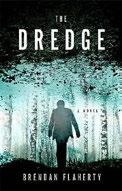
Estranged neighbors dig up childhood trauma in a New England town.
“For such a small town, it feels like we’ve had more tragedy than most,” says Joan Gindewin, a lifelong resident of Macoun, Connecticut. Indeed, the families portrayed in Flaherty’s debut novel are defined by misfortunes large and small, sudden and slow burning. The Rowes, for example, are known for their erratic behavior, inherited from an alcoholic father with a temper “like a river coming down on you”; quiet and sympathetic Lily Rowe is the exception to the family’s cycle of violence. The Casey boys, Cale and Ambrose, are haunted by a series of family accidents and disappearances stretching back to an infamous nor’easter before they were born. The novel bounces between these characters’ 1990s childhoods and the 2020s. Still in Macoun, Lily is a recluse, devoted to her work as a property developer. Cale is in Hawaii, a hotshot real estate agent with intimacy issues; “I’m afraid you have secrets,” says a girlfriend before they break up. Meanwhile, Ambrose, who runs a construction company in Macoun, feels he’s “been forced, stuck, to stay behind and protect” a secret that his brother fled so far to escape. The three characters’ property-adjacent professions highlight questions around ownership and change, especially as they each become embroiled in the fate of the muddy pond abutting their childhood homes. With so much history buried in its murk, what claim do they have for preserving or disturbing it? Although the stakes are weighty, Flaherty’s unadorned writing holds the drama at a remove. Childhood events are told
>>>
Flaherty, Brendan | Atlantic Monthly (256 pp.) | $26.00 | March 5, 2024 9780802162564
MARCH 1, 2024 9 KIRKUS REVIEWS FICTION
SKY
THE
WAS OURS
TOMMY ORANGE
In his new book, the acclaimed novelist grapples with Native American history and contemporary life.
BY MARK ATHITAKIS
PLOTWISE, TOMMY ORANGE’S second novel, Wandering Stars (Knopf, Feb. 27), is a follow-up to his acclaimed debut, 2018’s There There, a Pulitzer Prize finalist. The new book follows the events in the previous one, particularly the fate of Orvil Red Feather, the young Native American man at the center of a calamity at a powwow in Oakland, California. The novel also reaches back into the past, tracking Orvil’s ancestors to the 1864 Sand Creek massacre, in which the U.S. army killed and displaced hundreds of
Cheyenne and Arapaho, sending many of them to Florida schools and forced assimilation under the bigoted mantra “Kill the Indian, save the man.”
But while Wandering Stars extends There There’s story, it also stands on its own as a piercing study of the ways Native history and lore have been erased, and how that erasure feeds into feelings of disassociation, and sometimes addiction, among Native Americans today. Every scrap of history that has survived years of attempts to destroy it matters, the book
argues. To that point, speaking by Zoom from his home in Oakland, Orange was enthusing about Native actor Lily Gladstone, who the previous evening won the Golden Globe for best actress in a film for Killers of the Flower Moon —the first Indigenous woman to win a Golden Globe. “Anytime one of us is highlighted, it lifts all of us,” Orange says.
In this conversation, edited for space and clarity, Orange discusses the genesis of Wandering Stars, writing about addiction with humanity, and his next book.
Wandering Stars is at once a prequel and a sequel to There There. Were you thinking about continuing the story while you were writing the first book?
I had no plans for this book to have a prequel part, or even having a historical piece. I feel allergic to historical fiction, especially for Native people, because it’s just been so overdone. When I wrote There There, there was always modern technology

Anytime one of us is highlighted, it lifts all of us.
KIRKUS REVIEWS ON THE COVER
Michael
Lionstar
and a very modern feeling on purpose, because of how overdone that historical element has been. The second book was always just going to be the aftermath of what happens at the end of There There.
So what changed?
I was in Sweden for the translation of There There, and I got invited to do this museum tour. There was some Southern Cheyenne stuff there, and I saw a newspaper clipping in one of the exhibits. It said, “Cheyennes in Florida, 1875.” And I know enough about our tribe’s history to know that we were never near Florida. It made me very curious about how we ended up there. So I went down this rabbit hole of [Native] boarding schools, which were a super-devastating piece of history for Native people and went on for many, many decades. So it felt like something was there, something important that I wanted to explore.
Where does the title come from?
I was in a warehouse signing books for There There when “Wandering Star” by Portishead came on. I knew the song already, but something in that moment made me feel like, Oh, that’s the name of the next book. So I started imagining what that would be. As I was writing into this historical piece that I was researching, I found out that one of the [Cheyenne] prisoners was named Star, and one of the names of one of the prisoners there was Bear Shield [a surname of multiple There There characters]. I started crying when I saw that, because I felt like this is where the connection is—how to get all the way to the present from there.
You dedicate the book to “everyone surviving and not surviving this thing called and not called addiction.” Why are surviving and addiction such volatile words for you?
The characters in the book are dealing with addiction, and my own life has been formed and mangled in many ways by addiction. It’s just been a really unavoidable, formative thing for me. I also wanted to get at how a lot of addiction books are

Wandering Stars
Orange, Tommy
Knopf | 336 pp. | $29.00 Feb. 27, 2024 | 9780593318256
simplistic—they show that addiction is bad, but then somebody recovers and then that’s good, and they’re healed and that’s the arc. Or it’s romanticizing addiction. I think [in] our understanding around addiction—even though it’s so rampant in our culture—there’s still no humanity to it, there’s no complexity to it. And I think the way that it’s tied up with trauma and surviving is also not emphasized enough.
I think people are plagued by various addictions because they’re trying to cope with something else. A lot of times we point to the addiction and we’re like, “That’s what’s wrong,” instead of asking, “Why do you think somebody has to do something like that?” Addiction is not fun, as much as sometimes it can be portrayed that way. I was really trying to speak to something that I see an absence of in fiction and in a lot of language we have around addiction narratives.
There’s a line that comes up twice in the book about how telling stories takes you away from your life and brings you back “better made.” Has that been true for you?
Yeah. The way that fiction transforms is really hard to pinpoint. It’s hard to collect data and show that there’s this
specific outcome. But it’s been deeply impactful to me, the transformative quality of fiction and of art in general. Sometimes stories and entertainment get mixed up. Sometimes it can feel like it’s just a distraction, or they just transport you. Some people do use fiction for that and that’s perfectly fine. But the kind that is important to me, and that I’ve been moved by since having a relationship to reading and to art in general, is [the experience] that you come back from changed. It does take you away, but you come back different.
What that difference is, it’s not always super clear. Sometimes I’ve been asked, “What do you want your book to do for people by the time they finish it?” I’m like, “It’s a novel. It’s a whole world you’re trying to render in all its complexity.” That line came to me just out of the blue—it wasn’t something that I’d ever thought about before. But then it became important in the book as I got further into it, in trying to think about the way remnants of this past life would end up affecting future lives.
Have you been working on a new book?
Yes. I’m a little hesitant to say too much because it’s so new—I just sold it a month or two ago. It’s set in Oakland, but it’s completely outside of the universe of There There and Wandering Stars. It’s a contemporary book around the theme of the “pretendian” [a portmanteau of “pretend Indian”]. Recently there was a lot in the news about Buffy Sainte-Marie, a very famous musician, pretty much our most famous musician. Or used to be ours—it recently came out that she’d been faking it. [Ed: A 2023 CBC investigation challenged Sainte-Marie’s claims of Indigenous ancestry; the singer/activist denies that she fabricated her identity.] This is a devastating thing, and there’s a whole world of academics, filmmakers, authors, musicians, who are not in the worlds that surround them. They are super interesting, identity-wise.
Mark Athitakis is a writer in Phoenix.
MARCH 1, 2024 11 KIRKUS REVIEWS FICTION
haltingly but given great psychological significance, while characters are mostly left sketched. Readers might agree with Joan: “First, you don’t know people…then you do, then you realize you don’t.”
A plot-forward depiction of family history—and how it can haunt for life.
A Great Country
Gowda, Shilpi
Somaya
| Mariner Books (256 pp.) | $30.00 | March 26, 2024
9780063324343
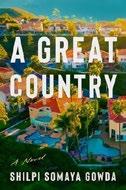
A tween’s arrest throws his Indian American family into disarray. The latest novel from Gowda starts as it means to go on, with this sentence:
“While twelveyear-old Ajay sat trembling in a jail cell, his parents were enjoying themselves at a dinner party.” What follows is a long exploration of racism, classism, and ableism, with the contrasts between the privileged and the less so heightened to a fever pitch. Ajay is a shy boy, the son of Indian immigrants in California, likely autistic with an abiding interest in robots and drones. His brutal arrest, at the hands of an overzealous cop, comes after he flies his prized drone near John Wayne Airport in Orange County. His arrest roils his family: his parents, Priya and Ashok, and his sisters, social-justice-focused Deepa and high school athlete Maya, who are both keeping secrets from their parents. Priya and Ashok live by their own code: “work hard, don’t make waves, keep placing one foot in front of the other on each new rung that appeared before them”; they have trouble squaring that with the possibility that Ajay has been racially profiled. Deepa disdains them for not bothering “to look back at who was left behind.” The novel follows the aftermath of the arrest, as Priya and Ashok enlist a lawyer recommended by a wealthy friend; said friend later is
A fast-paced story about how a single encounter can shape a person’s whole life.
THE STOLEN CHILD
accused of casteism at his company. Gowda’s narration is fast-paced, and she is gifted at building suspense, but the prose sometimes falls flat and the dialogue too often echoes movie cliches. The book is bound to draw comparisons to Celeste Ng’s Little Fires Everywhere (2017), but it has more in common with Paul Haggis’ heavy-handed 2004 film, Crash This well-intentioned effort just doesn’t land.
The Evolution of Annabel Craig
Grunwald, Lisa | Random House (320 pp.) $30.00 | April 16, 2024 | 9780593596159
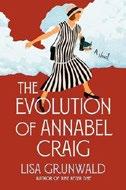
A Tennessee woman is swept into the 1925 Scopes Monkey Trial when her camera skills get her a front-row seat at the proceedings, causing her to grow away from her upbringing.
A native of Dayton, Tennessee, Annabel is working as a housekeeper at a hotel when she meets and marries George Craig, a lawyer come to town to start his career, but the honeymoon ends when a client George got acquitted commits a horrific act of violence. George’s spirits and career get a boost when he joins Clarence Darrow’s team, which is defending the teaching of evolution in public schools. Annabel navigates the shoals of her marriage and tries to square her traditional beliefs with the positions of Darrow—and her husband, who belittles her for being provincial and uneducated. Nevertheless, as an avid amateur photographer,
she’s thrilled when Lottie Nelson, a “lady reporter” she and George are putting up at their house, hires her to take pictures for the Chattanooga News. Although Grunwald’s research is admirable, she can disrupt her own narrative with anticipatory statements. For example, when Lottie files a story disclosing George’s negative views of the trial judge, rather than letting the consequences unfold, Grunwald has Annabel say, “I guessed that her story would be exceptionally long. I didn’t guess that it would also be exceptionally destructive.” Two pages later, we learn just how damaging the story is. In considering the pros and cons of the South, Annabel can be simplistic, but she does offer some important insights. “Women made the small decisions and men made the big ones. The small decisions often had the biggest consequences, like how a family handled hardship, or how far a dollar could be stretched, or what a child was taught to believe. But the big decisions made more noise.”
Provides a sense of how it felt to be in Dayton at the time of the Scopes trial.
Kirkus Star
The Stolen Child
Hood, Ann | Norton (304 pp.) | $27.99 May 7, 2024 | 9780393609806

In the 1970s, haunted by a choice he made during World War I, an elderly Rhode Island man enlists the help of a college dropout in a last-ditch attempt to make amends.
KIRKUS REVIEWS 12 MARCH 1, 2024 FICTION
Shortly after the U.S. enters World War I in 1917, Nick Burns finds himself on a farm in rural France. He’s killing time by painting a mural on a stone wall when he meets one of the farm’s residents, a feisty young woman named Camille Chastain, who dismisses his mural as the work of an amateur. While married and heavily pregnant, Camille has no aspirations to be a wife or a mother, only an artist. When German forces reach Nick’s trench amid bursts of artillery fire one night, she appears holding two bundles—her newborn son and an array of paintings—and entrusts him with their safety before fleeing into the nearby woods. What Nick does next dogs him for decades. Upon returning to the U.S., Nick tries to resume life but can’t forget about Camille or her child. Despite marrying another woman, he spends the next 57 years tortured by the seeming impossibility of discovering their fates. In 1974, isolated, depressed, and bitter, he receives a strange new lease on life: a terminal cancer diagnosis. Motivated by the knowledge that his time is limited, Nick and newly hired assistant Jenny, an IHOP waitress reeling from the unexpected derailment of her college career, embark on a search for answers that takes them through France and Italy before concluding at a derelict exhibit once run by Enzo Piccolo, a Neapolitan artisan. In traveling with Nick, Jenny hopes to see the world and, maybe, find her own place in it. Told in chapters that alternate among three perspectives—Nick’s, Jenny’s, and Enzo’s—the story is compelling, skillfully told, and meticulously structured, though a few beats veer a little too close to cliche to ring entirely true. Of particular note are Hood’s detailed descriptions of the different historical settings (Paris, small-town France, Rome, Tuscany, Naples), which feel rooted in research and heighten the authenticity of the narrative.
A well-crafted, fast-paced story about how a single encounter can shape a person’s whole life.
American Daughters
Huguley, Piper | Morrow/HarperCollins (368 pp.) | $18.99 paper | April 2, 2024 9780063273702

Two young women with independent spirits fight to find their places in the world.
When Portia Washington, daughter of Booker T. Washington, first meets Alice Roosevelt, daughter of President Theodore Roosevelt, Portia has just thrown up behind a tree. She is deeply distraught by President Roosevelt’s public snub of her father after he invited them to Washington, D.C. Alice, unfazed by the vomit, takes Portia back to the White House and declares that they will be fast friends. Portia feels similar warmth for Alice but recognizes the giant gulf between their lives. In this work of fictionalized history—there is some evidence that the women were friends— Huguley tells each woman’s story in alternating chapters. Portia is a talented musician with dreams of learning from the masters in Europe while bringing the songs of her community to the stage. Alice is a spitfire with political savvy who has the misfortune of growing up in the Victorian era. Both women struggle with love, domineering men, and dreams cast aside; Portia, of course, deals with all that while being a Black woman in a white man’s world. Despite the women’s very real difficulties, Huguley sometimes mistakes melodrama for substance (“I curse the day I ever married you”). Her treatment of time can be confusing, as she gives us a few years from one character’s perspective and then jumps back in time for the other. The novel is at its best when the disconnect between the women is at the forefront—for example, what for Alice is a simple meetup of friends at her home for Portia means being forced to use the servants’ door. And while Portia’s chapters are absorbing from the start, it takes a while for Alice to bring much to the table. An intriguing glimpse into the lives of two historical women.
Catchpenny
Huston, Charlie | Vintage (416 pp.) | $18.00 paper | April 9, 2024 | 9780593685082

A supernatural thriller set in a mystically bent Los Angeles of dark enchantment, looking-glass larceny, and apocalyptic gaming. Whatever you do, don’t call Sid Catchpenny a detective. He prefers “thief” and so does everybody who crosses his path, whether they like him or not. Nonetheless, it’s Sid’s peculiar talents as a “sly” (a thief who’s able to literally walk in and out of mirrors) that set him on the course of a missing-persons case that’s weird even for a rococo urban fantasy like this. Indeed, Circe, the enigmatic 16-year-old Sid’s looking for, isn’t just “missing.” According to her mother, Iva, “She is. Gone.... Missing is like she’s somewhere not where you left her. My sunglasses are missing.… My daughter is gone.” And so we’re off on a hallucinatory adventure rife with the kind of extreme violence, false leads, and hairbreadth escapes you find in thrillers only amped up with 1980s-style rock lyrics, video game arcana, and a mysterious force dubbed “mojo,” defined loosely (if not always clearly) as magical essences gathered from the emotions invested in objects, whether it’s the piece of carpet where a beloved dog used to sleep, the Sinéad O’Connor T-shirt Sid wears in memory of his murdered lover, Abigail, or a stuffed bat Circe’s mother clings to as a remnant of her daughter’s childhood. The more mojo one carries around in this world, Sid tells us, the more power one has—and the more power one gets, the more damage one can do. Which is something Sid fears may be happening with Circe and the company she’s probably keeping, including suicide cultists and online gamesters obsessed by something called Gyre, whose content has demonic and potentially world-ending powers. As his passage in and out of mirrors yields more clues, more mojo, and greater peril, Sid is
MARCH 1, 2024 13 KIRKUS REVIEWS FICTION
confronting his own painful past with its bad dreams and depressive interludes. The book’s heavy rush of ornate imagery, outlandish villains, and exotic set pieces can get so intense that the reader may at times feel disoriented. But Huston’s writing packs a rock band’s hard-driving propulsion along with an electric guitar’s plaintive lyricism. You may at times feel as lost in the ether as Sid. But you can’t help sticking with his pursuit to its chaotic finish.
If mojo is another word for magic, then this novel’s loaded with it.
Phantom Orbit
Ignatius, David | Norton (400 pp.) | $29.99 May 7, 2024 | 9781324050919
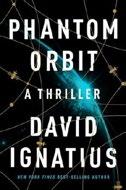
Great powers jockey for dominance in space.
Three unusually smart people play key roles in this cerebral, well-researched thriller. It’s relatively low-key, with none of the blood spatter and 12-letter profanities so common in the genre. In the 1990s, Russian Ivan Volkov studies aerospace engineering at Tsinghua University in Beijing, where he learns from renowned professor Cao Lin and meets American grad student Edith Ryan. Volkov and Ryan (Psst! She’s CIA) become friends but not lovers, and they go their separate ways. Back home in Russia, Volkov, the most interesting of the main characters, is asked if he trusts his “new Chinese friends.” “I am a Russian,” he replies. “I don’t trust anyone.” His money-loving wife leaves him and their young son while he struggles to find a job that pays enough. “Don’t take Dimitry,” he begs her. “I don’t want Dimitry,” she tells him. “He reminds me of you.” Ouch. But he loves his son and raises him well. He also loves Russia, but he doesn’t love its corruption. Three decades later, the specter of war looms in space, with hints of vulnerabilities in the GPS system. The U.S. has
This tender, strange novel is quintessentially Miranda July.
ALL FOURS
dominated space for so long that Cao Lin believes it’s become complacent and can’t see its vulnerabilities. While much of our daily lives depends on GPS’s precision in commercial air and highway travel, it’s critical to Ukraine for pinpointing Russian targets on the battlefield. Thousands of miles up in space, one satellite might be able to reposition itself close to another country’s satellite and reprogram or disable it. This oversimplifies the threat described in detail in the novel, but that’s the drift. China, Russia, and the U.S. fear and mistrust each other, and they can cause huge problems on earth by dominating space with “killer satellites.” Volkov is asked if he can fix Russia’s satellite system, which is too “sloppy” and “imprecise.” “You need better clocks,” he replies, and the author does a good job explaining why. Ryan, Volkov, and Cao are all honorable characters with their own trajectories that reconnect in surprising fashion. Readers just might root for all three.
A space yarn filled with tension and excitement.
All Fours
July, Miranda | Riverhead (336 pp.) | $29.00 May 14, 2024 | 9780593190265

A woman set to embark on a cross-country road trip instead drives to a nearby motel and becomes obsessed with a local man.
According to Harris, the husband of the narrator of July’s novel, everyone in life is either a Parker or a Driver. “Drivers,” Harris says, “are able
to maintain awareness and engagement even when life is boring.” The narrator knows she’s a Parker, someone who needs “a discrete task that seems impossible, something…for which they might receive applause.” For the narrator, a “semi-famous” bisexual woman in her mid-40s living in Los Angeles, this task is her art; it’s only by haphazard chance that she’s fallen into a traditional straight marriage and motherhood. When the narrator needs to be in New York for work, she decides on a solo road trip as a way of forcing herself to be more of a metaphorical Driver. She makes it all of 30 minutes when, for reasons she doesn’t quite understand, she pulls over in Monrovia. After encountering a man who wipes her windows at a gas station and then chats with her at the local diner, she checks in to a motel, where she begins an all-consuming intimacy with him. For the first time in her life, she feels truly present. But she can only pretend to travel so long before she must go home and figure out how to live the rest of a life that she—that any woman in midlife—has no map for. July’s novel is a characteristically witty, startlingly intimate take on Dante’s “In the middle of life’s journey, I found myself in a dark wood”—if the dark wood were the WebMD site for menopause and a cheap room at the Excelsior Motel. This tender, strange treatise on getting out from the “prefab structures” of a conventional life is quintessentially July.

KIRKUS REVIEWS 14 MARCH 1, 2024 FICTION
For more by Miranda July, visit Kirkus online.
Reunion
Juska, Elise | Harper/HarperCollins (304 pp.) $27.99 | May 7, 2024 | 9780063346765

Heightened emotional tensions caused by Covid-19 add an interesting twist to Juska’s story of friends gathering for a college reunion in 2021.
The framework is familiar: Adults with unsatisfactory lives attend a reunion where they interact with people they once loved, hated, admired, or were mean to; recognizing the dissonance between themselves then and now leads to inner growth. But Covid has forced members of Walthrop’s class of 1995 to return to the Maine liberal arts college one year late for their 25th reunion. Between drinking beer and making jokey banter about youthful antics, the gathered characters evoke Americans’ post-lockdown mood of exhaustion and general unease. Hope, Polly, and Adam, the three friends who take turns narrating, were famously close in college. Although they’ve stayed in touch, their lives have diverged. Hope, once a self-confident student, has become an anxious stay-at-home suburban mom who pretends tense undercurrents in her family life don’t exist. (Her charmingly snarky teenage daughter is the book’s most entertaining character.) Fellow students had considered Polly intimidatingly cool, but as a working-class Brooklyn girl she “often felt like an outlier” at preppy Walthrop; now an adjunct college instructor, she lives back in Brooklyn with her teenage son, Jonah, and has never told Hope, her supposed best friend, the truth about Jonah’s conception or his father’s identity. Dangerously wild in college, environmental lawyer Adam has evolved into a devoted family man in rural New Hampshire, but the deepening depression and agoraphobia his wife has exhibited since Covid are
growing burdens. As the weekend progresses, the three friends mostly avoid delving below the surface of things until events bring each to a point of crisis and they begin reconnecting. The problem is that, given their undiscussed, long-standing resentments, the two women’s friendship is never convincing, and maintaining their relationships never seems a high priority to Adam. What works in this novel is how Juska keeps the Covid cloud hovering in readers’ minds without overkill. A pleasant but predictable read.
The Haunting of Velkwood
Kiste, Gwendolyn | Saga/Simon & Schuster (256 pp.) | $26.99 | March 5, 2024
9781982172374

In an oppressive 1980s U.S. suburb, forgotten women locate their power and rescue themselves.
Talitha Velkwood, a stagnant middle-aged woman, is plagued by the tragic and mysterious disappearance of the suburban neighborhood where she grew up 20 years ago. This cosmic anomaly, in which everything and everyone on this single block vanished behind a seemingly uncrossable veil, left behind only three college girls—Talitha, Brett Hadley, and Grace Spencer. In a world obsessed with spectacle, it’s no surprise that the mysterious circumstances of the Velkwood Vicinity caught the attention of occult theorists, some ill-intentioned tabloid journalists, and now a sympathetic paranormal researcher named Jack. He theorizes that only the three women are capable of crossing the border, and when both Brett and Grace reject his offer to try it, he approaches Talitha, convincing her to go back for her younger sister. What she finds is a street full of ghosts ready to plunge
her back into the traumatic past she tried desperately to run from. Somewhere between real life and the supernatural, Talitha must confront the reality that past and present are always intertwined, no matter how hard you work to erase it. After all her years of running, Talitha turns back for another moment with her sister and a reconnection with her estranged friends to repair the Velkwood Vicinity and heal themselves. While the haunting is original and atmospheric, the dark history of Talitha’s suburbia has a predictable underbelly, leaving the scares a bit hollow and the emotional peak at a disappointingly low elevation. On the other hand, a character-driven novel that employs a metaphor for the time warp of trauma and women refusing to stay silent about abuses they’ve undergone is a worthwhile undertaking. Kiste fights for friendship and love to pull her characters through.
While We Were Burning
Koffi, Sara | Putnam (304 pp.) | $28.00 April 16, 2024 | 9780593714959

In a wealthy Memphis suburb, a Black boy’s death is avenged. Koffi’s debut features a first-person narrator, Elizabeth Smith, who is perceived as crazy by her husband and employer because she thinks the death of her neighbor, Patricia Fitzgerald—found hanging from a lamp post after a Halloween party—was murder rather than suicide. When anxiety medication doesn’t solve the problem, her husband and therapist decide she should hire a personal assistant to help her stay on course. Through a listserv, Elizabeth meets Brianna Thompson, a beautiful Black woman who seems perfect for the job. But we learn early on that Brianna has found her way into Elizabeth’s privileged
>>>
MARCH 1, 2024 15 KIRKUS REVIEWS FICTION
SEEN AND HEARD
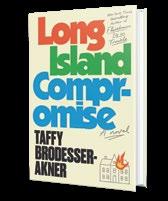 Novel by Taffy Brodesser-Akner
Novel by Taffy Brodesser-Akner
Will Be Published in July
Long Island Compromise is the second novel from the journalist and author.
Taffy Brodesser-Akner’s second novel will hit bookstore shelves this summer.
Random House will publish the author’s Long Island Compromise, the press announced in a news release. It calls the book “an exhilarating novel about one American family, the dark moment that shatters their suburban paradise, and the wild legacy of trauma and inheritance.”

Brodesser-Akner, a staff writer for New York Times Magazine, made her fiction debut in 2019 with Fleishman Is in Trouble The novel was longlisted for the National Book Award and adapted for a miniseries starring Jesse Eisenberg, Claire Danes, and Lizzy Caplan. The series earned Brodesser-Akner an Emmy nomination for outstanding writing for a limited or anthology series or movie.
Long Island Compromise follows Carl Fletcher, a man trying to come to terms with his troubled family and his kidnapping four decades earlier.
Brodesser-Akner told Vanity Fair, “[M]y fascination with Long Island culture...gave birth to the family at the center of the book, the Fletchers—the kind of family that is wealthy enough for their money to have bought them security, but also to leave them in danger.”
Long Island Compromise is slated for publication on July 9.
MICHAEL SCHAUB
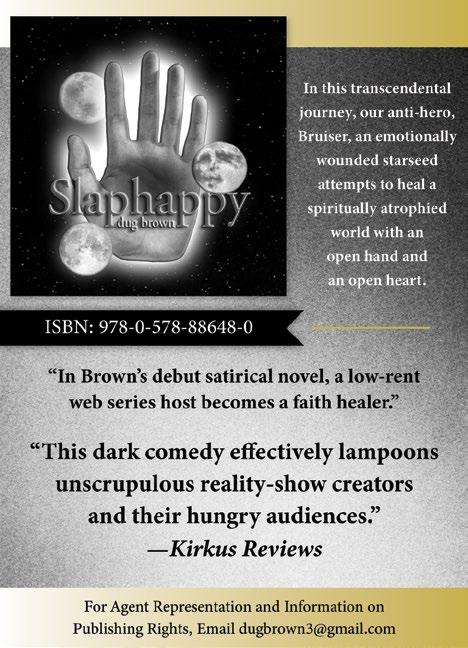 Author Taffy Brodesser-Akner
Author Taffy Brodesser-Akner
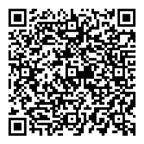

FICTION // SEEN AND HEARD
KIRKUS REVIEWS
Images
Michael Tullberg/Getty
For a review of Fleishman Is in Trouble, visit Kirkus online.

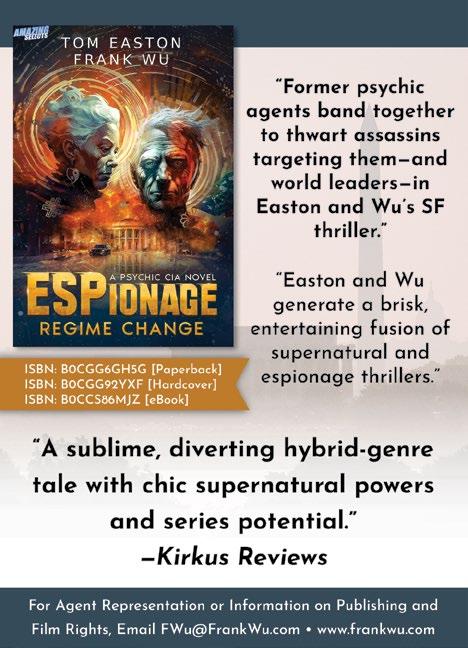
AWARDS
Finalists for the NBCC Awards Are Revealed
Justin Torres, Teju Cole, and Marie NDiaye are among the authors up for the book critics’ prizes.
The National Book Critics Circle revealed the finalists for its annual awards, with Justin Torres, Teju Cole, and Marie NDiaye among the authors in the running for the literary prizes.
Torres made the fiction shortlist for Blackouts, which won last year’s National Book Award. Also named finalists were Cole’s Tremor ; North Woods by Daniel Mason; I Am Homeless If This Is Not My Home by Lorrie Moore; and Vengeance Is Mine, written by NDiaye and translated by Jordan Stump.
The nonfiction finalists were Roxanna Asgarian for We Were Once a Family, Kerry Howley for Bottoms Up and the Devil Laughs, Christina Sharpe

for Ordinary Notes, Jeff Sharlet for The Undertow, and Dina Nayeri for Who Gets Believed?
For a complete list of finalists visit the organization’s website at bookcritics.org.
The National Book Critics Circle also announced the winners of some special awards, including Judy Blume, who won the Ivan Sandrof Lifetime Achievement Award, and the American Library Association, named winner of the Toni Morrison Achievement Award.
The winners of the prizes will be announced at a ceremony in New York on March 21; the event will also be livestreamed on YouTube —T.B.

For more literary awards news, visit Kirkus online.


// FICTION
AWARDS
MARCH 1, 2024 17 KIRKUS REVIEWS
Torres: Cindy Ord/Getty Images; Cole: Roberto Ricciuti; NDiaye: Andreas Solaro/AFP
From left, Justin Torres, Teju Cole, and Marie NDiaye
white life for a reason—a reason that involves the murder of her son, Jay, by the police in Elizabeth and Patricia’s neighborhood, the upscale Harbor Town section of Memphis. While underdeveloped characters and settings make it difficult to fully invest in the story, it’s clear that Elizabeth’s foundering marriage and Brianna’s righteous grief and rage are on a collision course. The element that drives the book is its fury about racism, which is threaded into comparisons of Nashville and Memphis, the history of the learning center where Elizabeth works, a Harbor Town message board, and of course the main plot, a ripped-from-the-headlines 911 call that led to Jay’s shooting. This aspect of the book is potent, but lack of character development remains a problem. A surprise visit from Elizabeth’s mother, Dawn, is probably meant to fill in some backstory for Elizabeth, but the strokes are so broad that it almost comes off as parody. “I always knew how you would turn out,” her mother says. “I always knew that you’d fall in love and have a beautiful life. And I always knew that they’d find you dead with a bottle of pills in your hand.” A few paragraphs later, Dawn asks, “Now, what does it say about you if people keep killing themselves just to get away from you?” “You’re fucking evil,” Elizabeth replies. “That’s what you fucking are.” A politically aware thriller from a passionate rookie author.
Kirkus Star
Fervor
Lloyd, Toby | Avid Reader Press (288 pp.) $28.00 | March 19, 2024 | 9781668033333
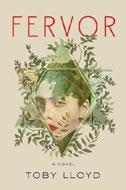
her grandfather, a Holocaust survivor, dies and she begins getting in trouble in school. When her class is given an assignment “to write a story about a family reunion,” Elsie turns in a violent, disturbing piece inspired by the biblical tale of Jephthah’s sacrificed daughter. Her devout (and intellectually rigorous, if not merciless) parents are brought in to speak with her teachers, for whom Elsie’s mother, Hannah, has just one question: “Was it any good?...Elsie’s story. Were you impressed?” Lloyd’s extraordinary debut novel traces the implosion of a family—each member both difficult and unique, gifted and troubled. Elsie disappears for several days, and though she returns, she doesn’t seem to be the same. Hannah concludes that Elsie has lost herself in an obsession with Kabbalah, or “black magic,” but her son, Tovyah, believes Elsie’s mental state can be attributed to their dysfunctional family dynamics. Lloyd’s narrative picks up about a decade later when Tovyah begins studying at Oxford, and events are filtered through the perspective of a classmate named Kate. In Tovyah’s view, his mother has betrayed the family—and capitalized on their suffering—by writing sensationalized memoirs in which she describes both their grandfather’s Holocaust experiences and Elsie’s breakdowns. But in Lloyd’s telling, nothing—from a straightforward accounting of events to an assignment of blame—is simple. In his explorations of religion, family, academia, and the haunting effects of the past, his writing is remarkably nuanced and, at the same time, suffused with suspense.
Honey
Lodato, Victor | Harper/HarperCollins (400 pp.) | $32.00 | April 16, 2024 9780063309616
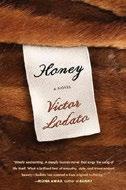
When a North London girl returns after several days missing, her family wonders if she’s been possessed.
Elsie Rosenthal is 13 when
A tremendous debut from a strikingly talented new writer.

A mobster’s daughter has finally returned, in her 80s, to the family’s New Jersey home, and she knows where the bodies are buried—literally. Honey Fasinga, originally Ilaria Fazzinga, has spent a lifetime distancing herself from her Italian roots. To dodge expectations and bury memories of the brutalities she witnessed while living under the roof of her father, the Great Pietro— whom she loved, hated, and feared—she went to college, studied art, and spent decades living in Los Angeles, working at a prestigious auction house. But now she’s back with a sense of unfinished business, reconnecting, remembering, and trying to resolve the gap between her assured adult self and her violent childhood. Lodato’s new novel circles Honey ceaselessly, resurrecting people and events (some horrible) from her past while introducing new characters to challenge who she is now. Irrepressible neighbor Joss is grappling with Lee, a rough boyfriend. Gentle artist Nathan is attracted to Honey despite their half-century age difference. And what about Honey herself? Feisty, finely dressed, and fond of a drink, she is also suicidal and prone to panic attacks, an uneasy, unlikely meld of arrogance and uncertainty. As she swings between opinions and options, death visits the narrative repeatedly, and so do beatings, notably of Lee and also of Honey’s grandnephew Michael, whose exploration of gender sits badly with the Fazzingas’ “traditional” values, furthering Honey’s sense of distaste and alienation. This nature/nurture debate is the central feature of a story that is long and loose, driven less by plot than by the tireless recording of Honey’s ups and downs involving fine art, elderly indulgences, relationship choices, and a gun. This
KIRKUS REVIEWS 18 MARCH 1, 2024 FICTION
For more by Victor Lodato, visit Kirkus online.
Follow an ultrarich Shanghai family backward in time from 2040 to 2014.
SHANGHAILANDERS
entertaining, Sopranos-esque mix doesn’t entirely gel, but for all the vacillating, the book does establish one inescapable fact: Honey is family. Something of a jumble, this leisurely, tough/tender saga of homecoming exudes warmth and brio.
Shanghailanders
Min, Juli | Spiegel & Grau (288 pp.) | $28.00 May 7, 2024 | 9781954118607

Follow an ultrarich Shanghai family backward in time from 2040 to 2014.
Min opens her intriguing novel-in-stories with “A True Shanghai Man, January 2040”: paterfamilias Leo Yang has just dropped his wife, Eko, and two older daughters, Yumi and Yoko, at the airport and is returning home on a high-speed train to teenage Kiko, the baby of the family. The older girls are returning to boarding school and college in Boston. The narrative will move forward from this moment only once, in the second story, “Rouge Allure, January 2040,” which follows Eko and the girls to Boston and then on to Paris, where French Japanese Eko grew up, then down to Nice, where Eko’s mother lives in a high-rise retirement community. From there, the stories visit earlier time periods. In “Moshi Moshi Marilyn Monroe, September 2039,” we learn that Baby Kiko, as she is called in the family, is definitely no baby anymore. “In the Time of Period Trees, September 2038” fills in a lot of detail about the relationship between Yumi and Yoko and
introduces a few plot points that are clarified in stories that go even further into the past. What does it mean that Kiko “blames” Yoko for Lucy? What is the in-joke with her father behind the ball of gold string on her desk at school? Answers to questions like these create a sense of unfolding that balances the disappointment one might feel about leaving the latest versions of the Yangs, and their interesting problems, behind. Some stories focus on characters tangential to the family—their driver participates in a 2030s phenomenon called night races, and a very strong story called “The Girl of My Heart, February 2020,” touches on the pandemic and explores the life of the ayi (nanny) character we’ve heard about before she came to the Yangs. The prose and characterizations here and throughout are assured, particularly for a debut. An unusual and immersive reading experience.
Kirkus Star
Daughter of Mine
Miranda, Megan | Marysue Rucci Books (368 pp.) | $28.00 | April 9, 2024 9781668010440

and the other townspeople are confronted by a challenging double whammy: As they’re grieving the loss of beloved longtime police officer Detective Perry Holt, a disturbing sight appears in the lake, whose waterline is receding because of an ongoing drought—an old, unidentifiable car, which has likely been lurking there for years. Hazel temporarily leaves her Charlotte-based building-renovation business in the capable hands of her partners and reconnects with her brothers, Caden and Gage; her Uncle Roy; her old fling and neighbor, Nico; and her schoolfriend, Jamie, now a mother and married to Caden. Tiny, relentless suspicions rise to the metaphorical surface along with that waterlogged vehicle: There have been a slew of minor break-ins; two people go missing; and then, a second abandoned car is discovered. The novel digs deeper into Hazel’s family history—her father was a widow when he married Hazel’s mother, who later left the family, absconding with money and jewels— and Miranda, a consummate professional when it comes to exposing the small community tensions that naturally arise when people live in close proximity for generations, exposes revelation after twisty revelation: “Everything mattered disproportionately in a small town. Your success, but also your failure. Everyone knows might as well have been our town motto.”
Small-town claustrophobia and intimacies alike propel this twist-filled psychological thriller.
You Know What You Did
The loss of her police officer father and the discovery of an abandoned car in a local lake raise chilling questions regarding a young woman’s family history.
When Hazel Sharp returns to her hometown of Mirror Lake, North Carolina, for her father’s memorial, she
Nguyen, K.T. | Dutton (384 pp.) | $28.00 April 16, 2024 | 9780593473856

A woman hits a tipping point in her life and has to fight to save herself and her family.
Annie’s mother was a Vietnam War refugee; her trauma response
MARCH 1, 2024 19 KIRKUS REVIEWS FICTION
took the form of hoarding, and although she worked hard, there was never enough food on the table. So when Annie makes it to the Rhode Island School of Design and meets the wealthy, sandy-haired Duncan Shaw, she’s all too happy to be taken care of. Fast forward more than 15 years to where the novel opens: Annie and Duncan are married and have a daughter. When her mother dies, Annie finds herself struggling to stay afloat: Her daughter seems to hate her; her husband is always working; her art career is stalled; and her OCD symptoms, partly inherited from her mother and long dormant, begin once again invading her life. Sleep brings nightmares from a long-ago car accident and dreams of her mother, always accusing her of doing terrible things. Then her husband and daughter both leave for the summer, and her compulsive behavior only worsens. When her art patron disappears and is then found murdered, Annie becomes a person of interest—particularly because she has started to suffer blackouts and can’t defend her innocence. Is someone blackmailing her? Is she responsible for this violent death, and maybe others?
Nguyen intersperses Annie’s present-day narrative with flashbacks to her childhood and early life with Duncan, and cuts to a scene in a hotel that happens at an unspecified time. These layers add complexity, and occasionally confusion, to the timeline. The descriptions of Annie’s OCD— which takes the particular form of paranoia about germs, dirt, and contamination—and her struggles to control it are particularly visceral. It’s not entertainment, this exploration of generational trauma and mental illness, and it’s not exactly a domestic thriller, either. But there is healing to be had in the journey and the ending.
Not an easy read, but it’s worth it to see this flawed human grow.

Absolute Away
Olsen, Lance | Dzanc (226 pp.) | $17.95 paper | April 16, 2024 | 9781950539956
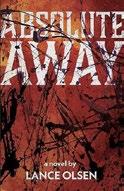
A surreal story bridges historical trauma with existential nightmares.
Olsen’s latest novel begins in recognizable terrain before branching into increasingly expansive, experimental spaces. It opens in Berlin in 1933, when a girl named Edie Metzger—not quite 3 years old—is taken by her parents in the night to a massive book burning. Olsen opts for a fragmentary approach here, juxtaposing the innocence of young Edie, who doesn’t understand what’s happening—“those men over there are grilling books, which means everyone will get to sample some soon”—with other onlookers who embrace or shun fascism. There are echoes of Olsen’s My Red Heaven (2020), set in Berlin a few years before this, but soon, the setting leaps forward in time and across an ocean to New York City. In a series of fragmentary passages, a narrator who is revealed to be Edith Metzger chronicles her (real-life) friendship with Ruth Kligman and their encounters with Jackson Pollock, all leading up to the fateful car accident that killed both Metzger and Pollock. The novel’s second half takes things into an increasingly stranger realm, following other versions of Edie/Edith, including a man named Eddy, a woman named Edda, and a child onboard the Lusitania as it sinks. Olsen juxtaposes the miraculous and uncanny with moments that emphasize more mundane concerns. This is a world where, in the face of the potentially supernatural, “the event slowly bleached away into the informational background, superseded by what seemed more pressing quotidian concerns from school shootings to the price of milk.” It’s not always an easy read, but Olsen depicts the horrors of history and more speculative anxieties with equal power. Impossible to classify, this novel raises big questions about memory and identity.
One Last Word
Park, Suzanne | Avon/HarperCollins (288 pp.) | $18.99 paper | April 16, 2024
9780063216099
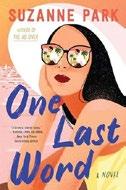
When a woman accidentally sends overly honest emails to the people she cares for most, chaos ensues.
Putting it bluntly, Sara Chae is exhausted. Though she’s overworked and undervalued at her job, she knows she can bring something new and exciting to the tech world. If only her sexist bosses would listen to her pitch for One Last Word, an app that will send out your final messages to the most important people in your life after you die. When Sara doesn’t get the support she’s hoping for, she decides to take her idea elsewhere, working on the finishing details for One Last Word from her cramped living space in her sister’s walk-in closet. One drunken night, she drafts her own messages to the people she hasn’t been fully honest with—her parents, her estranged best friend, her biggest crush from high school—and is horrified when the app accidentally sends them out. Now, she has to deal with the fallout that comes from finally speaking the truth to the people who have mattered most throughout her life. The timing couldn’t be worse; she’s also been accepted into a venture capital mentorship program, and that aforementioned high school crush, Harry Shim, is now the VC bigwig assigned to be her mentor. Not only does Sara have to fine-tune her app to get the necessary funding, but she also has to navigate around Harry, since they’re supposed to be working together, not rekindling old feelings. Park has always been good at telling stories about women who find themselves at a nadir in their professional lives, and Sara’s struggles in her industry are deeply relatable. Although the book’s romantic dilemma could have used a more thorough resolution, there are plenty of laughs as we follow
KIRKUS REVIEWS 20 MARCH 1, 2024 FICTION
For more by Lance Olsen, visit Kirkus online.
Sara’s journey toward achieving her biggest career goals. A fresh, modern story about learning to be honest.
Kirkus Star
We Were the Universe
Parsons, Kimberly King | Knopf (288 pp.)
$28.00 | May 14, 2024 | 9780525521853

A young mother in a suburb between Fort Worth and Dallas wrangles a Texas-size grief. Parsons’ debut novel—following the story collection Black Light (2019)—follows 25-year-old Kit’s remarkable and original stream of consciousness as it obsessively circles the loss of her younger sister, Julie, who died four years ago while Kit was pregnant. Back when they were growing up in Wink, Texas, where Kit’s beautiful mother still lives, the two had a band with their friend Yesenia called You Are the Universe, a name that grew out of their epic psychedelic adventures on the pink shag rug of a boy known as Big Large. As the novel opens, Kit is about to take an actual trip—a weekend in Montana with her best friend, Pete, ostensibly to help him get over being dumped by his partner, Brian. “I instantly recognized in [Pete] the things I saw in myself—here was somebody with a mighty death drive, somebody bighearted who was also kind of a fuckup, someone who was not exactly overflowing with impulse control.” Until it’s time to go, she’s wheeling her stroller between Hidden Wonder playground, Tiny Toads gymnastic center, and the home she shares with her sweet husband, Jad, and precocious Gilda, a tiny tyrant who “can appropriately use debris in a sentence.” Kit still loves sex and psychedelics, though these days her one-night stands are fantasy only, and she can’t take drugs because she’s still nursing. Nevertheless, both are
frequently in her always-interesting thoughts: “I am so, so glad I’ve done acid. Nothing prepares you for childbirth more.” “It’s possible that nothing makes me want sex more than not coming during it.” Along with Melissa Broder’s Death Valley (2023), this book seems suggestive evidence of a New Psychedelia, young women writers updating Carlos Castaneda for the 21st century, filling the eternal trippy desert with love and yearning and laughter. Parsons has created a character so appealing in her cheerful brokenness that you won’t want to leave her side for a minute.
The Education of Aubrey Mckee
Pugsley, Alex | Biblioasis (320 pp.) | $16.95 paper | May 7, 2024 | 9781771965835
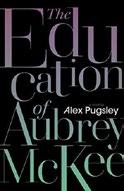
A tempestuous love affair in 1990s Toronto. Pugsley returns with the second in a projected series of five autobiographical novels (following Aubrey McKee, 2020) about the life and complicated loves of the titular Nova Scotia native. This entry follows its narrator, Aubrey, through the 1990s as he moves to Toronto to pursue a graduate degree in chemistry. There, he meets and falls in love with Gudrun Peel, an aspiring poet and candidate for an English Ph.D. Gudrun, an ardent feminist who thinks of herself as a “neurotic, hyperconscious girl” and feels like she’s only “pretending to be an adult,” struggles to complete her thesis and gain a foothold in the vibrant but unconventional Toronto art world. Aubrey, a “very young twentysomething” when the novel begins, and captivated as much by his lover’s eccentricities as he is by her striking beauty, strives with equal energy to penetrate the mystery of a life that’s been damaged by her abuse in the home of a “DEAD DRUNK DAD and BORN-AGAIN MOM.” But even as Aubrey believes he’s come to terms with
the “emotional schizophrenia of our relations,” when Gudrun’s career takes a turn that propels her in an exciting creative direction, he finds himself ill-prepared to cope with his feelings of “respect, compassion, pride, lust, disgust, and wonder” for her in her new incarnation. Pugsley seasons this sometimes claustrophobic romance with the well-timed appearance of some colorful friends and ex-lovers. The novel is bracketed by, on the one end, a disposable short story describing an evening of partying involving Aubrey and a friend who once employed him as a writer on a short-lived sketch comedy series and, on the other, a compact three-act play that begins similarly but gradually deepens to reprise some of the novel’s themes. That minidrama brings this phase of Aubrey’s story to a close in a resonant, and mildly hopeful, fashion. A realistic portrait of a complex romance between two mismatched but sympathetic characters.
Litany of Saints: A Triptych
Rojas, Diana | Arte Público | $17.95 paper April 30, 2024 | 9781518508073

Three stories offer an intriguing look into the lives of Costa Rican characters— Ticos—as they deal with their roles in their families and society.
In “The Lives of Saints,” the opening story in this debut collection, an immigrant woman living in the United States reflects on her philandering husband’s life after he receives a terminal cancer diagnosis. His poor health causes her to reconsider her unwavering loyalty to him, as well as her fervent belief in her Catholic faith.
“Studying the lives of saints was a conspiracy to hold us back from a full life,” she muses, “forcing us to always postpone joy for a tomorrow that might or might not come.” Indeed, her religion is what convinced her to stay with her husband, endlessly forgiving his transgressions.
>>>
MARCH 1, 2024 21 KIRKUS REVIEWS FICTION


EDITORS’ PICKS:
Dungeons and Drama by Kristy Boyce (Underlined)
The Last Stand by Antwan Eady, illus. by Jerome Pumphrey & Jarrett Pumphrey (Knopf)


Rental Person Who Does Nothing by Shoji Morimoto, trans. by Don Knotting (Hanover Square Press)
Old Crimes by Jill McCorkle (Algonquin)
ALSO MENTIONED ON THIS EPISODE:
Of Dice and Men: The Story of Dungeons & Dragons and the People Who Play It by David M. Ewalt
Game Wizards: The Epic Battle for Dungeons & Dragons by Jon Peterson
Tom Lake by Ann Patchett
Kantika by Elizabeth Graver
Fully Booked is produced by Cabel Adkins Audio and Megan Labrise.
THANKS TO OUR SPONSORS:
The Knee & Shoulder Handbook: The Keys to a Pain-Free, Active Life by Alan Reznik, M.D.
Journey to Merveilleux City by Stephanie Barbé Hammer
Incendiary Attraction by Sarah Andre

Fully Booked
Venita Blackburn’s Dead in Long Beach, California crackles with humor and grief. BY
EPISODE 357: VENITA BLACKBURN
On this episode of the podcast, Venita Blackburn discusses Dead in Long Beach, California (MCD/Farrar, Straus and Giroux, Jan. 23), a highly original novel with a stunning premise: In response to her brother Jay’s death by suicide, graphic novelist Coral Brown begins responding as him to the text messages on his unlocked phone.
Blackburn, who made a name in short stories and flash fiction, is the author of the collections Black Jesus and Other Superheroes and How To Wrestle a Girl Her work has appeared in publications including the New York Times, the New Yorker, Harper’s, and McSweeney’s. She is the founder and president of Live, Write, which offers free creative writing workshops to communities of color, and an associate professor of creative writing at California State University, Fresno.
Here’s a bit from our starred review of Dead in Long Beach, California : “The debut novel from short story author Blackburn is narrated by a mysterious ‘we’—perhaps characters from Coral’s book, perhaps multiple versions of herself, perhaps both. Despite the heavy subject matter, sensitively handled, this is frequently a deeply funny novel: Long Beach is ‘an oily, salty city nicknamed Weirdbeach by those not likely to fly a gay pride flag on their lawns anytime soon,’ and Khadija ‘loved amusement parks the way chefs love cardamom and pretentious knives.’ Blackburn shares a deep intellect and odd sensibility with authors like George Saunders and Rion Amilcar Scott, but this novel is its own thing: intelligent, bizarre, and brilliantly written. An astonishing debut novel from a remarkably creative writer.”
MEGAN LABRISE



Dead in Long Beach, California
Blackburn, Venita
MCD/Farrar, Straus and Giroux | 240 pp.
$27.00 | Jan. 23, 2024 | 9780374602826
Blackburn and I begin by discussing the cover for Dead in Long Beach, California —specifically, why “a novel” is styled in quotation marks on the front of the book—and segue into the differences between writing a novel and writing stories. She introduces listeners to the novel’s storyteller, Coral Brown, whose testimony begins in the first-person plural (“we”). We then discuss the book’s inherent humor; its shocking yet believable premise; the special allowances we make for people who are grieving; the power and value of imagination; writing on the sentence level; how lists function in fiction; how time elapses in the book; and more.
Then editors Laura Simeon, Mahnaz Dar, Eric Liebetrau, and Laurie Muchnick share their top picks in books for the week.
Editor at large Megan Labrise hosts the Fully Booked podcast .
PODCAST // FICTION
MARCH 1, 2024 23 KIRKUS REVIEWS
To listen to the episode, visit Kirkus online.
Virginia Barnes
Similarly, in the second story, “Las Tres Marías,” three Boston-born teen sisters who return to Costa Rica with their parents are bound by locals’ perceptions of them as loose, hypersexualized gringas, simply by virtue of their beauty and origins. Pilar, the shyest sister, is so caught up in the assumptions of those around her that she begins to lose faith in herself, eventually finding herself coerced into a toxic sexual relationship with an older man. The third story, “La Familia,” involves Juan Manuel, a naturalized U.S. American Tico, called back to his native country when his brother is arrested for terrorism. He, too, is constrained by duties to his family, even when it puts him in danger. Rojas highlights these restrictions, along with the cultural misunderstandings that occur as a result of them. The intensity of Juan’s experience is downplayed by those looking in from the outside, as a customs agent reveals when Juan returns to the U.S. after the ordeal. “Wish we could all be so lucky: two years in paradise,” the agent says. Rojas weaves expertly between distinct stories and families, creating a network of Costa Rican experience that is equally loving and critical. She shows her readers that no homeland is perfect—not even “paradise.”
An engrossing debut that sees both the good and bad sides of Costa Rica.
Home Is Where the Bodies Are
Rose, Jeneva | Blackstone (270 pp.) | $27.99 April 30, 2024 | 9798212182843
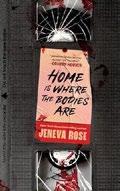
sister, who may not have disappeared forever. Beth is still reeling from the loss of her mother when her estranged siblings show up. Michael, the youngest, hasn’t been home since their father’s disappearance seven years ago. In the meantime, he’s outgrown his siblings, trading his share of the family troubles for a high-paying job in San Jose. Nicole, the middle child, has been overpowered by addiction and prioritized tuning out reality over any sense of responsibility, much to Beth’s disgust. Though their mother’s death marks an ending for the family, it’s also a beginning, as the three siblings realize when they find a disturbing videotape among their parents’ belongings. The video, from 1999, sheds suspicion on their father’s disappearance, linking it to a long-unsolved neighborhood mystery. Was it just a series of unfortunate circumstances that broke the family apart, or does something more sinister underlie the sadness they’ve all found in life? In chapters that rotate among the family’s first-person narratives, the siblings take turns digging up stories and secrets in their search for solace.
Answers are hard to come by in this twisting tale designed to trick and delight.
The Heirloom
Rosen, Jessie | Putnam (320 pp.) | $18.00 paper | May 7, 2024 | 9780593716052
down from her grandmother—being that she will never accept an heirloom engagement ring. Her grandmother believed that all the karma from whoever wore the ring in the past will come back to haunt you. When her boyfriend, John—who knows her rules—inexplicably proposes with a vintage ring, she is completely floored and filled with anxiety. While she says yes to John, she puts the ring on a necklace chain rather than on her finger, and she soon sets off to discover who had previously worn it. The jeweler who sold the ring to John has a relative, Graham, who’s a journalist looking for his next big story, so he joins the search. A trip to New York becomes a trip to Europe, and as Shea, her sister, Annie, and Graham dig deeper, they unearth the previous owners of the ring. Shea’s parents were divorced, and so were Graham’s, and they bond over that experience. Shea distrusts love, as does Graham, and the journey becomes about much more than finding out who previously owned the ring. The story veers between the cloying sweetness of grand gestures and an earnest exploration of the trauma that can follow the children of divorce into adulthood as they try to discover who their parents were as husbands and wives to each other, rather than as mothers and fathers.
A rom-com that emphasizes female autonomy and independence.
A Fire So Wild
Ruiz-Grossman,
Three siblings on very different paths learn that their family home may be haunted by secrets.
Eldest daughter Beth is alone with her fading mother as she takes her final breath and says something about Beth’s long-departed brother and
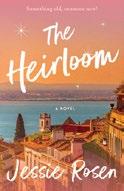
A woman who’s superstitious about heirloom engagement rings goes on a quest to discover the brides who previously wore the one she’s stuck with.
Shea Anderson is a marketing executive in Los Angeles who works on film festivals. She has four dictums that define her life, the first being that she intends to live in Italy someday and the fourth—and most important, having been handed
Sarah | Harper/ HarperCollins (208 pp.) | $25.99 Feb. 20, 2024 | 9780063305427
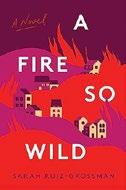
Brief scenes, spanning the perspectives of diverse characters representing Berkeley’s socioeconomic strata, sound an alarm about the threats posed by climate change.
Having covered climate and social justice issues for HuffPost, first-time
KIRKUS REVIEWS 24 MARCH 1, 2024 FICTION
A charming, profound exploration of the transformative power of stories.
novelist Ruiz-Grossman is well equipped to depict the devastation wrought by the wildfires that recently threatened heavily settled areas of California. Here, a conflagration suddenly leaps into a bougie neighborhood in the Berkeley Hills. Directly in the line of fire is a soiree organized as a combo birthday party/ fundraiser by Abigail, a committed if tone-deaf affordable housing advocate. She’s hoping to convince a developer to include low-income housing in a building nearing completion. In attendance are Abigail’s partner, Taylor, a one-time tech whiz who cashed out to become a stay-at-home mom, and their son, Xavier, now a high school senior. Recognizing that her role has become redundant, Taylor is edging into a what’s-it-all-about phase. As the marriage falters, Xavier falls for a classmate, Mar, a climate activist whose passion for ecology is matched by her ardor for social justice. Tossed into the mix is a mutually devoted homeless couple: Willow, a wan, dispirited 34-year-old survivor of childhood sexual trauma, and her dogged protector, Sunny, a sometime construction worker who wears a locket with her photo on a chain around his neck. The characters are introduced via brief glimpses framed within their individual points of view, but it’s a safe bet that—as in a formulaic disaster movie—their paths will eventually cross. Apart from one genuinely dramatic scene—caught unaware mid-tryst, the teens have no choice but to hurl themselves out a second-story window—the interactions unfurl ploddingly. The character sketches are thin, amounting to a collection of traits. The depiction of the mutually devoted
van-dwelling couple, in particular, is sentimental to the point of insulting. Though the novel is timely, even environmentalists may find its tone overly didactic.
The Underground Library
Ryan, Jennifer | Ballantine (368 pp.) | $28.99 March 12, 2024 | 9780593500385

Three plucky heroines are connected by a love of books that helps them cope through the London Blitz.
Sofie Baumann survives a risky journey out of Berlin in the spring of 1939 thanks to a visa that sets her up as a housekeeper in London. But her employer is a villain who works her to the bone, and she has little news of the sister and father she left behind. A year later, she finds solace in the Bethnal Green Library, where the new deputy librarian, Juliet Lansdown, has started a book group with the help of Katie Upwood, a library assistant. Juliet is making use of a rare job opportunity, thanks to the absence of men, as well as distracting herself from the news that her fiance is considered a deserter. Katie, meanwhile, learns that her boyfriend is missing in action overseas and then realizes that she’s pregnant. The book club provides respite: Juliet leads nightly readings, and Sofie suggests a poetry reading. When the Blitz begins in earnest and the library is bombed, Juliet and the club set up a new library in the Bethnal Green Underground Station, where
hundreds of neighborhood residents shelter at night. Along with the makeshift canteens and first aid clinics, the underground library serves its community. While the stakes are high for these characters and they each find themselves in truly dire situations, the book tends to focus more on exposition than inner lives. Crises resolve themselves quickly and seem to leave very little mark. Everyone always finds themselves back in the library, with chorus after narrative chorus about the power of books.
A well-researched but low-impact story.
Kirkus Star
The Understory
Sangsuk, Saneh | Trans. by Mui Poopoksakul Deep Vellum (320 pp.) | $17.95 paper March 12, 2024 | 9781646052752

A monk’s tales of adaptation and awe, of humans and the morethan- human.
Sangsuk’s novel, translated from the Thai by Poopoksakul, introduces us to a nonagenarian monk named Luang Paw Tien, who shares fantastical accounts of jungle life in Thailand before his village’s transition to large-scale farming and urban development. An eccentric and charismatic figure, Luang Paw Tien has retained a childlike wonder into old age and is beloved by the children who listen to his storytelling. A repository of traditional knowledge, he tells them of “a time when human settlements had been something foreign, and their accompanying fields, orchards, farms and paddies foreign land.” The present, we learn, has fallen under “the shadow of decline and deterioration,” which includes the imaginative banality of modern commercial life. But Luang Paw
MARCH 1, 2024 25 KIRKUS REVIEWS FICTION
THE UNDERSTORY
Tien’s stories—full of sensuously rich descriptions of a teeming ecosystem’s flora and fauna and of the humans who merely inhabit rather than dominate it—conjure a world of enchanted life and captivating mystery. Elephants, tigers, monkeys, boars, snakes, crocodiles, and bats take their place as charismatic protagonists here, often in tales with supernatural dimensions. Routine human practices such as hunting or rice farming are rendered evocatively and take on their own mythic significance. The novel’s extraordinary climax arrives with Luang Paw Tien’s account of how he became a monk through a terrifying battle with a demonic beast, whose assault begins with the killing of an ox: “I followed the prints, and the bloody marks around them, which seemed to grow bigger and bigger and more intensely red, and a chill ran down my spine when I saw them joined by the paw prints of a tiger, which suddenly materialized on top of and among [the ox’s] hoofprints.” This is a captivating and delightful work. A charming, engrossing, profound exploration of the transformative power of stories.
The Titanic Survivors Book Club
Schaffert, Timothy | Doubleday (320 pp.) $29.00 | April 2, 2024 | 9780385549158
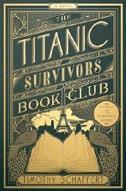
A group of assorted characters who for one reason or another never made it into their assigned berths on the Titanic form surprising bonds in Schaffert’s lush latest.
A year after the sinking of the Titanic, despondent young Yorick, who has used an inheritance to purchase an antiquarian bookshop in Paris from which he sells remarkably few volumes, receives a mysterious invitation to a party with
The novel is at its best in evoking the details of prewar life in Paris.
THE TITANIC SURVIVORS BOOK CLUB
10 other “survivors” of the disaster, including a famous actress, a mystery writer, and a toymaker, who assembled the group so they could share their stories. Yorick is particularly beguiled by Haze, a young man he sums up as “a yawn, and a stretch, and a flutter of long, ladylike eyelashes,” and intrigued by Zinnia, the Japanese American daughter of a candy magnate. Though, at Zinnia’s suggestion, the members of the group continue to assemble periodically to discuss controversial books, the plot primarily revolves around one romantic triangle: Yorick pines for Haze, who worships Zinnia, who longs for a romance with Yorick. A twist on Cyrano de Bergerac is added when Haze convinces Yorick to write love letters in his name to Zinnia. Schaffert has a much stronger gift for atmosphere than plot: He relies on the incursion of World War I, during which Haze serves as a freelance photographer, Yorick is commissioned to work as a censor, and Zinnia takes the reins of the candy company, to break the static triangle and then, postwar, wraps up the story hastily. The novel is at its best in evoking the sumptuous details of prewar life in Paris: a bookstore brought to new life by infusions of Zinnia’s cash and taste, a night at the opera where the spectators spend as much time looking at each other as listening to the music, the secret club that feels like being “inside the Chinese box where Dorian Gray kept his opium—the black and gold-dust lacquer, the patterns of curved waves, the silk, the crystal, the plaited metal threads.” For readers who enjoy swoony romance with a dash of history.
Perilous Waters
Shames, Terry | Severn House (256 pp.)
$29.99 | April 2, 2024 | 9781448311804

A smart, tough woman gets into big trouble.
Ever since problems with her alcoholic mother and drug-addicted sister washed her out of the FBI’s diver training program, Jessie Madison has worked as a dive instructor in the Bahamas. When her roommate, Shelley, is given a free weekend for two at a new resort on Trophy Cay, they hook up with boat captain Johnny Durand and his friend Nick Garnier, who seems too focused to be enjoying the tropical retreat. Johnny, who’s moving a catamaran for a wealthy couple, invites Jessie for a short night trip to a nearby cay. Soon after they’ve dropped anchor and begun to canoodle, three men in a powerboat board the cat and beat Johnny. When he refuses to give them what they want, Johnny and Jessie are tied together, wrapped in chain, and thrown overboard. Jessie’s training allows her to hold her breath just long enough to break free, but she can’t revive Johnny. Finding a battered windsurfing board, she manages to paddle back to the resort only to find that Shelley’s checked out and taken all her things, leaving Jessie dependent on the enigmatic Nick, whom she suspects of smuggling. Desperate, she finally tells Nick the truth about what happened to Johnny. In response, Nick vanishes, and the only way Jessie can get back to Nassau is by stealing the catamaran from under the noses of the
KIRKUS REVIEWS 26 MARCH 1, 2024 FICTION
killers and making the dangerous trip at night. Then things go from bad to worse.
A page-turning thriller with hints of romance and future adventures.
Dear Edna Sloane
Shearn, Amy | Red Hen Press (248 pp.)
$17.95 paper | April 30, 2024 | 9781636281223

A restless millennial editor seeks connection with a former literary starlet in this epistolary novel.
Seth Edwards is one of New York City’s many literary hopefuls: He’s an Iowa Writers’ Workshop alum desperately seeking a book deal while working as an underpaid web editor. He hears whispers that one-hit-wunderkind Edna Sloane (“kinda like Harper Lee if Harper Lee had posed for photoshoots in spandex”), who vanished from the public eye four years after her 1986 debut novel, An Infinity of Traces, shoved her into the spotlight, is not only alive, but still living in the city. Eager to get in touch with a writer he admires, and convinced that securing an interview with Edna will make his career, Seth attempts to cold email his way into her life. When he finally does get her attention, she presents him with a challenge: “If you can convince me that people still care about books—novels—stories—then maybe— maybe —I’ll do the profile.” Shearn’s fourth novel is a collage of digital and analog correspondence and documents of all sorts, from Seth’s inquiries in a true-crime subreddit to an online listing for enamel pins of Edna—“We think the air of mystery adds to her glamour!” The book swings between Edna’s late-1980s Brat Pack readings and Seth’s late-2010s clickbait-content Wild West, offering a side-by-side that underlines how precarious publishing became in the intervening decades. The protagonists’ pen pal relationship is endearing, and the book provides commentary on the industry that will appeal to career book people and pleasure readers alike. Seth’s
self-involved moaning is often funny and relatable, but Edna and her smartly written letters have such a glimmer to them that readers may find themselves wishing they could have spent the whole book with the “James Joyce-ette” who fled from fame and avoided Seth’s cliched proclamations of existential crisis. This unevenly engaging book about the passions and woes of writers stands out for its form.
Spring on the Peninsula
Shin, Ery | Astra House (224 pp.) | $26.00 April 9, 2024 | 9781662602221
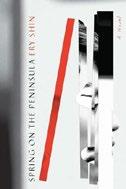
Shin’s unforgettable debut novel follows 30-something Kai as he navigates a painful breakup in Seoul. Spending his evenings drinking in late-night bars and engaging in fleeting affairs with both men and women, Kai attempts to stave off the loneliness that’s hounded him since his partner left. He treks up a mountain in a snowstorm, ill-equipped and overcome with a kind of manic, reckless abandon. He visits his recently separated parents, brooding over their decision to part ways. He trespasses on his brother’s self-imposed isolation in hopes of rekindling their bond. Though his existential angst is poignant, his cynical derision toward others and morally dubious behavior makes him an unsympathetic protagonist. (Several of his sexual liaisons take a decidedly dark turn, forcing the reader to ponder the implications of a power imbalance in the bedroom—and Kai’s capacity for abuse.) Obsessively agonizing over his partner’s desertion, Kai becomes increasingly nihilistic—an ethos shared by his close friends, all of whom are facing their own crises. The perspective occasionally switches from Kai to his various friends, revealing not only their mixed feelings toward him but the toll that loveless relationships, addiction, violence, and warped self-image have taken on millennials. Shin suggests that the thread connecting their suffering is a
sense of aimlessness, an inexorable void that none of them seem able to fill. Given that most of the characters are unlikable and the novel’s milieu is relentlessly bleak, the reader can’t be expected to feel a great deal of sympathy for Kai or his friends. But the skill with which the novel is crafted—blurring the distinctions between daydream, fantasy, and reality with lilting, metaphorical prose—is undeniable. Shin reinforces the directionless felt by her characters with a meandering, wonderfully unhurried plot. In the same way, the sense of disorientation prompted in the reader by the book’s shifting perspective and formal experimentation is undoubtedly designed to mirror the uncertainty felt by the characters. Shin masterfully locates the individual struggle to find meaning within a broader discourse, tussling with notions of class, gender, sexuality, generational divides, and war. A snapshot of a generation hopelessly conscious of their parents’ failures, at a loss as to how to proceed.
Tenderloin
Sorman, Joy | Trans. by Lara Vergnaud Restless Books (176 pp.) | $18.00 paper April 16, 2024 | 9781632063618
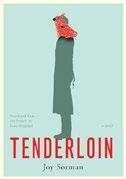
An alienated French butcher ponders the line between human and animal. When the reader first encounters Pim, the protagonist of this jarring novel, he’s the subject of a promotional video designed to get people to work with meat. “He’s in the opening shot, swathed in white and dignity, wielding a knife,” Sorman writes via Vergnaud’s translation—and, soon enough, the novel doubles back to show us Pim’s early days as an apprentice butcher. From the outset, Pim is a contradictory figure, a young man who sometimes looks at his hands and cries but will also “go mad for meat.” Over half the novel follows Pim as he learns the
>>>
MARCH 1, 2024 27 KIRKUS REVIEWS FICTION

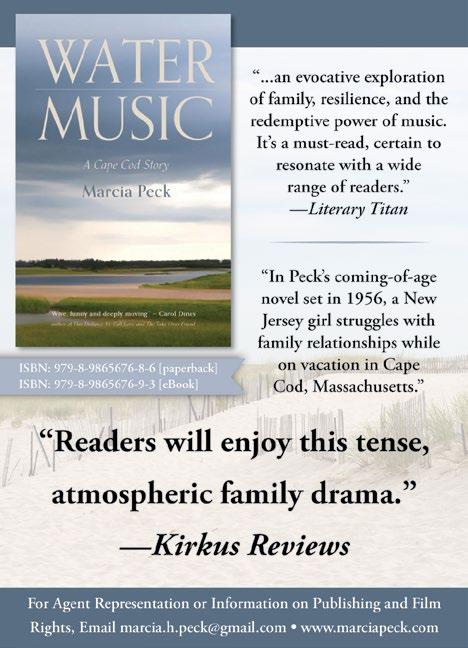


Book to Screen

Film Adaptation of The Women in the Works
Kristin Hannah’s novel was published in February by St. Martin’s.
Kristin Hannah’s The Women is headed to the big screen, Deadline reports
Hannah’s novel, published Feb. 6 by St. Martin’s, follows a 20-year-old nursing student who, in
1965, joins the Army Nurse Corps to serve in Vietnam. A critic for Kirkus called the novel “a dramatic, vividly detailed reconstruction of a little-known aspect of the Vietnam War.”
Warner Bros. Motion Picture Group acquired the rights to Hannah’s novel with plans to adapt it as a movie.
The Women won’t be the first novel by Hannah to get a screen adaptation. Her 2008 book, Firefly Lane, about the long friendship between two women in the Pacific Northwest, formed the basis for a Netflix television series created by Maggie Friedman and starring Katherine Heigl,
Sarah Chalke, and Ben Lawson. The series was a hit for the streaming service but fared less well with critics.
Hannah shared news of the adaptation of The Women on Instagram, writing, “SO EXCITED to finally share the amazing news that @wbpictures has bought #thewomen to be on the big screen. So excited for this story about the nurses who served in Vietnam to be seen as well

as read. Woo hoo! As soon as the book is out (Feb 6), we can start fangirl casting!”—M.S. Kristin Hannah


BOOK TO SCREEN // FICTION
MARCH 1, 2024 29 KIRKUS REVIEWS
Monica Schipper/Getty Images for Hello Sunshine
For a review of The Women, visit Kirkus online.
butcher’s craft, obsessively studying the bodies of the pigs and cows at the center of his profession. Occasionally Sorman takes a step back from Pim’s story and adopts a documentarylike tone, chronicling things like a particularly violent pig and a history of the slaughterhouse. Throughout, she poses philosophically weighty statements: “Does the slaughterer truly kill animals without anger and without hate? The apprentices are taught that it’s the law of nature” is one memorable example. Much as Pim is both a compelling figure and an alienating one, so too is this book unsettling in its imagery, including a reference to “enormous livers, like scarlet jellyfish.” As Pim grows older, he becomes a solitary figure, a man without friends and with only sporadic lovers. His obsessions lead him to a surreal final sequence, though it’s unclear if this will be the action that will cause him to, in Sorman’s words, “go down in the history of butchery, his name written in ink.” At its best, this novel encapsulates humans’ relationship with the food we consume. You may not look at meat the same way after reading this novel.
Kirkus Star
I Hope This Finds You Well
Sue, Natalie | Morrow/HarperCollins (352 pp.) | $28.00 | May 21, 2024 9780063320369

When a friendless office worker inadvertently finds herself able to read her co-workers’ emails, she hatches a plan to become a star employee.
Jolene Smith doesn’t fit in at work. She doesn’t socialize with her co-workers or even engage in small talk—in fact, she’s pretty sure they’re all making fun of her behind her back. Jolene takes out her frustration by
writing her real thoughts (“Deep in my core, I find you insufferable”) at the end of her emails in white text, so they’re invisible to the recipients—but when she forgets to change the text color in a diatribe against a co-worker who microwaved an especially smelly lunch, she gets caught. She’s forced to attend an anti-harassment course with the new HR guy, Clifford. Jolene is humiliated, especially when Cliff sets up new security measures on her computer. But Jolene quickly notices that there’s an unintended consequence to the changes—now she’s able to read everyone’s emails and messages. She can see the terrible things her co-workers are saying about her from the safety of their keyboards… but she can also gather intel that could help her improve her performance. With her insider knowledge, Jolene is able to do better work and start connecting with her colleagues for the first time. She also starts to realize that Cliff the HR guy is very nice—even if he is very off-limits. As Jolene gets to know her co-workers better, she sees that they all have their secret heartbreaks and struggles, just like her. But will she be able to let people see the real Jolene? In her debut, Sue creates a vivid portrait of a truly lonely, heartbroken woman. Anyone who has worked in an office will appreciate the level of detail Sue uses to describe the experience—the particular bleakness of a sad office party, the petty gossip, the alliances and enmities. Jolene starts out afraid of connection and unable to view her coworkers as anything other than adversaries. It’s immensely satisfying to see her accept that other people might actually like her, if only she has the courage to be known.
A beautiful, honest, and often funny look at loneliness and the courage it takes to simply keep going.
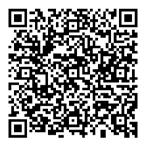
Habitations
Sundar, Sheila | Simon & Schuster (352 pp.)
$27.99 | April 2, 2024 | 9781668016107
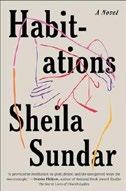
In the aftermath of her only sibling’s death, an Indian woman builds a life of purpose and connection.
For more debut fiction, visit Kirkus online.
Vega Gopalan was just a teenager when her younger sister succumbed to an illness their family was assured she would overcome. Somehow Vega’s life continues even as her sister’s has ended. She finishes college and pursues graduate work first in her native South India, then in New York. What becomes clear as she moves through her studies and finds friends and lovers is that the grief she carries impacts her ability to form relationships and engage with the world around her. It’s not as simple as grief imbuing her with a fear of abandonment. The loss acts as a film, a barrier between her and the people who wish to know her fully, even as she too longs for life’s intimacies. Over the next decade, she achieves professional success, marries, has a child, divorces, all the while excavating a yearning for kinship that too often eludes her. The story unfolds episodically, in a good way; in Sundar’s hands, the scenes tumble together hypnotically. The book captures a moment in time—before smartphones and social media as we know them today—among a particular set of people who cross international borders for higher education and enticing opportunities. The catch is that their lives can be as circumscribed by capricious visa policies and systemic prejudices as by any personal limitations. This yields a sense of transience; Sundar captures the cascades of smaller griefs as Vega and the people in her universe develop close ties when they overlap in cities and on campuses, then move on for coursework, jobs, fellowships, and family. Several stirring stretches of the novel eclipse the few plodding ones. As the book illustrates, there are always trade-offs. A debut novel that explores the contours of grief and globalization with conviction.
KIRKUS REVIEWS 30 MARCH 1, 2024 FICTION
Kirkus Star
Rainbow Black
Thrash, Maggie | Harper Perennial/ HarperCollins (416 pp.) | $18.99 paper March 19, 2024 | 9780063286870
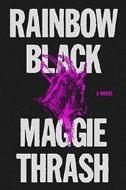
An acclaimed author of YA fiction (Lost Soul, Be at Peace, 2018, etc.) writes her first novel for adults.
In the summer of 1990, Lacey Bond’s life is upended when her parents are accused of committing ritual abuse at their New Hampshire day care center. She and her older sister, Éclair, do their best to take care of themselves and defend their mother and father, but Lacey ends up in a group home, from which she eventually escapes to help her best— only—friend. It might be hard to imagine how Lacey’s life could get worse from here, but it does. Perhaps the first thing to know about this novel is that anyone picking it up because of the satanic panic hook is likely to be disappointed. The fact that her parents are tried and convicted of crimes that are as preposterous as they are horrific certainly makes an impact on Lacey’s life, but it’s a small part of her story. Thrash packs so much into 400 pages that this novel shouldn’t work. There’s courtroom drama and family drama. There’s murder and mystery. There’s a romance complicated by, among other things, the threat of extradition. And holding it all together is an oddly shaped queer coming-of-age narrative. It does work, though, because of Thrash’s ability to create compellingly unique characters, starting with her protagonist. It’s not difficult to feel sympathy for young Lacey. Not only does she endure terrible tragedy at a young age, but every grownup in her life fails her in one way or another—sometimes spectacularly, sometimes ruthlessly. This is not to say that adolescent Lacey is one-dimensional and, when she becomes an adult, it’s easy to see her as the product of her experiences. Beyond this, Thrash does a terrific job of making every character both singular and nuanced. Éclair, for example,
is a wonder, and the lawyer Aaron Feingold is a tragicomic masterpiece. Thrash turns trauma, injustice, and hideous bad fortune into a story about resilience, reinvention, and love.
On the Tobacco Coast
Tilghman, Christopher | Farrar, Straus and Giroux (288 pp.) | $28.00 | April 16, 2024 9780374226060

To the victor go the spoils (and the resulting spoilage).
It is July 4, 2019. As the descendants of the Mason family gather for their traditional meal of salmon and peas at the plantation home of their forebears (among the earliest settlers of the Chesapeake Bay environs), the time has come for a family reckoning. The legacy of all that was wrought over the course of several generations—displacement of the Indigenous population and the use of enslaved people as laborers among the most troubling practices—weighs upon members of the group to various degrees. Relatives of the current owners are occupied as geologists, aspiring novelists, and real estate executives; all three professions provide support for holiday discussions of time, attachment to place, and responsibility for past actions. The guest list waxes and wanes but includes two French relatives who have been touring the U.S. and bring their perspectives on current U.S. culture and race relations to the table in a no-holdsbarred way. The 2019 dinner will go down in the annals of Mason history as the one when the family confronted the past and grappled with how to proceed in the face of the haunted legacy of the familial estate. An elegiac air pervades this thoughtful narrative as several family members are now of an advanced age or dealing with serious illness. Tilghman has examined various lives within the family in three previous novels, beginning with Mason’s Retreat (1996), so some summarizing takes place, but the real star of the show here is the extended dinner
conversation(s) occurring between and among the guests. While slyly giving credit to famous cinematic dinner table sequences, Tilghman sets in motion an engaging scene full of confrontation, humor, annoyance, and revelation (and the origins of the salmon and pea menu). A cleareyed look at what history has hidden.
Kirkus Star
Long Island
Tóibín, Colm | Scribner (304 pp.) | $28.00 May 7, 2024 | 9781476785110

An acclaimed novelist revisits the central characters of his best-known work. At the end of Brooklyn (2009), Eilis Lacey departed Ireland for the second and final time—headed back to New York and the Italian American husband she had secretly married after first traveling there for work. In her hometown of Enniscorthy, she left behind Jim Farrell, a young man she’d fallen in love with during her visit, and the inevitable gossip about her conduct. Tóibín’s 11th novel introduces readers to Eilis 20 years later, in 1976, still married to Tony Fiorello and living in the titular suburbia with their two teenage children. But Eilis’ seemingly placid existence is disturbed when a stranger confronts her, accusing Tony of having an affair with his wife—now pregnant—and threatening to leave the baby on their doorstep. “She’d known men like this in Ireland,” Tóibín writes. “Should one of them discover that their wife had been unfaithful and was pregnant as a result, they would not have the baby in the house.” This shock sends Eilis back to Enniscorthy for a visit—or perhaps a longer stay. (Eilis’ motives are as inscrutable as ever, even to herself.) She finds the never-married Jim managing his late father’s pub; unbeknownst to Eilis (and the town), he’s become
MARCH 1, 2024 31 KIRKUS REVIEWS FICTION
involved with her widowed friend Nancy, who struggles to maintain the family chip shop. Eilis herself appears different to her old friends: “Something had happened to her in America,” Nancy concludes. Although the novel begins with a soap-operatic confrontation—and ends with a dramatic denouement, as Eilis’ fate is determined in a plot twist worthy of Edith Wharton—the author is a master of quiet, restrained prose, calmly observing the mores and mindsets of provincial Ireland, not much changed from the 1950s. A moving portrait of rueful middle age and the failure to connect.
You’d Look Better as a Ghost
Wallace, Joanna | Penguin (336 pp.) | $18.00 paper | April 16, 2024 | 9780143136170
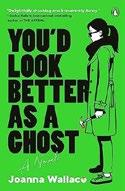
Dexter meets Killing Eve in Wallace’s dark comic thriller debut.
While accepting condolences following her father’s funeral, 30-something narrator Claire receives an email saying that one of her paintings is a finalist for a prize. But her joy is short-circuited the next morning when she learns in a second apologetic note that the initial email had been sent to the wrong Claire. The sender, Lucas Kane, is “terribly, terribly sorry” for his mistake. Claire, torn between her anger and suicidal thoughts, has doubts about his sincerity and stalks him to a London pub, where his fate is sealed: “I stare at Lucas Kane in real life, and within moments I know. He doesn’t look sorry.” She dispatches and buries Lucas in her back garden, but this crime does not go unnoticed. Proud of her meticulous standards as a serial killer, Claire wonders if her grief for her father is making her reckless as she seeks to identify the blackmailer among the members of her weekly bereavement support group. The female serial killer as antihero is a growing subgenre (see Oyinkan
Braithwaite’s My Sister, the Serial Killer, 2018), and Wallace’s sociopathic protagonist is a mordantly amusing addition; the tool she uses to interact with ordinary people while hiding her homicidal nature is especially sardonic: “Whenever I’m unsure of how I’m expected to respond, I use a cliché. Even if I’m not sure what it means, even if I use it incorrectly, no one ever seems to mind.”
The well-written storyline tackles some tough subjects—dementia, elder abuse, and parental cruelty—but the convoluted plot starts to drag at the halfway point. Given the lack of empathy in Claire’s narration, most of the characters come across as not very likable, and the reader tires of her sneering contempt. Squeamish readers will find this isn’t their cup of tea.
Silver Repetition
Wang, Lily | The New Press (272 pp.) $18.99 paper | March 26, 2024 9781620978566
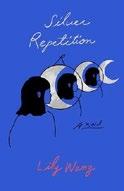
Yuè Yuè, a college student who moved from China to Canada with her family when she was a child, navigates the complexities of loss and memory.
Through Yuè Yuè ’s eyes, the world is surreal and fluid. On a date at the Poetry Jazz Café with a guy named Johnny, she notices as “a young Muhammad Ali collapses against the wall behind the bar. Before us, a crowd, swaying along with the projection, shadows continuing their side-to-side movement with each loop of light.” A few days later she’s walking to a coffee shop with Johnny when she observes “bean pods dangling from the branches. Long black pods like mummified cocoons. I feel like all my hair could fall.” Yuè Yuè notices acute details that cause her attention to wander; maybe this is why the narrative is fragmented, lithely pivoting between dream, reality, and memory. When they blend together the pacing can be uneven, the narrative
difficult to follow. The writing varies from stilted to overly ornate, but when the metaphorical language lands successfully it is a triumph: satisfying sentences filled with keen imagery. For instance, “There is heartbreak in his voice, as when one confuses the shadows of raindrops in the pond for tadpoles.” To highlight the complexity and nuance of language, Wang employs experimental approaches such as filling seven pages with the repeating words “ dēng déng děng dèng ” followed by two pages where the word is written six times on each page, unaccented, surrounded by white space. As Yuè Yuè delves deeper into her own memory the narrative becomes easier to track. She recalls her family’s emigration and the birth of her sister, Emily. She begins to uncover memories and feelings that she must reckon with. At one point, she gets help navigating feelings of loss, her mother’s advancing illness, and the strain she feels in her relationship with her sister when a version of her younger self, Little Yuè Yuè, arrives to act as a sort of mirror and magnifying glass. Full of admirable risks in language and form, but disjointed.
Kirkus Star
A Short Walk Through a Wide World
Westerbeke, Douglas | Avid Reader Press (400 pp.) | $28.99 | April 2, 2024
9781668026069
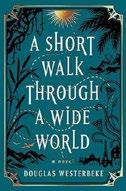
In 1885 Paris, a young girl contracts a mysterious disease that sends her on the journey of a lifetime.
Aubry Tourvel is 9 when she and her sisters, Pauline and Sylvie, stumble across a strange well in a courtyard secreted between empty apartment buildings. The well is made of smooth gray stone, and its opening has been carved to resemble a face. The siblings assume it’s a wishing
KIRKUS REVIEWS 32 MARCH 1, 2024 FICTION
well, and because the papers are full of terrible news, each resolves to sacrifice something precious for the greater good. Pauline drops in a gold chain to stop the socialists from bombing public buildings, and Sylvie gives up her doll so that Dr. Homais might cure syphilis. Aubry intends to ask for Mrs. Von Bingham’s ailing baby to heal, but when the time comes, she refuses to relinquish her prized possession: a wooden puzzle ball she discovered in a dead man’s driveway and that inexplicably finds her whenever they separate. That night, Aubry starts having seizures. She improves en route to the doctor, but upon heading home, begins bleeding from her nose, ears, and mouth. She soon realizes that to stay alive, she must keep moving, never to remain in one location for longer than three days or visit the same place twice. Part magical realism–laced travelogue, part love letter to the world, Westerbeke’s extraordinary debut spans decades, unfolding via stories told by Aubry to those she meets while circumnavigating the globe. Wonder and a sense of loneliness infuse each telling, from a stint on a Greek fishing vessel, to a love affair on the Trans-Siberian Railroad, to solo sojourns in impossible libraries seemingly located outside of space and time. Striking set pieces, stunning character work, and evocative, insightful prose make every page worth savoring.
A hopeful tale of improbable friendships, whirlwind romances, and unexpected joy.
Kirkus Star
Familiaris
Wroblewski, David | Blackstone (980 pp.) $34.99 | June 4, 2024 | 9798212194297

A great American novel of people and passions and ideas—and, of course, dogs.
For the many fans of The Story of Edgar Sawtelle (2008), this
ambitious and captivating prequel focuses on that character’s grandfather, John Sawtelle. Its nearly 1,000 pages begin in 1919 when John, who has been working as a road tester at a car factory, finds a perfect piece of land when his jalopy breaks down in middle-of-nowhere Wisconsin, where he surprises his dog, Gus, by walking 63 yards on his hands. John won’t take possession of this inspiring tract for another 300-some pages, necessary to introduce the key characters and elements Wroblewski has invented to populate his cabinet of wonders. Characters include a giant carpenter named Elbow; a World War I amputee named Frank Eckling; John’s brilliant and sensitive soulmate, Mary; a logger named So Jack Von Osten and his huge horse, Granddaddy, who can both count and give romantic counseling. Elements: none more important than a fictional 1897 volume called Practical Agriculture and Free Will by George Solomon Drencher, the source of John’s conviction that life’s purpose is to “Seek, seek, seek—the Singularism! ” John’s singularism is of course encapsulated in the breed of dog he and Mary will eventually develop, the Sawtelle dog; you’ll wait another few hundred pages for that to emerge, but the delights along the way are manifold. Like this comparison of whiskey and brandy: “Whiskey tasted like something squeezed out of an oak plank, like mentholated gasoline. Brandy was composed of equal parts sunlight and lava. Where whiskey came home looking for an argument, brandy noticed how truly simpatico you were.” One of the darker parts of the book focuses on a terrible incident involving John and Mary’s sons, setting the stage for events readers of Edgar will recall with a chill. A hilarious and moving section toward the end—by now it’s the late 1950s—follows John’s attempts to write a book called Familiaris, in which the author may or may not reveal secrets of his craft. Already having drawn comparisons to Russo, Irving, Strout, McCarthy, and Gilbert, with García Márquez added here, Wroblewski earns them all, amply rewarding readers who have been waiting impatiently for 15 years. For all the eons it may take to read it, this colossus of a book will own you.
Colton Gentry’s Third Act
Zentner, Jeff | Grand Central Publishing (400 pp.) | $30.00 | April 30, 2024
9781538756652
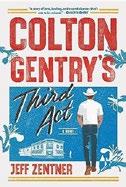
A down-on-his-luck musician returns to his hometown after the death of his best friend.
Colton Gentry should be riding high. His latest single is lighting up country radio, he’s opening for superstar Brant Lucas, and he’s married to one of the biggest singers in the business, Maisy Martin. But his best friend, Duane Arnett, has just been killed in a mass shooting at a country music festival in Tampa, and Colton is struggling through a fog of grief, unsuccessfully drowning his sorrows in alcohol, and dealing with the fallout of an interview he gave calling for gun control. Drunk on stage one night, Colton angrily responds to gun rights hecklers in front of thousands of conservative country fans. He’s dropped from the tour and his record label, and his marriage to Maisy implodes. Now back in his hometown of Venice, Kentucky, Colton resigns himself to life as a has-been. But when he runs into his high school sweetheart, Luann Lawler, a chef working in town, she offers him a job and another chance at life—and love. Shifting among Colton’s three acts—the high school football phenom of rural Kentucky, the honeyvoiced country singer in Nashville, and the preternaturally gifted farm-to-table sous chef—sometimes feels like too many disparate strings are being played, especially when subplots about grief, divorce, second-chance romance, substance abuse, and celebrity all get stage time. Readers expecting the novel to focus heavily on Colton crusading for gun control may be disappointed, as the catalyst for his return to Kentucky falls mostly to the wayside once he gets there. But with a deft hand and lush, descriptive writing, the author manages to weave it all together into a yarn worthy of a classic country record.
An emotional meditation on coming home to yourself.
MARCH 1, 2024 33 KIRKUS REVIEWS FICTION



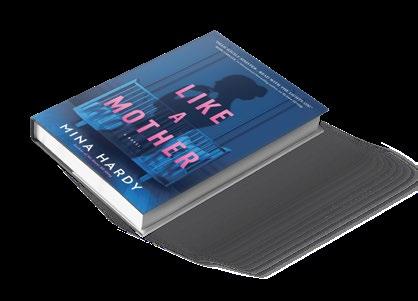

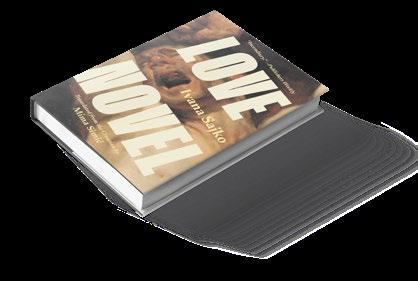


BOOKLIST // FICTION 5 Novels You Can Read in
Weekend For more books you can read in a weekend, visit Kirkus online. 1 Great Expectations By Vinson Cunningham A top-shelf intellectual bildungsroman. 2 Like a Mother By Mina Hardy A poisonous treat best consumed in a single breathless sitting. 3 Invisible Woman By Katia Lief Absolutely a novel of its time—and a novel of women’s stories across time. 4 Love Novel By Ivana Sajko; translated by Mima Simić A devastating book, humane, original, and deeply relevant. 5 The Werewolf at Dusk By David Small Surreal and searing. MARCH 1, 2024 35 KIRKUS REVIEWS
a
Murder Most Owl
Fox, Sarah | Severn House (224 pp.)
$29.99 | April 2, 2024 | 9781448312290

Returned to her aunt’s farm, a screenwriter investigates an enigmatic landowner’s death with the help of the deceased’s canine companions.
Many years ago, Georgie Johansen left her Aunt Olivia’s Oregon farm and planted her roots in Los Angeles. That should have been the right place for her given her line of work as a screenwriter, but the second Georgie sets foot back on Olivia’s farm in coastal Twilight Cove, she feels as if she’s come home. The beautiful grounds now house both a farm and a sanctuary with some adorable animals, and Callum, the new farmhand, is pretty easy on the eyes, too. The only thing Georgie isn’t as keen on is the presence of Dorothy Shale, an enigmatic woman living in the woods whose reputation as a real-life witch fits her weirdly prophetic way of interacting with the world. Georgie must not be the only person who isn’t a fan, for Dorothy is found murdered shortly after meeting her, leaving behind all that she had in the world: her two spaniels, Fancy and Flossie, and her coveted plot of land. Georgie, happy to take custody of the dogs, is certain that whoever killed Dorothy must have been interested in taking custody of Dorothy’s land. Though Georgie begins to investigate the town’s residents, suspicion falls on her and her aunt, especially after people find out that Dorothy bequeathed her land to Olivia. Luckily, Georgie has help from Fancy and Flossie, whose uncanny abilities may keep Georgie safe as she tries to find the real killer.
Even dogs with magical powers don’t distinguish this from the rest of the pack.
Death by Chocolate Raspberry Scone
Graves, Sarah | Kensington (288 pp.)
$27.00 | April 23, 2024 | 9781496744111
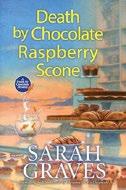
A Maine baker goes on the hunt for a doubloon and a body to boot.
As tourists flock to the town of Eastport to enjoy the summer’s warm weather, locals Jacobia “Jake” Tiptree and Ellie White feel more pressure than pleasure from the influx. Although tourists keep their bakery, the Chocolate Moose, in business, the crowds and hot weather can be a little too much in a town with limited air conditioning. And while some folks might find peace in Passamaquoddy Bay’s coastal waters, the ocean isn’t always safe. Take Paul Coates, for example, a seasoned fisherman whose boat, the Sally Ann , was found by the Coast Guard with no one aboard. Now Sally, his presumed widow and Ellie’s old friend, has to wait for a body to wash up for a burial. Sally’s alreadydim hopes for a happy ending are dashed when a life vest is found on the beach alongside Paul’s boot, a personalized piece of footwear with a secret compartment in the heel. Sally begs Jake and Ellie to find out more because when Paul’s boot was found, the antique gold coin he kept there was missing from its hiding spot. Its disappearance is no doubt a motive for murder, Sally claims. Jake is willing to be convinced, particularly as Lizzie Snow, the new police chief, doesn’t strike her as up to the job. Jake and Ellie’s investigation gets them into some unique scrapes, from a run-in with a real-life sea witch to a surprising number of unchaperoned shark encounters, but it’s when her family is threatened that Jake feels the real seriousness of what’s going on. Grittier than the typical cozy: more shark than scone.
What Cannot Be Said
Harris, C.S. | Berkley (368 pp.) | $28.00 April 16, 2024 | 9780593639184
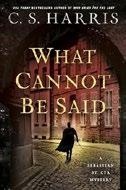
A 14-year-old British murder is duplicated in chilling detail.
Back in 1801, the wife and daughter of Bow Street Magistrate Sir Henry Lovejoy were shot dead and posed in Richmond Park. Now Lady Laura McInnis and her daughter Emma are discovered in the same spot by two young men who heard shots fired. Sir Henry has worked before with Sebastian St. Cyr, Viscount Devlin, son of the Earl of Hendon and husband to Hero, whose own father, Lord Jarvis, is cousin and powerful adviser to the king. At the time of the first murders, a man was arrested and hanged. But this new outrage tells Lovejoy and Devlin that they’re dealing with either a miscarriage of justice or a copycat. Lady McInnis’ traumatized young niece and nephew, Arabella and Percy, had been playing nearby but say they saw nothing. Her widower, Sir Ivo McInnis, is a wealthy, evil-tempered man, a noted sportsman who’s far from the best husband or father. With some help from Hero, who was a friend of Lady McInnis, Devlin digs into her life in hope of finding a motive for what can hardly be a random killing. The dissolute Prince Regent is hated by the people, Napoleon has just been captured, and the economy is in shambles, the difference between the wealthy few and the rest of the country never more apparent. Powerful forces hoping to blame the murders on anyone but the aristocrats involved are arrayed against Devlin, who nevertheless pushes on to reveal the horrifying truth.
Far from the charming world of Regency romances, this thorny mystery is a powerful exposé of privilege and inequality.
KIRKUS REVIEWS 36 MARCH 1, 2024 FICTION // MYSTERY
A delightfully realistic protagonist and plenty of madcap scenarios.
THE MAYFAIR DAGGER
At the Edge of the Woods
Houston, Victoria | Crooked Lane (256 pp.)
$31.99 | April 23, 2024 | 9781639106530

Fishing, pickleball, and murder in the Northwoods of Wisconsin.
McBride County Sheriff Lewellyn Ferris is called to a remote pickleball court where a man has been shot dead. Formerly the head of the Loon Lake police, Lew has plenty of experience but still calls on her coterie of experts. The dead man is wealthy dentist Bert Willoughby, and the person who reported the crime is Robin Carpenter, his pickleball partner. Lew, who’s also a well-known fly-fishing teacher, has plenty of contacts in the area eager to tell her how many people wanted Willoughby dead. The morning coffee crew that includes retired dentist Paul Osborne, Lew’s significant other, is a particular font of knowledge on local gossip. Notified of his death, Willoughby’s wife, June, puts first things first, visiting their lawyer to find out where she stands financially, though not before she reaches out to her daughter, Katherine, a dentist who works in her father’s practice. The two women are furious when the lawyer reveals that Willoughby had recently sold his dental practice with the proviso that Katherine be kept on as an employee; had filed papers to divorce June, though he hadn’t told her yet; and, planning to marry Robin, had rewritten his will to leave most of his money to her. June is so angry that she refuses to listen to Katherine’s explanation that Robin was his
pickleball partner and not his office assistant, who’s also named Robin. At first Lew thinks that Willoughby’s death was one of those unfortunate accidents involving a bullet that’s traveled a long distance, but when Robin—the pickleball player—is also shot dead, her opinion shifts along with the suspect list.
A meager mystery, but the sterling cast of characters and fishing minutiae provide an interesting read.
The Mayfair Dagger
January, Ava | Crooked Lane (304 pp.)
$29.99 | April 23, 2024 | 9781639107513

In Victorian London, a desperate woman fleeing her home to escape a forced marriage lands in a hectic new life.
After the deaths of her beloved brother and father, Albertine Honeycombe is left at the mercy of her cousin, who inherits the family estate and insists she marry a neighboring farmer with 15 children. Escaping with her lifelong friend, Joan, who poses as her maid, she uses every penny she has to rent a house in London and set up as a detective. Pretending to be Countess Von Dagga, she invents a husband away on the continent and soon has a client, Lady Roche, who’s being blackmailed with some indiscreet letters she wrote. Albertine goes to a ball at the home of Lord Grendel, the blackmailer, to try to steal the letters, but ends up having to drug the man when he catches her in his study. On her way out of the gala, she briefly meets Spencer Sweetman,
Marquess of Reading and Duke of Erleigh, who prefers working for Scotland Yard to lazing around. When Grendel’s found dead, Albertine fears that she accidentally overdosed him, and Lady Roche refuses to pay her. The odious Baron Wallop, who was also at the ball, accuses Albertine of stealing his wife’s tiara and murdering Grendel. Realizing that she needs to find a man to be “the face of her business” if she’s to be taken seriously as a detective, she hires Spencer. As she continues to seek jobs with Joan and Spencer’s help, Albertine digs herself into a deeper and deeper hole while attempting to discover what and who killed Grendel. Falling in love with the fake countess, Spencer must prove her innocence when she’s arrested for killing Grendel and her nonexistent husband. A rollicking comedy of errors combines mystery and romance.
Landscape of Murder
Jecks, Michael | Severn House (240 pp.)
$29.99 | April 2, 2024 | 9781448310937
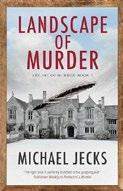
An English artist’s discerning eye puts him in danger.
Nick Morris is a talented artist who scratches out a living painting portraits of cats. Then his banker friend Geoff Hatch invites him to lunch and offers him a chance to paint a house portrait for Derek Swann, a wealthy entrepreneur who’s selling up and moving overseas. A few weeks later, Nick nurses his beloved Morgan along to the Peak district, where he’s rented a chalet in a holiday park for the duration, and is immediately hailed by his flamboyant neighbor, writer Megan Lamplighter. After noticing a nervous teenager hanging around and a series of off-putting bikers, Nick leaves to meet Swann at the picturesque village of Tissington. Oddly, Swann takes off at the appearance of a Harley rider who seems to be following that nervous boy. Biker Jez Cooper tells Nick a tale of how Swann
MARCH 1, 2024 37 KIRKUS REVIEWS MYSTERY // FICTION
cheated him out of his software company. As he makes the preliminary sketches for his portrait, Nick can’t help but notice some odd goings-on that he attributes to drug dealing. Someone takes Nick’s observant ways for snooping. The results are a break-in at the chalet, enough physical threats to make him nervous, and a stolen car part that forces him to bike to his destinations. Then, while they’re on a walk, he and Megan find the body of the young man, who turns out to have been Cooper’s son. Megan makes up a number of fanciful stories to account for all the strange happenings, but Nick looks for more rational explanations, especially after he learns that the young man was stabbed. A delightfully realistic protagonist and plenty of madcap scenarios add up to a fun read.
Molten Death
Karst, Leslie | Severn House (224 pp.)
$29.99 | April 2, 2024 | 9781448312160

A recuperative trip to Hawaii doesn’t go as planned.
Valerie Corbin and her wife, Kristen, have come to Hawaii hoping that a change of scene will help Valerie recover from the horrors of the car crash that killed her brother and nearly killed her. Staying with a friend on the Big Island, they’re glad when the heavy rains stop just in time for a pre-dawn trip to watch the lava flow from a nearby volcano. When her friends start climbing, Valerie stays behind to enjoy “the lava beast spread[ing] its limbs in its nonstop march downhill”—but she soon sees a boot-encased foot disappearing under the lava and instantly flashes back to her crash. Though neither her friends nor the police believe she really saw a body, Valerie resolves to investigate in the absence of any evidence. In the meantime, the couple continues to enjoy what the island has to offer. For Kristen, that’s
A bull dancer’s curious nature may prove the death of her in ancient Crete.
ON THE HORNS OF DEATH
great surfing, while Valerie, whose brother owned a restaurant, enjoys the local foods she finds at the farmers markets. Reading the newspaper over breakfast the next morning, Valerie finds someone who might have belonged to that foot. She pokes around, asking questions about matters that are sensitive to several groups: activists for Hawaiian independence, opponents of a geothermal project, avocado thieves, and some low-level drug dealers. Even as she learns more about Hawaiian culture, she can’t forget what she saw and continues to pursue clues likely to put her in danger.
The mystery is overshadowed by the fascinating look at all things Hawaiian.
On the Horns of Death
Kuhns, Eleanor | Severn House (224 pp.)
$29.99 | April 2, 2024 | 9781448310883
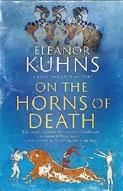
A bull dancer’s curious nature may prove the death of her.
In ancient Crete, bull dancing is for the brave and agile. Martis, the rebel of her family, still finds it thrilling. Arriving at the caves under Knossos one day, Martis immediately realizes that something is very wrong: The bull chosen for the upcoming sacrificial ceremony is clearly upset. Looking through a crack in his pen, Martis sees a dead body that’s soon identified as Duzi, a captured pirate who’d volunteered to join the bull dancers rather than be executed. Martis tells Tinos, consort to the High Priestess and a former bull dancer himself, that she’s
sure Duzi was murdered—he was terrified of bulls, she says, and would never have entered the pen on his own. Not to mention the stab wounds on his chest. Although Martis has solved murders in the past, Tinos, whom she adores, rebuffs her, which makes her only more determined to investigate. Soon Martis must decide if she will continue bull dancing now that it’s nearly time for the agoge, her initiation into adulthood, after which she’ll be pressured to marry by her mother, a weaver who’s already lost two daughters to violence. Martis hates to think that the killer is a fellow dancer, but Duzi knew hardly anyone else. Ruling out the youngsters, she begins to pry into the lives of the adult dancers. A visit to Duzi’s room turns up a very expensive piece of jewelry that two male members of the dance team claim as their own. When another dancer is murdered, Martis is not deterred, even by the possibility that she’ll be next. A convoluted mystery seamlessly woven into a wealth of historical detail.
Death of an Author
Lorac, E.C.R. | Poisoned Pen (256 pp.) | $15.99 paper April 30, 2024 | 9781464216268

Another rarity for the British Library Crime Classics: a witty, ingenious mystery finally returned to print after 89 years. Against all odds, publisher Andrew Marriott succeeds in attracting his most unlikely author, reclusive crime novelist Vivian Lestrange, to a private
KIRKUS REVIEWS 38 MARCH 1, 2024 FICTION // MYSTERY
Someone has it in for several of San Francisco’s privately owned roads.
CIRCLE IN THE WATER
dinner with another, celebrity author Michael Ashe, who wants to try his hand at a crime novel himself. The first surprise is that Lestrange turns out to be a young woman who engages Ashe in spirited argument. The second and third come three months later, when Eleanor Clarke, Lestrange’s secretary, reports to the police that both her employer and his housekeeper, Mrs. Fife, have vanished (two more characters will eventually follow suit). It turns out that Lestrange is a man after all, whom Clarke impersonated for that dinner with her employer’s full knowledge and amused cooperation. Inspector Bond, of the Hampstead police, and Chief Inspector Warner, of Scotland Yard, have distinctly different theories about the case. Their disagreements, sharpened by the discovery of an unidentifiable body in a burned-out rural cottage, give the pseudonymous Lorac (1894–1958), who clearly enjoys taking revenge on the early reviewers who thought she was a man, plenty of chances to bring different theories of the puzzle into dialogue with each other. “Detecting consists of asking the right questions,” Warner asserts, and the biggest conundrum in this case is clearly whether the right question is “Who killed Vivian Lestrange?” or “Who is Vivian Lestrange?” Alert readers will beat the

sleuths to the answer, but probably not by much. A rewardingly tangled discovery that’s aged like fine wine.
Every Time I Go on Vacation, Someone Dies
Mack, Catherine | Minotaur (352 pp.) $28.00 | April 30, 2024 | 9781250325853

A mystery writer’s celebration of the 10th anniversary of her fact-based debut novel entangles her in—spoiler alert—another murder.
A decade ago, Eleanor Dash partnered with dashing private eye Connor Smith to bring down an Italian crime family. Flushed with success, she wrote When in Rome, a novel in which she changed her name but not Connor’s; he responded by demanding 10% of her advance and then, when the book turned out to be a success, 20% for the eight novels in the series she’s published since then. Now a mystery tour of Italy, during which she hopes to work on her latest, Amalfi Made Me Do It , has reunited Eleanor and Connor, along with Harper Dash, the younger sister whose dreams of publishing her own novels have been put on hold indefinitely while she works as Eleanor’s assistant; Allison Smith, the ex-wife Connor hid from Eleanor during their romance back then; Oliver Forrest, the boyfriend Eleanor replaced with Connor at the time; and several other mystery novelists and their fans, including
Crazy Cathy, who’s so persistent in her attentions that Eleanor has served her with an injunction. Eleanor loves her career, loves Italy, and loves both Connor and Oliver. Mainly, though, she loves herself and her prowess as a mysterymonger who turns out to be a lot less tricky than her models. Readers with a taste for self-reflexive self-infatuation are advised to skip the story proper—which takes an unconscionably long time to produce a corpse and even longer before Eleanor reviews the evidence and comes up with the wrong conclusion—and just read the 237 footnotes, many of them referencing other footnotes. How adorable is that? Brightly written piffle. To use the heroine’s own bugaboo assessment: Meh.
Circle in the Water
Muller, Marcia | Grand Central Publishing (224 pp.) | $28.00 | April 23, 2024 9781538724521

Just when you think things can’t get any worse for San Francisco, miscreants prowl the area determined to prove otherwise.
Someone has it in for several of the city’s privately owned roads. Now that vandals have dumped fertilizer, broken windows, spray-painted graffiti, and otherwise made life miserable for the residents of four different streets, a grassroots neighborhood coalition has hired private investigator Sharon McCone to keep an eye on Rowan Court, the most recent target, presumably so that she can report on the horse that’s already left the barn. A map that’s dropped off at the home of Ted Smalley, McCone’s office manager, sends her in a new direction, toward Herrera Terrace. Could that be the next spot the vandals have in mind? Why are they carrying out this campaign in the first place, and why are they
For more by E.C.R. Lorac, visit Kirkus online. MARCH 1, 2024 39 KIRKUS REVIEWS MYSTERY // FICTION
tipping her off? McCone’s questioning of Theresa Segretti, her coalition contact at Rowan Court, and Sam Sage, an internet influencer/meth cooker on Bancroft Lane, comes up empty-handed. Meanwhile the latest casualties of the war on the streets are Sam’s meth lab and then Sam himself, whose flight to a cousin’s distant home extends his life by only a few hours. The motive for all this misbehavior is likely to puzzle readers a lot less than McCone and Hy Ripinsky, her husband and partner, but the identity of the perps is more surprising. Although you can see why Ripinsky announces at the end, “Well, McCone, this sure has been one of our more stressful experiences,” fans will probably nod in recognition rather than flinch under the stress.
Once again, Muller combines a heartfelt but routine investigation with strong elements of a family reunion.
How to Solve Your Own Murder
Perrin, Kristen | Dutton (368 pp.) | $28.00 March 26, 2024 | 9780593474013

An aspiring mystery writer sets out to solve her great-aunt’s murder and inherit an estate.
Twenty-fiveyear-old Annie Adams has never met her greataunt Frances, who prefers her small village to busy London. But when a mysterious letter arrives instructing Annie to come to Castle Knoll in Dorset to meet Frances and discuss her role as sole beneficiary of her great-aunt’s estate, Annie can’t resist. Unfortunately, she arrives to find Frances’ worst fears have come true: The elderly woman—who’s been haunted for decades by a fortuneteller’s prediction that this will happen—has been murdered, and her will dictates that she will leave her entire estate to Annie, but only if
Fame is fleeting, but murder’s always exciting in Roker’s latest romp.
MURDER ON DEMAND
Annie solves her killing. It’s a cheeky if not exactly believable premise, especially since the local police don’t seem terribly opposed to it. Annie herself is an engaging presence, if a little too blind to the fact that she could be on the killer’s to-do list. Her roll call of suspects is pleasingly long, including but not limited to the local vicar, a one-time paramour of her great-aunt’s; a gardener who grows a lot more than flowers; shady developers and suspicious friends from Frances’ past; and Saxon, Annie’s crafty rival, who inherits the estate himself if he manages to solve the case first. Annie pieces together clues through readings of Frances’ journal, but the story eventually runs aground on the twin rocks of too much explanation and a flimsy climax. Cute dialogue gives way to lengthy exposition, and by the time Frances’ killer is revealed you may well be ready to leave Annie, Dorset, and Castle Knoll behind for the firmer ground of reality. Fans of cozy mysteries are likely to be more forgiving, but if you cast a skeptical eye toward amateur sleuths, this novel won’t change your mind about them. Breezy, entertaining characters and a cheeky premise fall prey to too much explanation and an unlikely climax.

For more mysteries,
Murder on Demand
Roker, Al & Matt Costello | Blackstone (264 pp.) | $27.99 | April 23, 2024
9798200923243
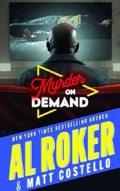
Even off the air, celebrity chef Billy Blessing finds his way to A-list adventure. After scandal ended Billy’s spot on Wake Up, America! , a network morning show, and his restaurant burned down, the chef decamps to the decidedly untrendy North Fork of Long Island to start over. His new place, NoFo Eats, serves classic French dishes, but the clientele is a far cry from the sophisticates Billy entertained before. So when a young woman in a sleek tailored suit turns up at the bar drinking Uncle Nearest 1856, he knows that something must be up. Lisa Cowles admits she’s traveled from Manhattan for more than Billy’s steak au poivre. She wants the chef, who’s got a nose for murder, to investigate the disappearance of her father, fisherman Jack Landry. Landry left Cioffi’s Marina in his little boat several weeks ago headed for Gardiners Island. The sea got rough, and he never returned. Though she spent precious little time with her absentee dad, Lisa still wants to know what happened, and she’s willing to pay handsomely for the information. Since NoFo’s closed for the next week, Billy agrees, and a little poking around with Northold police chief Lola Bristow persuades
visit Kirkus online. KIRKUS REVIEWS 40 MARCH 1, 2024 FICTION // MYSTERY
Murder mars the opening of a summer wedding venue in historic Maine.
TORN ASUNDER
him there’s something hinky about Landry’s disappearance. Before his investigation gets going, though, his former boss Gretchen Di Voss calls him with big news: streaming service Worldwi de wants to launch a cooking show with Billy “ front and center.” Worldwide couldn’t care less about the scandal that turned the network against Billy, and they want him back in New York immediately. Weighing Cowles’ hefty retainer against Worldwide’s bonanza and quiet, predictable Northold against the glitzy Big Apple is only the start of a dilemma inside a puzzle inside an enigma that the adventurous Billy faces. Fame is fleeting, but murder’s always exciting in Roker’s latest romp.
Torn Asunder
Ross, Barbara | Kensington (256 pp.) | $8.99 paper
April 23, 2024 | 9781496735737

Murder mars the opening of a summer wedding venue in Maine. From Father’s Day through Columbus Day, the Snowden Family Clambake entertains visitors to rustic Morrow Island. This year, the Snowdens have added a new feature: Their historic family home, Windsholme, is now hosting catered events. Ceramic artist Zoey Butterfield takes advantage of her long-standing friendship with Julia Snowden to book the newly renovated mansion’s very
first wedding, and Julia couldn’t be happier, or more nervous. Not only is she serving as host and event planner, but she’s Zoey’s maid of honor, and is therefore determined to make sure that her parentless, siblingless best friend has the traditional wedding she’s always dreamed of. The odds aren’t in Julia’s favor, though, since the storm forecast for the night of the rehearsal leaves only a narrow window to ferry 100 guests to the island for dinner, return them to the mainland for the night, and then get them back for the ceremony the next day. But the death of a guest at the rehearsal dinner makes the schedule even trickier. A handful of other guests, including Julia’s boyfriend, Tom Flynn of the Maine State Police, unexpectedly need to stay on Morrow Island, and the storm knocks out all the power, including cell service, so no one can contact the medical examiner. Worst of all, no one can identify the deceased guest: The groom’s family thought he belonged to the bride, and the bride’s family assumed he belonged to the groom. It’s hard to solve a murder when no one knows who the victim is or what he died from, but redoubtable Julia rises to the challenge.
A swarm of cliches threatens to overwhelm the latest in this longlived cozy franchise.

The Poison Pen
Shelton, Paige | Minotaur (304 pp.) | $27.00 April 9, 2024 | 9781250890603
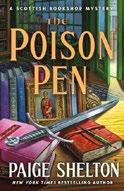
For more by Barbara Ross, visit Kirkus online.
An ancient artifact may be the motive for murder. Several weeks after the death of Queen Elizabeth II, Delaney Nichols is still feeling sad, but an unexpectedly diverting adventure begins when her boss, Edwin MacAlister—owner of the Cracked Spine bookstore in Edinburgh—asks her to research a rare and valuable object that an old friend recently discovered on her property. When Delaney’s friend Elias drives her to the estate of Jolie Lannister, a large gothic mansion reminiscent of horror films, she’s shocked by the clutter inside. Jolie’s lawyer, Bowie Berry, is there with an auctioneer she hired on her own initiative to inventory the house and possibly sell some of the contents. The object in question, which Jolie has kept hidden in a garden shed, seems to be a medieval Crusader sword covered in grime and rust. Near it they find the body of auction house assistant Alban Dunning, killed with a garden rake. Delaney texts Inspector Winters, the friend she’s worked with on several murder cases, and soon her expertise and desire to help Jolie have her deeply involved. The sword is eventually taken to the Scottish government’s Treasure Trove Unit, whose new director at first accuses Edwin of stealing the sword but eventually allows Delaney to clean and examine it. On top of all this, there’s the possibility that Jolie is the biological daughter of the Duke of Windsor, the abdicated king, and may have a claim to the throne. So many questions without answers have Delaney and her friends working full-out to find the truth. Historical information and an interesting cast of characters make up for the easily solved mystery.
MARCH 1, 2024 41 KIRKUS REVIEWS MYSTERY // FICTION
An undead assassin seeks to get out of an impossible contract.
THE
DEAD CAT TAIL ASSASSINS
Here in the (Middle) of Nowhere
Anastacia-Renee | Amistad/HarperCollins (160 pp.) | $17.99 paper | March 12, 2024 9780063221673
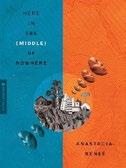
An exploration of the mystic within community, told through poetry and flash fiction.
This abstract collection, while centered on a compilation of images and themes, including vampires, shared and individual spaces, patron saints, and Black and queer femininity, functions best when approached sonically. As the words flow from one piece to the next in a manner mimicking spoken-word poetry, a world slowly begins to emerge. It could perhaps be our world, with quiet lunchroom dramas, apartments, and cheating men—or it could be another world entirely, the world of a goddess named “lucile” and of a great tree and of the patron saints of lipstick, bars, and more mundane—or divine—things. While not strictly science fiction or Afrofuturism, this work instead draws on concepts from fantasy and SF such as witches and vampires and on Afrofuturistic themes of optimistic futures and presents. More than anything, the fantastic is a metaphor for how our own reality could be. Throughout these lines, children grow, women explore their relationships and their identities, and we bear witness to a community that changes and flourishes through both the bad times and the good. Best when read aloud, this narrative can be taken in small quantities as individual narrators tell their stories
or taken as one whole, greater than the many stories contained within. Loose poetry and fictions playing on sounds and images and multiple planes of resonance.
Kirkus Star
The Familiar
Bardugo, Leigh | Flatiron Books (400 pp.) $26.99 | April 9, 2024 | 9781250884251

In 16th-century Madrid, a crypto-Jew with a talent for casting spells tries to steer clear of the Inquisition.
Luzia Cotado, a scullion and an orphan, has secrets to keep: “It was a game she and her mother had played, saying one thing and thinking another, the bits and pieces of Hebrew handed down like chipped plates.” Also handed down are “refranes”—proverbs—in “not quite Spanish, just as Luzia was not quite Spanish.” When Luzia sings the refranes, they take on power. “Aboltar cazal, aboltar mazal” (“A change of scene, a change of fortune”) can mend a torn gown or turn burnt bread into a perfect loaf; “Quien no risica, no rosica” (“Whoever doesn’t laugh, doesn’t bloom”) can summon a riot of foliage in the depths of winter. The Inquisition hangs over the story like Chekhov’s famous gun on the wall. When Luzia’s employer catches her using magic, the ambitions of both mistress and servant catapult her into fame and danger. A new, even more ambitious patron instructs his supernatural servant, Guillén Santángel, to train Luzia for a magical
contest. Santángel, not Luzia, is the familiar of the title; he has been tricked into trading his freedom and luck to his master’s family in exchange for something he no longer craves but can’t give up. The novel comes up against an issue common in fantasy fiction: Why don’t the characters just use their magic to solve all their problems? Bardugo has clearly given it some thought, but her solutions aren’t quite convincing, especially toward the end of the book. These small faults would be harder to forgive if she weren’t such a beautiful writer. Part fairy tale, part political thriller, part romance, the novel unfolds like a winter tree bursting into unnatural bloom in response to one of Luzia’s refranes, as she and Santángel learn about power, trust, betrayal, and love. Lush, gorgeous, precise language and propulsive plotting sweep readers into a story as intelligent as it is atmospheric.
The Dead Cat Tail Assassins
Clark, P. Djèlí | Tordotcom (224 pp.) | $20.99 April 23, 2024 | 9781250767042
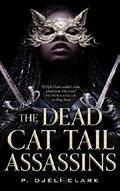
An undead assassin seeks to get out of an impossible contract.
If a writer introduces three unbreakable laws (or in this case, vows), it’s because they intend a character to break at least one of them. Eveen is a member of the Dead Cat Tail Assassins; when still alive, she promised her afterlife existence to the goddess Aeril, Matron of Assassins. Resurrected without any memory, she has vowed only to accept just contracts, never kill anyone she’s not contracted for, and always carry out the hit. But on the night of Tal Abisi’s Festival, Eveen runs into a conflict with vow number three: The target appears to be her younger self, Sky, pulled out of time. If she goes through with the contract, Eveen might blink out of existence; if she
KIRKUS REVIEWS 42 MARCH 1, 2024
FICTION // SCIENCE FICTION AND FANTASY
doesn’t, Aeril will certainly punish her (and anyone connected to her) with a fate worse than death. Someone has clearly targeted Eveen for a nasty piece of revenge, and she’s only got until dawn to find the mastermind and figure out a contract loophole, all while keeping Sky safe and dodging the assassins from her own guild, who intend to carry out the contract and stave off Aeril’s wrath. Like the creations of the Clockwork King, whose defeat is celebrated during the festival, the plot’s gears click along in a somewhat predictable and yet marvelous fashion; even if the reader can figure out where the story is likely to go, the payoff is fun and the journey is full of action and amusing dialogue. Eveen is a delightful character, trying to seize what joy and remnants of her moral compass she can. She’s obviously bothered by not knowing what happened in her mortal life that led her to strike a bargain with Aeril; that concern comes to the fore when she encounters the innocent Sky, who can’t comprehend how she would ever become someone like Eveen. Clark wisely doesn’t answer all our questions on that front. The idea that the relationship between mortals and the divine could be founded on a legal contract rather than faith seems to be a favored concept of more than one fantasy author (most prominently, Max Gladstone), but there’s still juice in that trope.
Well crafted, exciting, darkly comic, and just gory enough.
Floating Hotel
Curtis, Grace | DAW (304 pp.) | $28.00 March 19, 2024 | 9780756419301

Political and personal dramas unfold at a traveling space hotel. The Grand Abeona Hotel essentially a cruise ship in space—trundles from planet to planet. It’s not nearly
as glamorous as it used to be, but it’s a welcome refuge to regular guests and to staffers who have escaped poverty, military service, criminal prosecution, and/or the crushing fist of the autocratic government to make it their home. Now, their settled existences are on the verge of catastrophic change. The attendees of an academic conference held onboard every year, which is usually a boondoggle, are urgently tasked with decoding a mysterious message. Spies have sneaked on ship in search of a mysterious figure known as the Lamplighter, who issues seditious dispatches about the 500-year-old Emperor and the corrupt aristocrats of his court. If the Lamplighter isn’t found by the time the ship exits deep space, imperial authorities will arrest the entire hotel staff. What is the message? Who and where is the Lamplighter? And is hotel manager Carl really as kind—and as oblivious—as he appears to be? Initially this looks like a cozy SF story about found family, set among the colorfully rendered staff and guests of a large establishment in the vein of many British period dramas. But the narrative rapidly turns toward thriller, and some of the secrets that these characters hold are very dark. That swerve is both intriguing and entertaining, but unfortunately, it doesn’t quite pay off. The resolution to the central conflict comes across as rushed, not appropriately cathartic, and doesn’t resolve much other than the immediate situation. It’s unclear whether this book is a stand-alone or the first in a series. If the former, the author leaves a great deal of plot threads and budding relationships dangling; if the latter, even the promise of future installments would not entirely compensate for these lacks. In particular, a more detailed backstory for the Lamplighter (in contrast to the beautifully detailed pasts of the other characters) would have been appreciated, especially as a large political crisis still looms. The journey is great; the destination somewhat disappointing.
Kirkus Star
The Weavers of Alamaxa
Elsbai, Hadeer | Harper Voyager (352 pp.)
$32.00 | March 19, 2024 | 9780063114807

Magic, political upheaval, and outside invaders collide in the second installment of the duology begun in The Daughters of Izdihar (2023).
For Giorgina
Shukry, Nehal Darweesh, and Malak Mamdouh, things have gone from bad to worse. While at first it seemed the Daughters of Izdihar were making headway in their fight for women’s equality, including being in training to use the magical practice of elemental weaving, Giorgina and Malak are now fugitives and Nehal is trapped in a neighboring kingdom—a kingdom whose troops, along with frightening new technology, are fast approaching the women’s home of Alamaxa. With war on the horizon, the three fight both to save those they love and to build a new world, while contending with new, occasionally dubious, allies and revelations about weaving that could mean salvation or devastation. As the world of Ramsawa, based on Egypt, expands in this second installment, Elsbai has more room to explore prescient topics of social and political change and their fallout. The new characters add more complications to an already gripping setting without overwhelming the narrative. But, at its core, this is an exploration of the platonic and romantic relationships among women and their own personal journeys as they realize their ambitions and come to terms with all aspects of themselves. The fully formed grounded setting, exhilarating magic, and all-too-real political machinations make a satisfying backdrop for further exploration of Nehal and Giorgina’s journeys. A strong conclusion that never fumbles with the themes or ideas it seeks to tackle.
MARCH 1, 2024 43 KIRKUS REVIEWS SCIENCE FICTION AND FANTASY // FICTION
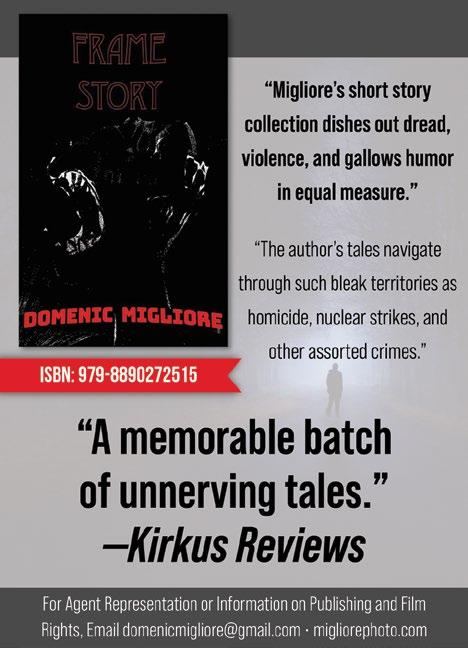




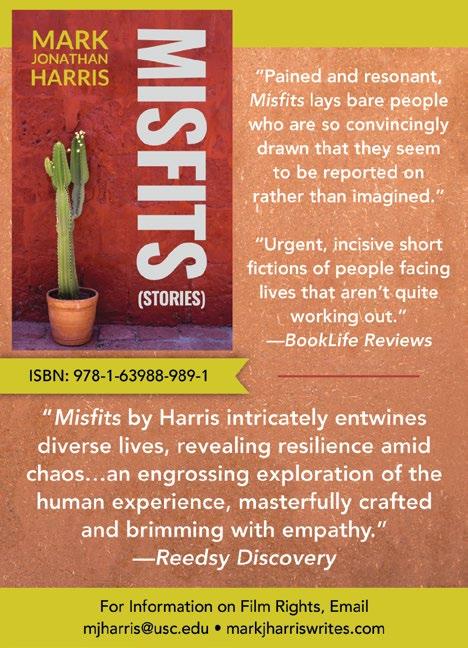
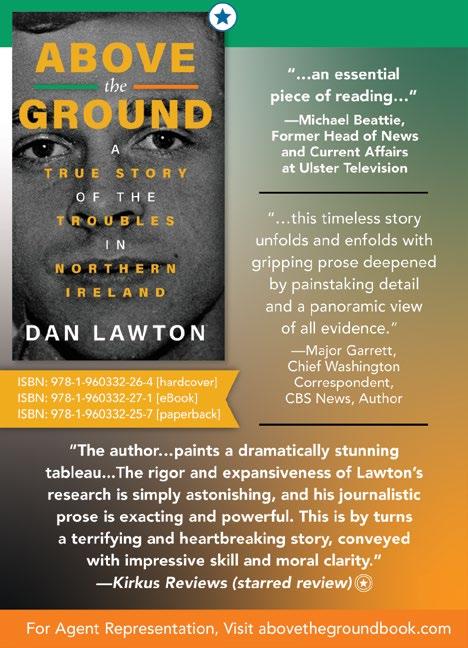
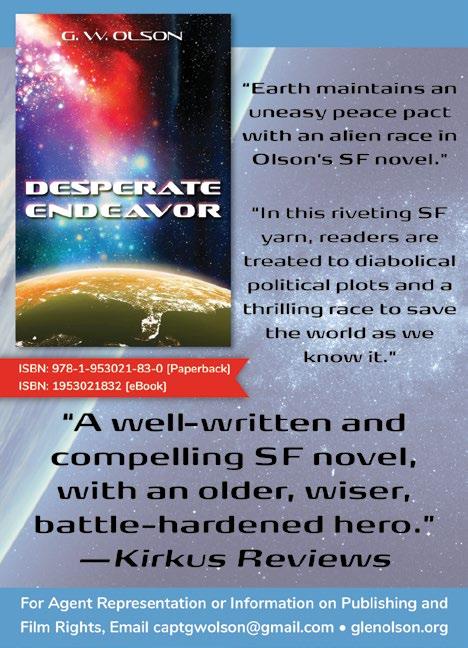
Nonfiction
GEARING UP FOR MARCH MADNESS (WITH BOOKS)
ONE OF MY FAVORITE times of year is imminent: March Madness, that multiweek feast of triumph and heartbreak that is the NCAA basketball tournament. I’m not just talking about the men’s sport; as a South Carolinian, I’d be remiss not to mention my undefeated and No. 1 ranked Gamecocks women’s team, current favorites to win the national championship in a few months. To get in a hoops frame of mind, I’d like to recommend two pertinent March books.
You can’t go wrong with anything by Hanif Abdurraqib, former Kirkus Prize finalist and acclaimed author of A Little Devil in America , Go Ahead in the Rain , and They Can’t Kill Us Until They Kill Us . In his latest book, There’s Always This Year: On Basketball and Ascension (Random House, March 26), the author delves into one of his favorite topics, basketball, in what our critic calls “an
innovative memoir encompassing sports, mortality, belonging, and home.” When he was a kid, Abdurraqib, who is from Columbus, Ohio, grew up celebrating the talents of local basketball legends, none more iconic than LeBron James, and he interweaves his thoughts on basketball and sports in general into a deeper investigation of identity, family, and community.
“Abdurraqib’s complex love of the sport and its players,” notes our review, “mirrors the complexity of his love for his home state, where he’s spent time unhoused as well as incarcerated, and where his mother passed away when he was only a child.”
There’s Always This Year is a book not just for basketball fans, but for anyone interested in philosophical meditations on home, as well as tales of personal triumph against difficult odds.
My next suggestion will be most appealing to

college basketball fans, especially those who appreciate the storied history of the game. Anyone with even a passing interest in the game is aware that UCLA is one of the most successful college basketball programs ever, one of the true blue bloods, along with Kentucky, Kansas, Duke, and North Carolina. In Kingdom on Fire: Kareem, Wooden, Walton and the Turbulent Days of the UCLA Basketball Dynasty (Atria, March 5), veteran sportswriter Scott Howard-Cooper takes readers into the very heart of UCLA basketball. As coach John Wooden built a dynasty that would eventually encompass 10 championships from 1964 to 1975, he was also struggling to relate with a new generation of players that included future legends Kareem


Abdul-Jabbar (then Lew Alcindor) and Bill Walton, long-haired hippie and consummate Deadhead.
It was a tumultuous time but ultimately, writes our reviewer, “the three men learned from each other, sharing notable victories and stinging losses. At the end of his career, Wooden was more relaxed and beloved as a kind of grandfather to the world; Abdul-Jabbar became more forgiving while still working ceaselessly for civil rights; and Walton, still a hippie, became inclined to kindness and tempered observations.”
Howard-Cooper provides a treasure trove of fascinating stories for hoopheads of all generations, in a book sure to please not just UCLA Bruins fans, but followers of the college game in general.
Illustration by Eric Scott Anderson
ERIC LIEBETRAU
Eric Liebetrau is the nonfiction editor.
KIRKUS REVIEWS 46 MARCH 1, 2024
EDITOR’S PICK
How three women made indelible marks on fashion and feminism during the French Revolution.
Higonnet, a professor of art history at Barnard, crafts a comprehensive profile of the Three Graces, Frenchwomen who changed the face of fashion throughout the late 18th century. Frustrated with the constraints of the age, each of these women defied previously set European sumptuary laws and dress codes and embraced shopping and self-made fashion trends accentuating the female form. Joséphine Bonaparte, future empress of France and a woman with Creole roots, combined the Black cultural flare of Martinique with Indian style to create a “fairy-tale wardrobe” of diaphanous dresses awash in
color and flare and redingotes that trod the tabooed edges of androgyny. Higonnet also shares the provocative story of European beauty Térézia Tallien, confined to a family-arranged marriage at 14 to achieve French nobility and jailed for a month after being arrested in an “edifice of conical bone stays, layered petticoats, and a three-piece silken gown.” Juliette Récamier was also relocated to urban France “to be restyled” and eventually became a socialite and intellectual muse enamored with transforming the landscape of Parisian fashion. The women’s collective attires exuded power, sexual seduction, social superiority, and counterrevolutionary defiance. Higonnet generously illustrates the book with polychromatic line drawings

and full-color oil paintings of the trio, their striking taste in textiles and accessories, and the evolution of their lavish apparel throughout a period in history when much of Europe became seduced with “beauty leveraged by courage and style.” In this ideal text for fashion course curriculums and students of fashion history, Higonnet
demonstrates her meticulous research in energetic prose that vibrantly captures the lives of these three revolutionary champions of chic European finery and women’s liberation. A passionately rendered history of three “style mavericks” who ushered in a defining fashion revolution.
These Titles Earned the Kirkus Star 49 World on the Brink By Dmitri Alperovitch with Garrett M. Graff 54 Cactus Country By Zoë Bossiere 55 The Whole Staggering Mystery By Sylvia Brownrigg 56 Throne of Grace By Tom Clavin & Bob Drury 57 Prairie, Dresses, Art, Other By Danielle Dutton 47 Liberty, Equality, Fashion By Anne Higonnet 63 The Year of Living Constitutionally By A.J. Jacobs 68 The Museum of Other People By Adam Kuper 72 The Puerto Rican War By John Vasquez Mejias 75 I Just Keep Talking By Nell Irvin Painter 78 The Serial Killer’s Apprentice By Katherine Ramsland & Tracy Ullman 78 Chaim Weizmann By Jehuda Reinharz & Motti Golani; trans. by Haim Watzman 80 Empireworld By Sathnam Sanghera 80 The Light Eaters By Zoë Schlanger 81 The Moment By Bakari Sellers 84 Free Love By Robert Shaplen 85 Double Exposure By Robert Sullivan 89 Out of the Darkness By Frank Trentmann 90 Jelly Roll Blues By Elijah Wald Liberty, Equality, Fashion: The Women Who Styled the French Revolution Higonnet, Anne | Norton | 304 pp. $35.00 | April 16, 2024 | 9780393867954
MARCH 1, 2024 47 KIRKUS REVIEWS NONFICTION
A Leader’s Destiny: Why Psychology, Personality, and Character Make All the Difference
Aboujaoude, Elias | PublicAffairs (320 pp.)
$30.00 | May 21, 2024 | 9781541703018

A psychiatrist and researcher at Stanford sees the current crop of “leadership” courses as not just useless but often dangerous.
Aboujaoude has penned a number of engaging books about psychology, including Virtually You: The Dangerous Powers of the e-Personality. In his latest, he takes aim at what he terms the “leadership industrial complex,” an alliance of self-appointed business gurus, executive coaches, and consultants. The author notes that some of his patients exhibited deep worries that they were not fulfilling the leadership potential that the college they attended or course they took was supposed to give them. Aboujaoude, however, is skeptical that leadership can be taught—not the way that it is currently done, at least—and he cites research showing that most business leadership courses produce little in the way of positive results, despite the exorbitant costs. Indeed, they are often counterproductive, favoring people with streaks of narcissism, selfishness, and even sociopathology. True leadership, writes the author, flows from innate temperament, character, and talent, as well as a large dose of being in the right place at the right time. In one chapter poking fun at the alphabet soup of how-to acronyms, he stresses instead the importance of self-awareness and humility. Not every person is suitable for a leadership position, he writes, but no matter: there are many other skills that are equally important to business and personal success, as he demonstrates throughout the book. Business schools, in pushing the message that everyone can and
should be a leader, are manufacturing neuroses and dissatisfaction. Despite these interesting points, the author is not always convincing, with many of his brush strokes being overly broad. Nevertheless, he delivers a book that anyone considering enrollment in a course with “leadership” in the title should investigate.
A distinctive, thought-provoking view on leadership in the 21st century.
Playing for Freedom: The Journey of a Young Afghan Girl
Adiba, Zarifa & Anne Chaon
Trans.
by Susanna Lea Associates
Amazon Crossing (206 pp.) | $28.99
May 7, 2024 | 9781662511134
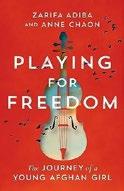
An Afghan violist and law student tells the story of how music helped liberate her from the constraints imposed on women by her traditional culture.
Music had
always been Adiba’s salvation. A love of singing cultivated in childhood developed into teenage fantasies of pop stardom that helped her escape a chaotic and oppressive family life. With help from her secretly rebellious mother and against the odds, she enrolled at the Afghanistan National Institute of Music after undergoing three months of intensive study of “music theory, rhythm and time, Chopin, Beethoven.” A member of the persecuted Hazara Shiite minority, Adiba thrived in the uniquely egalitarian and coeducational atmosphere and soon made plans to learn viola and join Zohra, the school’s all-girls orchestra. Despite her successes—international music tours, study trips to Turkey and the U.S.—family and social dysfunction upended her victories. Although music went against the teachings of conservative Islam, Adiba’s mother supported her daughter’s activities by lying to male
family members; however, she also used the daughter she loved—who helped support the family with a school stipend—as a “punching bag,” criticizing her for not being more respectful of traditions (like forced early marriage) that had kept her out of school and at the mercy of Islamic fundamentalism. Feeling pressured by her third husband’s family, Adiba’s mother demanded that she leave home on more than one occasion; yet each time—and determined to find her own path— the author held fast to her dreams of an education and a space to express her creativity. As she follows her struggles in search of freedom, the author reveals the deep and tragic cultural losses that accrue when patriarchy oppresses women. Adiba is now the co-conductor of Zohra. An often wrenching but ultimately hopeful and inspiring memoir of determination.
Skies of Thunder: The Deadly World War II Mission Over the Roof of the World
Alexander, Caroline | Viking (496 pp.) $32.00 | May 14, 2024 | 9781984879233
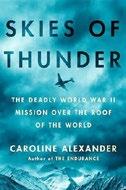
The deadly skies over the Himalayas form the backdrop of this account of the Allied forces’ Burma campaign in World War II. When Japanese troops overran the British colony of Burma in 1942, they cut off the land route between Allied bases in India and the troops of Chiang Kai-shek in China, seen as the West’s bulwark against Japanese aggression and insurgent Communist forces. Rearing between them were the Himalayas and their “towering weather systems” characterized by “violent, roiling, sheering masses of air” and “unbroken levels of ice” extending upward for thousands of feet. Nevertheless, supplying the
KIRKUS REVIEWS 48 MARCH 1, 2024 NONFICTION
Deeply insightful advice for the coming decades.
Chinese Nationalist troops was seen as such a priority that U.S. pilots ferried fuel, matériel, and troops back and forth over “the Hump” from 1942 through the end of the war. The route was so dangerous that it became known as “the aluminum trail” for the wreckage that accumulated along it and tempted pilots to fly over known Japanese-held territory in order to skirt it. Alexander, author of The Endurance and The Bounty, packs the text with gripping anecdotes of nail-biting flights that often end with crashes into the Burmese jungle (another object of terror for the airmen). They make for thrilling reading, but they pile on top of one another such that the narrative begins to feel baggy, as if Alexander couldn’t decide which would best serve her narrative so simply included them all. In addition to the air-transport efforts, she covers the ground war but not the air-combat campaign. Choosing to use colonial nomenclature to align with the period, largely relying on Western accounts for narrative and background, she too often presents the cultures of Burma and China through the exoticizing lenses. Her frequent, gratuitous use of the slur coolie is a further blemish. Compelling tales of aerial derring-do lift this uneven but entertaining account.

For more on Taiwan, visit Kirkus online.
Kirkus Star
World on the Brink: How America Can Beat China in the Race for the Twenty-First Century
Alperovitch, Dmitri with Garrett M. Graff PublicAffairs (400 pp.) | $32.50
April 30, 2024 | 9781541704091
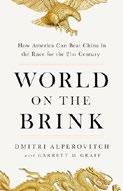
A thorough investigation of “America’s top foreign policy challenge.”
One of the most significant geopolitical trends is the explosive growth of China. With assistance from Graff, Alperovitch, entrepreneur, cybersecurity expert, and founding member of the U.S. government’s Cyber Safety Review Board, warns that America is now engaged in “Cold War II” with a nation far more populous and efficient than the former Soviet Union—and just as skilled at bending the rules. The author begins with a fictional scenario describing China’s conquest of Taiwan in 2028. Most readers know that this is a long-standing Chinese obsession, but Alperovitch emphasizes that it would be a massive geopolitical triumph, assuring domination of the South China Sea and access to one of the world’s most valuable resources: computer chips. “Taiwan alone is responsible for nearly 40 percent of new computing power manufactured every year worldwide,” writes the author, adding that the Chinese are as productive, hardworking, and imaginative as Americans—and there are four times as many of them.
Beijing’s goal of becoming the world’s top superpower seems inevitable unless U.S. officials act decisively. “To succeed over the next half century,” writes Alperovitch, the U.S. “needs to prioritize two broad enablers of innovation—semiconductor chips and immigration.” Regarding the latter, the author echoes other observers in his demonstration of how the U.S. discourages even skilled legal immigrants, a significant problem. Giving computer chips so much emphasis seems a stretch, but the author makes a convincing case that they are today’s primary engines of progress. Eschewing the usual homilies about freedom, the author urges America to pay more attention to traditional allies as well as China’s neighbors. “Other countries do not need to love us…and most of them…never will,” he writes. “But as long as they hate China more, they may prefer to partner with us.”
Deeply insightful advice for the coming decades.
Loose of Earth: A Memoir
Blackburn, Kathleen Dorothy
Univ. of Texas (216 pp.) | $26.95
April 16, 2024 | 9781477329627
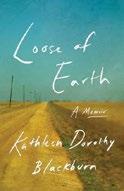
Environmental advocacy meets family history and devout Christianity in this memoir from the little-chronicled Llano Estacado.
In this gimlet-eyed debut, Blackburn, a creative writing teacher at the University of Chicago, surveys an oft-overlooked region of America: West Texas. A prevailing thread throughout the narrative is the wasting illness of her father, an Air Force and aviation industry veteran whom we meet with his five children arrayed before him: “Eyes fill with watery hope, as though the very thought of fatherless children harkens God’s intervention.” Marked by home schooling, tent revivals, and a mother who, though trained as a doctor, harbored a fundamentalist
MARCH 1, 2024 49 KIRKUS REVIEWS NONFICTION
ON THE BRINK
WORLD
mistrust of science, Blackburn had to become her own best counsel. She is an apt observer of small but telling details, writing of her hard-put-upon mother, “Each gesture is a countdown to the finish line of her patience.” Mother tried, and so did her father. Chronicling one climacteric moment, the author writes, “I credit him for being able to elevate his personal code over dogma.” One difficult concept to comprehend is the thought that throughout their lives, over generations, the people of the backwater High Plains, especially near military outposts, have been subjected to the wantonly incautious disposal of hazardous waste, including compounds in firefighting foams that have leached into the water supply. Evangelists barked demands that Satan let go of her father, a victim of such poisoning, even as Blackburn becomes ever more committed to an “intensified search to understand the causes of my father’s cancer.” The author’s exploration of toxic chemicals sometimes takes textbook-ish turns that don’t mesh well with her account of the personal world surrounding her family, but the book contains plenty of memorable, poignant scenes, including a moment when a dying grandmother sees “the Air Force insignia spread like wings above her.”
A thoughtful coming-of-age memoir from an American hinterland.
Beautiful People: My Thirteen Truths About Disability
Blake, Melissa | Hachette Go (272 pp.)
$29.00 | March 5, 2024 | 9780306830426
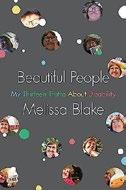
A frank and funny introduction to disability justice.
BEAUTIFUL PEOPLE
telling photo in one of a series of medical books she was combing for answers about her newborn child. Partly as a result of her experiences related to this condition, the author proudly identifies as both disabled and politically aligned with the Disability Justice Movement. She begins by contrasting the medical and social models of disability, clarifying that the medical model treats disabled people as humans who need to be “fixed,” whereas the social model insists that we, as a society, ought to become less ableist and more open to “addressing deeper…systemic problems.” “In a nutshell,” Blake writes, “the social model argues that disabled people are more disabled by the society in which they live than by their bodies or their diagnoses.”
On the Couch: Writers Analyze Sigmund Freud
Blauner, Andrew—Ed.
Princeton Univ. | (352 pp.) | $29.95 May 14, 2024 | 9780691242439
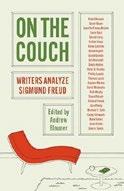
New essays on Freud’s continuing relevance.
A disabled writer’s primer on the Disability Justice Movement.
When Blake was a baby, she was diagnosed with Freeman-Sheldon syndrome, a condition so rare that her doctors only identified it after her mother found a
Drawing from personal experience, the author describes the freedom she feels in her wheelchair (a freedom that no amount of physical therapy will ever grant her), the thrill of modeling “adaptive clothing at New York Fashion Week,” and how a series of selfies helped her resist white supremacist beauty standards and those who perpetuate them. In the final chapters, Blake connects ableism to the grief she experienced after her father’s untimely death. Throughout the book, the author is ebullient, humorous, and compassionate, balancing exuberant optimism and joie de vivre with crystal-clear convictions and a deeply critical eye. While most of the topics Blake covers will be familiar to those who have an interest in disability studies, her voice makes the text enjoyable and instructive. She ends with an epilogue entitled “Letters to My Seventeen-Year-Old Self.”
A frank and funny introduction to disability justice.
In his latest anthology, after Now Comes Good Sailing , In Their Lives , Central Park , and others, Blauner and his contributors dig into the fraught territory of Freud. Readers will learn that Freud put birthday hats on his chow chows; that he forbade his wife from lighting Sabbath candles (and that she started lighting them again on the first Friday after he died); that Jennifer Finney Boylan once had a psychotherapist who “set [her] back years and years” when she was trying to understand her trans identity; that psychoanalytic sensibility (“spontaneous talk,” attentive listening, personal connection) may be the best antidote we have to an overly curated, stultifying digital culture that threatens to “hollow us out”; that the idea in Beyond the Pleasure Principle of a death instinct that holds on to trauma in order not to move forward can help us reassess our modern “embrace of the traumatic”; that, contrary to popular belief, modern neuroscience does not dismiss Freud’s models of the psyche out of hand; and that celebrated biographer David Michaelis once had a crush on his mother. The 25 writers gathered here never appear to be responding to the same prompt, and their variety of approaches—to Freudian concepts,
KIRKUS REVIEWS 50 MARCH 1, 2024 NONFICTION
to psychoanalysis, to Freud the man—is wide-ranging. At a time when Freud is so easily written off as “an anachronism or a punch line,” when “his story is one that many people think they know,” the variety pushes against the myth of that single, already-familiar story by offering unique lines of reasoning and association about a vast array of issues related to him. Other notable contributors include Siri Hustvedt, Colm Tóibín, Sherry Turkle, Rivka Galchen, Adam Gopnik, Rick Moody, and Freud’s great-granddaughter Susie Boyt.
A solid collage of voices to complicate our picture of psychoanalysis.
Spirit of the Century: Our Own Story
Blind Boys of Alabama with Preston Lauterbach | Hachette (320 pp.) | $30.00 March 19, 2024 | 9780306828218
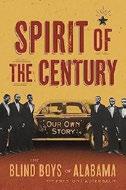
A history of a group of visually impaired Black gospel musicians who achieved unprecedented fame.
In the 1930s, the Alabama School for the Negro Deaf and Blind took in visually impaired boys from all over the state of Alabama and taught them “commercial broom and mop manufacturing and music.” The school’s conditions were abysmal: Students routinely went hungry, and the abusive staff and “blood feud” between blind and deaf pupils often exposed attendees to violence. The one bright spot in the school was the music—in particular, one group that students formed themselves. In the 1940s, a partially sighted student named Velma Traylor got his friends J.T. Hutton, Olice Thomas, George Scott, Clarence Fountain, and Johnny Fields to form a group that sang four-part quartet harmonies that they arranged themselves. Originally called the
Happy Land Jubilee Singers, these boys would soon become the famous gospel quartet group known as the Blind Boys of Alabama. Although Traylor was shot and killed tragically—and mysteriously—at the age of 23, the Blind Boys continued performing for decades, winning multiple Grammy Awards, recording the theme song for The Wire , performing on David Letterman, sharing the stage with Prince, and singing for President Barack Obama. At its best, this book, co-written by music journalist Lauterbach, author of Beale Street Dynasty and The Chitlin’ Circuit , provides an intimate look at the creative, personal, and professional lives of visually impaired Black musicians over a decades-long career. However, the narrative’s lightning-fast pace makes it difficult to keep track of the huge variety of characters in the Blind Boys’ orbit, and the incredibly detailed timeline is difficult to follow. Consequently, the book feels more like a list of people and events than a story. A thorough but frantically paced history of the Blind Boys of Alabama.
I Cannot Control Everything Forever: A Memoir of Motherhood, Science, and Art
Bloom, Emily C. | St. Martin’s (352 pp.) $28.00 | April 16, 2024 | 9781250285683

An educator and author chronicles “several pregnancies and my daughter’s first four years.”
In her late 30s, Bloom gave birth to a daughter who was congenitally deaf and, at 13 months, diagnosed with Type 1 diabetes. The much longed-for child was the result of the author’s fourth pregnancy. The first had ended in an early miscarriage; the second, a miscarriage at 13 weeks. Bloom
terminated the third after prenatal testing determined that the fetus carried the gene for a devastating degenerative condition. In her affecting debut memoir, Bloom chronicles her experiences of pregnancy, childbirth, and child care, focusing on the technological interventions and assessments that provide information, present hard choices, and offer the illusion of control. She also explores the history of pregnancy tests, ultrasound technology, gene editing, in vitro fertilization, and diabetes diagnosis and treatment, including the glucose monitor and insulin pump that her daughter continuously wears. Technical advances are both astonishing and, ultimately, limited. “Pregnancy tests and ultrasounds,” she writes, “are not entirely dissimilar to works of art, in that all are crafted by people to reveal something about reality.” Overwhelmed by the “cascade of devices that save me and bury me,” Bloom has sought enlightenment through art of all mediums, fr om literature to painting. She was particularly struck by Louise Bourgeois’ painting I Go to Pieces: My Inner Life , on which Bourgeois embroidered the sentence, “I cannot control everything forever.” Genetic testing had confirmed that her daughter did not carry the feared degenerative disease. As for diabetes, medicine could not explain why it appeared in so young a child. Bloom is candid about the stress of caring for a child with special needs: With her husband working toward tenure, she gave up her job, devoting herself to her daughter’s constant care.
Thoughtful reflections on technology and humanity amid difficult parenting experiences.

To
Dynasty, visit Kirkus online. MARCH 1, 2024 51 KIRKUS REVIEWS NONFICTION
read our review of Beale Street
THE KIRKUS Q&A: STEVE COLL
The award-winning journalist takes readers behind the scenes of Saddam Hussein’s regime.
BY MARY ANN GWINN

MOST AMERICANS REMEMBER Iraqi dictator Saddam Hussein as a ruthless narcissist who waged war against his many enemies and killed his fellow countrymen by the thousands. More than that, he represented one of America’s biggest strategic failures— the U.S. government’s erroneous conclusion, after 9/11, that Saddam held weapons of mass destruction and was ready to use them on the United States and its allies. There were no such weapons, but that faulty premise sparked the 2003 invasion of Iraq that led to the deaths of thousands of American soldiers and hundreds of thousands of Iraqis.
Acclaimed author Steve Coll, a two-time Pulitzer Prize winner, wanted to get beyond the image of Saddam Hussein as a cartoon monster to the real man within. He found a door into the story when he learned of a trove of materials seized by American officials after the invasion, including transcripts of tape-recorded meetings within Saddam’s inner circle. After five years of research, interviews, and a FOIA lawsuit against the Pentagon, Coll distilled his conclusions in his superb new book, The Achilles Trap: Saddam Hussein, the C.I.A., and the Origins of America’s Invasion of Iraq (Penguin Press, Feb. 27). In a starred review, Kirkus calls it “required reading for all conscientious citizens.” Coll, currently living in London, answered questions about the book over the phone; our conversation has been edited for length and clarity.
You describe The Achilles Trap as a character-driven investigation, and you certainly portray Iraqi dictator Saddam Hussein as a multifaceted character. What motivated him as a ruler?
I thought that I should humanize him without sanitizing him, to understand his motivations and his decision-making, as well as render him for history and rescue him from the flat
cartoon image that I had of him. I found him to be so full of paradox.
Somebody once told me that you shouldn’t write a biography of someone that you don’t like, because you have to spend so much time with them. I’ve never tried to follow that rule, but I did experience a lot of time trying to understand Osama bin Laden [for the 2008 book The Bin Ladens]. I found Bin Laden painfully difficult to

enjoy as a subject, because he was so puritanical and one-dimensional in his thinking and lifestyle. Saddam stood very much in contrast to that, because he was sort of a man in full.
What did you learn from the tapes of meetings in Saddam’s inner chamber?
The tapes are often just monologues—nobody wants to interrupt him, because they’re afraid. He can be light on his feet in one moment, full of jokes and good humor, and then turgid for the next 10 minutes. [In print] he can be startlingly shrewd and foresightful about geopolitics and power, then deeply confused about how the world works. You could understand how for some people—[beyond the] intimidation, terror, and patronage—he had a certain charisma.
And he wrote several novels! His poor copyeditors were stuck at their desks as the American invasion rolled over the border and towards Baghdad. He kept saying, “We still have time,” and sending them pages. It was as if the novel and the fall of his regime were on competing deadlines.
I had never read about Saddam’s murder by gassing of thousands of Kurdish men, women, and children in the 1980s in such excruciating detail. What might have been different had the U.S. broken with him at that point?
Saddam Hussein, for all of his bluster and recklessness, could be deterred by American power if he thought that it genuinely threatened him. He was prepared to defy the United States, but he also didn’t
NONFICTION // Q&A
Coll KIRKUS REVIEWS 52 MARCH 1, 2024
Steve
want to get into gratuitous trouble with the United States unless it was something really important. I think he regarded the insurgency in Kurdistan as an existential threat to Iraq’s integrity and to his power. He might have gone ahead and gassed the Kurds anyway if the United States had raised the price, but that was never tested, because the United States got trapped in its own assumption that he was a necessary check on Iran—the lesser of two evils. The United States, as we’ve seen so many times in our history, just couldn’t break out of a policy that had gone off the rails.
I was reading an oral history about the gassing of the Kurds, and the U.S.’s weak response to it. The subject was a longtime ambassador in the Arab
world, and he said the hardest thing for the American government to do is to change a failed policy. That was why the United States continued to tolerate Saddam’s gassing of his own people, even as the evidence became truly horrifying.
When I read your books, I sometimes wonder: Why do people disclose themselves to you in such detail? I’m thinking of Jafar Dhia Jafar, head of Iraq’s nuclear program, who dealt with the many United Nations inspectors who looked for—and didn’t find—weapons of mass destruction. Why did he talk so candidly? He’s a sophisticated man who’s proud of his achievements. I think he feels that he was the peer of many of the nuclear inspectors who never
believed him, who should have believed him, and who should have treated him more respectfully. Since he ended up on the right side of this particular strand of history, he was willing to clarify exactly how it happened.
I was deeply intrigued by his role in the story, because he was an unexpected character in Saddam Hussein’s world: a world-class physicist who was independent of the regime in some respects, kind of an Oppenheimer figure. The most powerful rhetoric that the Bush administration used to sell the war was “We don’t want the smoking gun to be a mushroom cloud.” After the truth was revealed, everybody had to admit that Jafar had been straightforward with them.
I thought that I should humanize [Saddam] without sanitizing him.
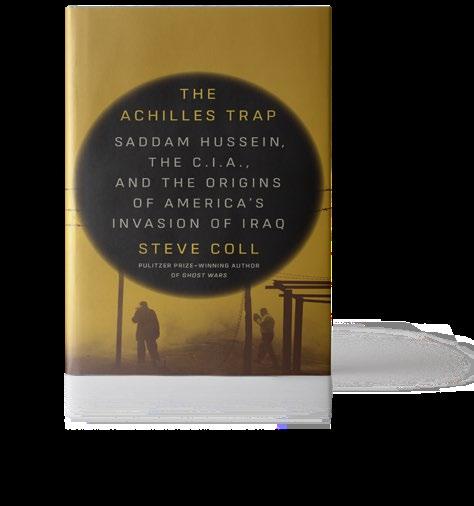
The Achilles Trap: Saddam Hussein, the C.I.A., and the Origins of America’s Invasion of Iraq
Coll, Steve Penguin Press | 576 pp.
What lessons has the U.S. learned from this chapter in our history? Are we doing any better today? One area for reflection is what this extremely well-documented case study tells us about dealing with dictators in a world that seems, unfortunately, to have more and more of them. We can learn from our failures to think about Saddam as something other than a cartoon figure, and we can learn from the record of his decision- making how a leader in a very closed society whose power is almost absolute makes decisions when they interact with a big country like the United States. Why are we unable to turn around and see the world, in at least some dimension, from the point of view of a figure like Saddam? Is it because our domestic politics require us to simplify and demonize an adversary? Granted, Kim Jong Un and Vladimir Putin have terrible records. Nobody wants to celebrate them or be soft on them. But if you’re trying to protect the people of the United States by correctly understanding and influencing characters like that, you’re only going to be effective if you can get inside their heads. How do we have a conversation that does not sanitize these figures but really does attempt to understand them as human beings? Because ultimately they’re going to make decisions that affect us.
Mary Ann Gwinn is a Pulitzer Prize–winning journalist in Seattle.
Q&A // NONFICTION
|
Feb. 27, 2024 | 978052556226 MARCH 1, 2024 53 KIRKUS REVIEWS
$35.00
Kirkus Star
Cactus Country: A Boyhood Memoir
Bossiere, Zoë | Abrams (272 pp.) | $27.00 May 21, 2024 | 9781419773181
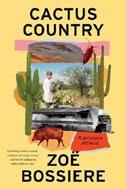
A memoir about gender, the Sonoran Desert, and how stories can save.
When Bossiere’s family packed themselves into an Airstream and moved to Cactus Country, an RV park situated in the desolate landscape outside of Tucson, the author was an 11-year-old boy. Bossiere was assigned female at birth, but with a cropped haircut, an affinity for dirt, and the “hard masculinity, stoicism, and camaraderie of the boys and men I knew in those years,” the author found friendship within Cactus Country’s pack of boys, as wild as the park’s roving herds of javelina. The boys chased trains, tarantulas, and troubled neighbors, honing their masculinity among the creosote bushes and prickly pears. As puberty began—and with it, romantic confusions, experiences of body issues, and probing questions from peers—Bossiere found themself in a “mixed-up, turned-around, in-between gender story.” They turned to online queer communities for answers about their gender. “I wanted to read a story like mine,” Bossiere writes of their young, searching self, “because I wanted to know how that story would end.” In these tightly connected essays, the author creates such a story, asserting that within the letters LGBTQ+, there are “so many ways a person could find themself in that ever-expanding acronym, its ‘+’ containing multitudes.” Bossiere returns to images and ideas from their childhood and adolescence in new landscapes and identities, haunting the memoir to prove that, “[i]n the end, we’re left with what the body
knows. Its memory runs deep, rooting us to our past no matter how far away or long ago.” In that way, though Bossiere’s life has taken them far from Cactus Country, “the ghost of the boy I was is still running somewhere out in the desert.” Bossiere’s hopeful, powerful life story also serves as a memorable study of gender and home.
Reading the Constitution: Why I Chose Pragmatism, Not Textualism
Breyer, Stephen | Simon & Schuster (368 pp.) | $30.00 | March 26, 2024
9781668021538
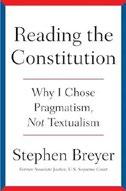
An esteemed jurist assesses the limitations of textualism.
Breyer, who retired in 2022 after 28 years on the U.S. Supreme Court, offers a cogent explanation of judicial reasoning, focusing particularly on the difference between textualism—now dominating the current Court—and pragmatism, which is his guiding principle. In making decisions, all judges consider “text, history, precedent, tradition, purposes, values, and consequences.” Textualists, though, “ask the judge to look, almost exclusively, to language. And their main point is that statutory (or constitutional) words mean what a reasonable person would have taken them to mean at the time they were written.” Breyer, however, sees this perspective as myopic. “Without ignoring the text,” he explains, “I normally put more weight on the statute’s purposes and the consequences to which a particular interpretation will likely lead. I will sometimes ask how a (hypothetical) ‘reasonable legislator’ would have interpreted the statute in light of its purposes.” He also considers “how those affected by the decision will react.” The author carefully examines many cases throughout the Court’s history, including Dobbs, which overturned Roe
v. Wade, and cases for which he wrote the dissenting view. He argues persuasively that overruling earlier precedent can lead to chaos, because in departing from settled law, “the court could look at all previous decisions.” Breyer’s patient explanation of cases reveals the intricacies of judicial decision-making, even for textualists, who focus on the “highly complex” wording of the Constitution. Although he argues persuasively against textualism, he is reluctant to foresee a paradigm shift toward textualism incited by the present Court. Cautiously optimistic, he predicts that with time and experience, the new Court judges will realize the limitations of this approach and understand that “the ultimate object of law is to allow human beings to live peacefully and prosperously together in communities.” A deeply informed analysis of judicial history.
Another Sojourner Looking for Truth: My Journey From Civil Rights to Black Power and Beyond
Brown, Millicent E. | Univ. of South Carolina (208 pp.) | $26.99 | April 23, 2024 9781643364919
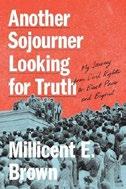
A firsthand account of the struggle for social justice.
Historian Brown (b. 1948) makes her book debut with a candid memoir of a lifetime involved in civil rights activism. The author grew up in a Black, middle-class, politically engaged family in Charleston, South Carolina, where her father was a prominent member of the local branch of the NAACP. Brown rode at the back of buses, tried on shoes apart from white customers, and sat in a different waiting room in doctors’ offices. Twice when she was a child, the safety of her home was shaken when “Klan-type antagonists threw flaming crosses onto our front steps.”
KIRKUS REVIEWS 54 MARCH 1, 2024 NONFICTION
Though this is a memoir, Brownrigg executes an impressive reconstruction of history.
THE WHOLE STAGGERING MYSTERY
Not surprisingly, the state balked at desegregating public schools, which came to affect Brown directly when she became the first student to integrate her high school. There were bomb threats during her first days, and students refused to walk near her in the halls. Although some of the Jewish students were welcoming, most classmates—and some teachers—ignored or insulted her. “The responsibility of ‘representing the race’ was the most important that I had ever taken on,” she writes. But the psychological pressure was debilitating. Brown’s journey to find her identity outside of a familiar setting took her to Emerson College, where she discovered that racism transcended geography. She returned south to attend Spelman College, always seeking opportunities for direct action. After earning a doctorate in history, she embarked on a long teaching career. After leaving the confines of academia, she worked for the Avery Research Center for African American History and Culture, and she continues to support systemic change for marginalized people. “I have lost faith in appealing to conscience and morality as the galvanizing forces for overcoming bigotry,” Brown writes, “although I retain a fervid moral code by which I live.”
Vivid testimony from an energetic activist.

Kirkus Star
The Whole Staggering Mystery: A Story of Fathers Lost and Found
Brownrigg, Sylvia | Counterpoint (336 pp.) $27.00 | April 23, 2024 | 9781640096561
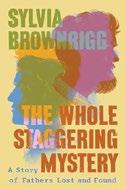
A lyrical memoir/ reimagining of a family scattered among colonial Kenya, wartime England, and the California redwoods over the past century. One day in 2012, novelist Brownrigg received a box in the mail containing letters, sepia portraits, information about the birth of her father, Nick, and a typed account about the short life of her English grandfather, Gawen, who was also a novelist. This treasure trove helped Brownrigg to not only uncover the mystery of these two men—Gawen died in his late 20s, and Nick left the family when Brownrigg was a baby (“his early absence left a constant hollowness in me”)—but also learn her family history and her place in it. Told in four parts, the engrossing text moves back and forth in time, from the English countryside in the early 1930s to the redwoods of Northern California in the 1970s, back to Kenya in the fading days of the British Empire, forward to London during World War II, and finally to the present in California. Though this is a memoir, Brownrigg executes an impressive reconstruction of history. In one chapter, we experience the viewpoint of Gawen’s supervisor in Kenya; in another, we follow Nick’s
dead brother; yet another imagines the life of Beatrice, Brownrigg’s great-grandmother, living alone in London during wartime, after the deaths of her son, Gawen, and her husband. Boldly, the author also writes about herself and her family as if they were characters in a novel.
“Getting at Nick…required me to blur him into Frank, and myself to Sophie….The move simultaneously provided distance and proximity: I could see my child self at arm’s length but the parent from closer to, like a perspective-altering telescope.”
Brownrigg’s skillful interweaving of slippery narrative threads adds up to an immersive reading experience.
The Right Kind of White: A Memoir
Bucks, Garrett | Simon & Schuster (240 pp.)
$27.99 | March 19, 2024 | 9781982197209

An activist unpacks “good” whiteness.
Bucks is the founder of the Barnraisers Project, which equips “White organizers from across the country to mobilize their own communities for racial justice.” As he explains in the introduction, his debut book is his attempt to tell “the story of White people’s obsession not just with who we are in relation to Black and Brown people, but who we are in relation to each other.” (Bucks capitalizes White because to not do so when capitalizing Black and Brown makes whiteness seem like the default category.) While the author set out to write a “sociohistorical analysis,” he decided that he couldn’t execute that project properly without first interrogating the ways in which he has tried to differentiate himself from other white people throughout his life. Consequently, he chose to write a memoir. Bucks has set himself an extremely difficult task: making himself the central figure in a
MARCH 1, 2024 55 KIRKUS REVIEWS NONFICTION
For more from Sylvia Brownrigg, visit Kirkus online.
narrative that is, essentially, the story of a white person learning to decenter himself in the cause of justice. The author is nothing if not self-effacing. He gently pokes fun at the painful sincerity of his younger self, a peace and global studies major at Earlham College, “a Quaker school…that primarily attracted self-consciously earnest do-gooders,” and he recounts his nervousness at being perceived as a white savior while working on a Navajo reservation. However, the anecdotes about the ways in which he identifies, rejects, and uses various kinds of whiteness aren’t terribly revelatory. What we learn, ultimately, is what we knew at the beginning: Bucks is a sincere guy doing his best to do good. “It’s a gift,” he writes, “to share my story of ‘the right kind of being White.’ It will be an even more profound gift if my doing so encourages others to share theirs as well.” An earnest but mostly unenlightening work.
Kirkus Star
Throne of Grace: A Mountain Man, an Epic Adventure, and the Bloody Conquest of the American West
Clavin, Tom & Bob Drury | St. Martin’s (368 pp.) $30.00 | May 7, 2024 | 9781250285836
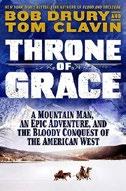
The story of the adventurer who opened trails into the Rockies and beyond in the 1820s.
Growing up in New York, Pennsylvania, and Ohio, Jedediah Smith (1799-1831) learned to hunt and handle boats at an early age, and he was deeply fascinated by Native American lore and the travels of Lewis and Clark. When he arrived in St. Louis in 1822, Smith was prepared to join a beaver-trapping expedition up the Missouri River. That set him on the road to a remarkable series of
An esteemed academic presents a timely, wide-ranging examination of the Muslim world.
A HISTORY OF THE MUSLIM WORLD
adventures as he worked his way into territory previously unseen by any white man: hunting and trapping, wintering in rough camps far from any settlement, getting to know, and often fighting, the many Indigenous peoples who lived in the West. Smith’s skills and character— unlike other mountain men, he was pious and sober in his lifestyle— made him a natural choice for leading trapping companies. He and other American explorers faced opposition from the Mexican government in California and from the Hudson’s Bay Company in Canada, both of which had a strong prior claim on territory that eventually became U.S. states on the West Coast. Clavin and Drury, co-authors of Blood and Treasure , embellish Smith’s story, largely based on his own journals, with a wealth of material covering all aspects of the history, geography, and the many colorful characters who led the way into the wilderness. Smith died leading one final expedition, but not before he had left a significant mark on American history. “When Smith took his first, tentative steps into the unknown,” write the authors, “the interior of the North American continent was a blank slate for most if not all of his countrymen.”
A lively account of the remarkable life of one of the men who led the U.S. into the vast West.

A History of the Muslim World: From Its Origins to the Dawn of Modernity
Cook, Michael | Princeton Univ. (960 pp.)
$39.95 | May 7, 2024 | 9780691236575

An esteemed academic presents a timely, wide-ranging examination of the Muslim world.
Weighing in at nearly 1,000 pages, this book is a daunting undertaking. Cook, a Princeton professor of Near Eastern studies who has penned several well-regarded works, aims to explore what he calls “one of the great Black Swan Events of history.” The author explores the life of Muhammad and the schisms and conflicts of Islam’s early period, but he is particularly interested in how Islam interacted with nascent concepts of the state and how the spread of the faith transmitted important political ideas. Cook makes use of a good deal of primary source material, underlining how Islam has never been a monolith but more of a set of competing ideas about how to translate Koranic doctrine into practice. In the second section, the author follows the global spread of Islam up to around 1800. This expansion moved the intellectual weight of Islam away from the Arab countries and toward the Turkic, Persian, and Egyptian cultures. The Arab countries, as keepers of the holy places, maintained a crucial influence, but numerous tensions remain. A lengthy epilogue summarizes the progress of Islam from the beginning of the 19th century to the present, as
KIRKUS REVIEWS 56 MARCH 1, 2024 NONFICTION
read our review of Blood and Treasure, visit Kirkus online.
To
Cook analyzes the friction between the fundamental conservatism of Islam and the desire for “modernity” and economic development. The author is well aware that not everyone will want to tackle such a large, dense book, so he provides an introductory summary of each chapter, helping readers to choose those areas of most interest to them. “Broadly speaking,” he writes, “I give systematic attention to two things: the making and unmaking of states, and really major cultural shifts that affect large populations.” However approached, this is an interesting text. Cook’s study sheds crucial light on Islamic development and influence across borders and centuries.
First Love:
Essays on Friendship
Dancyger, Lilly | Dial Press (224 pp.)
$28.00 | May 7, 2024 | 9780593447574
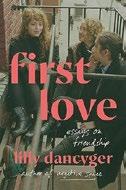
A New York–based essayist and memoirist reflects on the female friendships that have shaped her life. When Dancyger, the author of Negative Space, was 22, her cousin, Sabina, was murdered. The crime shattered the author, partly because she considered her friendship with Sabina her first experience of love. Although culturally, we often associate first loves with romance, Dancyger’s memories of Sabina piqued her interest in a different kind of love: “What about the first childhood experience of love, the first person you truly love other than your parents? Does a first sisterly love set the bar for a lifetime of friendships?” The author reflects on a lifetime of female friendships, including the one with her high school best friend, Haley, whom she felt compelled to protect; her adult friendship with a woman named Liz that survived their rambunctious early 20s; her close relationship with a former roommate named Leah, who helped
Dancyger through a terrible bout of grief; and her intensely loving relationship with Sabina, which flows so deeply that the author found herself unable to write a book about the girl’s untimely death. At the end of this book, the author writes, “When I finally sat down to write about Sabina, the story that came out was not about murder at all. It was a love story.” Dancyger’s ode to female friendship is affectionate, frank, circumspective, and passionate. Despite the traumatic nature of many of the memories she recalls, the author manages to infuse each page with an undercurrent of quiet, grateful joy. While the collection sometimes lacks cohesion—most notably in a chapter that focuses on a collaborative photography project that feels disconnected from the rest of the narrative—overall, this is a well-written and -paced read. A tenderly insightful essay collection celebrating female platonic love.
The Well-Connected Animal: Social Networks and the Wondrous Complexity of Animal Societies
Dugatkin, Lee Alan
Univ. of Chicago (264 pp.) | $29.00 May 16, 2024 | 9780226818788

An engaging exploration of the interconnectedness of the animal world. Our belief in human exceptionalism has long included the dogma that we are the only animals that create complex social networks—but we are wrong. In this compelling book, evolutionary biologist Dugatkin, author of The Imitation Factor and Principles of Animal Behavior, notes that while the study of complex non-human social networks is a fairly young discipline, new research is occurring at a rapid pace. As one example, we now know reciprocal altruism drives vampire bats, who are most likely to share
cocktails of their own blood with drinking buddies—bat friends who have done the same in the past. Another example: Dolphins help the Laguna people in Brazil by using their sonar to locate mullet; then they alert each other and nearby fishermen to the fish by slapping the water en masse, sending them into nets (and smiling dolphin mouths). Barbary macaques are prosocial animals, warning friends—but not acquaintances—of bad weather. Also prosocial are goats, who, like human teenagers, have friends, enemies, and frenemies. The author also looks at Sonso chimpanzees, who speak a rich language of more than 120 common gestures; honeybees, whose “dances” direct hives to food; the “giant dolphin mugshot book” compiled by researchers showing that dolphins teach each other to use sponge tools; and silvereye birds, who produce more than 60 syllables in a vernacular so expressive that neurologists study it to better comprehend the origins of the human spoken word. “It’s time to scratch off another item from the ‘what makes humans unique’ list,” writes Dugatkin, adding, “Everywhere, and in every context, animals are embedded in networks.” This book makes a fitting companion to Ed Yong’s An Immense World .
An entertaining tour of what we learn as we eavesdrop on the non-human conversations all around us.
Kirkus Star
Prairie, Dresses, Art, Other
Dutton, Danielle | Coffee House (176 pp.)
$17.95 paper | April 23, 2024 | 9781566897037
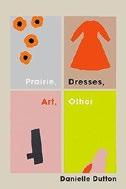
A shimmering and perplexing work that challenges the constraints of traditional prose. In her finely tempered collection of essays and experimental writing, Dutton,
>>>
MARCH 1, 2024 57 KIRKUS REVIEWS NONFICTION
SEEN AND HEARD

New Book by
Yuval Noah
Harari Coming This Summer
A “major new work” from author Yuval Noah Harari is coming later this year, according to his publisher.
This summer, Random House will publish Harari’s Nexus: A Brief History of Information Networks From the Stone Age to AI, the press announced in a news release. It describes the book as a “ground-breaking work of nonfiction by one of our most innovative, engaging, and prescient thinkers.”
Harari, an Israeli historian, scored a massive bestseller in 2015 with the English-language version of Sapiens: A Brief History of Humankind ; the book was originally published in Hebrew four years prior. In a starred review, a critic for Kirkus wrote of the book, a history of humankind, “The great debates of history aired out with satisfying vigor.”
His other books include Homo Deus: A Brief History of Tomorrow and 21 Lessons for the 21st Century Harari’s most recent release is Unstoppable Us, Volume 1: How Humans Took Over the World, a children’s book illustrated by Ricard Zaplana Ruiz.
The new book, Random House says , “looks through the long lens of human history to consider how the flow of information has shaped us, and our world.…Yuval Noah Harari asks us to consider the complex relationship between information and truth, bureaucracy and mythology, wisdom and power.”
Nexus is slated for publication on Sept. —M.S.



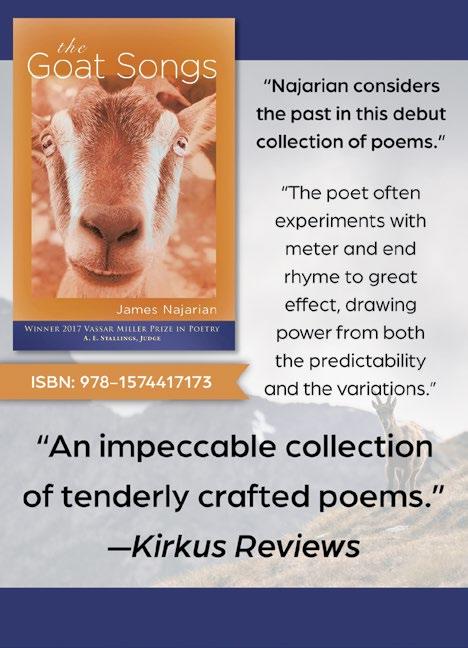
NONFICTION // SEEN AND HEARD
KIRKUS REVIEWS
Jonathan Nicholson/NurPhoto via Getty Images
For a review of Sapiens, visit Kirkus online.
Yuval Noah Harari


Anthony Hopkins Says He’s Writing a Memoir
The actor told People magazine that he has “quite a memory.”
Anthony Hopkins told People magazine that he is working on a memoir about his life and storied career.
“I’m writing a biography,” Hopkins said. “It’s a weird process.”
Hopkins, widely considered one of the best actors of his generation, was born and raised in Wales and educated at Royal Welsh College of Music & Drama. He made his acting debut in 1960 in the play Have a Cigarette and was later discovered by Laurence Olivier, who asked him to perform at the Royal National Theatre in London.
Hopkins made his feature film debut in 1968, playing King Richard I in The Lion in Winter, and went on to star in movies including The Elephant Man, 84 Charing Cross Road, Howards End, The Remains of the Day, and Amistad. He won two Academy Awards, for his

SEEN AND HEARD
performances in The Silence of the Lambs and The Father
“I realized how I’m blessed with one thing,” Hopkins told People. “Maybe it’s my actor’s brain. I do have quite a memory. I remember days of months in the years.”
He told the magazine that he’s grateful for his life, even the rough parts, including a struggle with alcoholism.
“I’m just fortunate,” he said. “I went through ups and downs and depressions and despair and anger and all that stuff, but gradually the last few years [I’ve been] thinking, Well, I’m still here.”—M.S.
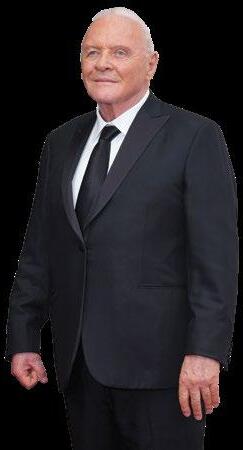
SEEN AND HEARD // NONFICTION
Mazur/WireImage MARCH 1, 2024 59 KIRKUS REVIEWS
Kevin
Anthony Hopkins
For more celebrity memoirs, visit Kirkus online.
author of Margaret the First , explores a conceptual take on storytelling involving the ineffable feeling of a text, beyond mere words. Her work is highbrow while remaining mischievously playful, reminiscent of the form-smashing thrills of writers like Lydia Davis and Anne Carson. The first section, “Prairie,” features five abstract stories that eschew plot in favor of hazy, memoir-like fragments. The poetic and peculiar “Dresses” is an artfully arranged list of excerpts from poems and novels that include mentions of a dress. Despite the content coming from outside sources, their collaged curation transforms the texts into something unsuspectingly resonant. The revelatory essay in “Art” helps unlock Dutton’s puzzles. Here, she discusses contemporary art and the practice of ekphrastic writing, a technique that not only describes visual art in words but also aims to render in language and tone how a work makes a person feel. The author explains her interest in writing a text that can expand beyond its edges and open “a space within which we attend to the world.” “How might a story embody a specific way of looking?” she asks. “Other” further develops these ideas. In the short narrative “Not Writing,” Dutton briefly discusses the minimalist paintings of Agnes Martin and how scholar Olivia Lai ng noted “they aren’t meant to be read, but are there to be responded to.” Dutton asks, “Is it wrong to want to write towards what isn’t intended to be read? What I want is a story that’s an object that can turn itself inside out.” The author not only introduces big ideas; she shows her readers how to grapple with her lofty questions.
An unassuming work of literary theory that will dazzle hungry scholars.

The Art of Diplomacy: How American Negotiators Reached Historic Agreements That Changed the World
Eizenstat,
Stuart E. Rowman & Littlefield (480 pp.) | $35.00 May 28, 2024 | 9781538167991
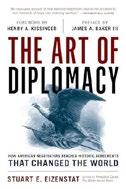
A former U.S. ambassador to the European Union lays out a useful roadmap to successful international negotiations. Negotiations are a crucial part of statecraft, writes Eizenstat, author of Imperfect Justice and The Future of the Jews. In his latest book, the author aims to distill key events in U.S. negotiations into lessons for the next generation of diplomats and students. In some of the cases, Eizenstat had direct involvement; regarding others, he studied the records closely and interviewed the participants. As any diplomat will tell you, an essential ingredient in a successful negotiation is preparation. You must understand what the other side wants and how far they will go to get it. In the case of American negotiators, they must be clear about their own objectives while also maintaining the support of the Oval Office. Both sides have to be willing to give something, but they must also be able to walk away with something they can claim as a victory, if only a partial one. The point is not defeating an opponent but finding a workable consensus. Eizenstat identifies a failure to follow through on agreements as a recurring weakness of U.S. diplomacy over the decades. Sometimes, the failure arises due to domestic political circumstances; sometimes, it involves the mistaken view that adding signatures to a piece of paper is an end in itself and will solve all problems. Eizenstat hopes that future negotiators will address these shortcomings. “Successful international negotiations require putting aside historic enmities, hatreds, and
prejudices, and reasoning together to reach durable, if painful, compromises,” he writes. The author does not always delve as deeply as some readers may wish, but he provides a valuable primer for those with an interest in this field. Eizenstat covers a lot of ground, writing with the authority and clarity of experience.
Water on Fire: A Memoir of War
El-Ariss, Tarek | Other Press (373 pp.) | $17.99 paper | April 23, 2024 | 9781635424461

A professor of Middle Eastern studies recounts his experiences during the Lebanese civil war of 1975-1990.
El-Ariss, author of Leaks, Hacks, and Scandals, was born two years before war erupted in Beirut in 1975, blowing apart his young world, which resumed afterward under horrific conditions. In this poignant, thought-provoking memoir, thematic chapters often resonate with the multiple meanings of Arabic words—e.g., “ khabissa (‘the jumbled one,’ a Jell-O-like dessert with walnuts and pomegranate) [or] mfattqa (‘the craved one’ or ‘the ripped one’—a sweet pudding made with turmeric and tahini).” The latter, he writes, perfectly “encapsulates the pain and wounds from the catastrophes of the past.” Beirut becomes the city “dedicated to the memory of Job,” encompassing his unholy suffering. The author vividly chronicles how the city was deeply divided as the bombs fell and people fled. His father, a prominent gynecologist, vowed to remain, despite the violence and disruptions at the author’s school. El-Ariss writes memorably about his suppression of fear, which caused psychological damage—though he did not realize the extent until years later, as a young man in New York City visiting a Freudian psychiatrist. Studying philosophy at the American
KIRKUS REVIEWS 60 MARCH 1, 2024 NONFICTION
For more from Stuart E. Eizenstat, visit Kirkus online.
University of Beirut when the war ceased in 1990, he finally found his “motley crew of questioning misfits and outrageous rebels.” The author’s prose is beautifully evocative and only occasionally overwrought: “The bullet of war lives in my head, inhabits my entrails.” El-Arris ends the narrative just after 9/11. “New York was my city, and those who attacked it were going to answer to me,” he writes. “Didn’t they realize what I had to endure to arrive here? Have they no idea what I experienced as I was escaping those skies that never stopped raining death and displacement?”
Abandonment and loss are at the heart of this deeply cerebral, literary memoir.
I’ll Just Be Five More Minutes: And Other Tales From My ADHD Brain
Farris, Emily | Hachette (304 pp.) | $18.99 paper | Feb. 6, 2024 | 9780306830310
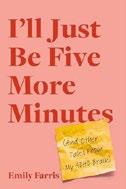
Humorous essays about a woman trying to reconcile herself with her own mind. As she recounts in her first essay collection, which toggles between humor and poignancy à la Samantha Irby, Farris was in her mid-30s when she was diagnosed with ADHD, which “makes so much sense. I was a kid with a quick temper and a serious lack of impulse control. I interrupted sentences (my own included) with new ideas (brilliant ones, of course!), and I’d often get late-night bursts of inspiration that kept me up doing crafty projects way past my bedtime.” As an adult, these issues persist. In between digging herself out from under mountains of dirty laundry and catching up on last year’s tax forms, Farris offers trenchant thoughts on what it means to be neurodivergent and how she came to see her condition as a strength. “On our first anniversary, after a few too many Old Fashioneds,” she writes, “I asked my
husband if he regretted marrying me. ‘I wouldn’t exactly call it regret,’ he said. He spent the next twenty minutes trying to explain his answer, but I didn’t hear any of it.” Farris describes a childhood among distracted adults, a hectic period as a young woman trying to finish college and earn a living in New York, awkward attempts to find love, and her current incarnation as a wife and mother. Decidedly nonlinear, the essays hop around both in time and subject matter. Though the author isn’t always quite as funny as she thinks she is—her humor strains at times—and all the hopping about inevitably results in occasional repetition, these are mild complaints for a book that is engaging and appealing even when it falls short of captivating. A smart and charming collection from an endearingly spiky new voice.
How to Baby: A No-AdviceGiven Guide to Motherhood, with Drawings
Finck, Liana | Dial Press (272 pp.) | $28.00 April 30, 2024 | 9780593595961
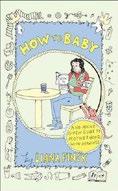
A New Yorker cartoonist offers an illustrated guide to what it means to have a baby. Most women may not be “averse” to the idea of having a child, but first-time mother Finck, author of Passing for Human and Let There Be Light, problematizes the endeavor with a single question: “How do you ever really know?” No part of pregnancy, including conception, is easy. Aids like ovulation tests are fallible, and even after possible conception, a woman always wonders whether a pregnancy has even occurred . The joy of knowing that it has gets quickly replaced by exhaustion and often anxiety. Dealing with insurance companies and the sudden deluge of unsolicited advice are two other challenges that might best be viewed as “good practice for parenthood.” Birth itself can go “any
number of ways,” and the newborn will look more like “a toy plastic dinosaur” than a baby. Afterward, the center of a working woman’s already busy world suddenly shifts to the tiny human she does not always know how to handle—or even breastfeed, because contrary to popular belief, the act “is not intuitive.” Demands will continue to assail a new mother from all sides. As the child grows, decisions—from what to buy for a rapidly growing infant to how to travel with them— multiply; so does the potential for running into the double standard that still forces women, including those who work, to be the primary caregiver. However, as Finck sees it, the trade of “brain space, money, time [and] privacy” for love, the “one thing you forgot had any value,” is still worth the effort. The author’s fans will no doubt enjoy her witty musings and the always-expressive doodle-style drawings that accompany them. So will women looking to embark on the adventure that is motherhood.
A funny and well-observed memoir.
An Unfinished Love Story: A Personal History of the 1960s
Goodwin, Doris Kearns | Simon & Schuster (496 pp.) | $32.50 | April 16, 2024 9781982108663
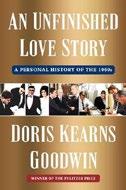
The renowned presidential historian delves into the Kennedy and Johnson eras, drawing from the archives and personal insights of her husband, a former speechwriter for both leaders.
In the years before Richard “Dick” Goodwin’s death in 2018, he and his wife, Kearns Goodwin, embarked on an ambitious project that unfolded into a poignant journey through time. Together, they delved into Dick’s extensive trove of personal memorabilia, comprising diaries, letters, and countless documents housed in
MARCH 1, 2024 61 KIRKUS REVIEWS NONFICTION
hundreds of boxes—a testament to his devoted service in both administrations. Upon reflection, moments of conflicting insights and assessments of the two presidents occasionally surfaced, notably in the case of Johnson, with whom the author collaborated after his term in office. Their conversations laid the groundwork for her debut book, Lyndon Johnson and the American Dream . In earlier years, Dick had skillfully crafted many of Johnson’s most significant speeches, commemorating historic bills such as the 1965 Voting Rights Act, which contained the iconic words, “We Shall Overcome.” As the author writes, “we experienced the man at different times—Dick at the height of the Sixties, me toward the end of the decade and the end of Lyndon Johnson’s life. And during that decade of the Sixties, he so changed both our lives that here we were, in our seventies and eighties, still arguing, bantering, and trying to come to terms with his enormous impact on us and on the country.” Resigning from Johnson’s administration in 1965, Dick transitioned to teaching roles at various institutions and authoring numerous books and articles. However, it’s this earlier career phase that ignited the fecund author’s imagination, serving as the foundation for how their perspectives on the trajectory of politics and the nation had shifted. A heartfelt tribute to the author’s late husband and a captivating reflection on this pivotal era in American politics.
The Wives: A Memoir
Gorrindo, Simone | Scout Press/Simon & Schuster (416 pp.) | $29.99 | April 9, 2024 9781982178499

was uprooted to Columbus, Georgia, where she assumed a new identity: Army wife. Joining the Army was her husband’s dream. “If I have to choose between you and the Army, it’s the Army,” Andrew told her during a couples therapy session. By then, they had been together for four years; his words, she recalls, “hit me with the force of a physical blow.” Nevertheless, their love prevailed, and in 2012, he began training at Fort Benning to join a rapidly deployable combat unit destined for Afghanistan. With Andrew completely consumed by the Army, Gorrindo was left to find her place in an alien culture. She was shocked that guns were everywhere, “on top of refrigerators, in nightstands, sometimes in every room of the house.” She felt far different from other Army wives: Most were younger, some married out of high school, and many had young children. “We hadn’t shared the cultural experiences that translated to everyday conversation,” Gorrindo reflects about trying to connect with another wife. “Talking to her was a little bit like yelling across the deck of a boat in a windstorm.” Yet the wives were all she had to counter her loneliness when Andrew was away for long stretches at a time—and when, even at home, he felt like a stranger.
“The Army was changing him,” she writes, “making the soft parts of him hard, the warm ones cool to the touch.” Of course, there was also the constant fear that he would be killed. Only the other wives understood her anxiety, despondency, and frustration and, Gorrindo realized, “shared something significant: a core philosophy of survival.”
An intimate memoir of sacrifice and devotion.
The reality of marriage to a soldier.
At the age of 28, newly married and working at a publishing house in New York City, Gorrindo

Who Owns the Moon? In Defence of Humanity’s Common Interests in Space
Grayling, A.C. | Oneworld Publications
(224 pp.) | $26.95 | May 9, 2024
9780861547258

An assessment of the possibilities for a multinational agreement on the regulation of space.
Grayling, the eminent British philosopher, worries about the planetary impact of the human pursuit of “profit and advantage.” The author claims that the prospect of valuable minerals on the moon and the planets, the commercial and military possibilities of low and medium Earth orbit, and the territorial longings of nation-states are likely to breed competition and conflict. Grayling particularly fears a repeat of what occurred in the late 19th century when powerful countries colonized Africa for wealth and territory—a problematic comparison on many levels. The 1967 United Nations’ Outer Space Treaty is inadequate regarding both the militarization of space and its exploitation by private enterprise. Any new international treaty must be carefully tailored to how space should be managed, include all nations as signatories, be supported by a central body with monitoring capabilities and enforcement powers, and benefit all humanity. In this way, “although no one owns the moon…we will all be responsible for it.” Space will thereby become “the common possession of humanity.” To this end, Grayling examines current international treaties that govern two similar realms: the oceans and Antarctica. He searches for language that will garner wide consensus and be legally enforceable. Despite his pessimism that the international order “is an anarchy of self-interests only tenuously constrained by expediencies,” Grayling believes that creating
an
more on the Moon, visit Kirkus online. KIRKUS REVIEWS 62 MARCH 1, 2024 NONFICTION
For
informed public and crafting treaties and conventions through the U.N. can prevent space from turning into “yet another but even larger arena of human conflict.” His appeal to the reasonableness of people and nations, though, is a weak basis for a sustainable agreement. His argument is aspirational, and the book is mainly background for a more in-depth discussion.
A primer of legal terminology and a plea for recognizing the potential dangers of space exploration.
America Last: The Right’s Century-Long Romance With Foreign Dictators
Heilbrunn, Jacob | Liveright/Norton (264 pp.)
$28.99 | Feb. 20, 2024 | 9781324094661
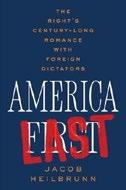
The authoritarian right’s love of dictators is a feature, not a bug—and one with a long history.
Heilbrunn, editor of the National Interest and author of They Knew They Were Right , examines contemporary groups such as the Heritage Foundation with a gimlet eye, critical of their obeisance to nationalist rulers such as Hungary’s Viktor Orbán. “How,” he asks, “had a small, landlocked country—with half the population of Florida and dependent on economic subsidies from Brussels—emerged as a model for the proud American Right, those supposed believers in American exceptionalism?” It’s a good question, but also one that could have been raised from the time of the Federalists. The attraction of like to like, of nationalist to nationalist, supremacist to supremacist, is a theme in American history—and, Heilbrunn adds, “a proclivity for authoritarianism is American to its core.” That authoritarianism, as the title bespeaks, holds modern, multicultural, multiethnic America in disdain. It allows a Donald Trump to hope for the country’s economic collapse, and it
allows other right-wingers to expound on the idea that the U.S. is a republic and not a democracy. In fact, Heilbrunn argues, the republican features of small-r republican America were put in place to hinder mob rule. Conservative icons such as H.L. Mencken and Henry Regnery are called into question for their support of Kaiser Wilhelm during World War I, and later ideological heirs such as Charles Lindbergh and Father Charles Coughlin for their undisguised admiration of the Third Reich. In more recent times, Heilbrunn notes, their nationalism has taken the form of anti-Semitism and, today, pro-Russian and antiUkrainian posturing—to say nothing of J.D. Vance’s call to “fire every single mid-level bureaucrat, every civil servant in the administrative state” precisely to emulate “what… Orbán has done.”
A sweeping, well-argued condemnation of the right-wing penchant for totalitarianism.
Kirkus Star
The
Year of Living Constitutionally: One Man’s Humble Quest to Follow the Constitution’s Original Meaning
Jacobs, A.J. | Crown (304 pp.) | $30.00 May 7, 2024 | 9780593136744
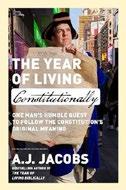
An experiment in following the Constitution’s original meanings.
Having written previously about “living Biblically” for a year, Jacobs turns now to “living Constitutionally”—i.e., imaginatively transporting himself back to 1787 (or, occasionally, later years when amendments were ratified) in order to reflect on the Founding Fathers’ legal and ethical ideals. We follow the author’s (sometimes loose) adoption of late-18th-century customs as he
probes, for instance, assumptions about free speech, gender roles, and civic participation and considers profound shifts in cultural sensibilities from the founders’ era to our own. Much of the text is delightfully lighthearted and playful in its recounting of the author’s experiences, but Jacobs consistently offers insightful and informed analysis of the actual content of the Constitution, the reasoning behind it, and the implications of social change and evolving values. Though revered by many as something approximating a sacred and infallible text, the document itself is revealed as a flawed product of its time, steeped in exclusionary prejudices and in many ways incompatible with modern sensibilities, yet still illuminating for its attempt to defend core freedoms and promote a bold version of democracy. The author’s commentary on present-day interpretive debates is particularly rewarding. He provides refreshingly clear and sensible accounts of the anachronistic powers granted to the Supreme Court, the ambiguities inherent in the Second Amendment’s protection of gun rights, and the competing claims made by originalists and so-called living constitutionalists. Jacobs makes the persuasive argument that, in spite of the moral limitations of the founders from a 21st-century perspective, we might learn from the 18th century’s “emphasis on the common good, the quest to control one’s rage, the slow thinking, the experimental mindset, the distaste for aristocracy, and the awe at being able to cast a vote.”
A marvelously witty and wise consideration of the Constitution’s legacy.

For more from A.J. Jacobs, visit Kirkus online.
MARCH 1, 2024 63 KIRKUS REVIEWS NONFICTION


EDITORS’ PICKS:
Our Migrant Souls: A Meditation on Race and the Meanings and Myths of “Latino” by Héctor Tobar (MCD/Farrar, Straus and Giroux)


Red Memory: The Afterlives of China’s Cultural Revolution by Tania Branigan (Norton)
Mr. B: George Balanchine’s 20th Century by Jennifer Homans (Random House)
How Not To Kill Yourself: A Portrait of the Suicidal Mind by Clancy Martin (Pantheon)
How To Say Babylon: A Memoir by Safiya Sinclair (Simon & Schuster)
Master Slave Husband Wife: An Epic Journey From Slavery to Freedom by Ilyon Woo (Simon & Schuster)
The Story of Art Without Men by Katy Hessel (Norton)
The Great White Bard: How To Love Shakespeare While Talking About Race by Farah KarimCooper (Viking)
The Times: How the Newspaper of Record Survived Scandal, Scorn, and the Transformation of Journalism by Adam Nagourney (Crown)
Sonic Life by Thurston Moore (Doubleday)
Everything I Learned, I Learned in a Chinese Restaurant by Curtis Chin (Little, Brown)
Say the Right Thing: How To Talk About Identity, Diversity, and Justice by Kenji Yoshino and David Glasgow (Atria)
Fully Booked
Memoirist Curtis Chin headlined a special episode dedicated to the Best Nonfiction of 2023. BY
EPISODE 347: CURTIS CHIN
On this episode of the podcast from last fall, Curtis Chin joined us to discuss the memoir Everything I Learned, I Learned in a Chinese Restaurant (Little, Brown, Oct. 17), one of Kirkus’ Best Nonfiction Books of 2023. This standout memoir chronicles the Detroit-born author’s coming-of-age in his family’s regionally famous Cantonese restaurant, where everyone—from politicians and movie stars to locals and regulars—was welcome and well fed.
MEGAN LABRISE

Chin is a writer, producer, director, and activist whose social justice documentaries have been screened at over 600 venues around the world. He is also a co-founder of the Asian American Writers’ Workshop in New York City and served as the organization’s first executive director. Everything I Learned, I Learned in a Chinese Restaurant is his first book. Here’s a bit from Kirkus’ starred review:
“Chin grew up in the 1980s and ’90s as a not entirely willing exemplar of a ‘model minority.’ The latter term, he writes, is inadequate and incorrect, since in his hometown of Detroit, the white population was in fact smaller than that of people of color. His aspirational parents moved far from their downtown restaurant, where he worked alongside them throughout his adolescence, so that Chin and his siblings could attend good public schools in neighborhoods where, ‘we were outsiders.’…To all the obstacles that Chin faced, he added a switch from a prelaw major to a degree in creative writing: ‘I didn’t know which truth would be more difficult to reveal—that I was gay or that I was going to be a poet.’…[T]he author closes his affectionate, self-effacing narrative with a paean to the power of familial love, to say nothing of an expertly cooked meal.”
Chin talked about the joys of discovering the history of his family; their restaurant, Chung’s Cantonese Cuisine, which closed in 2000; and the city of Detroit. He and I discussed how Chung’s

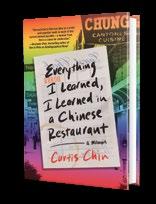
Everything I Learned, I Learned in a Chinese Restaurant: A
Memoir
Chin, Curtis Little, Brown | 304 pp. | $29.00 Oct. 17, 2023 | 9780316507653
welcomed diners of all stripes; how his parents always encouraged him and his siblings to talk to strangers; finding his place in the bustling restaurant scene; his approach to describing various life events as if he were in the moment; how the book started as a collection of stories for his family; the murder of Vincent Chin and how it touched him, his family, and its community; the importance of telling one’s story; co-founding the Asian American Writers’ Workshop; bringing a poet’s precision to memoir writing; and much more.
Then editor Eric Liebetrau joined me to discuss selecting the best nonfiction of the year.

To listen to the episode, visit Kirkus online.
PODCAST // NONFICTION
MARCH 1, 2024 65 KIRKUS REVIEWS
Michelle Li
The Forbidden Daughter: The True Story of a Holocaust Survivor
Jakob, Zipora Klein | Harper/HarperCollins (288 pp.) | $19.99 paper | April 23, 2024 9780063296657

The Holocaust–era tale of an orphan girl who escaped the Nazi terror via a succession of Jewish families and relatives in Israel and America.
Jakob is a relative of Elida Friedman, born in 1943 in the Kovno ghetto in Lithuania. Soon after her birth, Elida’s parents, Jonah and Tzila Friedman, were murdered by the Nazis. In what she describes as a “biographical novel,” the author reconstructs Elida’s story, basing the narrative on a wide variety of sources, including “documents, certificates, court records, drawings, and letters in Elida’s handwriting.” Though Jews were forbidden from giving birth in Kovno, the Friedmans resisted the ban, giving the girl a name that means “nonbirth” in Hebrew. Desperate to save her, they engineered a scheme to have her smuggled out by a Christian Lithuanian family to their farm in Kelmuciai, hoping that Jonah’s cousin Lazar could retrieve the girl after the war. Elida became “Rita,” and she was well loved and taken care of. Following the war, she was adopted by a Jewish refugee couple from Russia who settled in Vilna. For years, growing up in the working-class Ruhin home as their only daughter, attending Russian schools, Elida gradually came to understand that they were withholding the truth about her past and that Lazar had been searching for her. Though she was sent to Israel to meet her remaining family, there was still no fixed home for her until Lazar and his wife took her to Texas and adopted her. A determined
student with a gift for languages, Elida was often confused and angry, and Jakob depicts her as headstrong, precocious, and not always sympathetic. Nonetheless, Elida’s story is miraculous, and this subjective narrative of her life captures it effectively.
An engrossing tale with heart-rending details of its subject’s difficult life at each trying stage.
American Bloods: The Untamed Dynasty That Shaped a Nation
Kaag, John | Farrar, Straus and Giroux (288 pp.) | $28.00 | May 14, 2024 9780374103910

An account of American ideology through the lens of an extraordinary family.
In his latest, Kaag, author of American Philosophy and Hiking
With Nietzsche, tracks the lives and influence of members of the Blood family, beginning in the 17th century and extending to the dawn of the 20th century. Though none of them is especially famous in their own right, each family member played a role in seminal historical events. Taken together, their stories provide an original and revealing perspective on the evolution of American ideals over several centuries. “The Blood brothers,” writes Kaag, “belonged to one of America’s first and most expansive pioneer families, which explored, and laid claim to, the frontiers—geographic, political, intellectual, and spiritual—that became the very core of the nation.” The author emphasizes that a consistent element of the Bloods’ character was their commitment to “wildness,” a restless, asocial bent that makes them uncanny representatives of a long-standing American ethic. One fascinating element is Kaag’s discussion of the intersections of the Bloods with iconic figures—including Emerson, Thoreau, Frederick Douglass, and William
James—each of whom seems to have been profoundly impacted by the encounters. Three Bloods in particular stand out in Kaag’s rich and incisive descriptions: the hermetic astronomer Perez Blood, who “helped Thoreau define his conception of human freedom”; the hard-charging Aretas Blood, who rose from poverty to establish a business empire; and the “seer-mystic” Benjamin Paul Blood, who pioneered the use of psychedelics for intellectual growth. Some of the author’s phrasing is hackneyed—“This Blood lived his short life like there was no tomorrow”—and his openness to entertaining the relevance of “astrological forces” and “mystical significance” can be distracting. Overall, though, Kaag provides a lively and insightful examination of his remarkable subjects. An astute and absorbing narrative of one family’s intersection with the nation’s development.
Patton’s Prayer: A True Story of Courage, Faith, and Victory in World War II
Kershaw, Alex | Dutton (368 pp.) | $32.00 May 21, 2024 | 9780593183779

A detailed study of the critical role of Gen. George Patton and his Third Army in World War II. Of the many colorful figures to emerge from WWII, Patton is one of the most remarkable and notorious. Pugnacious, ruthless, and impetuous, he was a skilled battlefield tactician and always had one eye on history—especially his own. The problem faced by Kershaw—a journalist who has written a number of books about the war, including The Liberator, The Longest Winter, and The First Wave —is that there is already a shelf of volumes on Patton. The author tries to get around this issue by combining an analysis of Patton as a person and military leader with an account of the
KIRKUS REVIEWS 66 MARCH 1, 2024 NONFICTION
Third Army, which Patton commanded in the final stretch of the war. When Patton’s troops were bogged down in the winter mud and rain, he asked the senior chaplain to come up with an inspirational message mixed with a prayer. He did, and Patton was so pleased with it that he ordered 250,000 copies printed and distributed. The tactic worked because most of the American soldiers fought hard to delay and frustrate the German Ardennes counteroffensive. Patton often made a point of visiting the front line, and he had a secret wish to die a warrior’s death in battle. However, he died due to complications following a car accident shortly after the end of the conflict. Kershaw handles all the material with authority, and even if there is not much new to say, he lets the charisma and mercurial nature of Patton shine through. Readers unfamiliar with Patton will find this book to be a solid, unadorned account, which is, perhaps, what Patton would have appreciated. With careful research, Kershaw tells an engaging story, blending Patton’s virtues and flaws into a well-drawn portrait.
The Struggle for Taiwan: A History of America, China, and the Island Caught Between
Khan, Sulmaan Wasif | Basic Books (336 pp.)
$30.00 | May 14, 2024 | 9781541605046
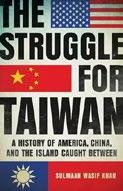
An expert in Asian geopolitics delves into Taiwan’s past, finding critical clues to the turbulent present. Taiwan is often in the headlines as a possible trigger for a catastrophic war between China and the U.S., but behind the noise is a complex history, according to Khan, a senior academic at Tufts and author of Muslim, Trader, Nomad, Spy. Khan is skeptical of the Chinese view that Taiwan is historically part of China, although Beijing has made the claim
since the defeated Nationalists retreated to the island in 1949. The U.S. supported the autocratic government of Chiang Kai-shek, arguing that it was the legitimate government of China. This idea evaporated when Nixon went to China and Taiwan’s position became ambiguous. In fact, ambiguity has since been the defining aspect of Taiwan’s place in the world, with the island locked in a non-country limbo while growing into a dynamic economy and thriving democracy. The U.S. stance has varied with the prevailing winds in Washington, D.C., although the past few years have seen a more pro-Taiwan attitude. The Taiwanese population seems to be leaning toward independence while aware of the difficulties such a move would entail. Beijing regularly makes threats and provocations, seemingly unaware that its belligerence usually backfires. Khan suggests ways to reduce the tension but also discusses options for increasing the deterrence factor, and he emphasizes that the U.S. should determine what future it wants to see. At the same time, it should keep communication channels with China open, so minor tiffs do not spin out of control. Most of all, writes the author, policymakers should be aware of the history that has built the present—but on the issue of Taiwan, there are no easy answers.
Khan recounts Taiwan’s story in a way that shows the importance of understanding the context of the conflict.
Did I Ever Tell You?
A Memoir
Kingston, Genevieve | Marysue Rucci Books (288 pp.) | $27.99 | May 7, 2024
9781668006290
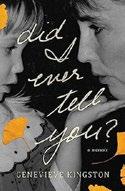
A playwright’s emotionally charged debut book about understanding life in the wake of her mother’s death.
When Kingston was 3, her mother was diagnosed with “an aggressive form of breast
cancer” that, over the course of a few years, spread to her brain, ultimately killing her. During those intervening years, the author’s mother curated a collection of gifts and messages to mark the birthdays and milestones that would come after her death. Kingston’s memoir is the story of her childhood— one defined by the ever-present expectation of and planning for death—and time’s insistent march through her adolescence and young adulthood, punctuated with disappointments, depressions, and tragedies. It is also the story of her mother, a narrative that includes revelations, some startling, about her own childhood, accomplishments, and marriage and insights into how she apportioned availability, presence, and guidance to her daughter posthumously. As these threads intertwine, otherwise minor memories, such as a childhood sleepover, become saturated with significance, and the emotional sensations of a child are overlaid with the wisdom and reflection of someone much older. For readers, this striation proves both enriching and disorienting, mirroring a touch-and-go intermittency of illness and the inevitability of her mother’s death. Instead of an adult’s analysis of the impact of spending her formative years under the yoke of a parent’s impending death, the author yearns for the past, situating many of the text’s most profound insights with her child self. Thus, Kingston’s story captures the distinct way that a child experiences grief, even anticipatory grief, and the struggle of a child’s mind to envision a future without a parent. As the shape of her grief changes with age, Kingston teaches us something essential about how to collect, hold, and savor memories of loved ones over a lifetime.
A heart-tugging memoir about the many faces of loss.

For more on Chiang Kai-shek,
MARCH 1, 2024 67 KIRKUS REVIEWS NONFICTION
visit Kirkus online.
Kirkus Star
The Museum of Other People: From Colonial Acquisitions to Cosmopolitan Exhibitions
Kuper, Adam | Pantheon (432 pp.) | $35.00 April 16, 2024 | 9780593700679
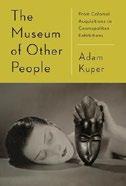
How to exhibit humankind. British anthropologist Kuper brings an authoritative perspective to his vigorous examination of ethnography and anthropology museums, which emerged in Europe and the U.S. in the mid-1800s. These venues displayed “an exotic world of ‘primitive’ or ‘tribal’ peoples who lived far away or long ago.” As European nations expanded their empires into Oceania and Africa and the U.S. extended itself west of the Mississippi, collectors made off with all manner of artifacts. Early British, French, and German museums often reflected a collector’s vision and the sheer abundance of their discoveries. Museums presented not only cabinets of curiosities and pillaged souvenirs, but evidence of the superiority of civilized cultures—evidence, that is, of Western progress from savage origins. The advent of evolutionary theory, though controversial, led some museums to reconsider that idea, organizing collections into cultural or geographical areas rather than on a timeline. Gradually, museums came to rely on anthropologists and ethnographers, although experts often clashed over the meaning of artifacts and the mission of a museum itself. Kuper’s deeply researched history is enlivened with sharply delineated profiles of figures such as anti-Darwinist Louis Agassiz, naturalist Jeffries Wyman, and James Smithson, the illegitimate son of a British aristocrat who willed his small fortune to the U.S. for the establishment of an institution devoted to “the increase and diffusion of knowledge among men.” After much haggling,
Congress agreed to fund the Smithsonian Institution. The intellectual and political debates that roiled museums grew heated by the 1960s, when a “cauldron of controversy” arose “about race, colonialism, cultural appropriation and the very nature of scientific authority.” Claims for restitution of artifacts and debate over scholarship versus native expertise continue to vex curators. Strongly on the side of scholarship, Kuper advocates for cosmopolitan museums that can transcend “ethnic and national identities” and “challenge boundaries.” A vibrant cultural history.
Chamber Divers:
The Untold Story of the D-Day Scientists Who Changed Special Operations Forever
Lance, Rachel | Dutton (448 pp.) | $32.00 April 16, 2024 | 9780593184936

A fine history of the discoveries that allow humans to work safely underwater and the brilliant British scientist who led the effort.
Former Navy engineer Lance, author of In the Waves , has an irresistible subject in J.B.S. Haldane (1892-1964), an eccentric polymath and central figure in the 1920s genetics revolution. His accomplishments in a variety of fields are so numerous that his role in pioneering underwater research is often forgotten. Lance begins with the 1939 sinking of the British submarine Thetis. There was no explosion, and although the crew possessed breathing apparatuses, only a few escaped. Royal Navy leaders appealed to the famous Haldane to learn why. At the time, he was director of a university genetics laboratory, but at the beginning of World War II, he transferred his focus to underwater research. Haldane’s experiments took place at a London factory that
manufactured breathing equipment and possessed a hyperbaric chamber. In the first half of the book, Lance emphasizes the experiments, the subjects of which were the scientists themselves, who occupied the chamber to experience the pressures and varying gas concentrations encountered by submariners. Many suffered dizziness, headaches, and somnolence but also vomiting, seizures, bleeding, collapsed lungs, and broken bones. Some, Haldane included, never fully recovered, but the results dispelled a great deal of ignorance. At high pressures, nitrogen causes confusion, and pure oxygen becomes poison, so carbon dioxide management may be the key. In the second half, the author describes how these discoveries affected the war, mostly during the June 1944 Allied landing at Normandy, preceded by months during which scouts approached the heavily guarded coastline under water and surveyed the beaches to map defenses, obstacles, and minefields, avoiding the disasters that marred earlier landings. Throughout, Lance makes good use of archival material that remained classified until 2001.
A fascinating, hair-raising account of groundbreaking research.
The Demon of Unrest: A Saga of Hubris, Heartbreak, and Heroism at the Dawn of the Civil War
Larson, Erik | Crown (608 pp.) | $35.00 April 30, 2024 | 9780385348744
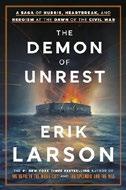
The bestselling author is back with an intriguing tale from the beginning of the Civil War. In his latest appealing historical excavation, Larson, author of The Splendid and the Vile, Dead Wake, and other acclaimed books of popular history, examines the run-up to the Civil War
KIRKUS REVIEWS 68 MARCH 1, 2024 NONFICTION
during the six months between Lincoln’s November 1860 election and the surrender of Fort Sumter: a dismal period when bumblers, not excluding Lincoln, and fanatics dominated. People will fight for their freedom, but more will fight for their money, a fact that persuaded the Founding Fathers to continue the practice of slavery. Abolition became a major issue in the North early in the 19th century, enraging southerners. At the time, there was a widespread belief that Black men and women were fit for nothing better than being enslaved. All major southern religious traditions agreed, along with scholars, educators, journalists, and scientists. Most northerners agreed but hated that enslaved people worked for nothing; this depressed wages so there was opposition to slaves moving into territories and new states. Powerless before taking office, Lincoln vastly overestimated pro-Union sentiment in the South. He assured northern audiences that matters would calm down, believing (against all evidence) that secessionists were rational and that slavery in existing states was inviolate. Popular history demands a hero, so Larson concentrates on Maj. Robert Anderson, commander of the forts in Charleston harbor. Although he was a slaveowner, he did his duty, defending Fort Sumter until it became impossible and returning to the North to great acclaim. True to his style, Larson includes interesting portraits of obscure peripheral figures that enrich the narrative, including James Hammond, a wealthy but obnoxious planter and senator, and Mary Chesnut, wife of an even wealthier planter who kept an invaluable diary.
A welcome addition to any Civil War buff’s library.

The Cleopatras: The Forgotten Queens of Egypt
Llewellyn-Jones, Lloyd | Basic Books (400 pp.)
$32.50 | May 21, 2024 | 9781541602922

A new look at the legendary queen and her equally legendary family.
The iconic female figure of the ancient world, Queen Cleopatra has caught the attention of luminaries from Plutarch to Shakespeare to Elizabeth Taylor, as well as a steady stream of biographers, but even history buffs may be surprised to learn that there were seven Egyptian queens with that name. Llewellyn-Jones, the chair in ancient history at Cardiff University and author of Persians, reminds readers that upon the death of Alexander the Great in 323 B.C., his massive conquests broke up into three parts: Macedonia, the Seleucid Empire, and Egypt, each ruled by a former Alexandrine general.
Ptolemy I Soter and his successors ruled Egypt. The author passes quickly over the first century of what is now known as the Hellenistic era until 192 B.C. when the Seleucid emperor sent his daughter to marry Ptolemy V of Egypt to seal a diplomatic agreement. She became Cleopatra I and gave birth to Cleopatra II, ancestor of the remaining Cleopatras, all of whom married Ptolemies. Llewellyn-Jones agrees that the last Cleopatra deserves her prominence, but her predecessors were no slouches. He adds that the 150 years after 192 was a golden age for royal women in Egypt, when queens transcended traditional gender roles. Readers seeking to learn about Hellenistic people and culture will have chosen the wrong book. This is traditional great-men-andpolitics history, although one in which the great men’s wives were as powerful as—and often more competent than—their husbands. Generous with family trees, Llewellyn-Jones works hard and often successfully to distinguish between a plethora of Cleopatras and Ptolemies and a dizzying series of wars, intrigues, and deadly family quarrels
that ended only when Rome, always a looming power, took over in 30 B.C. An authoritative portrait of the tempestuous but impressive Cleopatra dynasty.
Trippy: The Peril and Promise of Medicinal Psychedelics
Londoño, Ernesto | Celadon Books (320 pp.) $29.99 | May 7, 2024 | 9781250878540
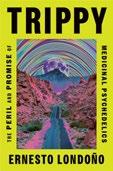
A look at how old drugs are finding a new role in easing mental suffering.
New York Times journalist Londoño’s first book involves his experiences with psychedelic drugs, which he first encountered as a relief from crushing suicidal depression. His early searches led him to several clinics in South America that offered plantbased psychedelics like ayahuasca, which had a long history of effective use among Indigenous tribes. The drug helped the author move past his mental problems, but as he investigated further, he found that many of the treatments seemed like dangerous quackery, and they all came with a hefty price tag. After his return to the U.S., Londoño continued to explore the use of psychedelics as therapy. Some of the people dispensing the drugs genuinely wanted to help trauma victims, especially veterans suffering from PTSD, but others were charlatans. His research led him to medical professionals who had gained official permission to use drugs like ecstasy and psilocybin on an experimental basis. Some results have proved positive, and brain scans indicate that psychedelics can help repair damaged neural connections. Londoño believes that eventually the regulatory authorities will legalize therapeutic psychedelics, but he recognizes the many possibilities for things to go wrong. “When administered by a steady, wise guide, in a safe setting, I have seen psychedelics transform lives, including my own,” he writes. However, he notes, “in the wrong hands, they can
>>>
MARCH 1, 2024 69 KIRKUS REVIEWS NONFICTION
For more on Cleopatra, visit Kirkus online.

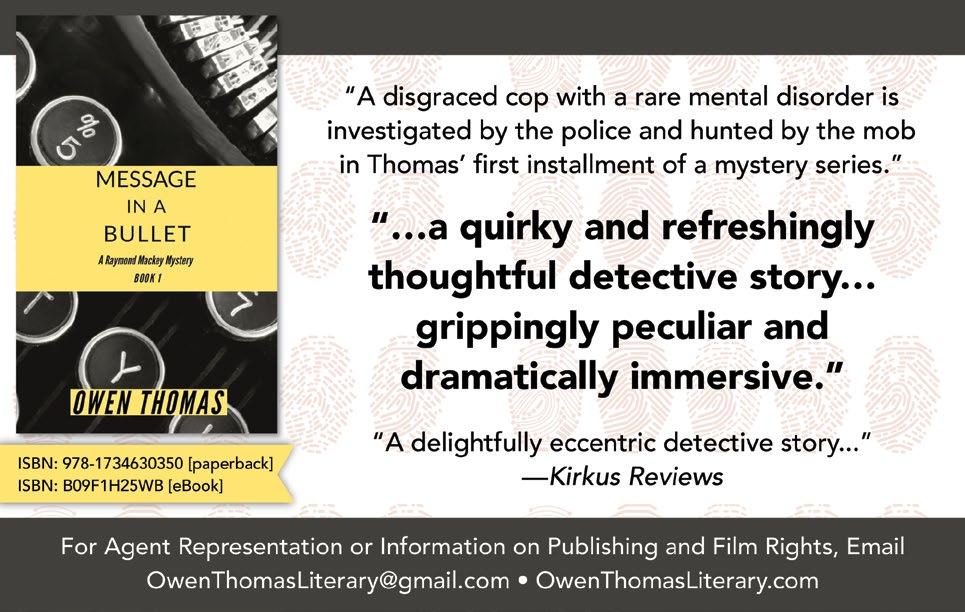
Book to Screen
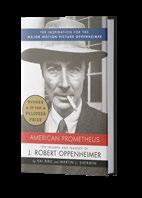
Literary Adaptations Lead the Pack in Oscar Nods
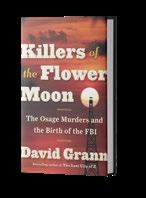
the three most nominated films all based on books.
Oppenheimer, Poor Things, and Killers of the Flower Moon earned the most nominations.
Literary adaptations dominated the Oscar nominations this year, with
Oppenheimer, based on Kai Bird and Martin J. Sherwin’s American Prometheus: The Triumph and Tragedy of J. Robert Oppenheimer, led the pack with 13 nominations, including best picture, best director (Christopher Nolan), best actor (Cillian Murphy), best actress (Emily Blunt), best supporting actor (Robert Downey Jr.), and best adapted screenplay (Nolan).
Poor Things, an adaptation of Alasdair Gray’s novel, earned 11 nods, garnering nominations for best picture, best director (Yorgos Lanthimos), best actress (Emma Stone), best
supporting actor (Mark Ruffalo), and best adapted screenplay (Tony McNamara).
That film was followed closely by Killers of the Flower Moon, based on David Grann’s nonfiction book , with 10 nominations, including best picture, best director (Martin Scorsese), best actress (Lily Gladstone), and best supporting actor (Robert De Niro).
Two other best picture nominees were literary adaptations: American Fiction, based on Percival Everett’s novel Erasure, and The Zone of Interest, based on Martin Amis’ novel of the same name.
Two films in the best animated feature film category were inspired by YA graphic novels: Nimona, an adaptation of ND Stevenson’s novel, and

Robot Dreams, based on Sara Varon’s book
The winners of the awards will be announced at a televised ceremony on March 10.—M.S.

For more book to screen news, visit Kirkus online.

BOOK TO SCREEN // NONFICTION
Kevin Winter/Getty Images
MARCH 1, 2024 71 KIRKUS REVIEWS
be as dangerous as a drunk surgeon with a trembling hand.” This is intriguing material, but Londoño often wanders away from his theme. Several chapters, such as those dealing with his family history, don’t connect strongly enough with the primary material. Nevertheless, the subject of psychedelics is engaging, especially for readers interested in emerging therapies.
Blending solid research and personal experience, the author points to a new frontier for trauma treatment.
The Everything War: Amazon’s Ruthless Quest
To Own the World and Remake Corporate Power
Mattioli, Dana | Little, Brown (416 pp.)
$30.00 | April 23, 2024 | 9780316269773

A compelling study of the tech behemoth’s bid to control whatever it touches.
Amazon has infiltrated our lives, and the U.S. economy, to a degree that no other company ever has. Mattioli, a Wall Street Journal reporter who has covered Amazon since 2019, brings great expertise to her first book. She readily acknowledges that the company provides convenience, product range, and low prices to shoppers, but she believes that it is now doing more harm than good. There are already several books and a wealth of articles explaining how Amazon overpowers small companies through unfair practices, manipulates the tax system, and abuses its employees, but Mattioli examines some new aspects through interviews with former and current employees. Many of her sources requested anonymity, which is understandable given Amazon’s penchant for retribution. The real value of this book, however, is in the chapters about regulating the corporation. Legislation stalled in Congress, but a lawsuit has been brought by the Federal Trade Commission, which
aims to break the giant into separate entities, working on the principle that much of Amazon’s power stems from its domination of numerous connected sectors. For its part, Amazon argues that it constantly works to benefit consumers, but the focus of the FTC case is its anti-competitive market operations. The case is still underway, and while Mattioli is a supporter of the lawsuit, she points to the massive lobbying power of Amazon, as well as its legion of lawyers and PR specialists. Another lawsuit involves the Prime program, claiming that “Amazon purposefully signed up consumers… without their understanding and made it very hard to cancel.” Even if there is no firm conclusion, Mattioli has done much to reveal the snarl behind the smiley-face logo.
Mattioli tears away the Amazon curtain and finds a culture of ruthlessness, greed, and disdain for the law.
A Supreme Court Unlike Any Other: The Deepening Divide Between the Justices and the People
McMahon, Kevin J. | Univ. of Chicago (400 pp.) | $24.00 paper April 12, 2024 | 9780226831060

Analysis of a U.S. Supreme Court far removed from other instruments and tenets of democratic governance. Political scientist McMahon opens with the most consequential single Supreme Court decision in our time: Dobbs , which overturned Roe v. Wade, undoing “a constitutional right that had been in the law books for nearly fifty years.” The decision scarcely elicited comment from the ruling majority and barely any dissent. The decision, notes the author, was another sign of a growing “democracy gap” between the Court and other democratic institutions that lend it legitimacy. The will of the people was once an intangible
institution that held some weight in juridical decision-making; now the Court comprises a majority of “numerical minority justices,” appointed by presidents and confirmed by legislators who represent a minority of the American population. Moreover, writes McMahon, the Court, the product of heavy vetting by the archconservative Federalist Society, is representative of “a small sliver—more like a tiny speck—of [an] America that is closed off to the vast majority.” Given all this, it is small wonder that the Court’s decisions are so increasingly narrow in whom they reward and so onerous to so many ordinary people. Arguing from the general premise that the Court has little or no democratic legitimacy, McMahon suggests amendments to the Constitution that would reduce lifetime appointments to term appointments, and he floats the idea that court packing might have its uses, such as affording “presidents additional opportunities to choose from outside the judicial monastery.” Both measures, McMahon urges, would help depoliticize a Court that promises to be in the sway of the hard right for a generation to come. A cleareyed, depressingly convincing view of a Supreme Court that has abandoned the Republic for other masters.
Kirkus Star
The Puerto Rican War: A Graphic History
Mejias, John Vasquez
Union Square & Co. (112 pp.) | $20.00 May 14, 2024 | 9781454952466

Graphic narrative of an often-overlooked episode in the history of American empire.
Seized by the U.S. after the war against Spain and turned into an unwilling economic colony, Puerto
KIRKUS REVIEWS 72 MARCH 1, 2024 NONFICTION
Rico spawned a liberation movement after World War II that was populated by intellectuals such as Pedro Albizu Campos, inspired by Gandhian nonviolent resistance as well as by guerrillas less reluctant to use force. Four of the latter traveled to Washington, D.C., in 1954 and attacked the Capitol, wounding five representatives. Visual artist Mejias tells this tale in a narrative punctuated by the voices of many of those actors. Counsels one revolutionary to a comrade traveling to the mainland, “My God, even the Library of Congress has a police force plus a new something they call Central Intelligence which goes around killing everybody. Trust no one.” After the short-lived campaign on the mainland, the U.S. promulgated a law that made it illegal to own a Puerto Rican flag or to “speak or write of independence.” The author recounts that his story was slow in the making, largely because he used the traditional medium of woodblock printmaking, about which he reasons, “Nobody is waiting around for this book, so it’s going to take however long it’s going to take.” The woodblock method lends density and gravitas to the work that command attention; each centimeter of each panel is rich in visual detail, inviting readers to linger over the page. One panel is particularly memorable, plainly evoking Francisco Goya’s famed painting The Third of May 1808 . Reminiscent of the work of the pioneering graphic artist Lynd Ward, the hand-printed original of this excellent work now resides in the permanent collection of the Metropolitan Museum of Modern Art. A brilliant blend of graphic and literary narration and a lovely work of art in itself.

In the Shadow of Liberty: The Invisible History of Immigrant Detention in the United States
Minian, Ana Raquel | Viking (384 pp.) $32.00 | April 16, 2024 | 9780593654255

interning people arriving from Cuba and Vietnam, building ever higher walls, militarizing the border, and reinforcing the fact that “if the United States is a nation of immigrants, then it is also a nation of prisoners.”
A strong indictment of long-standing anti-immigrant practices in the U.S.
“Since its inception, immigrant detention has been an affront to basic ideals of justice and compassion,” writes Stanford historian Minian, author of Undocumented Lives Even if the numbers of detained didn’t change much from Obama to Trump to Biden, the practice of separating families and detaining children apart from their parents was employed more vigorously in that middle term than on either side. The author chronicles how draconian measures such as imprisonment without due process and even torture have been in place since the 1980s, used as an instrument of policy “by design” to deter immigration with the promise that only trouble awaits. Minian examines immigrants from the 19th century to the present to note that, of course, this determent doesn’t really apply to white Europeans: The exclusions were intended for Chinese and other Asians, then Latinx people, then Jews, and so on. In one case study, the author writes about two Chinese deportees who saved American lives at danger to their own during the Boxer Rebellion, a story similar to that of recent Afghan military interpreters denied admission. In addition, countless Mexican farm workers kept the American agricultural economy afloat during the labor shortages of World War II, only to be deported or jailed afterward. “Before 1954, the government did not even consider that there were options other than detention for dealing with arriving migrants,” writes Minian. However, apart from a period where parole was an option, the government has ended up back where it started: jailing or
A grimly persuasive history, of broad interest to immigration rights activists and reformers.
God’s Ghostwriters: Enslaved Christians and the Making of the Bible
Moss, Candida | Little, Brown (336 pp.)
$30.00 | March 26, 2024 | 9780316564670
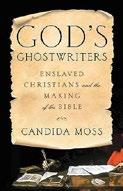
For NONFICTION
A study of the forgotten writers behind the Christian scriptures. Moss, the chair of theology at the University of Birmingham and the author of The Myth of Persecution, sets out to uncover the labor of enslaved people in the writing, editing, and copying of the New Testament. The author provides a wide-ranging overview of the role of slavery in the ancient Mediterranean world, especially the use of enslaved people as readers and writers. Using conjecture, she links the Gospel writers and Paul, especially, to literate people enslaved under Roman rule, beginning with the known fact that Paul dictated his words to scribes. However, her attempts to tie specific New Testament writings to enslaved labor are largely unconvincing. For example, Moss posits a scenario in which Paul speaks through a prison window to a scribe, who must squat on the pavement all day writing down Paul’s words, which the scribe would then have some sway over; she also searches for hidden slave language and meaning in the Gospels, inferring, for instance, that certain aspects of Jesus’ teachings were directly influenced by enslaved writers. Her arguments are thought provoking, but it is nearly impossible to know, 2,000 years later, what the exact situations were, what role in society scribes occupied, and what more on immigrant detention centers, visit Kirkus online. MARCH 1, 2024 73 KIRKUS REVIEWS
liberties they may have taken with texts. Nevertheless, Moss sees her goal in this study as doing the “reparative work” of rediscovering the role and agency of enslaved persons in the formation of the Christian scriptures. To a degree, she has done just that—even if she leaves readers with more questions. An intriguing thesis, but Moss overreaches.
Tripped: Nazi Germany, the CIA, and the Dawn of the Psychedelic Age
Ohler, Norman | Trans. by Marshall Yarbrough | Mariner Books (240 pp.) $29.99 | April 9, 2024 | 9780358646501
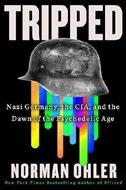
An idiosyncratic trip through the annals of LSD. German author Ohler, author of Blitzed, took on the study of the history of lysergic acid, he recounts, when his father began to give Ohler’s mother microdoses to help mediate her Alzheimer’s disease. Indeed, he writes, legalization looms largely because “more and more governments are beginning to rely on scientific knowledge rather than bow to the ideological demands of the Cold War,” with promising results in the treatment of dementia, addiction, and other maladies. The Cold War is an instrumental part of the history of psychedelic drugs, which stretches back into the annals of the Third Reich, developed by Swiss chemist Albert Hofmann and experimentally used in Nazi camps to break down prisoners under interrogation. American investigators puzzling through the experimenter’s records on “Chemical Methods for Neutralization of the Will” divined the possibilities such a drug might hold. Meanwhile, Ohler writes, postwar Germany was witnessing a narcotics boom as “more and more people took recourse to substances to help them get through the day—or the night.” The reluctance of the Soviets to enforce anti-drug laws led to the suspicion that they might possess Nazi secrets related to
LSD; soon, CIA agents were at pharmaceutical giant Sandoz’s door buying up as much acid as they could. Enter the Ford Foundation, then Timothy Leary, the Beatles, and the psychedelic era. Ohler’s travels in search of information take him from archives to the inner recesses of the mind, thanks to a little dosing of his own, and they’re often entertaining. Jesse Jarnow’s Heads covers a lot of the same ground, but the interweaving of Cold War spy-versus-spy yarns, as well as the speculation that the Nazis were racing to make new psychotropic drugs as much as new rockets, lends considerable drama to the tale.
A winning addition to the literature of psychedelia.
The Loves of Theodore Roosevelt: The Women Who Created a President
O’Keefe, Edward F. | Simon & Schuster (464 pp.) | $30.00 | May 7, 2024 9781982145682
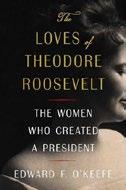
Behind every great man, there is a greater woman— in Theodore Roosevelt’s case, five women. O’Keefe, the CEO of the Theodore Roosevelt Presidential Library Foundation, offers illuminating portraits of the women—Martha Bulloch Roosevelt, Anna Roosevelt Cowles, Corinne Roosevelt Robinson, Edith Kermit Carow Roosevelt, and Alice Hathaway Lee—who helped mold one of the most significant political figures of the 20th century. The author’s exhaustive research is evident, and his prose brings vitality and nuance to his subjects. Relying on a treasure trove of family letters and other archival documents, O’Keefe succeeds in proving his thesis about the Roosevelt women’s centrality in shaping the bombastic president, but the execution is uneven. Some speculation is required to flesh out the motives and desires of Martha, the Roosevelt matriarch, and Alice, Roosevelt’s first
wife. Tragically, Alice’s presence in her husband’s life was brief (she died at age 22), and what little is known of her thoughts comes from a cache of letters preserved by her daughter. Given that most of Alice’s correspondence was deliberately destroyed following her death, the author is forced to rely on other scholars’ musings about a variety of topics, including Alice’s purported influence on Roosevelt’s Harvard thesis on women’s suffrage and her rationale for accepting his marriage proposal. O’Keefe finds better footing when chronicling the life of Edith, Roosevelt’s childhood friend and second wife, and Anna and Corinne, his two sisters, for whom there is a lifetime of correspondence. The author amply demonstrates how Anna repeatedly picked up the pieces of her brother’s life when tragedy struck; how Corinne was his political sounding board; and how Edith created the modern First Ladyship while curating public knowledge about her marriage and her husband’s legacy.
For fans of presidential history, a fascinating celebration of women who helped make an iconic president.
Warming Up: How Climate Change Is Changing Sport
Orr, Madeleine | Bloomsbury
Sigma (320 pp.) | $28.00 | May 7, 2024 9781399404525

An examination of climate change’s effect on the sporting world.
Orr is the founder and co-director of the Sport Ecology Group, “an international consortium of academics aimed at studying the impacts of climate change on sport, the many ways the sport world can reduce its environmental footprint, and how sport can increase its influence on environmental policy and public opinion.” According to the author, “the question isn’t whether climate change
KIRKUS REVIEWS 74 MARCH 1, 2024 NONFICTION
will impact sports. It already is. The question is: how fast can the sports world adapt?” If conditions worsen and the sports sector does not adapt, it risks “falling apart completely.” In a text based on scholarly research and interviews with members of the sports industry, Orr discusses the ways climate change continues to affect sports, including details about specific athletes, teams, and events and the impact of increasing temperatures, wildfires, floods, and declining snowfall. Orr also shines light on a particular concern with respect to sports and climate change: deferring to the coaches. As she cautions, “If you have an athlete who can’t or won’t speak up for themselves [regarding discomfort or injury], that athlete could be at risk.” Orr occasionally digresses from her primary focus, commenting on what she describes as the “elephants in the room” with respect to the world of snow sports, which include a discussion of “ski conglomerates” that haven taken over resorts, “too many” skiers being white, and alcoholism and drug use problems in ski towns. However, as she moves back on topic, Orr addresses the ways the unpredictability in the seasons is affecting communities that depend on sports for their livelihood. On a positive note, the author ends by offering an “ambitious” list of adaptations she feels can mitigate the impacts of climate change on sports.
Prudent advice for all members of the sports industry.
Kirkus Star
I Just Keep Talking: A Life in Essays
Painter, Nell Irvin | Doubleday (464 pp.) $35.00 | April 23, 2024 | 9780385548908
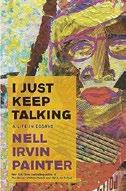
The distinguished academic offers astute perspectives on America, past and present. Painter, author of Old in Art School and The History of White
People, gathers more than 40 previously published essays, framed by a new introduction and coda, reflecting her shrewd analyses of issues including race, class, and gender; history and historiography; police brutality and poverty; art, education, and politics. Painter, who grew up in the San Francisco Bay Area in a family of “proud progressives,” was part of a diverse student body at UC Berkeley. “My Blackness isn’t broken,” she writes. “It faces a different way. Mine is a Blackness of solidarity, a community, a connectedness to other people who aren’t known personally, of seeing myself as part of other people, other Black people.” Her connectedness has led her to reveal “real hurt, real blood, real trauma” in her writing, whether debunking the mythology surrounding Sojourner Truth, examining the way Spike Lee reinvented Malcolm X for his movie, or uncovering the stereotypes that undermined Anita Hill. Some pieces assess the work of other historians—e.g., she critiques Eric Foner’s Reconstruction, a book she otherwise admires, for “its virtual neglect of gender.” Gender and class are central to Painter’s portrayal of Mary Quinn Sullivan, the youngest and least-known founder of the Museum of Modern Art. Throughout, Painter confronts divisive questions, such as affirmative action and reparations, about which she has this suggestion: “First every Black person should have his or her own therapist for life, because dealing with this society is enough to make you crazy. Second, every White person should have to live two months as Black.” The author has many significant thoughts about the 2016 election, which colorized voting as Black, and about the future of democracy. Painter complements her essays with her artwork.
A vibrant, insightful collection from an indispensable voice.

The Secret Lives of Booksellers and Librarians: True Stories of the Magic of Reading
Patterson, James & Matt Eversmann with Chris Mooney | Little, Brown (352 pp.) $30.00 | April 8, 2024 | 9780316567534
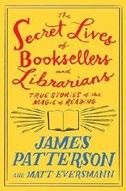
A celebration of the world of books. Patterson, Eversmann, and Mooney gather first-person testimonies from independent booksellers (including author Judy Blume, who started her Key West store when she was 78); booksellers at chain stores like Barnes & Noble; and school, college, private, and public librarians from around the U.S. and Canada. They reminisce about their early discovery of books, their passion to become a librarian, or the unexpected opportunities that gave them a chance to work in a bookstore and, for some, to own one. Despite the title, few of the contributors have had a secret life. Some, though, have unexpected backgrounds: One is the daughter of Holocaust survivors, who named her bookstore after a grandmother who perished in a concentration camp. Several are military veterans. Many became a librarian or bookstore owner after a different career—in real estate, as a newspaper reporter, or, in Blume’s case, after 50 years as a successful writer. All have upbeat, inspiring things to say about connecting books and readers, and they express real concerns about the “wildly dangerous” movement to ban books. Books, they know from firsthand observation, can change lives. A librarian in charge of jail and prison services at Rikers reveals, “[O]ne of my favorite programs is Daddy & Me, a workshop that gives incarcerated fathers the skills to encourage early literacy in their children.”
The youth services program director of the Cleveland Public Library describes its system’s offerings: “Beyond organizing book and culture events, the youth services department is also a resource center for parents and educators,
>>>
MARCH 1, 2024 75 KIRKUS REVIEWS NONFICTION To read the review of The History of White People, visit Kirkus online.







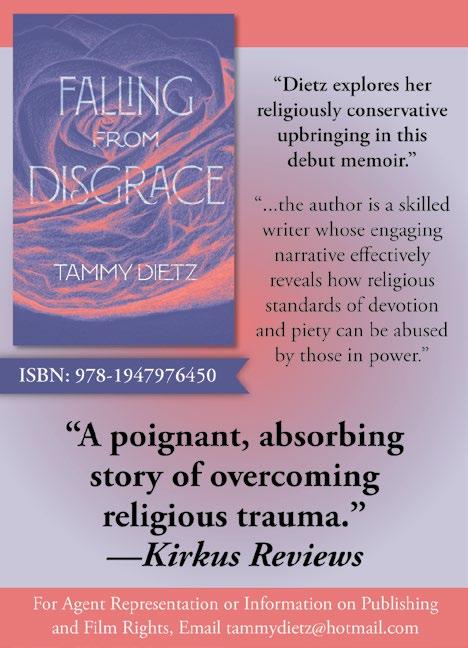
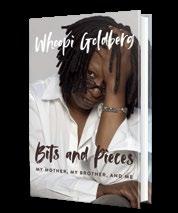
Memoir by Whoopi Goldberg Coming This Spring
Bits and Pieces will shed light on the actor and talk show host’s youth and family.
Whoopi Goldberg will shed light on her youth and her family in a new book.
Blackstone will publish the actor, comedian, and talk show host’s Bits and Pieces: My Mother, My Brother, and Me this spring, People magazine reports. The press describes the book as “a new and unique memoir of her family and their influence on her early life.”
Goldberg, born Caryn Johnson in 1955, was born and raised in Manhattan, the daughter of a single mother. She started acting in the 1980s and received considerable acclaim for her second movie, The Color Purple, which earned her an

SEEN AND HEARD
Oscar nomination for best actress.
She went on to star in several films, including Jumpin’ Jack Flash, Burglar, and Ghost; she won an Oscar for best supporting actress for her performance in the latter film. She has co-hosted the talk show The View for the past 16 years.
Goldberg is the author of several previous books for adults and children, including Two Old Broads: Stuff You Need To Know That You Didn’t Know You Needed To Know, co-written with M.E. Hecht, M.D., published in 2022.
Blackstone calls Bits and Pieces “a moving tribute from a daughter to her mother, and a beautiful portrait of three people who loved each other deeply.”
Bits and Pieces is slated for publication on May 7.—M.S.
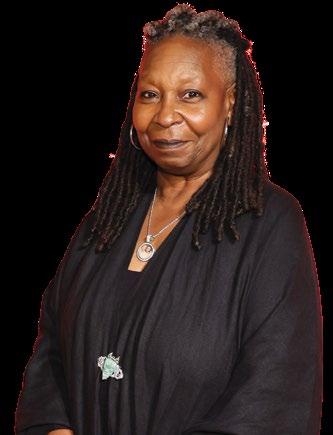
SEEN AND HEARD // NONFICTION Dia Dipasupil/Getty Images
Whoopi Goldberg
KIRKUS REVIEWS
For a review of Two Old Broads , visit Kirkus online.
children and students, providing free lunches and after-school tutoring at all our branches.” The librarian at Houston’s Holocaust Museum runs a children’s story hour. All testify to the extraordinary camaraderie among bookstore owners and the deep satisfaction of creating a vibrant community for readers. A compendium of warm recollections.
The Way of the Champion: Pain, Persistence, and the Path Forward
Rabil, Paul | Portfolio (256 pp.) | $29.00 May 7, 2024 | 9780593545492

A former professional lacrosse player offers insight into the perennial human quest for excellence.
For Rabil, whom the New York Times called “the LeBron James of Lacrosse,” choosing challenge is the way not just of the champion, but of anyone who seeks what champions have in common: greatness. He begins by considering the amateur stages of a champion’s journey, which are necessarily characterized by exploration and experimentation. For the person who walks this part of the path, “the goal is to find the thing that…will eventually inspire” full commitment. After that, the individual must leave behind fear to move beyond what Arnold Schwarzenegger has called the “daydreaming” phase to goal setting and methods that include daily workouts/practice, as well as confronting setbacks with realistic optimism. The next stage is that of the professional. The freedom to play now becomes imbued with seriousness: “You have to invest more of your time, more of your resources,” and be more aware of the competition than ever before. The discipline of the amateur now becomes insanity “about the craft.” Being a professional also means learning how to work with others on a team because greatness means asking for help and letting others help make
you better. “You should be able to do anything, but you can’t do everything,” writes the author. The final stage of the champion’s journey involves letting go “of attachments and expectations” and, like soccer great Abby Wambach, seek to be forgotten so that the greatness of others can emerge (“I want to leave a legacy where the ball keeps rolling forward”). Accessible and practical, Rabil’s book will appeal to anyone seeking not only to understand what it takes to succeed, but also to understand the courage, discipline, and grace it takes to become a champion. Bill Belichick provides the foreword. Wise, inspired reading.
Kirkus Star
The Serial Killer’s Apprentice
Ramsland, Katherine and Tracy Ullman
Crime Ink/Penzler (336 pp.) | $26.95
April 16, 2024 | 9781613164952
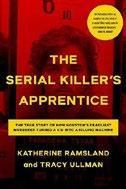
An intimate investigative account of a notorious serial killer focused on the making of his teenage apprentices. Acclaimed forensic psychologist Ramsland, author of Confession of a Serial Killer, Beating the Devil’s Game, and dozens of other true-crime books, teams up with investigative journalist and documentarian Ullman to add materially to the 50-year-old story of the “Candy Man” killer, Dean Corll, who was shot and killed in 1973. The authors examine the involvement of David Brooks and Elmer Wayne Henley Jr. as apprentices, performing Corll’s “grunt work,” which consisted of the abduction, torture, murder, and burial of other teenage boys. The authors explore the devious strategies predators employ when choosing their “apprentices” and grooming them. Brooks and Henley were both ready targets for Corll, but Henley, the book’s primary character,
is especially noteworthy, both in terms of his vulnerability and willing participation as a primary accomplice to a serial killer. Ramsland and Ullman expand the background to Corll’s reprehensible acts to reveal the work of a larger criminal organization, a widespread network of sex offenders dealing in the trafficking and murder of boys operated by John David Norman, who “had been charged more than two dozen times previously for child sex crimes and had a long rap sheet charted by the FBI.” Norman, Corll, John Wayne Gacy, and thousands of other pedophiles coordinated their heinous acts for years. At the end, the authors provide sobering images from the case, including those taken on the day of Corll’s murder, as well as statements by the teen accomplices upon their arrests. Frighteningly, the authors write, “many of the same grooming techniques that Corll employed are still in use because they’re successful.” Ramsland and Ullman paint a disturbingly vivid portrait of true evil.
Not for the faint of heart, but truecrime aficionados will appreciate this fast-paced, illuminating report.
Kirkus Star
Chaim Weizmann: A Biography
Reinharz, Jehuda & Motti Golani
Trans. by Haim Watzman
Brandeis Univ. Press (820 pp.) | $40.00 May 1, 2024 | 9781684581962

Encyclopedic biography of the first president of Israel.
Born in the Russian-controlled Pale of Settlement to prosperous religious Jews, Weizmann (1874-1952) studied chemistry in Berlin and styled himself a thoroughly Westernized Russian Jewish intellectual, and he was swept up in the nationalist Jewish movement
KIRKUS REVIEWS 78 MARCH 1, 2024 NONFICTION
galvanized by Theodor Herzl at the turn of the century. In 1904, he moved to Manchester to work in a chemistry laboratory. Immersed in English Zionist circles, he befriended Conservative Prime Minister Arthur James Balfour, and Weizmann persuaded him about the passion Jews felt for settling in Palestine, as well as founding the Hebrew University. Proving himself useful to England in World War I due to his bacteriology research, and moving about in the highest milieu, Weizmann hammered away at British objections. As Jewish history professors Reinharz and Golani show, the Balfour Declaration, issued late in 1917, came at a moment when British military prospects in the region were at a low point. British policymakers, with an eye to American Jewish interests and the threat of the German government’s courting of German Jews, “judged Zionism to be a potentially serious force worth support and cultivation.” Weizmann worked to unify the international Jewish community and keep immigration to Palestine open as another world war loomed, despite growing Arab opposition and British restrictions, and his charismatic personality dominated the World Zionist Organization as well as the Jewish Agency. In this definitive bio, the authors studiously portray Weizmann as a skilled tactician, striking out alone often righteously, impatient with the progress of Zionism and often failing to include others in his decision-making. They depict him as a Moses figure, a bridge between Herzl and David Ben-Gurion who toiled to advance the Zionist dream yet saw it to fruition only briefly. A scrupulously detailed work chronicles the incremental triumph of Zionism through its greatest champion.
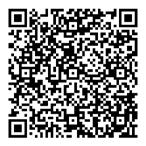
Drive: Scraping By in Uber’s America, One Ride at a Time
Rigsby, Jonathan | Beacon Press (256 pp.)
$27.95 | May 14, 2024 | 9780807007938
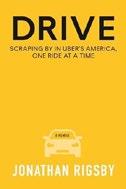
A crime intelligence analyst recounts his experiences working as a night-shift ride-share driver. Only after financial necessity forced Rigsby to become a ride-share driver did he understand just how difficult—and at times punishing—it could be to work a low-level service industry job he never expected to have. With degrees from Vanderbilt and the University of Chicago, the author had expected that “meaningful work would automatically follow.” What awaited him instead was an interesting but low-paying civil servant job, fatherhood, and divorce after just a few years of marriage. Unable to qualify for welfare benefits in his home state of Florida, the author began working for Uber. At first, every rider “ping” on the Uber driver app seemed to whisper “the promise of a better life,” but long hours spent masking his personal pain behind the wheel drove him to drink excessively and gave rise to a host of health issues including hypertension and anxiety. Rude passengers routinely left him ruminating for days about ways he could have “handled the situation better.” On one particularly harrowing occasion, a rider brutally assaulted him for not complying with his wishes. Because an evening’s wages could fluctuate, the author sometimes supplemented his meager income by selling blood plasma, an experience he describes as “dehumanizing, meant to streamline human beings into an industrial product.” Rigsby is unsparing in his analysis of the technology behind the ride-share system. Their deliberate “gamification” ensnares drivers already conned into believing they are their own bosses by transforming the passenger pickup into a “nefarious” game that keeps them
coming back for more. This candid, disturbing book reveals how technology, greed, and the gig economy have contributed to both a capitalist dystopia and the continued “withering of the American Dream.”
Provocative, eye-opening—and sometimes frankly terrifying—reading.
The House of Hidden Meanings: A Memoir
RuPaul | Dey Street/HarperCollins (256 pp.)
$26.99 | March 5, 2024 | 9780063263901

The trailblazing “mother” of all drag queens unpacks the baggage of his childhood, broken family, and adventuresome adulthood.
RuPaul (b. 1960), the pioneering creator of RuPaul’s Drag Race, writes eloquently about his early decades. While his fearless mother taught him independence and self-sufficiency, his father offered largely indifference and disappointment. “My inheritance from my father was a stage presence,” writes the author, which has served him well across a dazzling career of iconic performances and appearances. As he recounts, he was 12 when his “secret girl” awakened, spurred by the film Cleopatra Jones, and in his early teen years, he took inspiration from Anne Francis, Cher, and Diana Ross, among other significant cultural figures. In the progressive Atlanta of the 1970s and ’80s, RuPaul studied performing arts and experimented with drugs before acknowledging that “the promise of New York was irresistible.” In NYC, he writes, “I was finally getting sexual attention, but it was by disguising myself. I was only doing drag as a joke. But suddenly it seemed like the joke was on me. Back then, my drag wasn’t yet refined in the way it would become.” Despite being “treated with disdain” by many of the “cool kids of the downtown scene,” RuPaul persevered for years, eventually finding massive success. The author writes
MARCH 1, 2024 79 KIRKUS REVIEWS NONFICTION
For more on drag, visit Kirkus online.
poignantly about meeting the love of his life, Georges LeBar, on a Manhattan dance floor, as well as the bittersweet evolution of their relationship. While RuPaul punctuates his life story with knowledgeable opinions on issues like systemic oppression, Black victimization, and the queer community, he occasionally dampens the intensity of the narrative with saccharine platitudes about inner magic and strength, or how “it’s the ego that grips, and nonattachment is the path to freedom.” Nonetheless, RuPaul fans will undoubtedly devour this meticulously recollected, heartfelt excavation of his life’s highs and lows.
A highly candid, empowering celebrity self-portrait.
Kirkus Star
Empireworld:
How British Imperialism
Shaped the Globe
Sanghera, Sathnam | PublicAffairs (464 pp.) $35.00 | May 7, 2024 | 9781541704978

The author of Empireland , which plumbed the legacy of empire in Great Britain, offers a companion book that traces its effect across the world.
Writing to his fellow Britons, British Sikh journalist Sanghera strives to move beyond what he calls “balance-sheet thinking,” in which “the achievements of the British empire [are put] into inane ‘good’ and ‘bad’ categories,” and to find nuance and complexity in it. His quest takes him abroad to Delhi (both Old and New), Barbados, Mauritius, and Lagos, with a fascinating sojourn in Kew Gardens, as well as to a “colossal number of history books and articles” that inform his examination. (The bibliography alone occupies nearly 60 pages.) As most readers will expect, the author’s survey of Britain’s imperial legacy includes the scars inflicted by slavery, indenture, and white supremacy, but they may be more surprised at some
of his other findings. The time spent at Kew, for instance, yields the insight that the cultivation of non-native flora in colonial plantations had economic reverberations that continue into the present day. This and countless other facts Sanghera highlights are fascinating in their own right. However, to fully understand his argument, readers who are not steeped in imperial assumptions will need to be mindful of his British audience and the fact that abolition, for instance, in the minds of many “balance-sheeters,” somehow compensates for its earlier enslavement of some 3 million Africans. The author’s style is often disarmingly colloquial—“We cannot proffer solutions to the world’s greatest geopolitical problems without acknowledging that we created a bunch of them,” he remarks—a mannerism that amplifies his sincerity. If the scope of his interrogation is vaster and therefore harder to contain than that of his earlier work, his honest attempt to reckon with it is just as compelling. A worthy, thought-provoking follow-up.
In This Economy?: How Money & Markets Really Work
Scanlon, Kyla | Currency (304 pp.) | $29.00 April 30, 2024 | 9780593727874

A young progressive’s take on how the economy works and what it means to ordinary consumers.
If Madeline Pendleton’s I Survived Capitalism and All I Got Was This Lousy T-Shirt speaks to the intricacies of personal finance, Scanlon’s offering ratchets up the discussion into more ethereal realms—the economy as a reflection of not just on-the-ground realities but also human emotions. The author opens her debut book with “The Deciders,” the higher-ups who build and shape economic policies that, at least in theory, “are designed to work for the collective benefit.” The Federal Reserve is among this group, with its two
sometimes-conflicting missions of keeping employment high while keeping inflation low through such instruments as contractionary monetary policy. Scanlon does a good job in later sections of relating such macro issues to the vicissitudes of daily life: why, for instance, the imposition of tariffs or the relative strength of the dollar to the yuan makes Chinese trade goods more or less expensive, with the resulting knock-on effects on consumers’ pocketbooks. The discussion of recession is admirably clear, and Scanlon ably explains the causal mechanisms and the fact that from time to time, the economy needs a reset, albeit at a cost borne by ordinary people more than those with deeper resources. Throughout, the author, leaning to the left, reminds readers that the economy is ultimately about people, a matter that governments and corporations seem to have forgotten. “If the minimum wage had moved with productivity growth (as it did up until 1968),” she notes, “it would now be about $24.00 per hour”—a fact that, one hopes, will startle policymakers into taking the issue seriously. Currently, writes Scanlon, “there is no place in the United States where a minimum-wage worker can afford a two-bedroom apartment.” An accessible overview of the dismal science.
Kirkus Star
The Light Eaters: How the Unseen World of Plant Intelligence Offers a New Understanding of Life on Earth
Schlanger, Zoë | Harper/HarperCollins (304 pp.) | $29.99 | May 7, 2024
9780063073852
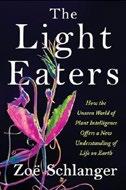
Ambitious attempts to decode the manifest mysteries of plants.
Schlanger, a staff reporter at the Atlantic, has followed multiple
KIRKUS REVIEWS 80 MARCH 1, 2024 NONFICTION
veins of study on plant life to reveal remarkable discoveries and some potentially revolutionary conjectures. Her passion for the realm of plants— and what their lives tell us about our own—is consistent throughout this wondrous text. This is that rare book that fascinates, challenges widely held assumptions, and enlightens in like measure. The author doubtless considers the narrative an overview of current plant science (and its history) for general readers, notwithstanding the years invested in her own preparatory research, but it is hard to imagine a more thorough introduction or a writer more dedicated to her subject and provocative in the questions she asks. Schlanger chronicles her edifying interactions with dozens of scientists, describing numerous experiments. She also weighs the skepticism of botanists and biologists who think the study of intelligence in plants is folly. Many scientists, she notes, still recoil from the damage done to legitimate research by the largely spurious but immensely popular 1973 book The Secret Life of Plants, “a mix of real science, flimsy experiments, and unscientific projection.” However, this reticence pales when held against new studies of the ways in which plants communicate, defend themselves, and remember, as well as the considerations of how biological systems can replicate across the spectrum of species. What is indisputable is that plants made animal life possible in the most fundamental way, transitioning the world’s atmosphere from a toxic shroud of carbon dioxide to an oasis of oxygen. In this lovely book, the plant universe finds a human champion appreciative of its earthly role, concerned for its welfare, and amazed at its capacities.
A delightful work of popular science. You may never look at your houseplants or garden in quite the same way again.

Kirkus Star
The Moment: Thoughts on the Race Reckoning That Wasn’t and How We All Can Move Forward Now
Sellers, Bakari | Amistad/ HarperCollins (192 pp.) | $29.99 April 23, 2024 | 9780063085022

An impassioned account of how Black Americans’ civil rights gains continue to unravel.
Sellers, author of My Vanishing Country, fuses memoir with a cogent discussion of “whitelash” since the 1960s, but especially since the Trump presidency. A CNN commentator whose emotional response to the murder of George Floyd went viral when he exclaimed, “It’s hard being Black in this country when your life is not valued,” the author notes, “I struggle, like most mothers and fathers of Black children, particularly Black boys, to explain the world that they’re walking into.” Sellers grew up in rural South Carolina, listening to his father, a civil rights activist, “discuss all the deaths he’d seen in the 1960s and the day he was shot during the Orangeburg massacre.” The author links this chilling depiction of “white terrorism in the hot Delta summer” to a resurgence of right-wing violence, as well as patterns of police brutality. Sellers moves easily among his family history and subtopics including the resilience of the Black church, the disproportionate toll of Covid-19 on Black communities, and the persistence of institutional racism alongside the pernicious role of “racial capitalist[s]” like Tucker Carlson, whose rhetoric directly influenced the race-motivated mass shooting in Buffalo, New York, in 2022. “Spanning the Civil War and the civil rights eras,” writes Sellers, “this country has experienced two reconstructions followed by a white supremacist pushback against
each,” and the author links this to post-Obama voter suppression. “The supporters of white supremacist philosophy—whether they be Donald Trump, Jesse Watters, Megyn Kelly, Mitch McConnell, or others—want to maintain all the power,” he writes. In impressively concise fashion, Sellers makes a host of pertinent arguments crisply and effectively, disturbingly documenting the overtness of efforts to maintain structural racism across the country. An urgent, astute synthesis of many hard truths about racial backlash.
Unbuild Walls: Why Immigrant Justice Needs Abolition
Shah, Silky | Haymarket Books (256 pp.) $19.95 paper | May 7, 2024 | 9798888900840

An immigration detention abolitionist explores the ties between America’s criminal justice and immigration systems.
For Shah, mass imprisonment and mass detention are two symptoms of the “American obsession with punishment and incarceration.” She traces the start of both to the explosive rise in prison building that began at the end of the 1980s and continued into the new millennium. Shah argues that the components underlying this trend— systemic racism, the failing war on drugs, and misguided national security concerns—carried over into sometimes brutal policies affecting immigrants and their status within American borders. Republican nativism was not entirely to blame for these developments, however. Bill Clinton “solidified the relationship between the criminal legal system and immigration enforcement system,” while Barack Obama focused on policies that criminalized and deported those immigrants deemed “unacceptable.” The connections thereby fostered between police and
>>>
MARCH 1, 2024 81 KIRKUS REVIEWS NONFICTION
To read the review of My Vanishing Country, visit Kirkus online.
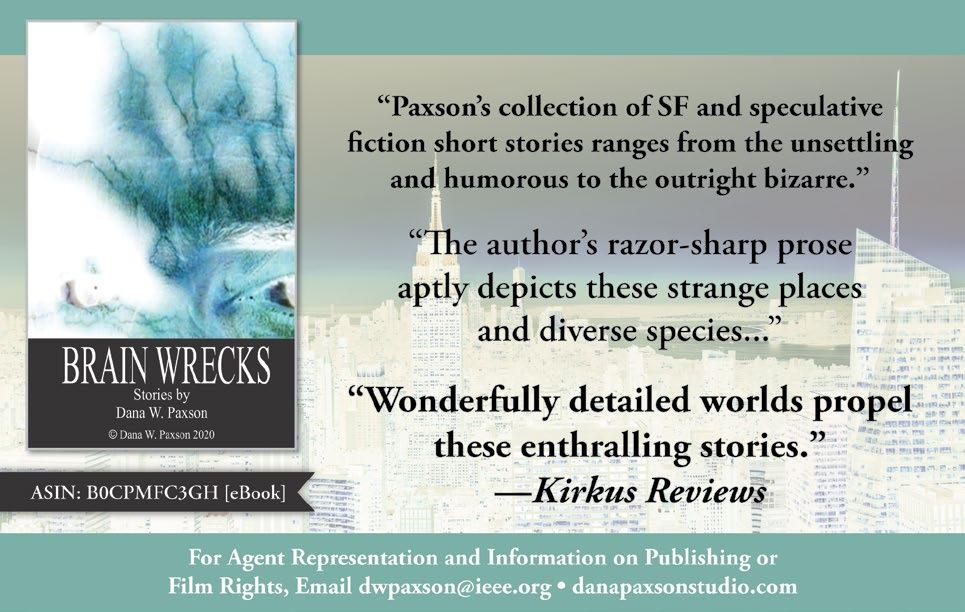

5 Books You Never Want to End
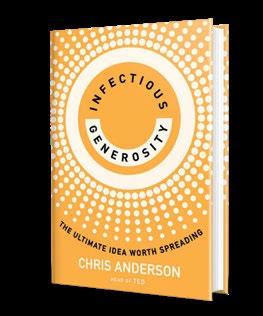
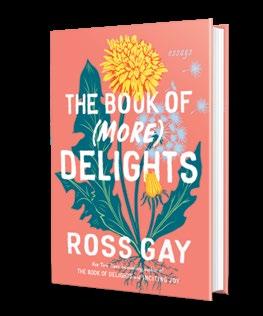 By Ross Gay
By Ross Gay
 By Chris Anderson
By Chris Anderson
4
By Amy Kurzweil

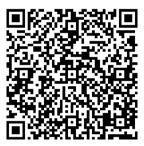

BOOKLIST // NONFICTION
4
For more books you never want to end, visit Kirkus online.
of (More) Delights
1 The Book
observed and delivered with deftness, these essays are a testament to the artfulness of attention and everyday joy.
Keenly
Generosity
2 Infectious
joyful road map away from a polarized, selfish society to the hopeful, humane place where we should be.
A
Upstairs Delicatessen
Dwight
wonderful mix of culinary memoir, literary reference, and how-to in indulgence. Grab some snacks and dig in.
3 The
By
Garner A
Artificial
reflections and powerful visual elements combine in an exemplary work of graphic nonfiction.
Intimate
Last Island
Adam Goodheart
thrilling book that will leave you contemplating the concept of civilization. 1 2 3 5 MARCH 1, 2024 83 KIRKUS REVIEWS
5 The
By
A
Immigration and Customs Enforcement culminated in Trump’s inhumane family separation policy, as well as the increased moral panic about the threats represented by immigrants. Shah argues persuasively that this panic also led to increased prosecutions and detentions, especially for people coming from Central America. She further notes that some entities— most notably, private prisons—have profited handsomely from immigrant detention. As long as the demand for detention exists, so does the “need” to build more facilities, a situation Shah believes can only be ended by grassroots activism. At the same time, however, heightened awareness of police brutality brought about by the Black Lives Matter movement has helped spotlight how police and ICE collaborations have created dangerous situations for those immigrants made even more vulnerable by virtue of sex or gender identification. Shah’s intersectional approach to the immigrant justice struggle will interest those interested in immigration reform as well as individuals working on behalf of any marginalized community disproportionately affected by the current carceral system.
Informative reading for activists and policymakers.
Kirkus Star
Free Love: The Story of a Great American Scandal
Shaplen, Robert | McNally Editions (288 pp.) $18.00 paper | April 16, 2024 | 9781946022912
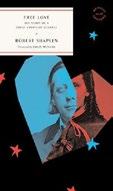
A fascinating account by a “far-flung correspondent” follows every nuance of the Henry Ward
Beecher adultery scandal of 1870.
Initially serialized in the New Yorker, Shaplen’s work was published in 1954. As Louis Menand notes in the preface to this edition, “this was a custom at [William]
Shawn’s New Yorker highly attractive to writers: they sold their work twice, first to the magazine, then to a publisher. And stylistically, the book is very much old-New-Yorker,” the editors of which “believed in letting the facts speak for themselves.” Shaplen delves intriguingly into the era of a swiftly changing, new-money, reform-minded New York City. Beecher, son of the fiery Presbyterian preacher Lyman Beecher and brother of author Harriet Beecher Stowe, had been the wildly successful reverend at the Plymouth Church in Brooklyn Heights for almost three decades when impassioned parishioner Elizabeth Tilton confessed to her husband, Theodore, that they had been having an affair. Theodore, the editor of the religious publication the Independent , also adored Beecher, and owed him his job. Furthermore, Lucy Maria, Independent owner Henry C. Bowen’s wife, made a similar confession about Beecher to her husband on her deathbed in 1862. Both husbands tried to bury the scandals, but the entanglements of these relationships became so intense that each player would end up incriminated, through confessions and letters, so that the wider public was sure to catch wind of the scandal, as when “radical spiritualist” Victoria Woodhull got involved. Shaplen’s account of Beecher and his “Gospel of Love” is a wonderfully spirited portrait of this “powerful symbol of the times.” As he recounts, the ensuing trials highlighted “the contemporary debate over private versus public conduct, the function of the evangelical church, and the place of women in the expanding social scene.”
An utterly engaging historical excavation of a passion play both farcical and resounding.

The Book-Makers: A History of the Book in Eighteen Lives
Smyth, Adam | Basic Books (400 pp.) $30.00 | May 28, 2024 | 9781541605640
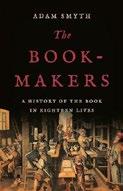
Fascinating stories about books and the people who made them.
Smyth, a professor of English literature and history, nimbly traverses more than five centuries as he illuminates some influential men and women in the bookmaking trade. The author begins in 1490s London with the savvy Dutchman Wynkyn de Worde, who published more than 800 titles, roughly 15% of “the entire known printed output in England before 1550.” Smyth explores the meticulous and demanding art of bookbinding via William Wildgoose and his work on Shakespeare’s First Folio, sold off by the Bodleian Library after the Third was published. Throughout this interesting narrative, Smyth drops countless bookish tidbits—e.g., in 1634, two sisters cut up Bibles and glued pieces into a large collage, Gospel Harmony, which told the chronological story of Christ’s life. The author also examines typography and its unique language, focusing on the 18th-century work of John Baskerville and the lesser-known Sarah Eaves, who married him and “released his imagination.” After an inky visit to the “colonial autodidact” Benjamin Franklin, who read books as he printed them, Smyth turns to paper and the man who revolutionized paper making with his “continuous paper” machine in 1798 (sadly, he was never financially rewarded). Readers will also learn about the popular art of “extra-illustration,” radical book modification akin to Gospel Harmony. In 1860, the “Smaug-like” Mudie’s circulating library, with its rented books, “revolutionised reading”—but you couldn’t check out George Moore’s
KIRKUS REVIEWS 84 MARCH 1, 2024 NONFICTION
For more from Louis Menand, visit Kirkus online.
scandalous A Modern Lover. At William Morris’ Kelmscott Press (founded in 1891), limited-edition books were works of art. The controversial, exotic Nancy Cunard published Beckett’s first poem in 1930 at her Hours Press amid a flowering of small presses, including Virginia and Leonard Woolf’s Hogarth Press. Smyth closes with zines, DIY publishing, boxed sets, and artists’ books.
Bibliophiles will savor this sprightly walk down the book’s memory lane.
Home and Alone
Stern, Daniel | Viva Editions (300 pp.) $23.95 paper | May 21, 2024 | 9781632280930

The actor discusses his career on the stage and in film, and his life focusing on the value of art and public service.
Now 66, Stern, perhaps best known for his roles in Home Alone and City Slickers, is no longer “the precocious teenager who moved to New York as a seventeen-year-old, at least ten years younger than all of my friends, the youngest dad at all my kids’ school events.” As he discusses his childhood in Maryland, his introduction to the theater, and writing a musical version of Lord of the Flies, the author’s love of the work shows through on every page—as does his family’s legacy of a strong work ethic (his mother told him, “I don’t care what you do but you are out of this house when you turn eighteen”). Realizing that “academics were not going to get me anywhere,” he committed to acting. After some early stage work, he began working in films, appearing in a number of critically successful projects in the late 1970s and early ’80s, including Breaking Away and Diner. Stern analyzes key moments in the development of his craft, as well as the twists and turns of a very public life, which included work with the USO and the experience of
being sued for $25 million over a TV show. Although readers may pick up the book to learn more about Hollywood, his focus on his work-life balance brings some of the most memorable passages, from his narration and directing work in the TV series The Wonder Years (which included no on-screen billing), which helped him overcome his childhood dyslexia, to his experience working with the Boys & Girls Club and his lifelong focus on public service. A fascinating and funny look at the life of a famous actor who found further fulfillment through giving back.
The Devil’s Best Trick: How the Face of Evil Disappeared
Sullivan, Randall | Atlantic Monthly (432 pp.) $30.00 | May 14, 2024 | 9780802119131

An investigation of evil and how it manifests in our society.
As an acclaimed journalist, Sullivan, author of Graveyard of the Pacific, Dead Wrong, and other books, thought of himself as a man of reason and intelligence, with a good dose of cynicism. Then, when covering the wars that tore apart Yugoslavia, he confronted too many atrocities to believe that nothing was behind them. The author sensed the presence of evil and began to research the origin of it, which led him to the fundamental figure of malignity. While researching the book, Sullivan brushed against inexplicable, personal incidents—e.g., a weird threat from a well-dressed stranger, an ominous letter in his mailbox, the dream image of a black dog. The author shows how Christianity gave the Devil a personification, a central role, and a name. Sullivan looks at the theologians who wrestled with the conflict between the persistence of evil and the presence of an omnipotent God, finding that none of them reached a satisfying conclusion. He also studies a number of serial killers and murders,
as well as accounts of a carefully documented, nightmarish exorcism that lasted four months in Iowa in 1928. Yet somehow, writes Sullivan, the Devil has been able to convince everyone that he does not exist, so is “able to hide in plain sight because of the cover we all give him with our fear, our denial, our rationalization, [and] our deluded sense of enlightenment.” The author believes t hat the Devil is real, but, he adds, each of us is responsible for our own decisions. This is not an easy book to read, and some parts are profoundly disturbing. Sullivan offers crucial insights, but timid readers should think carefully before entering its dark labyrinth. A compelling journey into the heart of darkness with an articulate, capable guide.
Kirkus Star
Double Exposure: Resurveying the West With Timothy O’Sullivan, America’s Most Mysterious War Photographer
Sullivan, Robert | Farrar, Straus and Giroux (448 pp.) | $32.00 | April 23, 2024 9780374151164
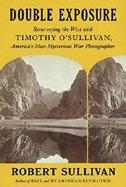
A fascinating account of a crucial photographer of westward expansion and a reckoning with the colonization of the American West.
Timothy O’Sullivan
(1840-1882) was a legendary photographer of the Civil War who also traveled across the West on several surveys as the expedition photographer. The resulting images, many included in this book, are haunting. They portray stark landscapes, mining, and the colonization of the West at a time when violence and desperation were high: “The West— where citizenship was disputed, where sovereignty was devalued or ignored— would become a battle site, and not just with guns but with miners and dams,
MARCH 1, 2024 85 KIRKUS REVIEWS NONFICTION
with vigilantes and nativists, with ranches and land grabs made by Congress-backed corporations.”
O’Sullivan’s photos document a time when Indigenous land rights were trampled, treaties ignored, and white settlers scrambled to survive. It’s a fascinating and essential era in American history, a period that historian Richard Maxwell Brown has called the “Western Civil War of Incorporation.” Sullivan chronicles his visits to several key locations in O’Sullivan’s photos, exploring the violence wrought on the landscape and people. These sites include Death Valley, where O’Sullivan developed photos in a mule-drawn ambulance he converted into a darkroom; Panama, where he photographed the dense jungle before the construction of the canal; and various mines, where he took the first known underground photo, risking the flare of magnesium to do so. Sullivan’s research is meticulous and his storytelling engaging. O’Sullivan is an intriguing figure, but what is most fascinating is the author’s examination of westward expansion as a kind of war of both arms and ideas. The photos, writes the author, allow us “to reframe not just the American landscape but the stories we tell ourselves about America, the things we believe and feel.”
A riveting, highly valuable reexamination of the West, compelling to anyone interested in its history.
My Presidential Life: The Showdown at Putin’s Dacha and Other Misadventures on the Diplomatic Road
Swift, Judd | Lyons Press (256 pp.) | $29.95 May 7, 2024 | 9781493081486
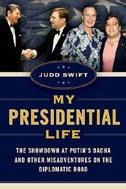
Advance work for presidents is always demanding but never dull, and Swift describes it all in this colorful account.
To make summit meetings or presidential
speeches happen, there has to be a massive supporting architecture of secret machinery. It’s only noticeable if something goes awry, and people like Swift ensure that it doesn’t. The author worked on advance teams for Reagan and both Bushes, combining the skills of juggler, logistics expert, and firefighter. “There is simply too much to be done in too little time,” he writes. It was up to him and his team “to bring some semblance of order to chaos that looked good on the planners’ charts but was in reality an invitation to worldwide embarrassment if anything went wrong.” Swift started as an organizer for George H.W. Bush in his failed 1980 campaign and continued working for him when Bush became vice president, after which he made the transition to Reagan’s team. The author recounts a wealth of interesting behind-the-scenes stories about mayhem that was transformed into smooth success at the last moment, despite pompous local officials, terrorist threats, and even overenthusiastic crowds. Security concerns and bugged hotel rooms were always a challenge, but even the details of the president’s attire had to be checked and rechecked, as journalists are always looking for anything that could be given a negative spin. Swift points out that the presidents were usually easygoing and appreciative of the work of the advance team, although some of the people around them displayed the arrogance that can come with life in the upper echelons of politics. Refreshingly, the author narrates his intriguing career without rancor or self-aggrandizement, providing an entertaining read about what happens behind the curtain. Swift has tales to tell and secrets to spill, and he does it with aplomb and humor.

Little Seed
Tchou, Wei | A Strange Object (150 pp.)
$18.95 paper | May 14, 2024 | 9781646053360

A psyche untangling itself from family lore. In a tense moment in this debut memoir, Tchou describes how she suspected her older brother was having a psychotic break while she was showing him her Times Square office. Not knowing what to do, she played along with his delusions. When the author shared her worries with her mother, she chided her “for being sensitive.” This is how it goes in Tchou’s family. The author grew up in a small Chinese American household, “the baby,” the only girl, the only one with no personal memories of China. Instead of memories, she has inherited stories—of what it means to be a daughter or to be Chinese—and a longing to gain approval by upholding the familial truths. Resisting family stories has always felt dangerous, as though love were contingent on loyalty. Tchou is at her best when she keeps us close to her family dynamics, even as she pauses, achingly and beautifully, to contemplate who she is and who she wants to be: “Though my entire life had been fashioned from overlapping stories, the wild, true thing that animated them had remained unknown to me. I was starting to feel it move under my hands, and though it terrified me, I knew that it wouldn’t go away.” Then there are the ferns: The author delivers long passages about spores, fiddleheads, identification, and classification, creating a book that is admittedly “half fern and half family.” Belonging, guidance, a coherent worldview—Tchou passionately seeks all of these. With ferns, however, she can luxuriate in just “liking,” which “doesn’t contain the desperation of wanting or the cost of a need.” Liking something involves “no stake in what it means about me,” just “my imagination bursting forth.”
An intriguing, occasionally uneven family memoir grafted to a cultural history of ferns.
KIRKUS REVIEWS 86 MARCH 1, 2024 NONFICTION
To read the review of a biography of George H.W. Bush, visit Kirkus online.
A Faith of Many Rooms: Inhabiting a More Spacious Christianity
Thomas, Debie | Broadleaf Books (184 pp.)
$23.99 | March 19, 2024 | 9781506481456

A memoir and argument for a more inclusive version of Christianity. Thomas explores her experiences as the daughter of Indian immigrants, growing up as an evangelical Christian in a community largely separate from the broader American culture. She also delves into her own faith journey from evangelicalism to progressive, mainline Christianity. The author’s family belongs to an ancient Christian tradition that can be traced to the first century C.E. and to the missionary efforts of the Apostle Thomas. However, her family’s own particular brand of Christianity was also influenced by 20th-century evangelicals. Thomas spent her youth immersed in a faith life that exacerbated her senses of shame and low self-worth. Growing up a cultural Indian in the U.S. also made her youth difficult to navigate, as she felt like an outsider in her own land. As Thomas matured, her views became more progressive and she found herself at odds with the faith of her family and childhood. However, she notes that she found room in the Christian tradition for her own, burgeoning faith direction. It was not an easy transition. “When I left evangelicalism,” she notes, “I felt like I was entering a wilderness in the darkest hours of the night.…The terror was ominous and total; all I felt was dread.” In time, however, she found faith in a Christianity less defined by belief systems than by a generous view of both sin (incorporating social issues more than mere rule following) and salvation (a possible healing for humanity as a whole). “A roomier understanding of sin requires an equally roomy vision of salvation,” she writes. Through a Christianity rooted in unrestrained readings of scripture and open to moral
and ethical paradoxes, Thomas discovered a way to retain her faith and reaffirm her identity.
A solid defense of modern, progressive Christianity from a unique perspective.
Paradise of the Damned: The True Story of an Obsessive Quest for El Dorado, the Legendary City of Gold
Thomson, Keith | Little, Brown (400 pp.) $32.50 | May 21, 2024 | 9780316497008

An account of a famous explorer’s quixotic quest for an infamous “golden city.”
The lure of gold has driven many men crazy, never more so than in connection with the quest for El Dorado, the legendary Incan city that many believed was literally constructed from the precious metal. The Spanish launched scores of expeditions to find it as part of their conquest of the New World. Thomson, author of Born To Be Hanged, chronicles the less-well-known efforts of the British, led by Sir Walter Raleigh (1552-1618). He was a junior court figure who won attention by laying his cloak down so Queen Elizabeth could cross a muddy puddle. He parlayed this chivalrous act into a fleet of ships, which he took to South America (although he was supposed to go to Virginia), with the aim of searching for the golden city. Readers will be unsurprised that the jungle adventure was plagued by crocodiles, snakes, mosquitos, vampire bats, and mutterings of mutiny; Raleigh was forced to turn back and return to England. However, he fell victim to the labyrinthine intrigues of the royal court and landed in prison, charged with treason. He ultimately lost his head. Though El Dorado has been a fascinating topic for centuries, it has already been covered in numerous books about Raleigh and the Age of Exploration, and Thomson adds only moderately to the
historical record. The section at the heart of the book—Raleigh’s search for El Dorado—is a mildly interesting account of a meandering, misguided failure. Ultimately, this book may interest aficionados of this period of history, as well as those unfamiliar with the life of Raleigh, but others will not find much that is worth the effort. A middling exploration of the turbulent life of Walter Raleigh, including his futile search for gold.
Tits Up: What Sex Workers, Milk Bankers, Plastic Surgeons, Bra Designers, and Witches Tell Us About Breasts
Thornton, Sarah | Norton (320 pp.) | $28.99 May 7, 2024 | 9780393881028

A respected sociologist delves into the story of the breast and finds complex layers of meaning. Thornton, author of Seven Days in the Art World and 33 Artists in 3 Acts, calls her breasts Bert and Ernie. They are not the original models but prosthetic constructions, which she acquired after a double mastectomy to preempt likely cancer. Her complicated relationship with her new body parts set her on an exploration of the social meaning of breasts. In her latest book, she seeks “to shift the definition of breasts away from the dominant patriarchal version of them as passive erotic playthings.” Thornton chronicles her interviews with a diverse selection of interesting people, including strippers, women who contribute to milk banks, and cosmetic surgeons, who suggest that the bigger-is-better era might be passing. There are intriguing perspectives from bra designers (they prefer the term “bra engineers”), who see themselves as playing a crucial role in breast care and female identity. Some feminists are wary that a focus on breasts might reduce women to their sexualized, biological functions, but Thornton decides that there is more to it
MARCH 1, 2024 87 KIRKUS REVIEWS NONFICTION
than that, showing how plenty of women see their breasts as opportunities for self-expression and body positivity. Part of this stems from her meeting with women who identify as modern-day witches and who are intent on loudly celebrating their breasts as their connection to primal forces. Thornton can see their point, but she concludes that this is not for everyone. Perhaps “thoughtful appreciation” of their breasts is a better outcome for many women. In any case, Thornton comes to accept Bert and Ernie as part of her life, creating a suitable ending to a story told with insight, wit, and self-awareness. With intelligence and humor, Thornton examines how breasts can help women create new visions of themselves.
Dogland: Passion, Glory, and Lots of Slobber at the Westminster Dog Show
Tomlinson, Tommy | Avid Reader Press (288 pp.) | $28.00 | April 23, 2024 9781982149321

Are show dogs happy? Are regular dogs happy? A dog lover examines these and other questions.
In this follow-up to The Elephant in the Room , Tomlinson, the host of NPR’s SouthBound podcast, delivers an easygoing look at dog show culture, which he calls “Dogland” and its denizens call “the fancy.” Along the way, he includes tidbits of dog-related research, various “top fives”—e.g., Cartoon Dogs, Advertising Dogs, Dog Haters—and a section devoted to the saga of his own dear lab mutt, Fred. While some of the fun facts are well known (the breathing problems of French bulldogs), others are fresh, and all are presented in Tomlinson’s disarming and humorous style. For example, writing about a politician in Argentina who cloned his late mastiff, he notes, “The weird part is that Milei considers the mastiffs to be
his political advisers, via a mystic who serves as a go-between....If you think this in any way disqualifies him from office, welcome back to Earth from wherever you have spent the past few years. In November 2023, Milei was elected president of Argentina.” One of the main narrative threads concerns Striker, a beloved Samoyed who took honors at the Westminster Dog Show two years running and was profiled in the New York Times . Tomlinson illuminates the personalities and practices of the characters on the dog show circuit, particularly the relationship of Striker and his handler, Laura King, who travels with as many as 20 dogs in a motor home she calls Betty White. “I came to think of the whole scene as something like the eternal caravan of Deadheads,” he writes, “except fueled by boxed wine and Big Macs more than LSD and falafel.” Readers will want pictures, but images of Striker and his competition are easily found online. This book wants to lick your face. Let it.
Kingdom of Play: What Ball-Bouncing Octopuses, Belly-Flopping Monkeys, and Mud-Sliding Elephants Reveal About Life Itself
Toomey, David | Scribner (304 pp.) $29.00 | March 19, 2024 | 9781982154462
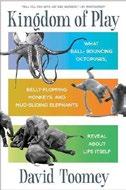
An appraisal of how and why certain animals play and how it correlates to biology on Earth. Toomey, author of Weird Life and Stormchasers , turns his inquisitive eye to the curious ways animal species entertain themselves. He examines a series of animals from across the globe, each with unique playtime routines that are both fascinating and scientifically reflective of the natural habitats, cultures, and neurochemistry of the animal kingdom at large. Among
the ethological research investigations Toomey explores is the anomaly of a young female octopus at the Seattle Aquarium thoroughly engaged with moving a small medicine bottle with her arms and water funnels; the “play fighting” of Kalahari meerkat pups; and the “chasing and wrestling” of Alaskan brown bears. The author postulates that the repetitive nature of these animals’ activities signals pleasurable distraction, a desire for excitement, and a playful form of social bonding, but ethologists can only hypothesize on this theory. Other scientists Toomey cites—e.g., Gordon Burghardt, author of The Genesis of Animal Play —have sought a general definition of “nonfunctional” voluntary animal play that could be applied to species that exhibited these behaviors but also to those animals incorrectly assumed to be incapable of play.
Elsewhere, Toomey spotlights studies scrutinizing the “curious porcine behavior” in Edinburgh, Scotland’s experimental Pig Park; the oddity of belly-flopping juvenile male monkeys at a Calgary zoo; and the puzzling evolution of play fighting behaviors among rats, which, one neuroscientist observed, has little to do with fighting at all but rather enhances social competency, reduces stress, and defuses potential conflicts. The author includes sections on animal sleep cycles, which prove equally intriguing. Closing each chapter, Toomey intelligently analyzes how particular aspects of animal play behavior also characterize Darwin’s theory of natural selection.
A lively, informative, and scientifically entertaining animal behavior study.

For more from David Toomey, visit Kirkus online.
KIRKUS REVIEWS 88 MARCH 1, 2024 NONFICTION
Kirkus Star
Out of the Darkness:
The Germans, 1942-2022
Trentmann, Frank | Knopf (800 pp.)
$50.00 | Feb. 20, 2024 | 9781524732912
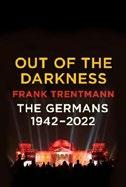
A magisterial history of Germany over the last 80 years. A shambles in 1945, Germany now dominates the European Union. Nearly 800 pages on how this happened may seem excessive, but Trentmann, author of Empire of Things and Free Trade Nation, handles his material with aplomb. He emphasizes that the Nazis enjoyed broad support, even among poor German citizens, which withered during the disastrous years after 1942. Some Germans objected to the persecution of Jews within Germany, and many learned from family members serving abroad that the Nazis were committing atrocities. Although the horror of Nazi mass murder stunned the Allies after 1945, Germans were preoccupied with their own problems, including homelessness, starvation, and millions of German refugees expelled from former provinces and Eastern Europe. In the aftermath of World War II, many Germans rejected collective guilt for the war’s destruction, and most were stunned when Konrad Adenauer (chancellor from 1949 to 1963) pushed through massive reparations to Israel and to Jewish refugees. This was effective for reestablishing Germany’s global standing but it also got the country “off the hook of paying reparations for the war itself.” In long, penetrating chapters, the author focuses more on people than politics, examining the economic miracle of the 1950s and ’60s, how younger Germans began confronting their parents’ hypocrisy, and the semidystopia of East Germany, whose collapse opened the way for the united nation’s economic dominance. The explanation that this resulted from German thrift, organization, and hard work does not survive Trentmann’s
gimlet eye. In a thoughtful epilogue, the author summarizes the decades of “moral and material regeneration” that produced a resilient people who have fended off recent crises, but he refuses to predict the outcome of other situations, including the disturbing rise in jingoistic, racist, and anti-democratic movements. Fascinating insights on how a country of poets, philosophers, and scientists emerged from totalitarianism and genocide.
Mothers of the Mind: The Remarkable Women Who Shaped Virginia Woolf, Agatha Christie and Sylvia Plath
Trethewey, Rachel | The History Press (368 pp.) | $36.99 | April 2, 2024 9781803991894
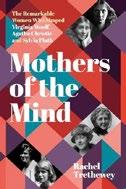
An examination of the mothers behind some of history’s most recognizable authors.
In three parts, Trethewey, author of The Churchill Sisters, takes a deep dive into the lives of the women who raised Virginia Woolf, Sylvia Plath, and Agatha Christie. Although all three have been written about in numerous works, this book shines a fresh light on how they were raised and how the women who raised them shaped their work. Trethewey begins with Julia Stephen, Wolff’s mother, pulling from unpublished first-person accounts and historical documents. In this section, the author focuses on themes involving how Julia’s beauty was a hindrance throughout her life; while she was a muse to many, she was ultimately unable to escape her own demons. Even though Julia lacked vanity, “Virginia believed there was a penalty for her mother’s beauty.…‘[I]t came too readily, came too completely. It stilled life— froze it.’ It made her seem aloof and untouchable.” In the section on Clara Miller, Christie’s mother, Trethewey
describes how Clara displayed a wide breadth of complex emotions and rich intelligence, as well as how Clara and Agatha’s relationship was quite different from Julia and Virginia’s relationship. “They adored each other and that unconditional love was the bedrock on which Agatha built her life,” she writes. Lastly, Trethewey delves into the tumultuous relationship between Aurelia and Sylvia Plath. “Reflecting the duality of her personality,” she writes, “there was a bond between mother and daughter as intense and loving as Agatha’s with Clara, but running alongside that version, in Sylvia’s mind there was an equally powerful relationship which was full of hatred and resentment.” Although each mother endured her fair share of challenges, they raised women who went on to change the course of literature. Trethewey provides an informative portrait of the similarities and differences among each of them. An insightful biographical portrait.
My Vietnam, Your Vietnam: A Father Flees. A Daughter Returns. A Dual Memoir.
Vo, Christina & Nghia M. Vo
Three Rooms Press (320 pp.) | $18.00 paper April 16, 2024 | 9781953103468
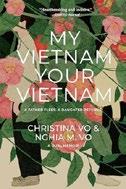
A generational tale of division, misunderstanding, and reconciliation.
Though some historians argue that the separation of North Vietnam and South Vietnam was born in the wake of World War II, that schism really goes back centuries, including the struggle for suzerainty between Trinh nobles in the north and the Nguyen aristocracy in the South. “The north was more disciplined and cautious,” writes the elder Vo, “while the south was more individualistic and entrepreneurial.” A southerner, he became a doctor and was drafted into the military. With the fall of the Saigon government in
MARCH 1, 2024 89 KIRKUS REVIEWS NONFICTION
An illuminating, deeply researched study of roots music.
JELLY ROLL BLUES
1975, he became a refugee and fled to the U.S., where he had to start life anew and hide the old one away. His daughter, for her part, grew up Americanized and not quite sure what to make of her parents, especially her father and the “boiling depths beneath his quiet disposition.” Long periods of living in Hanoi, learning the (albeit northern) culture on her own terms, gave her greater understanding of both her father and herself, a narrative trope that is the stuff of the classic first- and second-generation immigrant narrative—this book combines the fraught tension of Ava Chin’s Mott Street and the tenderness of Elliot Tiber’s Taking Woodstock. The younger Vo’s experiences include the death of her mother and long absences away from home, during which her father, too, took some of that boiling anger and became an effective advocate for the Vietnamese community. In alternating narratives, father and daughter sometimes speak past each other, but eventually their stories work toward accommodation. Over decades of mutual incomprehension, the younger Vo in particular has come to an understanding: “Our father-daughter relationship embodies the duality of Vietnam—we are separated by a divide, and yet somehow, we are still one.”
A nuanced contribution to the literature of the Vietnamese diaspora.

Kirkus Star
Jelly Roll Blues: Censored Songs & Hidden Histories
Wald, Elijah | Hachette (352 pp.) | $30.00 April 2, 2024 | 9780306831409
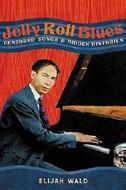
A pleasing—and often pleasingly salacious—stroll through the annals of American popular music. “If you don’t leave my fucking man alone…I’ll cut your throat and drink your fucking blood like wine.” So runs a tune by Jelly Roll Morton (1890-1941), whose name contains a slang term for female genitalia. As music historian Wald, author of Dylan Goes Electric! and Escaping the Delta, notes, sexual terms abound in many distinctly American forms of music—even the word jazz itself, as Sidney Bechet, a ragtime musician, explained: “It used to be spelled Jass, which was screwing.”
Taking Greil Marcus’ “old, weird America” several levels weirder, Wald evokes a world of barrelhouse piano and honky-tonks that would make the denizens of a Weimar cabaret blush, one in which musicians hesitated to make public the true names of the songs they played and where even the ballad “The Old Chisholm Trail” contained “1042 verses…of which 1040 weren’t fit to print.” Wald prints even the most unfit passages and traces popular ballads far beyond the points of origin delineated by scholars and song-chasers such as Alan Lomax. One case in point is a song that would eventually become known as “Winding Ball,” its prurient lyrics circulated in near-samizdat format until
the 1960s, even as a scholarly publication noted of those words that “most collectors know but do not print [them].” Along the way, Wald astutely analyzes the intermingling of ethnicity, gender, and social class that shaped popular music, pointing out that much scholarship ignores the fact that Black audiences “danced square dances and waltzes and sang ‘She’ll Be Coming Round the Mountain’ and ‘Danny Boy,’” even as white audiences gladly adopted music born of “the raw speech of saloons, work gangs, and prison.” An illuminating, deeply researched study of roots music, decidedly not suitable for work.
A Good Bad Boy: Luke Perry and How a Generation Grew Up
Wappler, Margaret | Simon & Schuster (336 pp.) | $28.99 | March 5, 2024 9781668006269
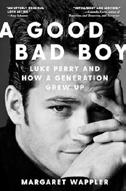
A devoted fan honors a famed actor. Wappler pays homage to actor Luke Perry (1966-2019), who played the role of Dylan McKay in Beverly Hills, 90210. Melding biography and memoir, she interweaves a recounting of Perry’s life and career with the events of her own life, including her enthrallment with the show that made Perry famous. For the young author, Dylan was “the platonic ideal of the sensitive man hiding his wounds behind a shield of cool.” Perry almost didn’t get the role. He had acted only in a few soap operas, and his audition didn’t wow Fox executives, but producer Aaron Spelling believed in him so much that he offered to pay his salary out of his own pocket. Spelling turned out to be right; Perry was an instant heartthrob. The show debuted in the fall of 1990, up against Cheers. By 1992, 69% of American teenage girls watched it; the next year, it expanded to 30 countries. In 2001, though, rebelling at being typecast, Perry joined the cast of
KIRKUS REVIEWS 90 MARCH 1, 2024 NONFICTION
For more from Elijah Wald, visit Kirkus online.
Oz , set in a prison ward inside a fake penitentiary. He saw the role, Wappler writes, as “an incredible opportunity to change what audiences had grown to expect from him.” For the author, growing up in the 1990s, Beverly Hills served as an escape from teenage angst and from grief over her father’s death from cancer. Her memoir, related in the third person, recalls tumult and loss, aspirations and pain: She marries and divorces, spends a few years in psychotherapy, becomes a successful journalist of pop culture, and marries again. Her newborn son is asleep when she learns of Perry’s death from a stroke. Although none of Perry’s immediate family agreed to participate in this biography, Wappler conducted interviews and mined sources to create a sensitive portrait of a kind and caring man.
A gift for Perry and 90210 fans.
Our Kindred Creatures: How Americans Came To Feel the Way They Do About Animals
Wasik, Bill & Monica Murphy
Knopf (464 pp.) | $35.00
April 23, 2024 | 9780525659068
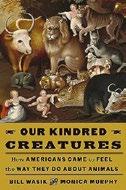
The authors of Rabid return with an examination of the historical shift in attitudes of Americans toward animals.
Wasik, editorial director of the New York Times Magazine, and Murphy, a veterinarian, focus on the mid to late 1800s, when “America was collectively waking up to animal suffering….It was as if, in the span of little more than a decade, animals had gone from being seen as objects, mere things that humans were justified in treating however they might like, to being creatures whose joys and sufferings had to be taken into consideration.” However, this social movement did not occur without resistance. Horses carrying heavy loads down increasingly busy streets were frequently treated cruelly,
dogfighting was a common form of entertainment, and live rabbits were used by medical schools for demonstrations. This era also saw the rapid decrease in the bison population as white settlers expanded into the frontier, and countless American birds were “being slaughtered wholesale for the cause of fashion.” Wasik and Murphy explore all of these topics compassionately. Central to the discussion is Henry Bergh, who founded the American Society for the Prevention of Cruelty to Animals in 1866. The authors describe the “unexpected” and sometimes contentious relationship between Bergh and showman P.T. Barnum, and they report how the “grim, poorly ventilated” slaughterhouses in Chicago were initially met by the public with “a strange sort of fascination.” Wasik and Murphy share the contributions of other activists that “propelled the anti-cruelty cause forward,” including Philadelphian Caroline Earle White and Bostonian Emily Appleton, who were successful in establishing local chapters of the ASPCA, and George T. Angell, editor of Our Dumb Animals, an unusually named publication that ran for more than 80 years, advocating for their humane treatment. A well-researched account that strikes a nice balance between description and analysis.
Mothership: A Memoir of Wonder and Crisis
Wrenn, Greg | Regalo Press (272 pp.) | $18.99 paper March 26, 2024 | 9798888452141

lecture hall full of silent, disengaged undergraduates. Wrenn describes how he stood in front of the room in full scuba gear, yearning to bestow a sense of wonder for nature and the perils of climate change. The effort fell flat, but readers will appreciate the enthusiasm that pervades the text. The author dissects three periods of his life and journey of healing from the physical abuse he experienced as a child to the verbal abuse he continued to endure.
During his travels, Wrenn investigated the healing properties that nature provides, and he recounts the many ayahuasca ceremonies in which “The Door” to his trauma was opened, fully exposing him to the pain but also the eventual forgiveness of those who had harmed him.
Wrenn turns to the healing properties of nature in search of a cure for his complex PTSD.
The author, a professor of environmental literature and creative writing at James Madison University, opens with a scene of a
Taking readers along on his fascinating journey, the author emphasizes the interconnectivity of the self and Mother Earth, drawing connections between his own C-PTSD and the complex being that humans are actively destroying with our “gimmegimme, carbon-belching society.” He continues, “Whether we’re talking about abusers and victims—or people and the planet—it’s all part of what’s known as our extraction mindset: Pretend the interconnectedness of all beings is woke hogwash. That there will be no consequences for your crimes. Do what feels good, take what you want, and get out.” Wrenn paints a vivid image of a dying planet at the hands of humans—not as an issue of tomorrow, but as the current consequence of our daily actions and inactions, a form of trauma all its own. A memorable book that capably interweaves the personal and the universal.

To read our review of Rabid, visit Kirkus online. MARCH 1, 2024 91 KIRKUS REVIEWS NONFICTION
Children's

RAMADAN KAREEM AND EID MUBARAK!
THIS YEAR, Sunday, March 10 marks the beginning of Ramadan, followed by Eid al-Fitr. I’m pleased to see so many new picture books exploring different facets of these holidays: children’s pride in fasting for the first time; families coming together for iftar, the meal Muslims eat at sundown to break their daily fasts; the sighting of the crescent moon, which heralds the beginning and end of Ramadan; and the joy of celebrating Eid. The number of Ramadan and Eid titles only seems to be increasing each year—a trend I hope continues. Muslim children need to see their experiences reflected, while non-Muslims should be aware of the significance of these holidays, observed by nearly two billion people all over the world.
Marzieh A. Ali’s A Ramadan To Remember (Soaring Kite Books, Jan. 1) finds young Zain dealing with complicated emotions. He’s thrilled that Ramadan is nearly here, but things are different this year. His family has moved to a new neighborhood, where few people know
about—much less celebrate— Ramadan. But Zain is heartened when he finally meets another young Muslim; he also finds that his non-Muslim neighbors are eager to share in his traditions. Najwa Awatiff’s sunny illustrations bring to life Zain’s supportive community, while Ali’s narrative highlights key aspects of Ramadan.
Adam, the protagonist of Sahtinay Abaza’s The Ramadan Drummer (Reycraft Books, Jan. 16), is fasting, and all he can think about is food. But that changes after he dreams of the Ramadan Drummer, who, according to his mother and aunt, used to awaken everyone each morning before sunrise so they could eat their last meal before the fast began. As he and the old, bearded drummer walk the streets, Adam hears whispers from people in the surrounding houses, many lonely or in need—and he realizes that doing good deeds is what Ramadan is truly about. Dinara Mirtalipova’s sumptuous illustrations soar during the nighttime sequences, the whispers
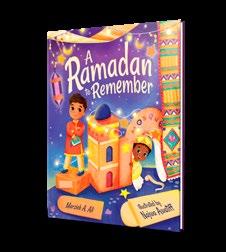


swirling into the air. Though the setting is unspecified, the backmatter mentions some countries where the tradition was once common.
“Ramadan is here! / Hooray!” Excitement pervades M.O. Yuksel’s Ramadan Kareem (Harper/ HarperCollins, Feb. 20) from the very first pages. All over the world, little ones and their families wake early for suhoor, pray together, purchase foods for iftar, and, as Ramadan ends, come together to celebrate Eid. Yuksel’s jaunty verse focuses on sensory experiences—the texture of a Quran, the aroma of kofta—that will speak to young readers, while Hatem Aly’s bustling illustrations are rife with culturally specific details.

As Ramadan draws to a close, the protagonist of Noura’s Crescent Moon (April 16, Candlewick) by Zainab Khan is filled with pride: This was her first time fasting. What better way to cap it off than by spotting the crescent moon that marks the start of Eid? Noura, her parents, and others gather on top of a high hill to look for the moon, and though her parents warn her that spotting the moon is a rare occurrence, her hopes are high. Nabila Adani’s lavish illustrations capture the deep pinks and purples of sunset, as well as the warm sense of community at the heart of this holiday.
Mahnaz Dar is a young readers’ editor.
Illustration by Eric Scott Anderson
MAHNAZ DAR
KIRKUS REVIEWS 92 MARCH 1, 2024
EDITOR’S PICK
A writer and artist navigates her Thai and American heritage.
Opening in the mid1990s, when MacLeod was 11, this graphic memoir traces her emotional and physical journeys of searching for connection and belonging while making sense of her blended family and her bicultural luk khrueng (“half child” in Thai) identity. Despite having a Thai mother and growing up in Bangkok, Kathy, who attends an international school where you’re not allowed to speak Thai, feels like she lives in an “American bubble.” She counts down the days until her family’s annual trip to coastal Maine,
where clam chowder, lighthouses, blueberries, and the relatives on her dad’s side await. Once stateside, however, Kathy’s self-conscious feelings of being different return, and she finds herself balancing hypervisibility with wanting to be “just invisible enough.” Her constant negotiations between places and perspectives will be familiar to anyone who’s experienced feelings of isolation, highlighting the story’s core lesson that the path to finding oneself is full of obstacles, and the key is to explore—even embrace—each and every element of one’s own identity. Just as both her mom’s curry and her aunt

Continental Drifter
MacLeod, Kathy | First Second | 224 pp.
$22.99 | $14.99 paper | April 2, 2024
9781250813732 | 9781250813749 paper
Barbie’s strawberry shortcake taste like home, Kathy learns that each dimension of her personal and cultural background offers much on its own without overshadowing other parts. The simple yet expressive art style is
charming and at times poignant, showing the family dynamics and the secrets locked within people’s hearts. A heartfelt story honestly and evocatively told. (afterword, photos) (Graphic memoir. 8-12)
94
96
102
93
120
104
I’ll
97 The Spaceman
116
127
Marley’s Pride
130
Being Home
135
136
137
132
The Noisy Puddle
127
Earned the
These Titles
Kirkus Star
Águila; illus. by Magdalena
Barrio Rising By María Dolores
Mora
Race of Magical Beasts
illus. by Tim
The Glorious
By Alex Bell;
McDonagh
By Randy Cecil
Performance at Milkweed Meadow
Elaine Dimopoulos; illus. by Doug Salati
The Perilous
By
See You in Ijebu
Emenanjo; illus. by Diana Ejaita
By Bunmi
Perfect Shapes By
illus. by Yifan Wu
Mr. Pei’s
Julie Leung;
By
Continental Drifter
Kathy MacLeod
Newman; illus. by Susan Gal
Joyful Song By Lesléa
Nguyen; illus. by Minnie Phan
120 Simone By Viet Thanh
Heatwave By Lauren Redniss
By
by
Joëlle Retener; illus.
DeAnn Wiley
By Traci Sorell; illus. by Michaela
Goade
By Linda
Sweeney; illus. by Miki Sato
Booth
Finding Grateful By Dianne White; illus. by Faith Pray
Paige Not Found By Jen Wilde
Bird Rehearsal By Jonah Winter; illus. by Stacy Innerst
KIRKUS REVIEWS CHILDREN'S MARCH 1, 2024 93
Way Past Mean
Adelman, Hallee | Illus. by Karen Wall Whitman (32 pp.) | $18.99
April 4, 2024 | 9780807580219
Series: Great Big Feelings, 9
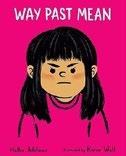
Why is everyone being so mean to the new girl?
Ruby is having fun with Nelly, the new girl at school, when Keya and Yaz invite Ruby to play. The note they slide over to Ruby reads, “Let’s play after school without Nelly.” Keya and Yaz are popular, so Ruby feels flattered. Still, Ruby’s uncomfortable when the other two start mocking Nelly’s shirt. Later, the three of them walk home, trading mean barbs about Nelly (“Do you think Nelly brushes her teeth?” “NO!” “Do you think Nelly has stinky feet?” “YES!”). It’s not until Nelly finds out what’s been going on that Ruby realizes they’ve gone too far and tries to make amends. This sweet but somewhat preachy tale has a clear message about the importance of kindness and comes to a happy if somewhat pedestrian ending; it turns out that Keya instigated the bullying because she thought that Nelly had rejected her at a party. Though these elements may make for a good teaching tool, they diminish the power of the story, which feels a bit reductive. Still, young children experiencing bullying may take solace in seeing the problem wrapped up so neatly and will relate to Ruby’s confusion and goodwill alike. In Wall’s brightly colored artwork, Ruby and Yaz are brown-skinned, while Keya and Nelly have paper-white skin. A solid, if somewhat heavy-handed, lesson in friendship and staying true to oneself. (Picture book. 3-6)

A solid, if somewhat heavy- handed, lesson in friendship and staying true to oneself.
WAY PAST MEAN
For more in the Great Big Feelings series, visit Kirkus online.
Kirkus Star
Barrio Rising: The Protest That Built Chicano Park
Águila, María Dolores | Illus. by Magdalena Mora Dial Books (40 pp.) | $18.99 | June 18, 2024 9780593462072

A blossoming young activist joins her neighbors in the fight to build Chicano Park in Águila and Mora’s celebratory tribute to San Diego’s Chicane community.
On her way to the tiendita with her Mami, Elena walks through the streets of Barrio Logan, her home neighborhood by the bay. The impacts of industrialization on Barrio Logan are evident throughout their journey: pollution from a diesel truck, the colossal frame of the Coronado Bridge, and the “roar of cars racing on the freeways.”
Under the bridge, bulldozers sit, a promise of a park within reach. But soon, news of the city’s intent to build a police station instead of a park in the Chicane neighborhood spurs Elena and her community to action. Charged with soft purples, vivid greens, and bold reds, Mora’s lush digitally colored charcoal and watercolor artwork dreamily elevates this tale of social achievement, depicting pivotal scenes like a series of interconnected murals. Águila’s sharp, evocative text touches upon crucial moments: the community’s peaceful takeover of the disputed site, clashes with the police and city officials, and the arrival of allies in neighboring communities and across the state.
A brief appended historical
overview of Chicano Park provides much-needed context on Barrio Logan, celebrates key figures of the movement, and draws a line from those 12 days of protest in 1970 to the park’s current status as a cultural hub.
A marvelous testament to barrio-based might. (further resources, author’s note, photo) (Picture book. 4-8)
Old Clothes for Dinner?!
Alonso, Nathalie | Illus. by Natalia Rojas Castro | Barefoot Books (32 pp.) | $17.99 March 12, 2024 | 9798888590683

A hilarious mistranslation has a young girl fearing she’ll have to eat something unsavory.
Abuela recently moved from Cuba to live with Magaly and her mother and brother. Ever since her arrival, everyone seems happier, and their cozy apartment is always filled with wonderful aromas as Abuela prepares new and wonderful foods such as fricasé de pollo, picadillo, and arroz con leche, which quickly becomes Magaly’s favorite. But when Abuela says that today she’ll be making ropa vieja, Magaly, who speaks some Spanish, is horrified. Old clothes?! Hastily, she begins hiding her favorite clothes, believing that if she doesn’t make them disappear, they’ll end up being served to her for dinner. That night, the family sits down to ropa vieja. It doesn’t taste bad, but Magaly’s still unable to finish her plate. Eventually, she learns that ropa vieja is shredded beef, so named because of its resemblance to a pile of
KIRKUS REVIEWS 94 MARCH 1, 2024 CHILDREN'S
old clothes. Everyone bursts out laughing, and Magaly’s confusion ends up bringing everyone even closer together. Spanish words are mixed in throughout. Vibrant illustrations brim with energy and movement as carrots, tomatoes, peas, and other foodstuffs careen across the pages. Both text and visuals convey sensory experiences such as smells and flavors and paint a portrait of a loving Cuban American immigrant family and their traditions.
A sweet family story about building understanding across generations. (information about other dishes with unusual names, facts about Cuba, glossary, author’s and illustrator’s notes, recipes) (Picture book. 3-6)
Alone Sometimes: Everybody Needs a Hole in the Ground
Amann, Skylaar | Feiwel & Friends (40 pp.) $18.99 | March 26, 2024 | 9781250878403

A child goes in search of alone time.
Best friends Kit and Ren do everything together, from baking to playing the video game Whalio World. But when Ren doesn’t show up for their video game tournament, Kit seeks her out, only to find her in her backyard, sitting in a hole in the ground. “Sometimes everybody needs a hole in the ground,” Ren explains. “I want to be alone, and this hole is calm and quiet.” Kit keeps coming back periodically, updating Ren on the tournament, building a tent over the hole when it starts to rain, and offering snacks and company. After the competition goes badly, Kit realizes she needs to retreat from the world, too, and it’s her turn to sit in the hole. Amann pairs gently paced prose with cheery but unpolished artwork that depicts a summery, suburban setting. Though the message that sometimes we all need some quiet solitude is an important one, this tale falls a bit flat. Ren’s explanation for
why she needs to be alone feels lacking: Why do we all need a hole in the ground? Ren also doesn’t actually spend much time on her own; Kit comes back for frequent visits. Kit’s request to use the hole after her setback may make things a bit clearer— withdrawing from the world can help when we’re upset—but overall, the story likely won’t resonate. Both characters present white. Earnest but perplexing musings on solitude. (Picture book. 5-8)
Strong
Anganuzzi, Clara | Tiger Tales (32 pp.) $18.99 | May 7, 2024 | 9781664300408
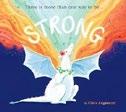
A gentle dragon learns selfacceptance.
Maurice, who’s white with pale-blue wings, isn’t like the other dragons, who love to show off their magnificent horns and their ability to breathe huge fireballs. Much like the protagonist of Munro Leaf’s The Story of Ferdinand (1936), Maurice prefers flowers to displays of machismo. He swoops through billowy grasses, a blossom tucked behind his ear, smiling serenely, as he seeks flowers to arrange into lovely bouquets. Every year, the dragons take part in a competition to see who’s the strongest. Maurice’s brother, the aptly named Gruff, usually wins. This year, Maurice decides to try his luck, too. Unfortunately, his fireball is no more than a tiny puff, and his floral-embellished horns don’t impress the judges. “I’m not strong, or brave, or scary,” Maurice reflects sadly. “I’ll never be like the other dragons.” Then Gruff goes missing during the final phase of the tournament. In a delightful twist, Maurice’s flower-weaving skills suddenly save the day and make him the star of the show. Even Gruff begins to realize that strength comes in many forms. Readers will be pleased to see that just like his beloved flowers, which flourish among the hard rocks, Maurice opens up and blooms, too.
Soaring overhead perspectives and images of wide, outstretched wings capture the essence of these aerial beasts and their habitat. Nonconformity shines in this sweetly tender tale. (Picture book. 4-7)
When I Visited Grandma
Balasubramaniam, Saumiya | Illus. by Kavita Ramchandran | Groundwood (32 pp.) $19.99 | April 2, 2024 | 9781773068336

A child of South Asian descent weathers a complicated visit to India.
Maya’s thrilled to be visiting her grandmother with her parents. Soon after they arrive, Maya and Grandma leave for the market, but Maya’s first morning is challenging. Just as Grandma has predicted, people stare at Maya’s ripped jeans, and she’s overwhelmed by the heat and noise of the market. The pair arrive home late after talking “with all of Grandma’s nosy neighbors,” only to accept another steady stream of visitors. When Maya escapes to her room, she overhears her grandmother making excuses for her absence. She doesn’t have time to dissect these feelings, though, because the next day her grandmother is admitted into the ICU after having a heart attack. On the way to the hospital, Maya asks her parents to stop at the market so she can pick up coconut water—her grandmother’s favorite. But when they miss visiting hours at the hospital, Maya wonders when she’ll see Grandma again. This compassionate portrayal of the challenges of adjusting to a new country while also dealing with a relative enduring illness is a refreshing take on stories about returning to a homeland. The first-person narratorial voice makes for an intimate read, while the collagelike illustrations, which pop with color and feature signs in Kannada script, are beautifully detailed.
A nuanced, insightful look at what it means to have family overseas.
(Picture book. 4-8)
MARCH 1, 2024 95 KIRKUS REVIEWS CHILDREN'S
Kirkus Star
The Glorious Race of Magical Beasts
Bell, Alex | Illus. by Tim McDonagh Faber & Faber (352 pp.) | $9.95 paper April 9, 2024 | 9780571382231
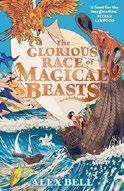
A quirky bookworm joins the race of a lifetime in order to save what’s most important to him.
Twelve-yearold apprentice librarian Elijah Cassius Dewey Fleet embraces the quiet life, working in Harmonia’s Royal Library. He lives with Nana, his doting grandmother, and Humphrey, his moon tortoise. But when Nana’s magic begins to wane, Eli is devastated to learn that he’ll soon lose the only family member he has. The only way to save Nana is by winning the Glorious Race of Magical Beasts—the competition that cost his parents their lives—and claiming the grand prize, which would allow him to buy a cure for Nana. No one believes that a bookish boy wearing a tweed suit and accompanied by his moon tortoise could ever win; most racers go for flashier animals, such as Pegasi, dragons, and cheetahs. Eli will need to overcome many treacherous obstacles, but the biggest challenge he faces might be convincing himself of his own strength. Each chapter introduces fantastical details and characters, including adventuresome Jeremiah Jones (Eli’s best friend, whom he brought to life from his favorite book) and Raven (a fellow competitor, who has an ice hare). Charming characters and true whimsy combine to create a tale that will engage even the most reluctant readers. Eli and Nana read white; Jeremiah and Raven have dark skin and black hair.
A daring adventure about what’s possible when one abandons self-doubt and fears of failure. (Fantasy. 9-12)
Gamer
Bradford, Chris | Illus. by Anders Frang Union Square Kids (136 pp.)
$9.99 paper | April 2, 2024 | 9781454954750
Series: Virtual Kombat, 1

A young gamer desperately seeks a back door when the virtual combat game in which he’s trapped turns all too real.
Set in a dystopian future in which a virus has killed off most grown-ups, this U.K. import sends homeless narrator Scott from the gang-ridden mean streets to a training academy disarmingly dubbed the “City Orphans’ Home.” There, after sharpening his “kombatant” skills while taking part in the addictive Virtual Kombat game, he suddenly finds himself locked into an advanced level where adversaries multiply exponentially and wounds may still be virtual but pain and even death are real. Can he find an escape route before the Grand Arena’s huge swinging blades and vicious attackers reduce his life bar reading to 0%? Facing foes with names like Ginger Ninja and Destroy in a series of savage beatdowns but befriended by capable, swordwielding Kat-Ana (“kinda cute, but no Lara Croft”), Scott does find a way out. The book ends on a cliffhanger, though, with a teaser that will have readers reaching for the simultaneously publishing sequel. Featuring Frang’s geometric spot-art images of fists and swords, the episode races along in short, easily digestible sentences arranged in well-separated lines and paragraphs. Aside from one minor
character who’s referred to as Black, the cast reads as white.
Violent, messy, uncomplicated action. (Science fiction. 11-13)
The Last Comics on Earth: Too Many Villains!
Brallier, Max with Joshua Pruett
Illus. by Jay Cooper & Douglas Holgate Viking (240 pp.) | $14.99 | April 30, 2024
9780593526798 | Series: The Last Comics on Earth, 2
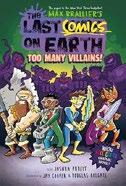
The
Last Kids on Earth craft hastily planned new exploits for their costumed alter egos.
In response to legions of comics fans demanding, as ever they do, “more of the same, but also different” from the second issue of Heroes of Apocalyptia, dark-skinned Quint, tan-skinned June, and light-skinned Jack and Dirk (aka “Musclehead”) draw up a fresh set of foes in their new comic-within-a-comic. They start with a trio of inept supervillains, who turn out to be easily distracted by pizza, and throw in a frustrated AI that dishes up the evil schemes they consistently flub. Jack’s breezy “we’ll figure it out as we go” approach definitely sets the tone. Ultimately, the heroes and villains call a truce in order to confront a larger threat, highlighting the value of teamwork. This idea connects with references to the importance of planning (but not over-planning) as the thematic bases for a whirl of boss battles and other random-seeming set pieces, with the banter flying thick and fast. The opening and closing panels (set in
A quirky bookworm joins the race of a lifetime in order to save what’s most important to him.
THE GLORIOUS RACE OF MAGICAL BEASTS
KIRKUS REVIEWS 96 MARCH 1, 2024 CHILDREN'S
the real world) are loosely sketched and colored in shades of blue, while the pages taking place in Apocalyptia are more finished and in full color. Made-up ads tout fictive merch between some of the chapters (“Enter the wacky world of sea giraffes! The real, live miniature giraffes you grow yourself! Just add sparkling water and watch ’em grow!”). A selection of fan letters and drawings appears at the end. More daft and daffy derring-do. (Graphic fiction. 8-13)
Ánh’s New Word: A Story About Learning a New Language
Bui, Hanh | Illus. by Bao Luu Feiwel & Friends (32 pp.)
| $18.99 May 14, 2024 | 9781250842138
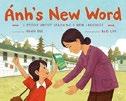
A Vietnamese child living in a refugee camp in America finds courage while learning English.
Ánh’s attempts to speak English while attending the camp’s school are stressful. The child tenses up, and “heat rises to my cheeks like when I bite into a tiny hot chili pepper.” But the teacher, Miss Mary Ellen, is reassuring: “Take your time…It’ll get easier.” Words such as thank you seem stuck within Ánh’s throat, and the child’s frustrations grow. Back home in Vietnam, Ánh was the student who had all the answers. Now fears of making mistakes keep the child silent. As the gentle narrative progresses, Ánh and Bà NÔ i (Grandmother) walk back to their barrack, and Bà NÔ i encourages the little one: “Vietnamese will always be our first language, but it’s good for us to learn English so we can speak with our American helpers. We’ll keep practicing.” In the camp store, Ánh discovers a Christmas sweater festooned with a reindeer, and the child’s perspective shifts. Excited by the new sweater, Ánh learns an English word and even says it aloud: reindeer. Bui reveals in the author’s note that this is in fact her own story and includes pictures of her grandma and the teacher whom Miss Mary Ellen is based on. This poignant
tale is accompanied by charming cartoon artwork with simple textured backdrops, the warm palette adding to the emotional tone. Miss Mary Ellen presents white.
A touching account of courage and kindness. (glossary) (Picture book. 5-8)
The Squish
Carzoo, Breanna | Harper/HarperCollins (40 pp.) | $19.99 | May 21, 2024 9780063334939

The beach is a rough place for a sand castle, what with all the feet, Frisbees, and other hazards around.
Created by two children—one brown-skinned, one tan-skinned—a small, bucket-shaped castle with googly eyes and a hopeful smile (“Hello, world! Here I am!”) faces a string of disasters, from a stomping foot to a shower of rain. Dampened but undaunted, the sandy jumble rises up into even higher and more elaborate structures…only to be knocked down again and again. Then a nearby castle that was constructed in the background by two brown-skinned children, only to suffer a “squish” of its own thanks to a passing wave, prompts a proposal: “Let’s pick ourselves up, / dust ourselves off, / and weather everything life throws at us… / TOGETHER!” If the generalized monologue seems addressed more to younger adults than children, and superfluous anyway given that few if any readers will have trouble recognizing that both the setting and squishing are intended to be metaphorical, the text does add further lift to the visual buoyancy of the low-angled collage beachscapes, created from paper grocery bags, construction paper, and a little sand. The closing “Hello, world! Here we are!” makes a fitting caption to the final view of a magnificent, double-towered construct festooned with banners and waving crabs…and, it seems, only seconds away from one more crashing, but never crushing, squish. Buckets of sandy uplift.
(Picture book. 6-8)
The Spaceman
Cecil, Randy | Candlewick (40 pp.) | $17.99 April 2, 2024 | 9781536226164

A spaceman lands on planet Earth. This story ticks all the boxes. Clever narrative that humorously mimics 19thcentury travelogues, check. Engaging illustrations that enrich and amplify, check. Endearing characters, double-check. Our unnamed, goggle-eyed, yellow-skinned, tiny hero tells readers that it’s his job to visit planets. He collects soil samples, he labels them, and he files them. Then it’s off to the next planet. And the next. But on this planet, which at first seems as desolate as the rest, the spaceman is entranced by a gorgeous—and comparatively huge—flower. While he’s gazing at it, his spacecraft is stolen by a “thief that sprouted wings from its feathery sides” (a bird). He chases, but to no avail. Then he’s accosted by a “hideous beast, all covered in fur” (an adorable dog). He flees. Sitting on a rock, he’s about to yell in frustration when he notices the night is ending, and in the daylight, the planet’s rich and varied beauty is revealed. He hitches a ride with a butterfly, enthralled by all he sees, then loses his grip and falls into a lily pond, where the “hideous beast” rescues him (the creature is “not without its charms,” the spaceman admits). As the spaceman and the dog snuggle together on dry land, he looks up—and sees his spacecraft in the branches of a tree. Ah, he can return to his old life again. But will he?
Humorous, poignant, and oh-sosatisfying. (Picture book. 3-7)

For more by Randy Cecil, visit Kirkus online.
Kirkus Star
MARCH 1, 2024 97 KIRKUS REVIEWS CHILDREN'S
Roar-Choo!
Cheng, Charlotte | Illus. by Dan Santat Rocky Pond Books/Penguin (40 pp.)
$18.99 | April 9, 2024 | 9780593531754

Being fierce is hard when you’re struggling with a cold.
A serpentine scaly green dragon with a flowing orange mane and big teeth and claws fills the page. Our hero explains to Phoenix how tough and terrifying dragons are. “We take on the world with a mighty ROOOOOAAAR… CHOO!” Dragon’s sneeze practically blows Phoenix out of the air. Phoenix tries to help by offering orange ginger tea, a blanket, a scarf, and bone broth soup, but Dragon is having none of it. Dragon’s attempts at roaring turn into big sneezes, however—until one fiery sneeze causes an inferno that Phoenix must douse. Phoenix, whose energy is now flagging, suggests taking a nap. One more sneeze later, and Phoenix is practically drooping with fatigue as the two friends switch roles. Using a palette of greens, oranges, and golds, Santat depicts the two creatures as larger-thanlife cartoons with humorously expressive features. Every page is packed with color and action, but the text feels static in comparison, perhaps because of its small size and lack of variation (a missed opportunity for a typesetting design that matches the exuberance and personality of the two characters).
Nevertheless, this simple but entertaining tale will be a pleasure to read aloud. An author’s note discusses the significance of the dragon and the phoenix in Chinese mythology.
A funny premise, executed with verve. (Picture book. 3-7)

Mapmakers and the Flickering Fortress
Chittock, Cameron | Illus. by Amanda Castillo Colors by Sara Calhoun | Random House Graphic (240 pp.) | $21.99 | $13.99 paper
April 23, 2024 | 9780593172957

9780593172940 paper | Series: Mapmakers, 3 Young Mapmaker Alidade ventures deeper into unknown territories to finally unravel the Night Coats’ power in this trilogy closer.
Following the re-emergence of Peak—the Mountain territory’s Memri (or magical, peace-seeking being)—Alidade and her friends splinter off to free their land from the dreaded Night Coats. Searching for answers behind the Night Coats’ twisted magic, Alidade and Blue, the Memri of the Valley, surrender to Constable Atwater, who takes the pair to Nox City, a Night Coats stronghold. There, an alarming scene awaits. Alidade and Blue partner with Atwater to journey deep into Nox City and through a magical doorway, where a forsaken trail of thorny trees leads to an unexpected answer.
Meanwhile, Peak, Mapmaker Cado, and Lewis, Alidade’s best friend, head to the final territory to resurrect the Memri of the Plains. The trio meets Ripley Range, a Mapmaker who resides in a farming town that’s unable to grow crops due to dark magic. Can the Night Coats’ control over the land be vanquished? The final volume of this endearing graphic fantasy series maintains the same level of allure and spirit, reinforcing themes of peace and strength in community and coexistence with the natural world amid a high-stakes battle between good and evil. The bucolic artwork remains a highlight, and the ever-growing cast of racially diverse heroes and villains provides plenty of opportunities to cheer and jeer.
A refined end to a rousing voyage. (additional sketches, drawing lesson, concept art) (Graphic fantasy. 8-12)
The Monarch Effect: Surviving Poison, Predators, and People
Church, Dana L. | Scholastic Focus (320 pp.) $18.99 | April 2, 2024 | 9781338749229

An overview of monarch butterfly science.
Church offers an extensive account of the discovery of the phenomenon of monarch migration from the east and central U.S. and Canada to their winter home, north of Mexico City. She opens with what locals knew at the time, describing 1940s school trips (recalled by Homero Aridjis, later Mexico’s UNESCO ambassador) to see “rivers of butterflies” in sanctuaries in Michoacán. She later details Aridjis’ successful efforts to protect them through UNESCO World Heritage Site status. In between, the author describes monarch development and recounts the series of experiments that led to scientific understanding of their life cycle. Similarly, she describes the procedures that two different sets of scientists developed to track migrating monarchs. Church devotes a full chapter to the experience of Catalina Trail, the Mexican woman who led Canadian scientists to the actual wintering sites. She then describes efforts to protect these sites, human pressures on the sanctuaries, the rise of citizen science tracking efforts in the U.S., and the impact of changing agricultural practices. She even discusses monarch populations west of the Rocky Mountains and beyond North America. Occasional black-and-white photos supplement the text. This thoroughly researched work is not easy reading for the intended audience, but educators and determined science-minded readers will appreciate the clear presentation of the complexities of environmental protection in the modern world. An enthusiastic and information-packed narrative. (author’s note, glossary, references, photo credits, index) (Nonfiction. 9-14)
KIRKUS REVIEWS 98 MARCH 1, 2024 CHILDREN'S
For more by Charlotte Cheng, visit Kirkus online.
A sweet, tangible explanation of love that reaches through generations.
OUR UNBREAKABLE THREAD
The Vibes Book
Clarke, Hannah | Illus. by Aki Bala Kids/Shambhala (32 pp.)
$19.95 | April 9, 2024 | 9781645470823

Think good thoughts and improve lives. At the outset, the word vibes is defined as “a special kind of energy,” though Clarke doesn’t mention that the term is short for vibrations. She adds that vibes are “magical, invisible feelings and thoughts.” Though they can’t be seen, “You can feel them in your body and all around you.” Most young children likely won’t be familiar with the term, but it’s a concept worth learning about. Clarke emphasizes the importance of sending out positive energy into the world and receiving it in return: “The vibes that work the most magic are good vibes.” People who have good vibes are characterized as joyful and warm; they make those around them feel better. The author explains how to transmit good vibes: Just “think about somebody and imagine all your lovely thoughts and energy surrounding them.” On the flip side, readers are advised not to send on bad vibes, because neither recipients nor senders will feel good afterward. This simple, well-written, reassuring book stresses the power of positive thinking and living—good messages as children strive to make friends and navigate their way through the world. Spare, cartoonlike images follow a youngster with tan skin; most characters have paper-white skin, though there’s some diversity in terms of race and age.
Imparts sound takeaways about the power of positivity. (author’s note) (Picture book. 4-7)
Bridge to Bat City
Cline, Ernest | Illus. by Mishka Westell Little, Brown (320 pp.) |$17.99 April 9, 2024 | 9780316460583
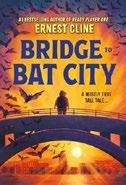
A 13-year-old girl and a colony of bats overcome losses in this middle-grade debut from Ready Player One author Cline. After Opal B. Flats’ mother dies, she goes to live with Uncle Roscoe on the family farm in the Texas Hill Country. Her first night there, she has an alien encounter and subsequently discovers that she can communicate with the Mexican free-tailed bats living in a nearby cave. Their connection becomes essential when Opal, Uncle Roscoe, and the bats, through differing circumstances, are forced to find new homes. Opal and Uncle Roscoe, who read white, convince the bats to accompany them to Austin, “the only place in this whole stonehearted state where weirdos are welcome!” If Opal and Uncle Roscoe have a slow start with fitting in, it’s even more difficult for a colony of over a million bats, especially when prejudice against them is being systematically reinforced by a greedy councilman whose pesticide business suffers when the bats start eating insects. The third-person narration unfolds in a homey style that’s colored with references to music and famous names that contribute to the sense of place, including Ann Richards, Selena, and Willie Nelson. Entries from Opal’s scrapbook are interspersed throughout. Readers will be relieved that, despite the hardships Opal and the bats must overcome, they ultimately prevail, succeeding in making friends and new
homes for themselves in this celebratory primer on bats and belonging. Westell’s delicate, atmospheric illustrations greatly enhance the text.
Delightfully weird and whimsical. (Fiction. 8-12)
Our Unbreakable Thread: A Family’s Love Through Generations
Collins-Black, Jon | Illus. by Nicole Gsell Marble Press (32 pp.) | $18.99 April 9, 2024 | 9781958325087

An invisible, enduring thread connects parent and child through the youngster’s lifetime.
A family of three welcomes a new baby. One of the parents rocks the infant to sleep and ties a magical thread to the baby’s finger, keeping them connected. The thread stretches as the child grows into a toddler; it provides comfort as the little one enters kindergarten. Eventually it reaches long and far as the not-so-littleanymore child leaves for college. The thread, of course, stays strong through knots and tangles, grief, and heartbreak until eventually that former child marries and has a child, and the thread extends to wrap around the new baby’s finger. Told in the first person from the parent to the child, this story conveys deep feelings that will resonate with any caregiver; it will also comfort little readers. The tale doesn’t shy away from acknowledging difficult topics (arguments between parent and child, the death of a grandparent), yet it still reassures youngsters that a loving adult will be there through it all. The illustrations depict common life scenes, almost like a highlight reel from a person’s life: school, romances, heartbreak, the start of a new generation. Soft watercolor and gouache images show the family’s expressive faces, a portrait of frustration, sadness, and joy. The main characters present white; the grown child’s spouse is tan-skinned. A sweet, tangible explanation of love that reaches through generations. (Picture book. 4-7)
MARCH 1, 2024 99 KIRKUS REVIEWS CHILDREN'S
Growing Up Under a Red Flag: A Memoir of Surviving the Chinese Cultural Revolution
Compestine, Ying Chang | Illus. by Xinmei Liu Rocky Pond Books/Penguin (40 pp.)
$19.99 | May 7, 2024 | 9780593533987
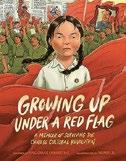
Author Compestine recalls her experiences growing up during the Chinese Cultural Revolution. It’s 1966, and the author is just 3 years old. Young Ying’s parents are doctors and among the educated dissenters targeted by Mao Zedong. Her father teachers her English, and Ying dreams about going to America to eat food with funny names such as Twinkies and Tater Tots. But by the time she’s 5, people are banned from speaking foreign languages and reading books in English, letters are monitored, and Western items are destroyed. The city walls are oppressively adorned with propaganda, and everyone is forced to don Mao uniforms and conform to a new way of life. Accused of being an American spy, Ying’s father is arrested, and she grapples with censorship, scarcity, and a loss of independence over the course of the next decade until Mao’s death in 1976. The author uses simple, clear language to make complex political ideas more accessible to young audiences. While the emotional resonance of some scenes feels muted due to the sheer amount of history that the tale covers, Liu’s artwork helps add depth with nuanced facial expressions, thoughtful details, and eye-catching visual compositions. The limited yet vibrant palette and the style of the illustrations are fittingly reminiscent of vintage Chinese propaganda posters. A vivid glimpse into a childhood under communist rule. (author’s note, photographs) (Picture-book memoir. 6-10)
How far could we go if we allowed our creativity to wander freely with wild abandon?
WHAT IF BEDTIME DIDN’T EXIST?
Dalmartian: A Mars Rover’s Story
Cummins, Lucy Ruth | Atheneum (48 pp.) $18.99 | May 7, 2024 | 9781665911955
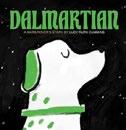
In space, no one can hear you howl. Deep in the dark of night, a spaceship lands in a suburban backyard, and three aliens, resembling green-spotted Dalmatians, collect samples of the local flora and fauna. Suddenly, in a scenario straight out of E.T., the visitors are interrupted in their work and accidentally end up leaving one of their own behind in their haste to flee. Fortunately, Stephen, the light-skinned boy residing in the home, is happy to invite his new guest in. As the two acclimate to each other, the guest must continually assert himself when Stephen tries to treat him like a regular dog. That means offering the guest slightly more delicious breakfasts (when the alien tries Stephen’s bacon, his ears start to look like wavy green bacon, and his eyes water with joy), as well as figuring out sleeping arrangements and dog park etiquette. The first night, the alien’s crewmates don’t return, but the second night they do. Now the visitor must decide: Where exactly is “home”? Rendered in ink and charcoal and finished digitally, the illustrations feature a pup who resembles nothing so much as an early Snoopy. The gentle narrative is told in an offhand style that diminishes none of its emotional impact. This variation on the classic “boy and his dog” story is sure to be beloved by more than just pup lovers.
A loving look at a friendship that spans the stars above. (Picture book. 3-6)
What if Bedtime Didn’t Exist?
Cunningham, Francine | Illus. by Mathias Ball Annick Press (36 pp.) | $18.99 | March 26, 2024 9781773218687
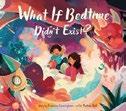
How far could we go if we allowed our creativity to wander freely with wild abandon?
The dark-haired, brown-skinned siblings in this vivacious book let their imaginations soar and conjure up riotous what ifs that readers will wish would actually materialize. Take, for instance, the “really nice” green and blue monsters in their closets who’ve come to play dress-up in outlandish outfits that these kids “didn’t even know we had.” Or what if, after breakfast, the kids could sprout wings and fly out the kitchen window…and “play hide-and-seek in the puffy white clouds”? What if “dinosaurs [were] still alive…but “were all accidentally shrunk to the size of ants…and now they roam and roar with ferocity at our toes”?
Cunningham (Saddle Lake Cree Nation) employs language that grows richer, lusher, and more evocatively picturesque as the what ifs grow more vivid and ingenious. If ever there was an opportunity for children to share their own thoughts—verbally, in writing, or through art—this is it! Youngsters will jump at the chance to let their fancies fly freely and happily join these sibs in a wondrous fantasy world of sublime what ifs. The best is saved for last: the what if of nonexistent bedtime! The illustrations are terrific: flying, swooping whoops of dazzling colors that match these children’s own inventiveness. What if there was a great book about kids’ artful, joyful imagination? Oh, wait: Here it is! (Picture book. 5-8)
KIRKUS REVIEWS 100 MARCH 1, 2024 CHILDREN'S
I’m Afraid, Said the Leaf
Daniel, Danielle | Illus. by Matt James
Tundra
Books (64 pp.) | $18.99
May 7, 2024 | 9781774880708

The interconnectedness of all earthbound beings centers this tale of fear, support, and love.
“I’m afraid,” says a single yellow leaf as it’s blown from its tree toward the water. “You’re not alone,” responds the tree. On the sand below, a human child watches this interaction. The book follows other usually uncommunicative species as they exhibit some very human emotions. “I could fall,” a little yellow bird in a nest says. The wind assures it, “I will lift you.” And as a squirrel says, “I’m so hungry,” a nut responds, “I will feed you.” In her author’s note, Daniel states that her tale taps into the interdependence of all living things and that “every single living thing depends on another living thing.” Yet it’s James’ art that elevates the exceedingly spare text emotionally. Using acrylic paint, he depicts a tan-skinned child who follows along, drawing a smiley face on the shore as the leaf falls, running along as the bird takes flight, and, overall, providing the necessary visual connection the text so desperately needs. The result is a poetic encapsulation of the connections among all living things on Earth. The inner lives of different species may be the focus of this story, but it’s the art that renders the tale truly universal. (Picture book. 4-7)
The Little Regent
Daniel-Ayoade, Yewande | Illus. by Ken Daley | Owlkids Books (44 pp.) | $18.95
March 12, 2024 | 9781771475624
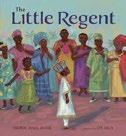
The law made her the head of her small West African village, but only her ability to watch and listen will make this little girl a leader.
Abioye is 8 years old when her father, the king of her village, dies and she must assume the role of the regent, an interim ruler appointed, per Yoruba tradition, when there is no male heir. Grieving her father and seeking counsel from her mother, Abioye must face detractors who question her ability to rule because of her inexperience and her age. Initially, she even doubts herself. Bright, full-color illustrations show a lively village bustling with activity in celebration of their new leader, even as Abioye herself is somber as she feels the weight of her newfound responsibilities bear down on her and reflects on her late father’s approach to leadership. Her loving and supportive mother advises her to follow in her father’s footsteps of service-minded rule: “Start by watching and listening.” With this, Abioye considers the needs of the cooks, the fishers, the children, and all the villagers beyond the palace walls, which frustrates her chief critics but wins her the overwhelming support of the village, ultimately making her interim role a permanent one. She becomes the first girl to hold the position of king. This empowering, well-paced tale concludes with a hopeful author’s note that provides greater context about Yoruba culture.
A subtly radical education on service and leadership. (author’s note) (Picture book. 4-8)
The Queens’ English: The Young Readers’ LGBTQIA+ Dictionary of Lingo and Colloquial Phrases
Davis, Chloe O. | Simon & Schuster (448 pp.) $19.99 | April 30, 2024 | 9781665926867

interspersed with lessons, charts, and tables, this dictionary attempts to explain “over eight hundred terms used to describe our collective gay and queer experience.” A note on appropriation acknowledges the origin of many terms in ballroom, drag, working-class lesbian, and/or Black cultures, yet this book also introduces readers to what may otherwise be unfamiliar vocabulary words without sufficient context or advice on their use. Confusingly, tame entries, such as allosexual and closet case , are labeled “mature,” while explicitly sexual terms (for example, spaghetti, stone butch, and fish) are given desexualized—and often misleading—definitions. Some inaccurate claims (defining pup as a “slender… baby gay” man instead of as someone who’s into puppy play) are given without citation. Controversial descriptions (like the statement that AFAB and AMAB are preferable to FTM and MTF, because they acknowledge “the binding nature of being assigned a specific gender at birth”) are presented as facts. Most entries include additional information, but it’s frequently an unhelpful or tautological description (the “bear community” definition, which follows the entry for bear, is contextualized as “those who celebrate the bear necessities during P-Town Bear Week,” with no further explanation of “bear necessities” or “P-Town”), and painfully corny dialogue provides contextual usage. Additionally, the author deadnames Joey Soloway and mistakenly identifies Tom Phelan as a trans man. Riddled with inaccuracies; not recommended. (author’s note, resources) (Nonfiction. 11-18)
A compendium of LGBTQ+ definitions for younger readers adapted from the 2021 adult original. Using a standard A-to-Z format

For more LGBTQ+ titles, visit Kirkus online.
MARCH 1, 2024 101 KIRKUS REVIEWS CHILDREN'S
Libby Loves Science: States of Matter
Derting, Kimberly & Shelli R. Johannes
Illus. by Joelle Murray | Greenwillow Books (40 pp.) | $17.99 | April 30, 2024
9780063116634 | Series: Libby Loves Science

“Science is the best!”
When Libby’s teacher, Mr. Darwin, announces that a new student named Fatima will be joining their class, Libby suggests throwing her a welcome party. Libby’s friends volunteer to make a banner and bring decorations, while Libby will be responsible for the treats. The next day, Libby totes a bag filled with sundae toppings and a carton of ice cream. Fatima arrives and sits beside Libby, and they soon bond over their shared love of science. Mr. Darwin explains the term matter and its three states and offers familiar examples, with lots of eager input from the students. Everyone seems to grasp the concept. Recess begins, and they prepare for the party. But Libby realizes that she forgot to put the ice cream in the freezer, and it’s changed from a solid to a liquid. Luckily, Mr. Darwin supplies hot cocoa, and the children apply their knowledge. The steam coming from the cocoa is a gas, the marshmallows they add to their mugs are solid, and the cocoa is liquid. The welcome party has been a smashing success. The science is clearly explained, and the Popsicle-bright illustrations focus on the big-eyed children, who are all fully engaged and plainly adore all things STEM. Mr. Darwin is lightskinned, Libby presents Black, Fatima is brown-skinned, and the class is diverse. Science made clear—and fun. (recipes for ice pops and orange soda, quiz, glossary) (Easy reader. 5-8)

For more by Kimberly Derting, visit Kirkus online.
A joyful ode to freedom from the perspective of a park in Houston, Texas.
THEY BUILT ME FOR FREEDOM
At the End of the Day
Detlefsen, Lisl H. | Illus. by Lynnor Bontigao Knopf (40 pp.) | $19.99 | April 23, 2024 9780593378632

A child struggles with feelings of sadness. An unseen narrator repeats the title phrase to underscore a family’s fatigue.
“At the end of the day, sometimes everyone is exhausted. Or bored. Or in a mood.” There’s homework to be done or piano lessons to attend. There’s often no time to play outside, especially if it’s too cold. And don’t forget chores. Even a seemingly small disappointment, like a missing puzzle piece, hangs over the family like a dark cloud. Briefly, though, such as during a family bike ride, things seems OK. What’s going on? The clues are there if readers carefully observe Bontigao’s cozy, digital illustrations. Dad and the children are engaged in a variety of activities, but Mom is absent. Readers eventually realize that she’s far away and sorely missed, seen only on a video call in her military uniform. For she is the missing puzzle piece. When she returns, the family’s emotions pour out, and all is right with their world, now filled with reassuring, comforting sights and sounds and lots of kisses and hugs. The lyrical text is paired with tender visuals that primarily focus on one of the children, who’s by turn confused, sad, and hopeful—and whose situation will elicit commiseration and compassion, especially from other kids in military families. Dad presents Asian, while Mom is brown-skinned, and the children vary in skin tone. Gentle and heartwarming. (Picture book. 4-9)
Kirkus Star
The Perilous Performance at Milkweed Meadow
Dimopoulos, Elaine | Illus. by Doug Salati Charlesbridge (208 pp.) | $17.99
May 21, 2024 | 9781623544270

Lovable lagomorph and remarkable raconteur
Butternut details how the denizens of Milkweed Meadow narrowly missed a night of terror.
“I know you’re here for the story of the fearsome fire in the oak forest.” As in The Remarkable Rescue at Milkweed Meadow (2023), Butternut immediately hooks readers. She then weaves a spellbinding tale that includes animal characters as well as Thalia, the “little female human” who’s secretly friends with Butternut. An acting troupe of wild turkeys—led by the eloquent Monty, who speaks in a Shakespearean cadence—have come to invite the meadow animals to take part in their summer show. Unfortunately, Butternut’s the only auditioning rabbit from her colony not to be cast. While she deals with disappointment, other developments arise. Will the blue jays let the turkeys use their eggs as props in the show? Why is that young gobbler Franklin so bad-tempered? Should the local rabbits, birds, and frogs be concerned about a circling hawk and a hovering raccoon? Are humans trustworthy? Suspense builds to a narrowly averted crisis that’s much darker than in the previous tale, but all’s well that ends well. Dimopoulos is as gifted a storyteller as her endearing hero, and she deftly folds in alliteration, theater terms, nature facts, and sparkling humor. Butternut’s musings
KIRKUS REVIEWS 102 MARCH 1, 2024 CHILDREN'S
and observations are thought provoking and perceptive. Thalia appears lightskinned in Salati’s delightful spot art. Whimsical, witty, wise. (map) (Fiction. 7-11)
The Curious Why
DiTerlizzi, Angela | Illus. by Lorena Alvarez Gómez | Little, Brown (40 pp.)
$18.99 | May 7, 2024 | 9780316500142 Series: The Magical Yet, 2
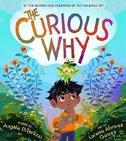
In this follow-up to The Magical Yet (2020), a child finds an antidote to apathy.
Talk about ennui! The red-spectacled, brown-skinned, dark-haired young protagonist is listless and bored. The little one has tried everything: the computer, toys… YAWN! But as the rhyming narration bounces along at a sprightly clip, a visitor arrives at the door. It’s the Curious Why, who resembles a flowery, leafy artichoke. The Curious Why ushers the child along on an inspirational path to great fun and tremendous learning. “You’re only bored if you choose to be,” says the Curious Why. There’s an enormous world out there just waiting to be explored by anyone who’s willing to be a “knowledge-collector” and a “gotta-know creature.” In other words, kids should ask questions about everything going on in the world. Where does the Why go for answers to these queries? The library, of course! On the next spread, we see the protagonist reading a book atop a winged prehistoric creature while dinosaurs mill about in the background. Other kids explore their passions, too; one uses a telescope to study the stars, another bakes, and another learns about bees. DiTerlizzi offers youngsters an upbeat, sensible cure for a serious case of the blahs; it’s not necessarily guaranteed to work, but it’s definitely worth a try. Readers will love the colorful, energetic, swirling digital illustrations, especially those
dinos. Background characters are diverse. Why not? Fun, cheery, and entertaining: just the ticket for the perennially inquisitive—or perpetually bored. (Picture book. 4-7)
Gray
Dockrill, Laura | Illus. by Lauren Child Candlewick (40 pp.) | $18.99 May 7, 2024 | 9781536235463

Color words signal emotions. Children understand that colors often suggest feelings: The brighter the hues, the happier the sentiments. As this book opens, a kid looks out forlornly and announces, “Today, I am gray.” The illustrations confirm it, as do the child’s explanations: “I don’t feel sunshine yellow or orange balloon bright or treetop green.” Not even “night sky black.” Everyone’s had days when they feel like “the scribble on a page,” “the storm in the clouds,” “the puddle in the road,” “the tea when it’s gone cold.” The protagonist says that it’s OK to feel gray, as if all the colors have gone; you don’t have to be bright every day. The good news is… storm clouds that bring rain also bring splashy puddles and the sun. And while you may feel gray like the sidewalk, later you can scribble on it…using whatever colors you choose! Better yet is a loving parent telling you, “All of these colors are your feelings…and each one of them is still inside you.” The best news is a parent saying “I love you however you are feeling…and my love won’t change, even when you’re gray.” Kids will warm to this sweet, understated U.K. import and feel heartened by the caregiver’s comforting reassurances. Youngsters should feel their own moods, notoriously mercurial in childhood, validated. The mixed-media illustrations are appealingly childlike— and, unsurprisingly—colorful. Parent and child have lightly tanned skin. This wise charmer will help brighten readers’ feelings. (Picture book. 4-7)
They Built Me for Freedom: The Story of Juneteenth and Houston’s Emancipation Park
Ellis, Tonya Duncan | Illus. by Jenin Mohammed Balzer + Bray/HarperCollins (32 pp.) | $19.99 May 14, 2024 | 9780063286054
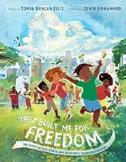
A joyful ode to freedom from the perspective of a park in Houston, Texas.
Emancipation Park was built on land purchased in 1872, to commemorate the holiday that would become known as Juneteenth; in 1918, it was made into a municipal park. Here, residents of the city’s Third Ward could celebrate the freedom of their ancestors. As the book opens, we see people—predominantly Black and brown—enjoying a summer day. Readers are then transported to June 19, 1865, when the enslaved people of Galveston found out that, two years earlier, Abraham Lincoln had ended slavery by signing the Emancipation Proclamation. Later, the park in Houston was built to honor that triumphant day. From then on, it became a community gathering spot, where people played, held concerts, and hosted sporting events. When Jim Crow and segregation laws proliferated, the park also housed the only pool that allowed African Americans. Eventually, the park fell into disrepair until it was rededicated in 2017 and given new life. Most spreads open with a reason the park was built: “They built me to celebrate.” “They built me to play.” Ellis writes in spirited, succinct verse. Mohammed’s bold, active illustrations give rise to powerfully poignant words. Butterflies and plant life can be seen throughout; as the park goes through its life cycle, so, too, do those elements. A beautifully layered story just as rich as the history it represents. (background information about Emancipation Park) (Informational picture book. 4-8)
MARCH 1, 2024 103 KIRKUS REVIEWS CHILDREN'S
Kirkus Star
I’ll See You in Ijebu
Emenanjo, Bunmi | Illus. by Diana Ejaita Barefoot Books (32 pp.) | $17.99
March 12, 2024 | 9781646868438
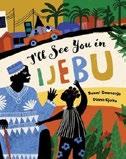
A loving embrace of faith and family and a wonderful window into Nigerian culture.
I’LL SEE YOU IN IJEBU
Eight-year-old Olu visits her mother’s family in Ijebu, Nigeria, as they observe Eid al-Adha.
Olu travels from Lagos with her mother, her uncle, and her siblings for the Muslim holiday. Although her family is Catholic, like many Nigerians, her extended family includes members of other faiths, who celebrate their respective traditions together. Olu is excited because this year she will get to help her grandmother Iya Akin cook the feast. The trip is filled with the sights and sounds of Nigeria: “Smells of crunchy dundun and sweet puff puff frying fill the air.” “Impatient drivers honk and honk. / Street hawkers walk and hawk.” “Roads marked with black-and-white lane dividers / Make the highway look like racing zebras.” When Olu arrives, her grandfather chants a Yoruba greeting: “Olubunmi! My gift from God! / Daughter of Akinpelumi! / Descendant of Asemperi! / Born of Ondo soil! / My American child!” And so begins the visit, full of traditional foods and celebrations, which are described in vivid detail. Vibrant, rich illustrations make use of flat colors and complement the sensorial text, bringing to life the energy of Nigeria. In their author’s and illustrator’s notes, Emenanjo and Ejaita share their personal inspirations and connections to the story. A loving embrace of faith and family and a wonderful window into Nigerian culture. (information on Nigeria, map, glossary, recipe for puff puff, photos) (Picture book. 4-8)

For more by Diana Ejaita, visit Kirkus
Clyde the Greyhound
Feiner, Beck & Robin Feiner | Little Hare/ Trafalgar (32 pp.) | $18.99 | April 9, 2024 9781761210808

A pooch gets a new “leash” on life.
Lucy’s thrilled when Dad brings home Clyde, a sleek black greyhound who was once a racing dog. Lucy quickly spoils him: Clyde wears designer outfits, eats the finest meals, joins exclusive dog clubs, and even has a social media account. Lucy gives her pet a collar bearing a new name: “Cino.” But Clyde, who eked out a tough existence at the racetrack, can’t get used to this luxurious lifestyle. He leaves home and roams the streets for hours until he finds himself back at the track. Sad memories of his former life impel Clyde to flee. Soon it’s dark and he’s lost, so he takes shelter under a bridge. He realizes he misses home and his pampered life, especially Lucy’s cuddles. He awakens to… Lucy. She and some of his dog pals have been searching for him. Lucy takes him home, where she gives him something special—“the best gift he’d ever received”—a collar labeled “Clyde.” Children will be pleased with the satisfying ending to this sweet Australian import; they’ll be delighted to know this dog will continue to receive the devoted care he and all pets deserve while still maintaining his own identity. The story also offers a glimpse into the dreary life of some racing dogs. The lively, stylized, bold illustrations have an art deco look and will draw readers in. Lucy is brown-skinned; background characters are diverse.
An endearing tale that will especially resonate with dog lovers.
(Picture book. 4-7)
Sunny Parker Is Here To Stay
Finnegan, Margaret | Atheneum (288 pp.) $17.99 | April 23, 2024 | 9781665930086
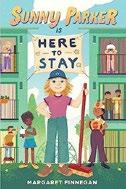
A rising middle schooler fights for more affordable housing in her wealthy town.
Sunny Parker, a white 11-year-old, has no plans for the summer other than helping her widowed dad, who works as the manager of Del Mar Garden Apartments, the affordable housing complex where they live. On a walk through the wealthy neighborhood surrounding Del Mar, Sunny and Mrs. Garcia, her neighbor and mom figure, see that the site of a nearby closed elementary school is being considered for building more affordable housing. Mrs. Garcia, who says that “money breeds mean,” doesn’t think the mostly high-income townsfolk will support the measure; when she’s proven right, Sunny and her best friend, Haley, who’s Black, embark on a campaign to change hearts and minds, even though Sunny’s own father disapproves of their activism.
The ethnically diverse Del Mar residents, including a young Ukrainian single mom who’s being abused by her boyfriend, are well drawn, but the rich people are mostly presented without nuance as being against the “lowlifes” whom they believe an affordable housing complex would bring.
Finnegan doesn’t explain the concept of affordable housing in a way that feels clear enough for middle-grade readers
KIRKUS REVIEWS 104 MARCH 1, 2024 CHILDREN'S
online.
to understand, although they will grasp that Sunny and her neighbors are being denigrated. Sunny’s dad is enigmatic; the emotional ending involving him, while well written, seems to come out of nowhere.
Well intended but lacking in execution. (author’s note) (Fiction. 8-12)
Lo Simpson Starts a Revolution
Florence, Melanie | Orca (216 pp.) | $14.95 paper | April 16, 2024 | 9781459838505
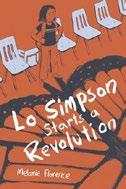
A quirky preteen fights misogyny and toxic social norms.
Dr. Who superfan Lo Simpson, 12, would rather be planning her next cosplay than shopping for bras or giggling over boys. Unfortunately, that’s all her longtime best friend, Jazz, seems to want to do—that and infiltrate the ultra-popular It Girls clique, even if it means leaving Lo behind. Unsure of who she is without Jazz, Lo has to find her own way through the maze of middle school. A mutual love of comics and Dr. Who connects Lo to a new crowd, where she feels like she can be her authentic self. With their support, Lo finds her voice and learns how to use it, whether that means breaking up an uncomfortable game of spin the bottle or facing down her school principal on issues of gender equality. Lo documents the ups and downs of her life with confessional letters to the Tenth Doctor that some readers may find border on cringey. Although her approach is occasionally heavy-handed, Florence tackles topics such as sexism, consent, and menstruation with a matter-of-fact tone that will resonate with readers. She paints a hopeful, if sometimes overly simplified, picture of how one person can instigate change for themselves and others. Characters are minimally described physically; diversity in family structure and
gender identity is represented among the cast members.
A thoroughly modern coming-of-age tale. (Fiction. 9-13)
Team Unihorn and Woolly: Attack of the Krill
Frederick-Frost, Alexis | HarperAlley (96 pp.)
$12.99 | April 16, 2024 | 9780063002050 Series: Team Unihorn and Woolly, 1

Shared Space
Frost, Maddie | Harper/HarperCollins (32 pp.)
$19.99 | April 9, 2024 | 9780063246096

The heroes of the beach are here! But what makes someone a hero?
Raina the rhino, Shu the horseshoe crab, and Nigel the narwhal are at Burlap Beach when a chunk of ice containing a woolly mammoth washes ashore. Team Unihorn, as they later dub themselves (as Shu says, a horseshoe crab’s tail definitely counts as a horn), break Woolly and some prehistoric krill out just in time. A massive storm is on the way, along with a blood supermoon eclipse. The moon’s rays endow Raina, Shu, and Nigel with superpowers but leave Woolly unchanged. The storm has left the beach a mess, so Team Unihorn use their abilities to help, but they only make things worse. Meanwhile, Woolly’s feeling left out. But when the prehistoric krill merge to form a giant monster, Woolly steps up. He may not have powers, but he possesses physical strength, unexpected talents, and brains. Endearing Woolly leaves an awkward first impression—peeing in Nigel’s seawater and crushing Shu’s telescope—but his recognition at the end is well deserved, and readers will appreciate the message that anyone can be a hero. Each protagonist has a unique size and silhouette, making them stand out amid the action. The animals are adorable, with round, almost cuddly bodies; the whimsical look of the cartoon images keeps the tone light, no matter how intense the action gets.
A wildly entertaining lesson in heroics. (Graphic fantasy. 6-10)
What would you do if someone dumped all their “treasures” in your yard?
Mouse loves having his own yard. The lawn is always mowed to perfection, and there’s never so much as a twig or a branch out of place. Mouse has room to stretch and play… until Pak-Rat moves into the other side of Mouse’s tree trunk condo and begins decorating the shared yard with pinwheels, feline garden gnomes, chimes, and a flock of pink flamingos. Mouse dislikes the new additions, but he tries to ignore the intrusion. Finally, he attempts to express his concerns, but Pak-Rat can’t hear him over all the noise his new decorations are making. One night, after Mouse reaches his breaking point, he digs a deep hole and buries Pak-Rat’s lawn ornaments. Unfortunately, Mole unearths them all. It’s time for Mouse to come clean to Pak-Rat, and they reach a compromise. They both learn that being neighbors means they need to share and be flexible— but it also means having a friend to do things with. Busy, colorful, digitally created cartoon illustrations vividly depict a timid, fastidious Mouse, a clueless, exuberant PakRat, and an increasingly crowded yard. The detailed artwork will provoke laughter but will also provide opportunities for discussion. Plenty of sound effects and a few puns add to the reading fun. A funny and heartfelt demonstration of the right and wrong ways to resolve conflicts and share space. (Picture book. 4-7)

For more by Maddie Frost, visit Kirkus online.
MARCH 1, 2024 105 KIRKUS REVIEWS CHILDREN'S
Dive! The Story of Breathing Underwater
Gall, Chris | Roaring Brook Press (48 pp.)
$19.99 | April 9, 2024 | 9781250823953

An overview of undersea venturing, from ancient sponge diving to explorations with modern submersibles.
Gall pairs a stodgy recitation of names and basic facts with cleanly drawn depictions of early diving suits and other gear down through the ages—beginning with hollow reeds used by ancient Greek divers and ending with an out-of-scale Alvin submarine cruising past the wreck of the Titanic . All are depicted being used or tested by a racially diverse cast of frozen-faced divers, inventors, and bridge construction workers. Along with livelier views of brightly colored sea life both real and fanciful, he also mixes in anatomical diagrams to illustrate the effects of pressure and compression. Throughout, Gall depicts a biracial family—oddly stony of mien, like the other humans—preparing for adventurous vacations, exploring a coral reef, and conducting simple science demonstrations. Both the evolving technology on display and the dramatic deep-sea settings and naturalistic flora and fauna are worth lingering over. But for readers seeking more vivid and detailed pictures of the dangers and discomforts of undersea exploration, Aly Brown’s The Last Unexplored Place on Earth (2023) makes a grand follow-up. A perfunctory list of information sources is appended, along with a warning about the hazards of climate-warming oceans and, less tangentially, general remarks on diver training and careers at the end.
Immersive visuals, weighed down by a leaden text. (glossary, fun facts, author’s note) (Informational picture book. 7-10)
Rich illustrations and a snappy rhyming text reinforce the power of inner strength.
PENNY LU PORCUPINE
Penny Lu Porcupine
Gilstrap, Katie | Illus. by Maribel Lechuga Nancy Paulsen Books (32 pp.) | $18.99 May 7, 2024 | 9780593326275

A porcupine is put to the test. Like all North American porcupines, Penny Lu can’t see much, other than what’s directly in front of her, though her sense of smell is “swell!” At a visual disadvantage, “She must always beware…of cougars, coyotes, and even…THE BEAR!”
Luckily, Penny Lu has a built-in defense mechanism: pointy quills that, when activated, “make her look bigger” and “feel braver.” She also has a battle cry—“I’m big and I’m brave and I’m prickly, too! So leave me alone, or I’ll come after YOU!”—all of which makes her a tough customer. When she encounters what she thinks is a bear, Penny Lu is courageous in the face of what turns out to be rocks and a stump, but when she finally meets a real bear, she panics. Things look grim, but those instinctive defenses finally kick in, and with a mighty shout, Penny Lu shows the bear what she’s made of (quills). Gilstrap’s well-constructed rhyming narrative demands to be read aloud. Readers will delight in Lechuga’s velvety illustrations, which include details such as a praying mantis’s intimidating posturing, a startled owl, and watchful predators lurking in the background. In an author’s note, Gilstrap provides information about porcupines and insight into her own childhood panic disorder, both of which enrich the story and invite
conversation about bravery in the face of anxiety.
Rich illustrations and a snappy rhyming text reinforce the power of inner strength. (Picture book. 2-6)
Finding Bear
Gold, Hannah | Illus. by Levi Pinfold Harper/HarperCollins (304 pp.) | $19.99
Feb. 27, 2024 | 9780063296107

A sequel that rekindles a beautiful friendship. April and her father have left the Arctic Circle and now live in an area that’s “hustling, bustling, and jostling every crowded minute of the day,” where she struggles to adjust. Upon learning that Bear, her polar bear companion from The Last Bear (2021), is in danger, she rushes back to Svalbard. As it turns out, Bear needs her help to save his cub from starvation. To do so, April battles the hazardous Arctic climate and makes rash decisions, disregarding her dad’s concerns for her safety. April’s survival skills are inexpert, and some of her decisions are dangerous, but she bravely endures life-or-death circumstances. Ultimately, she succeeds in rescuing the cub, whom she names Peanut, and rediscovering her Arctic home in Longyearbyen. Bear provides April with actual bear hugs and becomes a sounding board for her struggles outside the Arctic. April, who reads white, resonates with animals more than her human peers. The narrative sensitively addresses climate change, wildlife biology, and related
KIRKUS REVIEWS 106 MARCH 1, 2024 CHILDREN'S
subjects through informative content that’s woven into the dialogue. April’s father is an absent afterthought, and April navigates the tundra independently. Still, her dad and his girlfriend make significant life changes to support her happiness. While some elements are far-fetched, the story validates youth activism as a worthy pursuit. Pinfold’s haunting illustrations add richness to the atmosphere. An empowering, optimistic read for animal lovers and environmentally savvy tweens. (map, resources and further reading) (Adventure. 9-13)
Cruzita and the Mariacheros Granillo, Ashley | Carolrhoda (248 pp.) $19.99 | April 2, 2024 | 9798765608500
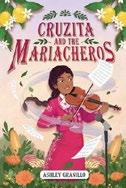
When Cruzita’s great-uncle Chuy passes away, the family bakery is put in jeopardy, and Cruzita scrambles to save it in the only way she knows how: through her singing.
Although 12-year-old Cruzita is Mexican American and growing up in the historically Black and brown Los Angeles community of Pacoima, she struggles with her identity. Her peers look down on her as a “no sabo kid” and a “coconut” (brown on the outside, white on the inside). After the death of her beloved Tío Chuy, the family members pull together to save the struggling panadería, Lupe’s Bakery. Though Cruzita dreams of finding pop stardom—and saving the bakery—through the Encore Island theme park singing contest, her family needs her feet to be more firmly planted on the ground: for example, by helping out in the bakery over her summer vacation. Hoping to support her, Cruzita’s abuela signs her up for mariachi classes, but playing the violin and singing in Spanish aren’t Cruzita’s idea of a good time. Still, through the classes, she begins
to make friends, and these relationships help her claim her heritage. Holding on to to her dreams of singing stardom while balancing the present-day needs of her family pulls Cruzita in uncomfortable new directions. Many readers will resonate with the demands on her time, and the children and grandchildren of immigrants will likely identify especially strongly with Cruzita’s journey toward connecting with her roots.
A sweet summer quest for identity and belonging. (Fiction. 8-12)
I Am Both: A Vietnamese Refugee Story
Greene, Kerisa | Feiwel & Friends (48 pp.) $18.99 | April 9, 2024 | 9781250865021

A young Vietnamese refugee searches for belonging.
Onomatopoeia punctuates the spare text—the “STAMP STOMP” of footsteps, the “SWISH SWOOSH” of baskets”—as Hương’s family rides to school, past bánh mì carts and markets filled with durian. At school, different sounds interrupt the day: the “BOOM BANG POW” of bombs and the “THUMP THUMP” of Hương’s heartbeat. It’s only at home, over big hot bowls of phở, that Hương finds solace. A single night brings big changes as the family rushes to the airport, where they fly from Saigon to the U.S. “The music of the street is different here,” with “the CLICK CLACK of shoes and the RUMBLE VROOM of cars.” Greene methodically blends warm hues to create subtle shadows and textures that add to the gentle tone and emotional arc of the narrative. Despite the “TWISTS and FUMBLES” of using Hương’s new American name, Jennifer, eventually “the letters and words become less strange,” and Hương starts to speak up at school. After eating phở, which still brings comfort, Hương realizes that “I am
both. I am both Vietnamese and American. I am proud to be me.” This tender look at a difficult experience concludes with an author’s note in which Greene discusses how her family traveled to the U.S. on the last commercial flight from Vietnam in 1975.
A gentle tale outlining the loss and growth of a refugee. (glossary) (Picture book. 5-8)
Do Your Best: How To Be a Scout
Grylls, Bear | Illus. by Rachel Akerman Hodder Faith (224 pp.) | $24.99 April 16, 2024 | 9781399809870
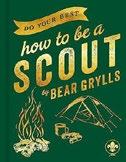
Tips and guidelines for Scouts and would-be Scouts from TV presenter Grylls, the Chief Ambassador of World Scouting. British adventurer Grylls packs this compact handbook with pep talks and practicalities in roughly equal measure. So, thickly interspersed with general instructions for erecting a tent, building a fire (with a blank page to rip out for kindling), foraging in the wild (“Grasshoppers. Only eat the body, not the legs, wings and antennae”), and dozens of other outdoorsy camping and survival topics, readers will find prompts to maintain that can-do attitude and rousing, inspirational slogans from (naturally) “Be prepared” to “Most of all, don’t count the days. Make the days count.” The author emphasizes that “Scouts is open to all,” skipping mention in the brief outline of Scouting history of the movement’s long struggles with inclusivity in terms of race, sexual orientation, and gender. Still, for intrepid and armchair explorers alike, he has plenty to offer, from navigation tricks and no fewer than 13 ways to use the standard-issue kerchief in emergencies to the values of team play, sustainable living,
MARCH 1, 2024 107 KIRKUS REVIEWS CHILDREN'S
worthy role models, and leaving one’s comfort zone. “After all,” he writes, “adventure is a state of mind.” The monochrome illustrations include plentiful diagrams as well as human figures who are diverse in both skin tone and gender.
Hefty helpings of useful bits and motivational advice for enjoying the great outdoors. (Nonfiction. 10-15)
Teddy vs. the Fuzzy Doom
Hallett, Braden | Annick Press (288 pp.)
$19.99 | April 2, 2024 | 9781773218557
Series: Secrets of Ravensbarrow, 1

An eruption of evil hamsters at school throws up gut-wrenching challenges for new student Teddy TylerMeier in this series opener. Formerly known to all as “Pukey Bear” after chronic anxiety issues caused him to vomit onstage before his entire school, Teddy hopes to make a fresh start at Ravensbarrow Elementary, deep in the Canadian pine woods. But his arrival coincides with that of a horde of hamsters with the terrifying power to turn everyone into mind-controlled zombie puppets. As it turns out, being doused in milk can turn them back into cute, harmless rodents—but, alas, even a slight taste or mention of the revolting stuff gives Teddy monumental heaves. Fortunately, Teddy finds ready allies in a remedial class of, as he puts it, “oddly inclusive weirdos,” including blue-haired Tienna, who has “impulse control” issues, and Shane, who insists that he “ can read, just slowly.” Unfortunately, the invading hamsters turn out to be crafty as well as evil, and when push comes to shove, there’s only one way to stop them—or as Tienna repeatedly puts it, “Sometimes you’ve just gotta drink the milk!” Hallett floods the pages with monochrome views of pop-eyed, comically terrified students, menacingly toothy hamsters,
and glassy-eyed victims; the results of Teddy’s frequent upheavals are, happily, confined to soggy puddles and outsized sound effects. Teddy reads white; supporting characters present as racially diverse. Buckets of fun and spooky doings. (Comic horror. 8-11)
A Place for Feelings
Haydu, Corey Ann | Illus. by Geeta Ladi Katherine Tegen/HarperCollins (40 pp.)
$19.99 | April 23, 2024 | 9780063269453
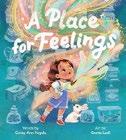
Big feelings needn’t be scary.
For Mara, “There’s a place for everything!” She’s tucked treasures—even pieces of items she broke unintentionally—into special receptacles. After a confrontation with an angry playmate, Mara realizes that she doesn’t have a place for her “terrible feeling.” Mom explains that one can also keep feelings stored away; hers are in a jewelry box. Mom also divulges where Mara’s brother and dad keep theirs—his closet and the freezer, respectively. Mara figures there must be a feelings repository for her. She tries some ideas, but her feelings don’t fit anywhere. They burst from her dollhouse and can’t be contained within her family’s hiding places. Mara’s emotions are “too big, too wild”; there simply isn’t room for them. Oh, but there is: They fit everywhere. Images depict colorful lines and shapes wafting through the neighborhood, to everyone’s delight. The idea that it’s OK to feel big emotions and helpful to share them with others is an important one. It’s not conveyed convincingly, however, and the ending, while uplifting, strains credulity and ignores the fact that little ones do need to find ways to keep complex emotions in check. Lively illustrations, created digitally and with colored pencils, depict Mara and her family as tan-skinned; background characters are diverse in
terms of race, ethnicity, age, and physical ability.
Heartfelt but overly idealistic.
(Picture book. 4-7)
Finding the Way to Faraway Valley
Heikkilä, Cecilia | Trans. by Polly Lawson Floris (40 pp.) | $17.95 | April 9, 2024
9781782508540

Two bears make a miraculous journey. A little bear asks Grandpa about the postcard on his fridge depicting a beautiful landscape. “That’s Faraway Valley,” Grandpa says. It’s a distant place, home to wonderful animals. The child yearns to go; Grandpa promises they will. They make a long voyage by sea. Upon arrival, they set out on a difficult woodsy trail. They eventually find a ruined landscape that looks nothing like their postcard. Bitterly disappointed, they surmise that they’ve arrived “too late” and prepare to leave. But a crashing sound behind them stops them: Faraway Valley’s storied animals—an elk, wolf, fox, goat, and others—appear, beckoning them to follow through woods and hills. Next morning, the bears awaken to a breathtaking view and know that this is actually their longed-for destination. That night, Grandpa says he’ll remain permanently to protect the land, but it’s the cub’s duty to go back home and teach others to “love the places of beauty we have left.” Back at school, the little bear recounts the adventure and vows to return one day. This gentle clarion call to protect Earth’s wild spaces was originally published in Sweden, then translated into English for publication in Scotland. Its message should be heard globally, in every language. Delicately lovely watercolor, gouache, pastel, and digital illustrations capture our planet’s fragile beauty. Faraway Valley is closer to home than we may realize, and we must all protect it. (Picture book. 5-8)
KIRKUS REVIEWS 108 MARCH 1, 2024 CHILDREN'S
Appealingly light and gentle, with a sprinkle of good-natured mischief.
SEASHELL KEY
Seashell Key
Heuer, Lourdes | Illus. by Lynnor Bontigao
Amulet/Abrams (80 pp.) | $14.99
April 30, 2024 | 9781419767418
Series: Seashell Key, 1

The kids who live at a beachy vacation town make their own fun. Summer has begun at Seashell Key, and the local children are ready. Heuer divides the book into four stories, each an “act” made up of a few short chapters. First up is Mateo, who’s inspired by his father’s Sky and Sea Shop to start his own business making animal kites. In Act II, sisters Sophia and Sasha have a beach picnic. The girls’ wildly different personalities come through: Sasha’s an organized, grounded, and studious artist, while the free-spirited Sophia is imaginative and mischievous. The third and funniest story involves the trio of siblings who live in the lighthouse and decide to lure in tourists for a delightfully spurious tour of their home. The final act brings all the kids together. Sasha draws them all, and they enjoy Mateo’s kites before having a fruity dessert. The island setting almost feels like a character itself, and the mild conflicts make the book ideal for sensitive beginning readers. Short sentences and paragraphs are broken up by engaging illustrations, resulting in an unintimidating chapter book for reluctant or struggling readers. In the illustrations, Mateo is darkskinned, Sasha and Sophia present Black, and the lighthouse trio present white. Final art not seen. Appealingly light and gentle, with a sprinkle of good-natured mischief. (Chapter book. 5-8)
Of Words and Water: The Story of Wilma Dykeman— Writer, Historian, Environmentalist
Hitchcock, Shannon | Illus. by Sophie Page Reycraft Books (32 pp.) | $18.95 April 16, 2024 | 9781478870371

Seven years before Rachel Carson’s Silent Spring (1962) was published, Wilma Dykeman’s The French Broad (1955) illuminated the devastating effects of pollution.
Featuring striking illustrations that make use of clay, paper, fabric, and wire, this book tells the story of Wilma Dykeman (1920-2006), a lesser-known pioneering environmentalist. Text presented in small but clear hand-lettering recounts her solitary childhood in the Blue Ridge Mountains, where nature was her constant companion. In winter, when her mother read aloud, Wilma fell in love with “the sound of words.” When her father died, the 14-year-old Wilma “knew her life would never be the same.” After earning a college scholarship, she left her mother and the mountains she loved. Following college, she met James Stokely, and her life changed again. Together, they lived in the Smoky Mountains and researched the lives of those who lived along the French Broad River, uncovering the water pollution that plagued their neighbors along the river. The publisher who accepted Wilma’s book about the river wanted her to excise the pollution story; she refused. Her aim was to inspire everyone to clean up the water; she argued that factories and businesses could coexist with clean water, to everyone’s benefit. She wanted to “use words to fight injustice,” and she did,
in columns, books, and speeches. The author’s note adds details that deepen this stirring story. The pictures, many double-page spreads, dominated by blues and greens, are enthrallingly fresh.
Elevates a conservationist who deserves to be far better known. (Picture-book biography. 6-8)
On a Summer Night
Hopkinson, Deborah | Illus. by Kenard Pak Chronicle Books (56 pp.) | $18.99 May 14, 2024 | 9781797200132
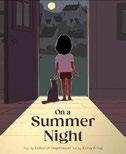
What is it that wakes up a child, a house cat, and other sleepers on a hot summer night?
There’s a subtle clue to the cause in Pak’s dim, serene scenes as a brown-skinned child, limned in the thinnest hint of golden light, rises from bed and heads to the backyard to walk in dew-flecked grass, to feel the warm dirt against bare feet, and to gaze up at the night sky. Meanwhile a cat follows along, a small dog barks across the way, a rabbit peeks out from behind a bush—and opposite each scene, we see a page filled with a dark grayish-brown block of color that retreats as a pale wedge of color slowly expands. At last the sleepers all go back to their beds, a cloud passes in the sky, and the conundrum’s answer washes in: “Bright, bright! / The light crosses the table, / climbs the stairs, / smooths the sheets / on your bed. / Mysterious, golden, / and round.” The short, deliberate phrases of Hopkinson’s verse and the simple illustrations with their subdued overall lighting combine to slow the nocturnal episode down to a properly and irresistibly snoozy pace. Spare, rhythmic, luminous…nighty night. (Picture book. 3-6)

MARCH 1, 2024 109 KIRKUS REVIEWS CHILDREN'S
For more by Deborah Hopkinson, visit Kirkus online.
You’ll Always Be My Chickadee
Hosford, Kate | Illus. by Sarah Gonzales Chronicle Books (32 pp.) | $17.99
April 30, 2024 | 9781797214375
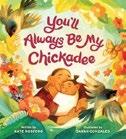
A parent and a child explore the world, with their love at the center of it.
“Fly right over here to me,” the parent proclaims; “You’ll always be my chickadee.” The loving parent embraces the little one, whose arms are spread wide as a chickadee soars in the sunny background. Lilting rhyme and bright images showcase moments of wonder, discovery, delight, curiosity, and, above all, love as the two move through their day. They spend time in the garden, explore a lush forest, cannonball into a chilly river, and luxuriate in a glorious, flower-filled meadow. On each spread, brief verse describes the world around them (“Fir and cedar, spruce and pine, / branches, roots that intertwine”) before focusing on the love they share, culminating in the phrase “You’ll always be my…” (“sugar beet,” “evergreen,” “forest friend,” etc.). The rhyme scheme is sweet and playful. Gonzales’ illustrations, a combination of digitally edited watercolor, gouache, and colored pencil, are soft and vibrant, at times appearing to glow from within. Though there’s no shortage of picture books devoted to the parent-child bond, this one more than holds its own. Seemingly meant for a warm lap, this title is perfect for a snuggly read-aloud; it’s a heartfelt reinforcement of the secure and loving relationship between child and caregiver. Both characters are brown-skinned. A golden-hued love song, both for treasured children and for the outdoors. (Picture book. 2-5)

The natural balance between life and death looks decidedly unsteady in this nail-biter.
BREAKERS OF THE CODE
Breakers of the Code
Hunter, Erin | Harper/HarperCollins (208 pp.)
$19.99 | Feb. 6, 2024 | 9780062967008
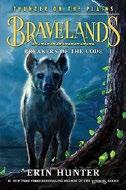
Series: Bravelands: Thunder on the Plains, 2 Conflicting loyalties and a continuing struggle for leadership of the beleaguered water buffalo herd signal an ominous resurgence of death’s spirit, the Great Devourer, on the African plain.
intents or guilty secrets. Still, the closing affirmation of Starlight, the wise Great Mother elephant, that “miracles are all around us” offers a morsel of hope to carry readers to the next episode.
The natural balance between life and death looks decidedly unsteady in this nail-biter. (Animal fantasy. 11-13)
Benny Ramírez and the Nearly Departed
Iriarte, José Pablo | Knopf (272 pp.) | $17.99 April 30, 2024 | 9780593703700
For more by Kate Hosford, visit Kirkus online.
In this sequel to The Shattered Horn (2023), visionary hyena Breathstealer is pushed to choose between the high principles of the life-nurturing Great Spirit and her own species’ ancient loyalty to the Great Devourer, the bringer of death (and therefore food). The unexpected return of young Echo to the buffalo herd rekindles a battle with massive, murderous bully Holler for dominance on the dusty, dry-season grasslands. Meanwhile, the cheetah Stride and his gruff companion, Stonehide the honey badger, have both caught tantalizing glimpses of their dead mates, who are trapped, along with other animal spirits, by the Great Devourer and are therefore unable to ascend to the stars. Though a brief encounter with a chattery colony of meerkats lightens the tone for at least a moment, overall, the atmosphere is one of heavy impending doom. The events tend toward angry disputes and savage clashes (not to mention eerie, unnatural eruptions of stinging scorpions and insects) involving multiple characters nursing bad

When Latin music great Ignacio Ramírez dies, his path to a rewarding afterlife is hindered by unfinished business that demands resolution.
Not only is Benny Ramírez the grandson of a famous Cuban American musician, but everyone else in his family has a talent, too: Papi is a well-regarded Hollywood producer, Mami has a gift for languages, older sister Cristina is a star dancer, and younger brother Manny is a promising actor. When the family inherits Benny’s estranged grandfather’s Miami home after his death, they leave Los Angeles, and the Ramírez kids enter the South Miami Performing Arts School, where Benny, who feels like he isn’t special, struggles to fit in. Fortunately, his musician abuelo’s spectral presence is tied to his mansion, unable to move on. Ignacio must figure out what his unfinished business is and resolve it
KIRKUS REVIEWS 110 MARCH 1, 2024 CHILDREN'S
by New Year’s. Only Benny can see Abuelo, who insists that helping Benny follow in his footsteps to become a world-famous trumpet player must be his unresolved task. Unfortunately, Ignacio has a history of egocentric behavior and little respect for boundaries, which leads Benny into many scrapes. The plot is reminiscent of other ghostly redemption tales, reinforcing the moral that family and community are more valuable than riches and fame. Iriarte writes with a lighthearted touch and includes ample physical comedy; the humor and Cuban American cultural touchstones make this work a welcome addition to the genre. A humorous and haunting riff on a classic storyline. (Paranormal. 8-12)
The Recess Genius 2: Tons of Talent
Johnson, Janet Sumner | Illus. by Stacy Ebert Pixel+Ink (40 pp.) | $18.99 | April 30, 2024
9781645951414 | Series: The Recess Genius, 2
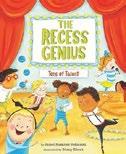
Regina the Recess Genius is solving her classmates’ problems again, this time in one fell swoop. It takes a lot of thinking to puzzle out the solution to Aimee’s problem. Aimee is planning a talent show, but no one has signed up. Several other kids come to Regina with their troubles: Kennedy feels overshadowed by attention-grabbing Bella, James doesn’t know how to tell his soccer teammates that he also takes ballet,
and Michael frets about being able to make it to a far-off bathroom. Regina decides that the talent show can solve everyone’s issues. The prizes are just what her classmates need: recognition, money (so James can buy his teammates a new ball), and the “Hall Pass of Hall Passes.” But while Aimee’s show is a rousing success for her, the prizes end up with the wrong students. That’s when Regina’s talent kicks in. Michael’s problem seems like one an adult should be involved in solving, and buying his teammates’ affection hardly seems like the ideal solution to James’ issue. Still, the Recess Genius isn’t portrayed as the introvert bookworm she was in the first book; instead, she takes a far more active role. In the cartoon images, Regina and her classmates show tons of personality. Regina, Bella, and Kennedy present white, James and Aimee are brownskinned, and Michael appears Asian. A more satisfying outing for our hero than her previous one. (Picture book. 4-8)
Monti and Leo: A Newcomer in Pocketville
Kantorovitz, Sylvie | Walker US/Candlewick (80 pp.) | $16.99 | April 16, 2024
9781536222777 | Series: Monti and Leo, 1
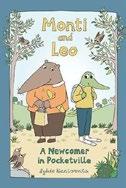
A friendly mole learns that strangers aren’t always so strange.
Pocketville, as its welcome sign advertises, is “a quiet little town”—“And we like it that way!”
A friendly mole learns that strangers aren’t always so strange.
MONTI AND LEO
When a new resident, Leo the lizard, moves in, Mrs. Sheep, the baker, starts gossiping about him. Monti the mole is initially annoyed at Leo; the lizard takes Monti’s favorite resting spot, buys the last cinnamon rolls, and checks out the library book Monti wanted. But Leo is also kind and willing to share. The two become fast friends, and when Mrs. Sheep gossips about Leo again, Monti speaks up. He also introduces Leo to his friend Harriet’s music, and they decide to mount a talent show. Though the villagers are reluctant to take part, Monti performs some savvy ego inflation to get Mrs. Sheep on their side, and soon everyone is following suit. Seasons appear to progress from spring to winter over the course of the book’s four chapters. Monti and Leo’s friendship radiates warmth throughout. It’s clear that kindness and hostility are choices, and this tale shows that the capacity for both exists in everyone, from mild-mannered Monti’s brief bouts of irritation to a surprisingly gracious moment courtesy of Mrs. Sheep. With their long snouts, Monti and Leo cut endearing figures in Kantorovitz’s rounded, spare cartoonish art. Most pages contain two to four panels, making the characters’ exploits as easy to process as the relatively short sentences. New neighbors, attitudes, and ideas are worth embracing in this community-minded tale. (character sketches) (Graphic fiction. 7-9)
The Secret Language of Birds
Kelly, Lynne | Delacorte (240 pp.) | $17.99 April 9, 2024 | 9781524770273

After 13-year-old bird lover Nina discovers rare whooping cranes nesting near her summer camp, she must keep them safe—and secret.
Ever since a mockingbird sang her name and led her to his nest,
>>>
MARCH 1, 2024 111 KIRKUS REVIEWS CHILDREN'S
THE KIRKUS PROFILE: G. NERI
The author embarks on an expedition to Antarctica—and proves it’s never too late to unleash your inner scientist.
BY MAHNAZ DAR
SOME WRITERS step outside their comfort zones; in preparation for his latest middle-grade work, G. Neri catapulted out of his. In 2017, the award-winning author spent two months in Antarctica, where he walked on land untouched by humans, camped at the foot of a calving glacier, and earned the nickname the “Penguin Whisperer.” The book he wrote upon his return, My Antarctica: True Adventures in the Land of Mummified Seals, Space Robots, and So Much More (Candlewick, March 5), illustrated by Corban Wilkin, is an insightful and probing account of this unforgettable journey. “I don’t think there’s a day when I’m not touching Antarctica in some way,” he tells Kirkus via Zoom from his home in Tampa.
My Antarctica is in many ways a departure for Neri, who’s best known for realistic fiction and picture-book biographies of artists.
Growing up in Florida, he had little exposure to snow and ice. And though he fantasized about becoming an explorer or scientist like Ernest Shackleton or Jane
Goodall, he never thought he’d actually follow in their footsteps. Science didn’t come naturally to him, and, as a person of color, he rarely saw scientists who looked like him.
But Neri kept his dreams alive. When he learned that the National Science Foundation offered writers and artists grants to travel to Antarctica, he seized the opportunity. Dubbing himself the “science translator,” he realized that his lack of STEM savvy could serve as an asset. As he told the program’s director, “I’m the perfect person to send to [Antarctica], because as a kid, I just didn’t get science....I could find a way in to tell that story about different scientific endeavors going on down there. Then kids like [me] could actually understand it and be inspired.”
In Antarctica, Neri says he often felt like a child himself. Everything was thrilling: the centuries-old mummified seal carcass he saw; the bizarre undersea life, like a 30-foot-long glow-in-the-dark jellyfish; and, of course, the many penguin encounters.
Neri was reminded of his time teaching animation workshops to young people in Compton and East L.A. in the ’90s. “I’d be talking to kids who were in middle school or high school who had never seen the ocean, and they lived about a half hour from it,” he recalls. When he arranged a trip to the beach for some of those students, he was struck by their excitement. When he arrived in Antarctica, he says, “I had the same awe and wonder that those kids had at seeing the ocean.”
Channeling his inner child came in handy when speaking to scientists, many of whom had no idea how to discuss their research in ways a layperson would understand. “You have to play 6-year-old,” Neri says. He would ask the scientists questions: “‘What does that mean? Why are you
doing that? What is that supposed to do?’ And after about half an hour, you finally realize, OK, you’re using these long-distance air balloons to capture stardust so you can determine the origin of the universe. And they look at you, like, Yeah, I guess that’s what we’re doing.”
Neri observed a variety of scientists in action, from astrophysicists and geochemists to biologists and paleobotanists. He quickly learned a key rule in Antarctica: “You could spend a year or two prepping for a trip, but nothing will happen as planned because the weather is so extreme.” Improvisation and flexibility were key; he remembers seeing scientists duct-taping an expensive piece of equipment to a boogie board to get it to float.
At times, Neri felt out of his element. He explains,


CHILDREN'S // PROFILE KIRKUS REVIEWS 112 MARCH 1, 2024
Edward Linsmier
There’s a saying down there that Antarctica literally changes your DNA.

My Antarctica: True Adventures in the Land of Mummified Seals, Space Robots, and So Much More
Neri,
G.,
illus.
by Corban Wilkin
Candlewick | 96 pp. | $18.99 March 5, 2024 | 9781536223323
“There’s nothing more humbling than being stuck in a remote camp…playing science trivia with a roomful of brilliant scientists.” But he later learned that those scientists were just as impressed by his work as a children’s book author. “I think they understand the power of storytelling,” he says. “Because without the story, they don’t exist. In other words, if they can’t get the word out and the public can’t understand it, then the funding dries up. There’s nobody interested in what they’re doing.”
His first version of the book was a graphic novel brimming with facts. “It was so dense with information that it just overwhelmed your brain,” he says. “You couldn’t remember
anything, because you were so inundated.” Neri realized that most of all, he wanted to capture his sense of wonder, and the book evolved from a graphic novel to a heavily illustrated prose work. “What I ended up doing was taking out the answers and just leading with the questions, and it became a book about questions.” He likens his book to a magician’s trick. “You’re like, How did you do that? And then they explain it to you, and it takes all the magic away. To me, Antarctica is a place that’s filled with magic. And I wanted to leave that experience with the reader.”
Unlike most authors, Neri has creative control over the visual and design elements of his work. He initially laid out My Antarctica in
PowerPoint, incorporating photos he’d taken himself in Antarctica along with comic book illustrations of himself; the book’s artist, Wilkin, ultimately used these materials as the basis for his own art. Neri worked closely with the designer, weighing in on everything from font choices to the brightness of the colors on the page. “The way I do books is totally different from the way most people do books,” he says.
Neri may be back in a warmer climate now, but his journey has deeply affected him. “There’s a saying down there that Antarctica literally changes your DNA,” he says. “I came back and formed and am co-chair of a group called the Antarctic Artists and Writers Collective. I’m part of
a group called Polar STEAM, which now facilitates that grant that I [received] and also [offers] grants for educators to go to Antarctica....And I’ve given hundreds and hundreds of talks all over the country about Antarctica.” He adds, “For a person who had no involvement in STEM-related activities even two years prior to this, the way it’s changed my life since then has been pretty profound.”
And, as a person of color, he’s helping to make what was once an overwhelmingly white field far more inclusive. “Seeing is believing,” he says. “If you don’t see anybody like you doing this thing, then you just assume it’s not for you, especially if you’re a young person.” School visits are an important part of his work for that reason; he even did virtual visits from Antarctica. “That goes for gender as well,” he adds.
“Antarctica, of course, started as a completely male world. But when I was there…maybe 65% of the people I dealt with were women.”
Above all, Neri wants young people to realize that they, too, can pursue their dreams—no matter how unlikely those dreams might seem. While it can be tempting to label ourselves— artist or science lover —he cautions against doing so. “There’s a great quote in the last book I did, a picture book about Christo. And one of the things he would say is… labels are great, but only for bottles of wine.”
“Anything is possible…if you take chances and you say yes to things,” he says. “It’s all about putting yourself out there, planting seeds, and seeing what comes up.”
PROFILE // CHILDREN'S
MARCH 1, 2024 113 KIRKUS REVIEWS
Nina has been obsessed with birds— she finds them easier than people. Nina has trouble with boundaries and making friends: “It’s like there are rules everyone knows but me.” She decides to try Aunt Audrey’s summer camp in Bee Holler, so she can bird-watch, but she feels like an outsider among the other campers. When Nina spots a whooping crane in an off-limits area of camp near a marsh, she can’t risk telling Aunt Audrey and being sent home for breaking camp rules. But whoopers haven’t been seen in her part of Texas for 100 years! Nina must trust fellow new campers Georgie, Emma, and Ant with her discovery if she’s going to solve the mystery of where the birds came from. Doing that just might help Nina figure out friendship, too—if they don’t get kicked out of camp first. While the narrative pacing is sluggish at time, this sweet tale rewards readers with interesting bird facts and classic middle school cringe moments. Fans of Iris, the protagonist of Kelly’s Song for a Whale (2019), will enjoy meeting her again here as a supporting character, although this title stands alone. Nina is cued white; there’s some racial diversity among the secondary cast members. A slow but cozy and relatable read for nature lovers and those unraveling the mystery of friendship. (Fiction. 8-12)
The Door Is Open: Stories of Celebration and Community by 11
Desi Voices
Ed. by Khan, Hena | Illus. by Chaaya Prabhat Little, Brown (335 pp.) | $17.99
April 23, 2024 | 9780316450634
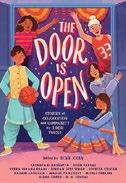
Eleven authors tell interconnected stories about identity and belonging in their South Asian American New Jersey community. Each story revolves around an event at the bustling Maple Grove Community Center, a
A multifaceted celebration of a vibrant American community.
hive of cultural activities, celebrations, tournaments, and sporting events. In Mitali Perkins’ “Smile Number Seven,” Steven, an adopted boy with special needs, wants his mother to be his badminton partner. In “Out in the Open,” by Rajani LaRocca, student journalist Veda holds up a mirror to her family, forcing them to recognize the unfair burden they put on her mother.
Duaa, in N.H. Senzai’s “Answered Prayers,” uses her technical savvy to save the day at a fundraiser. And, in “The Map of Home,” by Sayantani DasGupta, Munia and her band challenge racism. These middle schoolers with varied interests create a wonderful mosaic representing a diverse community. Readers learn that the community center is in danger of being shut down because some people oppose both its activities and “the people who use it.” The stories explore the idea of who belongs and examine thorny issues, including gender roles, domestic violence, and racism. Though the stories only feature characters of Indian or Pakistani heritage, there’s a richness of regional representation (including Gujarati, Maharashtrian, South Indian, and Bengali), as well as religious diversity (such as Hindu, Muslim, Christian, and Sikh). Families with single and divorced parents, multigenerational households, and blended families also appear. Final art not seen. A multifaceted celebration of a vibrant American community. (author bios) (Anthology. 9-12)

The Wishkeeper’s Apprentice
Khoo, Rachel Chivers | Illus. by Rachel Sanson Candlewick (240 pp.) | $16.99 | April 16, 2024 9781536231205
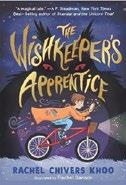
“In my experience, almost all wishes are possible.”
Ten-year-old Felix Jones might as well be invisible. His best and only friend, Max, has moved away, and Felix’s very existence seems to irritate his college-aged sister, Rebecca. In contrast, solitary, overworked wishkeeper Rupus Beewinkle is supposed to be invisible to the residents of the quiet seaside town of Whittlestone. To Rupus’ surprise, Felix can see him, which prompts Rupus to grant his own wish and appoint Felix as his apprentice. Vexed by wish snags that undermine his work, Rupus suspects that a wishsnatcher is at large, a creature long believed extinct that bears a striking resemblance to the wolf-man of Felix’s recurring nightmares. After a series of events threatens to destroy all the wishes in Whittlestone, Felix must face his fears—and the wishsnatcher—to save the day. The well-constructed setup and dreamy, scene-setting exposition are enticing; Rupus’ home is a cozy oasis. The monochrome illustrations, consisting of two-page spreads that create immersive tableaux, along with spot art that supports comprehension of the text, are charming and an essential part of this work’s delightful appeal. The significant age gap between the siblings highlights the mutable transitions of the tween and young adulthood years and functions as a well-designed plot device.
KIRKUS REVIEWS 114 MARCH 1, 2024 CHILDREN'S
OPEN For an interview with Hena Khan, visit Kirkus online.
THE DOOR IS
A walk on the moon has never been this fun.
ONE GIANT LEAP
A concluding time jump, however, misses the mark in further plumbing Felix’s emotional depths. Major characters read white. A sprightly and wholesome magical adventure. (map, recipe) (Fantasy. 8-12)
The Wild Ones
Lacera, Megan & Jorge Lacera Illus. by Jorge Lacera | Lee & Low Books (48 pp.) | $22.95 | April 7, 2024 | 9780892394524
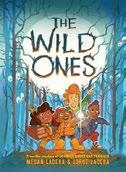
A monster surprise emerges from the forest just when a group of friends need it the most.
Valentina and her best friends, Jasmine, Andy, and Xander, live in an apartment complex at risk of being torn down by developers to make way for “businesses that all look the same.” Certain that there’s a monster hiding in a nearby forest, the kids decide to find the creature and use it to scare away the developers. Each believes the monster hails from their own country of origin.
Valentina thinks it’s La Tunda, a Colombian creature with a leg made from a wooden kitchen utensil. Xander thinks the creature is Loogaroo, a Haitian vampire witch, while Andy believes that it’s the Irish banshee, and Jasmine is convinced they’re after the Indian Vetal. Though other kids in the neighborhood mock the protagonists, telling them to go back to where they came from, the quartet stick together and go in search of the creature. Full-color panels of
charming digital illustrations make this an accessible graphic novel, and the main characters’ enthusiasm results in a lighthearted tale interspersed with details about folklore. Despite the monstrous subject matter, the creatures aren’t all that creepy, and in the end, the community is pleasantly surprised when the friends solve their mystery. Wild monsters from diverse cultures lurk (and smirk) in this not-so-scary story of fighting for home. (information about the monsters) (Graphic fantasy. 6-10)
One Giant Leap
Lam, Thao | Owlkids Books (48 pp.)
$18.95 | Feb. 27, 2024 | 9781771475990
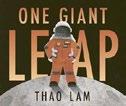
A walk on the moon has never been this fun. An unnamed, tan-skinned child bundles up in a jacket, checkered gloves, and a hat and takes an elevator to the surface of the moon. A wordless journey begins as the protagonist sets foot on the dusty exterior, jumps over moon rocks with gravity-less abandon, and plants a purple-checked flag on the very top. After taking a tumble from the summit, the child sees clawed footprints in the dust and eventually comes across large paisley-printed birdlike creatures and brightly colored space monsters. Our hero attempts to communicate with these creatures but flees after one waves its arms menacingly. The child bounds for safety from both the monsters and the extreme elements. The expedition ends when the child flings a door
open to see other young people putting their coats away as a snowy school day is about to start. The final spread shows the inclemently weathered path taken by our intrepid explorer from an apartment building across the way to the schoolhouse. Eagle-eyed readers will notice the patterns of the classmates’ coats matching those of the creatures encountered on the moonwalk as well as the rough terrain mimicking the school playground. The collage illustrations, in a palette dominated by deep blacks and oranges, capture the spirited imagination of a young person at play.
An out-of-this-world good time. (Picture book. 4-8)
Built To Last
Lê, Minh | Illus. by Dan Santat | Knopf (40 pp.)
$18.99 | April 30, 2024 | 9780593569177
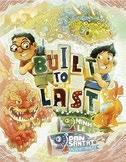
A friendship is built and tested. Two friends are brought together with a “BANG” when they bump into each other, knocking over the block towers they were working on. The children, who both have warm beige skin and short black hair, leave their individual projects aside to let their imaginations run wild as they create together. The results are spectacular, if prone to disaster: Their Great Wall is dismantled by a Chinese lion, their lantern-lit boat is capsized by a dragon, and a monster levels their cityscape. Still, the friends seem to find as much joy in the destruction as the building of each new structure. Then they start a new construction, one meant to “stand the test of time.” When this, too, collapses, the friends find themselves at an impasse. Can they find a way forward together? Readers will have fun comparing the fantastical worlds the friends occupy with the cardboard-and-tape reality in which they
MARCH 1, 2024 115 KIRKUS REVIEWS CHILDREN'S
are actually working. Onomatopoeic words are illustrated with force; “CRASH!” judders across the page, and “KABOOM” glows with intensity, promising a satisfying read-aloud experience. With inventive imagery and a relatable conflict, this is a winning selection for crowded storytimes and quiet bedtimes alike.
A playful and captivating tribute to imagination and friendship.
(Picture book. 3-7)
A Real Lion Story
Legge, Krista | Illus. by Natallia Bushuyeva Clavis (32 pp.) | $19.95 | May
21, 2024
9781605378121

A toy lion discovers who he really is. Leroy goes everywhere with his beloved guardian, Addie—OK, not the bathtub. Leroy enjoys being a stuffed lion until he sees real lions during family movie night. Leroy is mesmerized. THOSE are lions—fierce, regal protectors! At dawn, Leroy makes big plans. He loves Addie, but it’s time for him to be a real lion. When Addie leaves for school, Leroy heads downstairs and hops out the window. The ground is harder than expected, but, standing up, Leroy repeats a mantra: “I am fierce! I am king! I am the protector!” Outdoors, his resolve is tested by a bird, a cat, and an icy wind. Gazing wistfully at the house, Leroy understands he is really a protector of… Addie. He quickly returns to her room—just as she’s coming back from school. Cleaning Leroy up after his hardy adventure, Addie hugs him… fiercely. Originally published in Dutch, this is a sweet, gently humorous story about figuring out who you are. Young readers will be assured that it’s OK to take small steps toward independence and that no matter what, they’ll always be welcomed back into familiar surroundings by those they love. Accompanying the text are
A tour of the solar system in prose, poetry, and prosody.
A PLANET IS A
cozy vignettes in a limited palette of mostly light orange, white, and gray. Addie has skin the white of the page. No lion about it: This makes for very enjoyable reading, cuddled up with a favorite toy. (Picture book. 4-7)
Kirkus Star
Mr. Pei’s Perfect Shapes: The Story of Architect I.M. Pei
Leung,
Julie | Illus. by
Yifan Wu Quill
Tree Books/HarperCollins (40 pp.) $19.99 | May 28, 2024 | 9780063006300
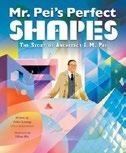
A tribute to the distinctive approach and sensibility of the renowned modernist architect.
In language as simple and stately as her subject’s best works, Leung traces the long career of I.M. Pei (1917-2019) from childhood encounters with the intricately water-sculpted volcanic rocks in the gardens at Suzhou to his design of an art museum for the Chinese city many decades later. In between, she follows him to Shanghai and then the U.S., where he trained in his vocation, became a citizen, and, after winning a breakthrough commission to design the John F. Kennedy Presidential Library, went on to a long and distinguished career. The author artfully develops her thesis that Pei “could foresee how the shape of a building must harmonize with nature, with people, and with time” by describing how he solved potential challenges in some of his iconic
buildings, such as the tall but slender Bank of China tower in Hong Kong with its innovative diagonal bracing, as well as the daring but now iconic glass pyramid at the Louvre. (The Rock & Roll Hall of Fame in Cleveland, alas, gets just a bare mention in the closing timeline.) In Wu’s clean and lovely illustrations, Pei stands amid fanciful, harmoniously hued geometric shapes that tumble kaleidoscopically through his thoughts before flowing naturally, effortlessly, into structural components. Buildings and people alike seem to stand with graceful but monumental solidity.
Acute and rich in insight. (selected sources) (Picture-book biography. 7-9)
A Planet Is a Poem
Lewis, Amanda West | Illus. by Oliver Averill Kids Can (40 pp.) | $19.99 | May 7, 2024 9781525304422

A tour of the solar system in prose, poetry, and prosody. Atop Averill’s dramatic, impressionistic views of solar explosions, gas giants floating on starry backdrops, and craggy planetary landscapes, Lewis floats 14 poems in as many forms, each on a gatefold flap concealing general descriptions of both the poem’s type and subject. The tour kicks off with “A Sonnet for the Solar System” (“A family made of many complex parts, / Our solar system’s great adventure starts”), an analysis of the typical metrics and structure of a Shakespearean sonnet, and an overview of
KIRKUS REVIEWS 116 MARCH 1, 2024 CHILDREN'S
POEM
our solar neighborhood from the sun to the Oort Cloud. From there on, Venus, for example, gets a villanelle, Saturn a sestina, Jupiter’s striped disk is filled with a round concrete poem, and the Kuiper Belt (“a belted donut salsa on stormy seas”) a “prose poem,” recognizable as such by a preponderance of images and metaphors. “Scientists,” she writes, “use metaphors all the time to help us understand what’s in our universe.” In both prose and hip-hop–style verse, she closes with invitations to “future astronomers” and other readers to keep the outward flight going. The poems show clearer signs of deliberate composition than inspiration, and the factual payload (mostly, the author acknowledges, drawn from a single NASA website) is relatively light; still, budding wordsmiths and skywatchers alike will find the ride worth taking.
Occupies both scientific and literary orbits, ably if not incandescently. (glossary, resource lists) (Informational picture book/poetry. 7-10)
Cloudlanders
Mackie, Christopher | Kelpies (288 pp.) $9.95 paper | April 2, 2024 | 9781782508403

The existence of the island nation of Bastion depends entirely on its ability to remain airborne. A monster sank all the other countries, and Bastion was the sole survivor. Seeking an escape, its citizens built a huge wall around the island, using an enormous deposit of lightstone quarried from its depths. The lightstone floated up and away, carrying Bastion to its new home above the clouds, but the digging awakened magical creatures beneath the ground. Unfortunately, even 500 years later, the current inhabitants aren’t safe, for the monster is waiting. In the present day, readers
meet a large cast of characters, including Shroomling Kurt, Gemstone Faerie Flicker, human child Serena (who has “paper-pale” skin and auburn hair), and half human / half Wood Nymph twins Aliana and Garrett. Paladin Flint, an adviser to Queen Morgana, thwarts them at every step, caring only for personal power. And then there’s the invisible Boy, who’s the catalyst driving the whole confusing, convoluted mishmash. These and other characters endure hexes, spells, and lifethreatening trials as they attempt to save their land from the Wavewrecker monster as well as insidious enemies within. Somehow it all works: Readers will find intense and mind-stretching adventures, plot twists and cliffhangers, amazingly inventive magic, and quite a bit of humor, all fueled by steadfast relationships between the characters. It’s a hard slog, but those who stick with it will be fully drawn into the excitement. The epilogue more than hints at a sequel.
Magic of epic proportions that rewards tenacious readers. (Fantasy. 9-13)
What if You Had an Animal Home!?
Markle, Sandra | Illus. by Howard McWilliam Scholastic (32 pp.) | $23.99 | May 7, 2024 9781339049052 | Series: What if You Had . . .?
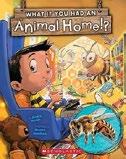
Markle invites children to picture themselves living in the homes of 11 wild animals.
As in previous entries in the series, McWilliam’s illustrations of a diverse cast of young people fancifully imitating wild creatures are paired with close-up photos of each animal in a like natural setting. The left side of one spread includes a photo of a black bear nestling in a cozy winter den, while the right side features an image of a human one cuddled up with a bear. On another spread,
opposite a photo of honeybees tending to newly hatched offspring, a human “larva” lounges at ease in a honeycomb cell, game controller in hand, as insect attendants dish up goodies. A child with an eye patch reclines on an orb weaver spider’s web, while another wearing a head scarf constructs a castle in a subterranean chamber with help from mound-building termites. Markle adds simple remarks about each type of den, nest, or burrow and basic facts about its typical residents, then closes with a reassuring reminder to readers that they don’t have to live as animals do, because they will “always live where people live.” A select gallery of traditional homes, from igloo and yurt to mudhif, follows a final view of the young cast waving from a variety of differently styled windows. Another playful imagination-stretcher. (Informational picture book. 6-8)
Trouble at the Tangerine
McDunn, Gillian | Bloomsbury (288 pp.) $17.99 | April 2, 2024 | 9781547611003
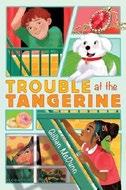
A boy in search of roots solves his first mystery. Simon Hyde, 11 ½, worries that the burglary at the Tangerine Pines apartments will result in his parents’ quickly moving from the new home that he’d hoped might be permanent. Including the most recent one, where he broke his leg in a fall from a tree, Simon lived in 27 different places before arriving in Rigsby. His parents, both digital nomads, make a living from remote work and their popular The Hydes Go Seek social media account, which details their itinerant lifestyle. Simon feels they’ve been “adrift like a clump of dandelion seeds.” He’s kept a rock collection—“one small piece of every place we’ve ever lived”—but he longs for more lasting
MARCH 1, 2024 117 KIRKUS REVIEWS CHILDREN'S
connections. When a priceless necklace goes missing, Simon, who reads white, tries to identify the thief with the help of ebullient new friend Amaya Sharma, who’s also 11. Another neighbor, retired detective Mrs. Kobayashi, offers him tips, notably, “Be patient and allow yourself to observe.” This advice turns out to be a great strategy for getting to know new friends and neighbors, including Calvin Morris, a Black boy around his age. McDunn’s characters are nicely realized, and the mystery is satisfyingly resolved.
A likable hero and a neatly plotted mystery. (Mystery. 8-12)
Free To Be Fabulous
McMullin, David | Illus. by Robbie Cathro Clarion/HarperCollins (40 pp.) | $19.99 April 30, 2024 | 9780063239685

A strong sense of self can’t shield a young boy from negativity.
Daniel is singer Fabulina’s biggest fan, and he loves to sing and dance to her hit song “Strong, Brave, Free” in his bedroom. When he learns that his school is having a talent show, he gladly signs up to sing his favorite song. After giving a passionate performance that cements his win, a joyful Daniel is met with wild applause. Despite the positive feedback, however, he’s soon overwhelmed by “The Mean,” a gaggle of red and purple ghostlike figures that represent “mean looks. Mean words. Mean jokes. Mean names.” Daniel retreats beneath a desk. Through the help of trusted teacher Mr. Edwards and a diverse group of supportive classmates, Daniel puts these negative feelings aside to gleefully dance and express his love for his beloved pop diva. Colorful digital illustrations capture the exuberant joys and the despondent lows Daniel experiences. The vague, existential nature
Young readers will be “antsy” to join the hero on her satisfying escapade.
ADDIE ANT GOES ON AN ADVENTURE
of The Mean might go over the heads of some young readers, however, while those looking to use this story to navigate similar situations will likely find the tidy ending a bit unrealistic. Daniel is light-skinned with blue hair; Mr. Edwards presents Black. Spirited illustrations carry a story that’s not quite fabulous. (Picture book. 5-8)
The Day I Fell Into a Fairy Tale
Miller, Ben | Illus. by Daniela Jaglenka Terrazzini | Aladdin (240 pp.) | $17.99 April 23, 2024 | 9781665949736
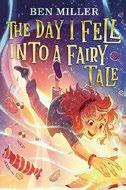
Nine-year-old Lana is bored; her 12-year-old brother, Harrison, once a constant playmate, is busy studying. The best Lana’s mother can come up with is visiting Grimm’s, the new supermarket in their quiet English village. Inside, they encounter amazing deals and one curious employee—a short, beady-eyed old man. He tries to stop Lana from taking home a book of “proper fairy tales,” which he insists are too frightening. Lana’s mother buys it anyway, and at bedtime, she starts reading Lana “Sleeping Beauty.” The next morning, the book is missing. Lana, desperate to read more, returns to Grimm’s. The odd little man shoves her into a tub of sweets, and she falls down a chute into the world of fairy tales. Lana hops through portals into different stories, where she helps the protagonists.
Eventually, Harrison joins her, and fortunately, his studious ways come in handy. Given the endless appetite for fairy-tale adventures, fans of series such as Tae Keller’s Mihi Ever After will enjoy this tale. Readers who delight in shivery scares will appreciate the pushback against sanitized literature for kids. The framing of the original, bloodthirsty versions includes subtle and valuable mentions of power imbalances and consent (as the prince says, in response to the suggestion of waking Briar Rose with a kiss, “No, I don’t think that’s right. Not without asking first. And I can’t ask because she’s asleep…”). Charming illustrations support the text. Characters are minimally described and racially ambiguous. Entertaining fairy-tale fun. (Fantasy. 7-11)
Addie Ant Goes on an Adventure
Morris, Maren & Karina Argow Illus. by Kelly Anne Dalton Chronicle Books (40 pp.) | $18.99 April 9, 2024 | 9781797228914

An ant explores her world. Addie Ant’s ready for adventure. Despite some trepidation about leaving the Tomato Bed, where she lives with her aunt, she plucks up her courage and ventures forth across the garden to the far side of the shed. On her journey, she meets her pal Lewis Ladybug, who greets her warmly, points the way, and offers sage
KIRKUS REVIEWS 118 MARCH 1, 2024 CHILDREN'S
An insightful read that highlights the struggles and strides young people make toward self-awareness.
KEEPING PACE
advice. When Addie arrives at her destination, she’s welcomed by lovely Beatrix Butterfly and enjoys an “ant-tastic” helping of watermelon. Beatrix also provides Addie with take-home treats and a map for the “Cricket Express,” which will take her straight home. Arriving at the terminal, Addie’s delighted to meet another friend, Cleo Cricket, whose carriage service returns Addie home in “two hops.” After eating a warm tomato soup dinner, Addie falls asleep and dreams of future exploits. Adorable though not terribly original, this story brims with sensuous pleasures, both textual and visual. Kids who declare that they dislike fruits or veggies may find their mouths watering at the mentions and sights of luscious tomatoes, peas, beans, watermelons, berries, and other foodstuffs; insect-averse readers may likewise think differently after encountering these convivial, wide-eyed characters. And those flowers and herbs everywhere! The highlights are the colors that burst from the pages. Addie’s an endearing, empowering character who reassures children they’ll be able to take those first independent steps successfully. Young readers will be “antsy” to join the hero on her satisfying escapade. (author’s note about ants) (Picture book. 4-7)

Keeping Pace
Morrison, Laurie | Amulet/Abrams (304 pp.) $18.99 | April 9, 2024 | 9781419768750
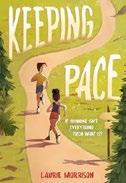
Life is a marathon, not a sprint. Don’t tell that to Grace Eller, whose one-track mind is focused squarely on academic achievement. When she’s bested for both the creative writing and “Eighth-Grade Top Scholar” awards by friend-turned-rival Jonah Perkins, her sense of self is battered. What’s an overachiever who fails to achieve? With help from older sister Celia and cousin Avery, Grace comes up with a summer goals list. She’s poised for a journey of self-exploration: Babysitting Teddy (her dad’s girlfriend’s 4-year-old son), taking an ungraded creative writing class, learning to embrace her naturally curly hair, and training for a half-marathon are all activities that uproot Grace from her comfort zone. She discovers that opening herself up to new experiences allows her to let other people in and empowers her to redefine success on her own terms. This well-paced novel is a balm for readers who may be struggling with senses of self that are narrowly defined by grades or athletic performance. The supportive sibling and cousin dynamics enrich the narrative by finding the complementary middle ground in a juxtaposition of opposites. The authentically awkward navigation of a blossoming romance fuels Grace’s journey of emotional development, while an amicable post-divorce parental
relationship tenderly reveals the uncomfortable truth that parents are people, too. Most characters are cued white; there’s racial diversity among the background characters. An insightful read that highlights the struggles and strides young people make toward self-awareness. (Fiction. 10-14)
Firefly Galaxy
Nelson, Sarah | Illus. by Estrellita Caracol Barefoot Books (32 pp.) | $17.99 April 2, 2024 | 9798888590720
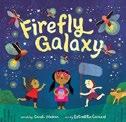
Nature at night offers a magical experience—one, sadly, now threatened by humans.
Diego, Lili, Chico the dog, Papa and Mama, and the young narrator, Sofia, are eager to view fireflies. They must be patient and quiet, until suddenly, it’s “like the sky dropped in!” as the air fills with sparkles. Sofia isn’t content just to dance with the fireflies; the child sets out to catch one—and does. Eventually the narrator’s possessiveness (“mine all mine ”) gives way to empathy, and Sofia frees the firefly and then “flies” off, “wild and free” with the other children and Chico. Text includes both rhyming verses and dialogue. The meter isn’t always consistent, and some phrasing is awkward (“The porch is hot / with wiggly feet”). In the charming, collagelike art, the hot oranges of sunset give way to violet, turquoise, teal, and navy shades. Colors form simplified flat shapes, without lines; vegetation is stylized. The narrator and Papa wear glasses; Mama, Lili, and Sofia are brown-skinned, while Papa and Diego are pale-skinned. Backmatter conveys a lot of information about fireflies, including why they flash and where they can be found, but nowhere are we told what the titular firefly galaxy is, and the visuals don’t clarify that term.
Glowing illustrations enliven this tale of nature’s delights. (Picture book. 4-8)
MARCH 1, 2024 119 KIRKUS REVIEWS CHILDREN'S
For another story of an adventurous ant, visit Kirkus online.
A Jewish family takes their newest addition to a baby-naming ceremony on her first Shabbat.
JOYFUL SONG
Kirkus Star
Joyful Song: A Naming Story
Newman, Lesléa | Illus. by Susan Gal Levine Querido (40 pp.) | $18.99 May 7, 2024 | 9781646143702
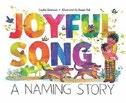
A Jewish family takes their newest addition to a baby-naming ceremony on her first Shabbat.
Mommy, Mama, and young Zachary walk the new baby to the synagogue, greeting friends. Zachary pushes the carriage as people ask the baby’s name. Zachary’s bursting to tell, but Mommy and Mama remind Zachary that the name won’t be announced until the ceremony. For now, Mama tells Miss Fukumi that they call the baby “Little Babka,” because she’s the size of one—“and just as sweet,” Zachary adds. Mommy tells Mr. Baraka that the girl is called “Shayneh Maideleh.” Zachary says, “That’s a nickname that means beautiful girl.” And Zachary tells Mrs. Santiago that they call the baby “Snuggle Bunny.” Miss Fukumi, Mr. Baraka, and Mrs. Santiago are invited to the ceremony, where the family presents the baby to the female rabbi for the blessings. Zachary finally announces the baby’s name: “Aliza Shira which means ‘joyful song.’” Featuring vibrant colors, cozy details, and exuberantly swooping brushwork, the illustrations pair perfectly with the text, which has a folkloric feel, the family listing three nicknames and offering three invitations. Both words and art brim with warmth; the love and support in this diverse community are palpable. Mama has golden skin and wavy dark hair, Mommy is tan-skinned and has a short
Afro, and their children are brownskinned, with black curly hair. A soaring ode to community, tradition, and family. (author’s note) (Picture book. 4-6)
Kirkus Star
Simone
Nguyen, Viet Thanh | Illus. by Minnie Phan Minerva (48 pp.) | $18.99 | May 7, 2024 9781662651199

In Pulitzer Prize–winning Nguyen’s latest, a Vietnamese American girl and her mother evacuate their home.
Má wakes
Simone from a dream, depicted in vibrant color, into a nighttime scene, portrayed in grayscale; the only color is a menacing orange outside their window, cresting the ridge beyond their street: “Fire!” Simone chooses important items to take, her crayons and drawings standing out in rainbow hues, and soon they’re in their car. Simone sees firefighters in bright yellow as well as prisoners in orange from the California Department of Corrections and Rehabilitation, all working to extinguish the blaze. Má explains that when she was Simone’s age, her home in Vietnam was flooded. The two arrive at a shelter in a school gym, where Simone sees an opportunity to use her crayons to help the other scared children. Panels in varying shapes and sizes outlined by negative space give the narration a comic book–like structure, and
dialogue primarily appears in speech bubbles. Stunning illustrations, rendered in graphite, colored pencil, and watercolor, are soft, focusing less on the characters’ fear and more on community and cooperation in the face of disaster. Afterward, Simone returns home having made new friends and armed with the knowledge that everyone is capable of being a helper. In a closing note, Nguyen and Phan discuss the 2020 California wildfires and their impact on San Jose’s Vietnamese American population. A powerful, multilayered depiction of an increasingly common situation. (author’s note) (Picture book. 4-8)
The Cats of Silver Crescent
Noel, Kaela | Greenwillow Books (320 pp.) $19.99 | April 30, 2024 | 9780062956002
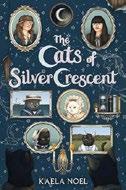
An evocative, vintage setting houses a dark—yet adorable—secret.
Twelve-year-old Elisabeth “Elsby” MacBride arrives in Snipatuit, Rhode Island, from Brooklyn to stay with her mysterious aunt Verity in her Carpenter Gothic–style home for the summer. One stormy night, three talking cats show up and ask for her help. They invite Elsby to their house, which is just next door. The sinister small-town New England setting seeps into the narrative, with the cats’ magical origins connecting to wealthy early Snipatuit landowner Algernon Endicott and his strange, castlelike library, filled with occult books. While visiting the library, Elsby meets a goth girl named Penelope Peres, a volunteer who has a morbid fascination with the town’s history of ghosts and spells. Together, the girls dive deeper into the cats’ strange powers. Noel’s writing embraces a comforting historical atmosphere. Allusions to classic literature, including Beowulf, T.S. Eliot, and Emily Dickinson, are juxtaposed with references to astrology and
KIRKUS REVIEWS 120 MARCH 1, 2024 CHILDREN'S
planetary activity that support the supernatural storyline. The imaginative descriptions, well-developed characterization, and sophisticated vocabulary will appeal to keen readers. Meanwhile, coming-of-age themes explore tween friendships and belonging. The combination of anthropomorphized cats with menacing magic will satisfy a diverse range of readers. Elsby reads white; olive-skinned Penelope is cued as being of Portuguese descent. An ominous and well-executed supernatural fantasy with cozy mystery undertones. (Fantasy. 9-13)
For Our Daughters
Nyoko, Mel | Illus. by Joelle Avelino Random House Studio (40 pp.) | $18.99 April 16, 2024 | 9780593428085
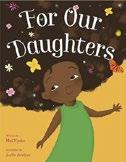
Affirmations from mothers to their daughters abound in this pro-girl picture book. The opening spread shows a brown-skinned mother, dressed in a beautifully patterned orange and yellow African print dress with matching head wrap, holding a darker-skinned infant. The two gaze into each other’s eyes. This image appears inside a golden frame, held aloft by hands that match the baby’s skin. Speaking in second person, an unseen maternal narrator tells the little one, “There are billions of people in this world, but they are not you. / That’s why you are remarkable.”
Throughout, girls from different cultural backgrounds, with varying skin tones and hair textures, hear negative comments from others, while the motherly voice offers a comeback for each one. “If they sneer and say, ‘Your nose is too wide,’” the narrator says, “You must hold your head high and tell them / you are a reflection of your ancestors’ beauty.” This guidance will help Black and brown children facing common microaggressions. The advice will also make children from the dominant culture aware of the
damage of these hurtful remarks. Incorporating deep, rich colors, Avelino’s personable images depict joyful girls overcoming discrimination and confidently moving through the world. Several illustrations also remind girls that family and ancestors can affirm their worth.
Will boost girls’ self-esteem while giving them concrete tools for thriving. (Picture book. 4-7)
Reina Ramos: Tour Guide
Otheguy, Emma | Illus. by Andrés Landazábal Harper/HarperCollins (32 pp.) | $17.99
$5.99 paper | April 30, 2024 | 9780063223226 9780063223196 paper | Series: Reina Ramos, 3
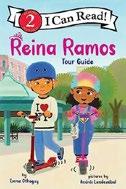
Reina Ramos plays tour guide to her visiting cousin while navigating big feelings.
Reina’s excited to welcome Andrés to her city. He’s two years older than her, and they haven’t seen each other in a long time, so she wonders if they’ll have a good time. Abuela and Andrés have so much to chat about as he shares news from “the island,” but Reina has never been there and feels left out of the conversation. Even Reina’s friend Carlos has been to the island and shares a connection with Andrés. Mami explains that Andrés is likely homesick, but Reina is still left feeling excluded. When Reina snaps at Andrés after a subway mishap, the cousins finally have a chance to clear the air. Reina realizes that even though the city feels familiar to her, it’s a whole new world for Andrés, and he misses the island. He reminds her that they’re family, and they decide that they’ll teach each other about their respective homes. The book’s concise sentences and its rich vocabulary, including both English and some Spanish words, make it ideal for beginning readers. The narrative skillfully portrays respectful conflict resolution,
perspective-taking, and flexibility. The family is Latine; although which island Andrés is from is never explicitly mentioned, a reference to Celia Cruz hints at Cuba.
Problem-solving is on display in this delightful story. (Spanish glossary) (Early reader. 4-7)
The Scooter Twins
Palmer, Dorothy Ellen | Illus. by Maria Sweeney Groundwood (32 pp.) | $19.99 | March 5, 2024 9781773066295
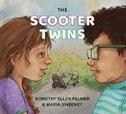
Twins feel mixed emotions when their doctor recommends mobility scooters.
On Melanie and Melvin’s eighth birthday, Dr. Singh gives the siblings an “unexpected present”: She tells them that they should use mobility scooters for their long walk to school. Motorcycle-loving Melanie can’t wait to “zoom like the wind”; she’s “tired of being left behind.” Reading about curb cuts, which make sidewalks more accessible, lessens Melvin’s fears of falling, but he worries people will stare. And Grandma says scooters are expensive. They’ll have to sell one of Mom’s paintings—losing another link to their deceased parents. Palmer, a scooter user herself, sympathetically highlights how these devices are seldom marketed with kids in mind: The clerk at the Accessibility Store initially assumes that Grandma is the customer, and some scooter models provoke the twins to protest they’re “eight, not eighty” and “disabled, not dying.” Though both find their ideal scooters, the delivery is bittersweet; Melanie’s scooter is slower than she imagined despite its wolf-shaped handlebars, and Melvin refuses to move, even though his is “little-green-frog perfect.” But recalling their parents’ wise words bolsters their confidence. Mitigating the somewhat stilted dialogue, Sweeney’s warm-hued illustrations convey the twins’ emotions, and despite its “ancient” furniture, Grandma’s small apartment is cluttered with
>>>
MARCH 1, 2024 121 KIRKUS REVIEWS CHILDREN'S
SECOND LOOK
This review originally ran in the Sept. 1, 1961, issue. Plough is reissuing the book on May 7.

Come Again, Pelican Freeman, Don Plough | (44 pp.) | $18.95 May 7, 2024 | 9781636080888
The author and illustrator of many delightful books here presents one of the most lucid pictures of the ocean’s tidal movements and their effect on one little fisherman. In the company of a friendly pelican who demonstrates his own skill as a fisherman, Ty parks his boots on shore and himself on a pole and waits for a bite.
As the tide rolls in, it carries the red boots out, and Ty, with hook, line, and sinker, retrieves one, enclosing a perfect fish. But the trick of the day is performed by the pelican, for as the tide rolls out and Ty walks back to his trailer, the delightful bird perched on a dune opens its mouth and returns to him the other boot.



SPONSORED CONTENT
6 Out-of-This-World SF & Fantasy Tales

Too
 By Nick Brooks
By Nick Brooks
An
2
The
By Linda
Crotta Brennan
An immersive reading experience threaded through with Celtic lore.
Eowulf:
By Mike Cavallaro,
colors by Irene Yeom
A pitch-perfect tale of friendship and fantastical foes.
4
Viewfinder
By Christine D.U. Chung & Salwa
Majoka
Beautiful
5 The First State of Being
By Erin Entrada Kelly
A warmhearted blend of nostalgia and futurism.
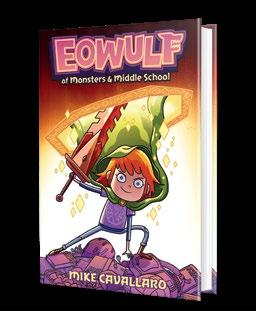


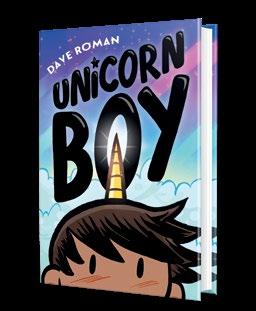
6 Unicorn Boy
By Dave Roman
At once a silly, sweet escapade and a dramatic tale of self-discovery in one’s own powers.

For more middle-grade SF & fantasy, visit Kirkus online.
BOOKLIST // CHILDREN'S
1
Many Interesting Things Are Happening to Ethan Fairmont
adventure filled with fun hijinks and personal growth.
Selkie’s Daughter
3
Of Monsters & Middle School
and precisely depicted, a gentle, generous reflection on civilization and community life.
MARCH 1, 2024 123 KIRKUS REVIEWS
comfortingly cozy details. Melvin, Melanie, and Grandma have light brown skin, while Dr. Singh is cued South Asian.
An educational, reassuring take on disability and loss. (Picture book. 6-8)
How Starling Got His Speckles
Parrack, Keely | Illus. by Antonio Boffa Barefoot Books (32 pp.) | $17.99
Feb. 6, 2024 | 9798888590669
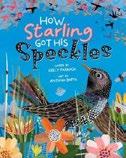
Pride nearly leads to a fall for a standoffish starling.
The other starlings fly in a huge flock, because “together is warmer and safer than alone.” But Star prefers to show off his dark, glossy feathers and refuses to join them. As he flits about branches and rooftops in lonely splendor, though, he catches the eye of a hawk and is saved only at the last minute when his desperate cries draw the others back; along with Star, they shape themselves into a giant raptor that frightens the predator away. Afterward, Star notices that his feathers (somehow) have new speckles that look just like a great flock. As Parrack concludes, from that day on, starlings have always born similar speckles as a “reminder that together is warmer and safer than alone.” It’s never made clear just how Star got the speckles, and many readers may wonder. The author closes this rather contrived tale with photos of starling murmurations and speculations about what purposes they might actually serve (since deliberately making shapes is not one of the options), along with more information about starlings. Boffa contributes ordinary, flat-perspective views of geometric houses, generic trees, and swirling masses of silhouetted birds that switch from gray to red to various other colors.
An unexceptional story, with pictures to match. (Picture book. 6-8)
A more than satisfying ending to a classic fairy-tale retelling.
A THUNDERING OF MONSTERS
A Thundering of Monsters
Patrick, S.A. | Peachtree (400 pp.)
$17.99 | April 2, 2024 | 9781682635841
Series: Songs of Magic, 3

The hunt continues for the merciless Hamelyn Piper in this epic conclusion to the Songs of Magic trilogy.
Ten years ago, hundreds of human and dragon children were lured from their homes, never to be seen again. It wasn’t the humans that the Hamelyn Piper wanted, but the bones of the dragons, which turn into a powerful mineral called obsidiac. Now known as the Black Knight for his black obsidiac armor, the Hamelyn Piper is in search of the amulet that will bring him immortality.
Piper Patch Brightwater, dracogriff Barver Knopferkerkle, and shapeshifter Wren Cobble—joined by the motley band of crusaders who gathered in earlier series entries—are honing their respective magical and non-magical skills to stop the Black Knight from destroying all who do not pledge fealty to him. According to prophecy, the friends will be betrayed by members of the ruling Pipers’ Council, so in addition to navigating a deadly forest of bone trees, a dangerous Bestiary of monsters, and imprisonment by the Hamelyn Piper himself, they must be wary of those in positions of power whom they should be able to trust. With its heart-stopping action and apocalyptic stakes, this final installment does not disappoint, although the conclusion may leave readers wondering if there’s more of the tale
to be told. The human characters read white.
A more than satisfying ending to a classic fairy-tale retelling. (Fantasy. 9-13)
Summer Games
Petrik, Mike | Hippo Park/Astra Books for Young Readers (64 pp.) | $12.99 | May 7, 2024
9781662640308 | Series: One Cool Duck, 3

It’s time for the summer tradition of capture the flag. Duck, Rhino, and their respective groups of friends both have brand-new forts, and what better way to break them in than with a game of capture the flag? At the midway point between Team Far-Out Fort and Team Cool Cabin, the players go over the rules: Each team must get past “enemy lines” to the other side’s fort and steal the flag— all without being tagged. At Far-Out Fort, Duck and company decide to divide into two groups to sneak up on Team Cool Cabin while Pig stays behind to guard their flag. Overconfident Cat makes an ill-judged attempt to tag the other team, while Duck and several others try a move that leads to an ambush. Can Duck and his crew still come out the victors? Petrik’s cartoon art bursts with energy; clad in sunglasses, sweatbands, and baseball caps and spouting cool lingo (“NOT EVEN!” “Dude!”), the anthropomorphic characters brim with attitude. Those familiar with the series will notice plot threads from earlier installments playing out as the narrative continues
KIRKUS REVIEWS 124 MARCH 1, 2024 CHILDREN'S
and that characters previously relegated to the background get their moments to shine. The game drives this graphic novel, making it at once more action-oriented and less focused on character development than previous series entries. Nevertheless, it’s still fun, with high stakes that never get too intense. A dynamite comic! (Graphic fiction. 5-8)
Kid-Ventors: 35 Real Kids and Their Amazing Inventions
Pew, Kailei | Illus. by Shannon Wright Feiwel & Friends (288 pp.) | $19.99 April 23, 2024 | 9781250836021

A captivating exploration of the ingenuity of young people who defied norms and persevered to see their inventions through.
The book profiles kids ranging in ages from 6 to 16, detailing the challenges they faced and their paths to delivering breakthrough inventions or developing and improving on existing ones. The book is divided into five sections covering inventions that solve daily problems, assist others, advance technology, help the environment, or are just for fun. Readers will encounter famous names like Benjamin Franklin (who invented swim fins at age 11), Louis Braille (who developed the Braille alphabet when he was 15), and Apple co-founder Steve Wozniak (who at 13 created an adder/subtractor). Pew also features lesser-known young inventors,
including Remya Jose from India, who invented a pedal-powered washing machine in 2003, when she was 14, and Guatemalan boy Ken Lou Castillo, who, seeking a solution to both deforestation and his own smoke allergies, created eco-friendly and hypoallergenic fire logs he named Mr. Fuego when he was 9. The book, which highlights a broadly diverse group of subjects, also includes sidebars with additional context and inspirational quotes. Brief informational sections interspersed between the profiles explain patents, trademarks, and prototypes; introduce types of STEM communities young people can join; and list concrete steps on the path to becoming an inventor. Wright’s cheerful illustrations add touches of fun.
Celebrates young people’s ingenuity; will inspire and delight reluctant and avid readers alike. (glossary, sources) (Nonfiction. 9-12)
A Penguin Like Me
Pfister, Marcus | Trans. by David Henry Wilson NorthSouth (32 pp.) | $19.95 March 5, 2024 | 9780735845589
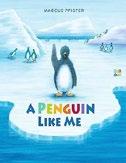
Readers meet several members of a penguin colony. “Every penguin is different. But each one is a penguin.” Starting with the endpapers, Pfister’s inimitable art style soars, depicting 22 comical, anthropomorphic seabirds cavorting against a gray watercolor background. Sadly, the text, translated from German, quickly becomes wordy, hammering
A captivating exploration of the ingenuity of young people who defied norms and persevered to see their inventions through.
KID-VENTORS
home a message of inclusivity. What little plot there is involves newcomer Lucas, who looks a bit different from the others and is wondering if he’ll be accepted. There’s no doubt the others will embrace him, however, since everyone seems to like the outgoing Lucas. Next, we’re introduced to 11 other penguins, all different but integral parts of the colony. Timmy masks depression by clowning, Sofia exhibits synesthesia, and Felix, whose short wings make life more challenging, is ceaselessly “cheerful and chirpy”—a somewhat condescending depiction of physical disability. And “while the other girl penguins have crushes on boy penguins, Lena is head over heels in love with Ida. She loves being in love and having butterflies in her tummy. And one day she’ll tell Ida how she feels.” The relentlessly long descriptions of the various characters—occasionally with sly humor—may reassure some children, but by the time Lucas finally re-emerges, many will feel shortchanged and possibly patronized. A well-meaning but heavy-handed lesson in accepting differences. (Picture book. 5-8)
SuperDrew and the Betrayal of Donhil Corp
Pierson, BJ | Snowy Wings Publishing (210 pp.) | $10.99 paper | April 2, 2024 9781958051566 | Series: SuperDrew, 2

In this follow-up to SuperDrew and the Secrets of Donhil Corp (2021), Andrew Stirling is still struggling to take down the evil company that’s controlling humanity with its modified-food, media, and lifestyle products.
Ultra-clever Drew is a self-described geek and an impulsive, justice-oriented inventor. Wearing arm and leg braces made with advanced technology for a bone condition, he uses his tech to perform feats that come close to superheroism. After uncovering
MARCH 1, 2024 125 KIRKUS REVIEWS CHILDREN'S
Donhil Corporation’s sinister machinations with best friend Jazz Liu-Wen, an intrepid investigative journalist, the teens team up with two employees to take it down from the inside. They discover that the truth of Donhil’s crimes is more horrifying than they ever imagined. The story is fully committed to breakneck video game–esque spy adventures, and it wastes no time in dropping readers into the action, with plenty of major set pieces that are sometimes repetitive and overburdened with pop culture references. For every obstacle they face, Drew and company have a gadget and an ingenious plan, but the escapism comes with a lesson about standing up for people’s autonomy at any cost. While the portrayal of Drew’s internalized ableism is sometimes muddled, his experience of disability is interesting: He pushes past his own limits but still faces realistic consequences. His exciting tech can’t erase his struggles with his own self-image, but he still holds his own. Drew reads white; Jazz is cued Chinese American. Pulpy thrills with a solid message. (Adventure. 10-14)
From My Head to My Toes
Raisman, Aly | Illus. by Bea Jackson Henry Holt (40 pp.) | $18.99 April 2, 2024 | 9781250798107

Olympic gold medalist Raisman, who in 2017 spoke out about the sexual abuse she’d endured, presents a primer on bodily autonomy.
“I am strong. I am beautiful. I am unique. I am enough.” So begin the affirmations that appear in this sensitively written book. Raisman underscores the importance of being kind to one’s body and listening to what it needs. She notes that others need to ask permission before touching our bodies; sometimes the answer will be yes, but other times, it
Raisman has created a muchneeded resource for starting a dialogue about consent.
FROM MY HEAD TO MY TOES
will be no. Either is acceptable. Sometimes, someone will forget to ask or won’t respect the answer. When that happens, children can tell them to stop. If they feel unsafe, and it’s hard to say no, they can ask for help from people who make them feel safe. Our voices are just as “powerful,” “beautiful,” and “worthy” as our bodies. Emphasizing the strength inherent in every person—and making clear that we all deserve respect—Raisman has created a much-needed resource for starting a dialogue about consent. Backmatter offers tips for adults about discussing bodies and boundaries. Jackson’s expressive, pastorally soft illustrations depict people, diverse in terms of race, ability, and body type, practicing gymnastics, gardening, and playing basketball. A light-skinned girl wearing a shirt reading “Aly,” presumably a stand-in for the author, features prominently. Necessary and empowering. (author’s note) (Picture book. 3-8)
The Secret Elephant: Inspired by a True Story of Friendship
Rankin, Ellan | Random House Studio (32 pp.) $18.99 | April 23, 2024 | 9780593703267

Friendship endures despite warfare.
Sheila the baby elephant is the only one of her kind at the zoo, but her redheaded, pale-skinned keeper is her family; they do everything together. But their routine changes when war breaks out. Planes drop bombs,
causing loud explosions that hurt Sheila’s ears. The keeper sneaks into the zoo at night and rubs Sheila’s ears to calm her. Soon, the two companions get braver and leave the zoo together—Sheila thinks she is very stealthy, squeezing through iron fences—all the way to the keeper’s “enclosure,” where they spend the night before returning each morning. As the war continues and Sheila keeps growing, this situation gets harder to maintain, until one day Sheila breaks through a fence while chasing a dog. Sheila’s no longer allowed to leave the zoo, but the keeper continues to keep her company at night. This sweet story of animal-human friendship is based on a real zookeeper who cared for an elephant housed at Northern Ireland’s Belfast Zoo during World War II. Backmatter offers more background on Sheila and her keeper, Denise Weston Austin, as well as some context for the war. Sheila narrates, so the tone mostly remains light, focusing on the little elephant’s relationship with her beloved keeper even as the sounds of bombs fill the air. The charming illustrations are soft with a vintage quality, using lighting and shading to great effect.
Heartwarming. (author’s note) (Picture book. 3-8)

KIRKUS REVIEWS 126 MARCH 1, 2024 CHILDREN'S
For another wartime animal tale, visit Kirkus online.
Intense summertime heat never looked this good.
HEATWAVE
Kirkus Star
Heatwave
Redniss, Lauren | Random House Studio (40 pp.) | $19.99 | May 21, 2024
9780593645949

Extreme weather brings life to a halt.
On a hot, steamy day in an urban environment where it’s “100 degrees, // in the shade,” a young person tries to beat the heat. After brutal temperatures force the cancellation of a basketball game, the unnamed protagonist, an adult caregiver, and their trusty dog go to the beach to get some relief. Not even shade from an umbrella or sunscreen with a high SPF can protect them from the sun’s harsh rays. As the “wind picks up” and “clouds roll in,” “one raindrop” turns to a “downpour,” with relief in sight as day turns to night and the strong sun gives way to cool moonlight. Relying on a uniform color palette throughout, the mixed-media illustrations beautifully evoke the oppressive nature of summer in the city. For daytime scenes, Redniss uses a fiery red, while for nighttime scenes, she employs a cool deep blue. Bigger issues of global warming are captured in little details throughout, such as a newspaper headline trumpeting “record heat across globe” and a book on icebergs in the protagonist’s bedroom. Redniss pairs her efficacious art with spare text. Human characters have elongated limbs and torsos, further capturing the sluggish vibe of a summer day. Characters’ skin tones match the colors of the page.
Intense summertime heat never looked this good. (Picture book. 4-8)
Isabel in Bloom
Respicio, Mae | Wendy Lamb/Random (368 pp.) $17.99 | April 9, 2024 | 9780593302712
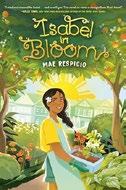
A tween girl finds ways to connect her old life in the Philippines to her new life in America It’s 1999, and 12-year-old Isabel Ligaya is leaving the one home she’s ever known to live in San Francisco. She’s excited but nervous to be reunited with Mama, who moved to the U.S. five years ago for work, hoping to provide better lives for Isabel and her grandparents. San Francisco couldn’t be more different from the gardens and greenery she’s used to. Feeling like she doesn’t belong in this strange place with a mom she barely knows, Isabel searches for “the people / places / things / that feel like / home,” just like Lolo, her grandfather, told her to. She finds solace in her school’s forgotten garden, makes friends in the culinary club, and learns to grow and bloom in her new environment. Told in verse, this is a charming story of growth, family, friends, community, and finding connections between old and new. Isabel’s thoughts, her intense and sometimes conflicting feelings about immigrating, and her changing relationship with her mother are beautifully expressed and relatable. Sprinkled throughout the text are details about Filipino American history and Filipino culture, language, and diaspora experiences. While most of the book is written in free verse, readers are also introduced to other poetic forms, such as acrostic and concrete poetry. Heartfelt and moving. (author’s note) (Verse fiction. 8-12)
Marley’s Pride
Retener, Joëlle | Illus. by DeAnn Wiley Barefoot Books (32 pp.) | $17.99
April 2, 2024 | 9798888590744

A Black nonbinary child finds ways to navigate their sensory sensitivities during Pride.
Every June, Marley wants nothing more than to join their grandparent Zaza at the Pride celebrations. And every June, just the thought of big crowds and loud noises makes Marley tense up with nerves, and, with a mixture of relief and disappointment, they tell Zaza to go without them. But this year, Zaza is receiving an award for their work with the trans community, and Marley refuses to miss it. Luckily, Marley has plenty of tools at their disposal—affirmations, breath work, noise-canceling headphones, and a stuffy to hug—and when the noise and bustle become overwhelming, Zaza is there to literally lift them up and remind them that, party or no, Pride is community and Marley is not alone. By the day’s end, Marley has made new friends, celebrated their grandparent, and soaked up the sustaining joy of belonging. Retener’s refreshingly inclusive tale lets young readers with sensory sensitivities see themselves not only in a book, but at Pride as well. Notably, the author makes clear that inaccessibility, not sensory needs, is the problem to be solved. Just as important is the inclusion modeled in Wiley’s vivid illustrations, which depict a Black queer protagonist, multiple gender-expansive and -exploring support characters, and intergenerational queer representation. Color-saturated, cut-paper-style spreads capture the exuberance and cacophony of Pride celebration yet give both Marley and readers visual breathing room. Zaza is Black; other characters are diverse.
Joyfully affirming. (glossary, the history of Pride) (Picture book. 4-8)
Kirkus Star
MARCH 1, 2024 127 KIRKUS REVIEWS CHILDREN'S
The Truth About the Couch
Rubin, Adam | Illus. by Liniers | Putnam (48 pp.) $19.99 | April 23, 2024 | 9780593619131

The hidden history of one of the world’s most popular pieces of furniture.
An anthropomorphized fox in a purple jacket and green pants stands on a stage, showcasing various kinds of sofas and what they’re used for: eating, sleeping, dance parties, and sliding down pillows. Just as the fox is about to provide a demonstration of that last activity, complete with a drawing, an opossum in a gray pinstriped suit emerges: “You can’t show that to children! Someone could break their neck!” Using a tape dispenser–like machine, the opossum covers up the offending image with a black censor bar. The fox continues to expose “truths” about couches: Some of them grow on farms (“Where do you think we got the term couch potato?”); they have an insatiable hunger, which leads to objects disappearing among the cushions; and some are actually aliens in disguise. The opossum is skeptical, but when a chaotic parade of couches enter the scene to prove the fox right, the opossum is forced to reconsider. This is a hilarious send-up of conspiracy theories and adults’ attempts to shelter children from the real world. Depicting elegantly attired creatures, Liniers’ muted artwork contrasts humorously with the surreal scenarios depicted. The dialogue between the fox and opossum is entertaining, but grown-ups might want to pre-read before read-alouds to avoid tripping over some phrasing (e.g., “secret elite couch enforcement squadron”). Funny and thought provoking. (Picture book. 5-8)

Archie Celebrates an Indian Wedding
Ruths, Mitali Banerjee | Illus. by Parwinder Singh Charlesbridge (32 pp.) | $17.99 April 30, 2024 | 9781623544188
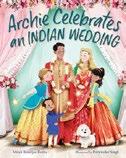
In this follow-up to Archie Celebrates Diwali (2021), a young Indian girl guides her cousin-to-be through the ins and outs of a Hindu wedding.
Archie’s Poppy Uncle is marrying Miss Julie, and Archie has so much to do: She strings garlands with Dida, folds programs with her dad, and helps her mom select jewelry. Plus, she must watch her little brother, Krishna. So when Poppy Uncle asks her to help Miss Julie’s niece, Emma, feel comfortable, Archie isn’t sure she can handle it all. Miss Julie and Emma, who present white, are unfamiliar with Hindu traditions, and they both need a lot of guidance. Archie assuages Emma’s anxiety about wearing Indian clothes, steps in at the baraat when Emma and her father look lost, and answers Emma’s questions about the Sanskrit mantras the bride and groom repeat during the ceremony. Archie also consoles Miss Julie when she thinks that she’s ruined her henna. By the end of the wedding, Emma and Archie aren’t just cousins—they’re also friends.
Though the two girls forge a strong bond, the relationship feels onesided. And while the vibrant, textured illustrations and clear text provide an excellent introduction to a Hindu wedding ceremony, Archie spends most of the book making Emma and Miss Julie feel at home; many readers will be unsettled by the optics of a child of color putting her own needs aside to prioritize a white family’s comfort.
A vivid depiction of a wedding celebration that shortchanges its protagonist. (about Indian weddings, glossary) (Picture book. 4-8)
Queer and Fearless: Poems Celebrating the Lives of LGBTQ+ Heroes
Sanders, Rob | Illus. by Harry Woodgate Penguin Workshop (32 pp.) | $18.99
April 16, 2024 | 9780593523698
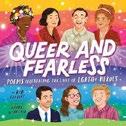
A poetry collection that pays tribute to prominent queer figures.
Sanders offers a glimpse into the lives of 17 people who have played a role in the fight for equality, among them Civil Rights leader Bayard Rustin, activist Marsha P. Johnson, and Secretary of Transportation Pete Buttigieg. An introduction encourages readers to think of themselves as heroes, too: “Speak your mind. Let your truth be known.” Woodgate’s bold and realistic full-color illustrations skillfully convey people, places, and times while reflecting the racial, ethnic, and gender diversity of the LGBTQ+ community. Varied poetry styles—free verse, limerick, shape poem, and more—provide the impression of a tapestry, weaving together different moments of a movement in evolution, including the Stonewall Uprising, the creation of the Pride flag, and the 2015 Supreme Court ruling that made same-sex marriage legal. Although some poems are stronger than others, each brings to life a moment in time and a person who contributed to the movement. The entries offer effective, meaningful sketches, giving young people a strong sense of contributions to queer history and drawing out the many ways individual people can influence movements. An appended glossary and further resources will encourage readers to explore more deeply; also included is information on the various poetic forms used in the book. An acutely distilled and vibrant compilation of LGBTQ+ heroes. (Informational picture book/ poetry. 6-10)
an interview with Adam Rubin, visit Kirkus online. KIRKUS REVIEWS 128 MARCH 1, 2024 CHILDREN'S
For
This third installment relies on the series’ winning formula: puns galore, a mystery, and unreliable magic.
A COOP, SOME GOOP, AND A SANDWICH
What Happens Next? Newsroom Nonsense
Smiley, Jess Smart | First Second (240 pp.)
$22.99 | $14.99 paper | April 9, 2024
9781250772855 | 9781250890993 paper
Series: What Happens Next?, 3

Megan wants to work on the class newspaper, but in this Choose Your Own Adventure–style graphic novel advertising over 100 paths and 25 endings, she’s easily distracted.
Mr. Fisher is waiting for a new photocopier to be delivered to Sunbright Middle School. As usual for this series, he homes in on Megan to assist him. She’d rather go to class, where they’re starting a newspaper. Whether Megan helps Mr. Fisher or not, each subsequent decision leads to a variety of outcomes, from the somewhat expected (many paths end in Mr. Fisher’s office) to the out there (as when Megan’s carried away by seagulls). Vibrant colors and loose, flowing lines capture the hyper action of each storyline. While it’s not necessary to have read the two previous books, fans of the series will delight in their growing familiarity with the themes and characters: Those in the know who are anticipating Olivia’s barf scene will not be disappointed, and in one episode, the Sunbright Muck Man makes his mysterious appearance. Romantics will happily follow the ongoing saga of Megan’s crush on Dillon, which offers a satisfying ending when Dillon sacrifices himself to save Megan from the wrath of Mr. Fisher. Fellow student Mitch’s comics about Mr. Fisher are interspersed, offering an additional
treat throughout. Most characters are light-skinned.
Readers will appreciate the multiple takes on the absurd world of middle school. (cast of characters, how to read this book, drawing directions) (Graphic fiction. 8-12)
Officer Clawsome: Crime Across Time
Smith, Brian “Smitty” | Illus. by Chris Giarrusso | HarperAlley (240 pp.)
$15.99 | April 23, 2024 | 9780063136397
Series: Officer Clawsome, 2
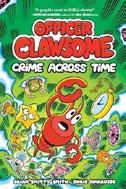
The ocean’s top cops dive into the timestream in pursuit of fishy archfiend Brain Sturgeon. Something’s definitely fishy in underwater Caper Cove, with finny scientists and piles of gold all vanishing. Fortunately, lobster lawman Clawsome and his doughty if diminutive starfish partner, Stariana, are on the case. In a caper that takes them from prehistoric times to the Old West and even into “outer space” (i.e., above the ocean’s surface), they battle cavegoons and robots, both giant and regular size, to save their undersea town and the future itself from a sneering mastermind with a time machine. Fueled by kelpcakes (like doughnuts, but green) and exchanging eye-rolling banter as they go (“Wanna do some bowling?” “As long as you don’t spare any of these goons.” “Let’s see if I can strike up a conversation!”), the dynamic duo suffers reverses. But as depicted in fast-flowing panels flooded with loud,
punchy action and massive explosions, they ultimately deliver just deserts once again. Even (literally) crabby Captain Badmood has to offer reluctant congrats. Young fans of Dav Pilkey’s work will appreciate the action-packed storyline, humor, and bright illustrations. The crustacean crimefighter and his sidekick really earn their doughnuts in this smash-’em-up slugfest. (Graphic fantasy. 7-9)
A Coop, Some Goop, and a Sandwich
Smith, Mark David | Illus. by Kari Rust Owlkids Books (112 pp.) | $16.95
April 16, 2024 | 9781771476041
Series: Weird Sisters Detective Agency, 3

This third installment relies on the series’ winning formula: puns galore, a mystery, and unreliable magic. At the Covenly Fall Fair, the three witches, Yuckmina, Hildegurp, and Glubbifer, run their carnival ride, the Flying Broom, while Jessica, their sensible 9-year-old friend from the earlier books, manages the nearby petting zoo. Soon, they have a mystery on their hands: One of the prize hens, Ruth Bader Ginsbuck; a vest-wearing, top-hatted frog; and the sisters’ cat, Graymalkin, are missing. Can the detectives find them—and also undo some unfortunate romantic and shape-shifting spells, distract a demanding spoiled boy, and avoid falling “fowl” of a chicken-suited villain who seems to have it in for the sisters? Many of the book’s puns will be spotted only by the Shakespeare-fluent—some reference Macbeth, while even more creatively distort Hamlet but others are universally glee- or groan-worthy. Though the plot is chaotic, short chapters set a brisk pace, and all is resolved (and forgiven) by the end. As usual, the witches don’t always wield their wands effectively, but they can produce any necessary props from
MARCH 1, 2024 129 KIRKUS REVIEWS CHILDREN'S
their clothing. The wordplay occasionally contains an explicit bit of wisdom (“Just because you don’t understand something doesn’t make it wrong”). Rust’s lively black-and-white illustrations reflect Covenly’s diversity, though the book doesn’t specify the characters’ specific races and ethnicities.
A playful addition to an entertaining and punny series. (caramel apples recipe) (Chapter book. 6-9)
Kirkus Star
Being Home
Sorell, Traci | Illus. by Michaela Goade Kokila (32 pp.) | $18.99 | May 7, 2024 9781984816030

A contemporary Cherokee family finds their way home.
Life in the city is chaotic, a young child tells us. Etsi (Cherokee for mother) decides it’s time for them to leave. They pack up their belongings in boxes, wave goodbye to their house, and drive off, “on a new path. / One that leads us to / our ancestors’ land / and to our people.” When they arrive, they’re greeted by a loving community. Everyone helps unload the car and gathers for a feast. Then the narrator races off with other children through the woods to play and explore. Sorell’s (Cherokee Nation) lyrical, alliterative verse positively sings. Instead of “busy streets” and “crowded spaces,” there is “room to run.” Here, children can “hear the creek, cool and constant.” Goade’s (Tlingit Nation) breathtaking mixed-media artwork layers in emotion, transitioning from urban scenes dominated by dark, looming structures and impersonal silhouettes to vibrantly illustrated spreads teeming with the smiling faces of friends and family. Shimmering colors and geometric shapes bring to life the protagonist’s world. Doodlelike pages from the child’s journal reveal the narrator’s anticipation. The color pink is
An evocative, heartwarming testament to the power of home and community.
a motif throughout—it appears sporadically early on, then slowly infuses the pages; the final spreads are suffused with hues of rose as the sun sets and the children play by the light of the moon.
An evocative, heartwarming testament to the power of home and community. (Cherokee glossary) (Picture book. 6-10)
Always Your Stepdad
Stansbie, Stephanie | Illus. by Tatiana Kamshilina | Doubleday (32 pp.) | $18.99
April 9, 2024 | 9780593709115

Parenting is a difficult job, but stepping into the role of a stepdad can be even more challenging. Aimed at both parents and children, this book offers a reassuring glimpse of one blended family’s journey. The stepdad is “awkward and shy” when he first meets the child, but the youngster greets him with a smile. The stepdad and child work out their relationship on their own, with little intervention from the child’s primary parent. In general, the child guides the father “gently along this new path” as they take walks together, garden, and play dress-up until the day the child draws a picture of the two of them and labels the father figure “DAD!” It’s a happy milestone for both of them, a sign of the precious, lasting relationship they’ve been working toward. Kamshilina makes use of two styles of illustrations. On the endpapers and periodically
throughout, she offers a kid’s-eye view of the new family in progress through illustrations that resemble a child’s crayon drawings. More realistic illustrations, “taped” to the pages like scrapbook snapshots, capture important events and daily life alike. The stepdad is brownskinned, while the rest of the family is white-presenting.
A gentle and encouraging story with suggestions on how to create a loving blended family. (Picture book. 3-6)
Always Your Stepmom
Stansbie, Stephanie | Illus. by Tatiana Kamshilina | Doubleday (32 pp.) | $18.99 April 9, 2024 | 9780593709139
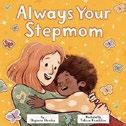
Being a new stepmom has its awkward moments, but it’s also a deeply rewarding experience.
A woman begins a new relationship and works to establish a bond with her partner’s young child. Although the child’s primary parent is introduced in a crayon drawing early on and appears throughout, the focus is on the stepmother and child’s developing relationship. The primary parent’s presence is more noticeable once the stepmother and little one become a team and the new family blends together. Realistic illustrations anchor the story’s milestones, starting and ending with the child’s fifth and sixth birthday parties. Smaller images, formatted like photos in a scrapbook, capture day-to-day life, from campouts to
BEING HOME KIRKUS REVIEWS 130 MARCH 1, 2024 CHILDREN'S
Fans will be thrilled and encouraged to go on exploring the worlds of mystery reading—and solving.
CREAM BUNS AND CRIME
making paper airplanes. In contrast, the crayon art accompanying the rhymed text and gracing the endpapers is probably too sophisticated to be made by a 5- or 6-year-old, but it does add a playful sense of the child’s interpretation of events. Everything leads up to an “I’ll love you forever” moment and an acknowledgment of how having the child in her life has changed the stepmother. The stepmother presents white, while the child and the primary parent present Black. A heartfelt reminder that patience and openness are crucial when families welcome new members. (Picture book. 3-6)
Cream Buns and Crime: Tips, Tricks, and Tales
From the Detective Society
Stevens, Robin | Simon & Schuster (288 pp.)
$17.99 | April 23, 2024 | 9781665919463
Series: A Murder Most Unladylike Mystery

Stevens and her fictional characters offer some background to the collection of A Murder Most Unladylike books.
Stevens’ nine-book series is a satisfying and highly successful combination of English boarding-school tales and traditional detective stories, all set in the 1930s. This entertaining companion title includes an invitation to would-be detectives; suggested reading, mostly from the adult world, for mystery aficionados; and four new, interconnected short
stories. Readers will encounter instructions on how to set up their own clubs for finding and solving mysteries from Stevens’ characters, including Daisy Wells and Hazel Wong of the Wells & Wong Detective Society (who were first introduced in 2015’s Murder Is Bad Manners), and George Mukherjee and Alexander Arcady of the Junior Pinkertons (the girls’ friends from Weston Boys’ School). The author and her characters take turns narrating the short stories, sharing tips and tricks for detection, and they offer a short history of detective novels. Hazel introduces crime-writing queens Agatha Christie, Dorothy L. Sayers, Ngaio Marsh, and Margery Allingham; Daisy writes profiles of her 10 favorite fictional detectives, including Inspector Alan Grant, Father Brown, and Nancy Drew; and Stevens shares her favorite mysteries and their influences on the stories she wrote. Readers will also enjoy learning more about spies, codebreaking, and famous unsolved cases and trying the recipes for food mentioned in earlier books. Altogether, this is jolly good fun. Fans will be thrilled and encouraged to go on exploring the worlds of mystery reading—and solving. (quiz answers, glossary) (Mystery. 10-14)

The Good Little Mermaid’s Guide to Bedtime
Sumner, Eija | Illus. by Nici Gregory Tundra Books (40 pp.) | $18.99
March 5, 2024 | 9780735267893
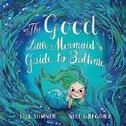
This little mermaid is having none of that sweet stuff.
In this tale of metafiction, a scowling, green-haired, light-skinned mermaid takes umbrage at the titular bedtime guide. As she points out, “Sleep is for guppies.” The book-within-abook begins with a good little mermaid readying herself for bed. The green-haired mermaid looks perturbed: “I’m not a good little mermaid. I am a predator.” And when the book notes that the good little mermaid brushes her teeth before bed, our protagonist is annoyed. “Who cares if my teeth are clean when they can tear through scales and crunch bones?” But she reconsiders so her teeth will “gleam like razor-sharp blades.” The wholesome instruction continues, but our mermaid continues to insist she’s a nightmare of the deep…until the yawns begin. The book-within-abook ends with “sweet dreams, little mermaid,” to which the protagonist cheekily replies, “Sweet nightmares.” Sumner’s tale will have bedtime-reluctant guppies giggling. The pages of the saccharine-sweet bedtime guide are overlaid onto illustrations of the protagonist and her pufferfish and octopus friends. The artwork also shows that our hero’s not quite as naughty as she presents herself; when the good little mermaid gathers up a favorite toy, our protagonist imagines a giant goblin shark…but as she drifts off, we see her snuggled up with a downright adorable shark stuffie. Gregory’s dynamic, digitally created illustrations have a watercolor look and perfectly convey the humor in the text.
A must for mermaid fans, sweet or sassy, and a great bedtime read. (Picture book. 3-8)
MARCH 1, 2024 131 KIRKUS REVIEWS CHILDREN'S
For more by Robin Stevens, visit Kirkus online.
Deep Water
Sumner, Jamie | Atheneum (224 pp.) | $17.99 April 9, 2024 | 9781665935067
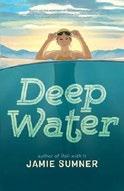
Sometimes you must risk everything to find out who matters.
Tully has her mother’s nose and auburn hair—and even her mother’s maiden name as her given name. Tully is also athletic and competitive like her mother. She’s been swimming competitively since she was 6, and now, at 12, she’s encouraged by her mother to be the youngest person ever to swim across Lake Tahoe. But then Mom stops taking her meds, begins exercising obsessively, and suddenly leaves without saying goodbye. Seeing Dad “swallowed up / in the glow of his computer screen,” Tully decides that if she succeeds in swimming across Lake Tahoe, her mother will come back, “Because I am a winner / and I can do HARD
THINGS.” Tully trains in secret, and early one July morning, she sets out across the lake with her best friend, Arch, kayaking alongside her. Laid out in parts titled “Hour One,” “Hour Two,” and so on, this accessible but sometimes overly obvious story pulls readers into the heart of a grueling 12.1-mile swim. As Tully struggles mentally with the confusion and guilt brought on by her mother’s departure and she thrashes her way across a suddenly stormy lake while Arch yells at her to quit, she comes to an honest assessment of herself—and her mother. The varied and creative layout of the text adds an interesting component to the free-verse, present-tense narrative, told from Tully’s first-person point of view. Characters read white. Packs a powerful punch. (Verse fiction. 9-12)

A cozy story of family treasures that sustain connections across the miles.
A MALETA FULL OF TREASURES
Kirkus Star
The Noisy Puddle: A Vernal Pool Through the Seasons
Sweeney, Linda Booth | Illus. by Miki Sato Owlkids Books (32 pp.) | $18.95
March 12, 2024 | 9781771475310

Who knew there was so much to see and hear in a puddle?
Two Asianpresenting siblings visit a vernal pool in “the deep, damp forest” through the seasons and are awestruck by the natural wonders they discover. What’s a vernal pool, you ask?
As the author’s note explains, it’s a wetland habitat that forms “in shallow dips in the land,” in places with seasonal climates; such areas shelter a variety of plants and animal species throughout the year. In short, over the course of a year, a vernal pool is a busy, noisy circle of life. The children share their finds in lilting verse, and readers will be delighted at these wondrous explorations. Look at some of what the kids find in and around this astonishing place when they return season after season: frogs and toads, ducks, shrimp, salamanders, turtles, butterflies, foxes, deer—and much more! The gorgeous, textured, naturalistic, collagelike artwork bursts with life and realistic colors, and readers will enjoy closely examining the illustrations as animals and plants are enumerated; a chart at the end of the book helps readers identify the wildlife in this beautifully realized story. Grown-ups may wish to help curious readers investigate whether there are vernal pools near where they live. Nature offers up marvelous surprises at every turn—even via a
humble puddle teeming with life. (Informational picture book. 5-8)
A Maleta Full of Treasures
Sylvester, Natalia | Illus. by Juana Medina Dial Books (32 pp.) | $18.99
April 16, 2024 | 9780593462423

Abuela’s visit sparks a sweet celebration of the presents— and presence—she brings.
The young narrator anxiously anticipates her grandmother’s arrival; it’s been three years since Abuela last visited. When the family picks up Abuela at the airport, her maletas—suitcases—make a mountain in the trunk of the car. What treasures might be inside from nuestra tierra, the family’s homeland? Candies, storybooks, and soft alpaca blankets, along with messages from loved ones far away, fill the home. Though the child has never been to the family’s homeland, it’s still an integral part of her, and the gifts help her feel connected. The sweets are fleeting, just like Abuela’s all too brief visit. But before she goes, Abuela leaves behind one bonus treasure so that the little one can share the love until Abuela returns. Medina’s thick-lined cartoon images are drawn with simplicity yet are deeply expressive; the protagonist’s emotions are palpable. Though context clues indicate that Abuela has traveled from Peru, that’s never explicitly mentioned in the text, which will allow many readers to see themselves in this story, though those with Peruvian heritage may
For more by Jamie Sumner, visit Kirkus online. KIRKUS REVIEWS 132 MARCH 1, 2024 CHILDREN'S
find additional richness. Indeed, this tale of bridging gaps is sure to especially resonate with immigrant families, as well as those who find themselves far from their roots. A cozy story of family treasures that sustain connections across the miles. (Picture book. 3-8)
The eXpets
Tatulli, Mark | Caitlyn Dlouhy/Atheneum (304 pp.) | $14.99 | April 30, 2024
9781665914871 | Series: The eXpets, 1
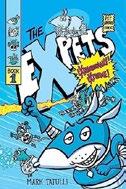
After all the kittens in the world are abducted, it’s domesticated animal superheroes to the rescue!
Reluctantly recruited into the eXpets after driving two would-be burglars into nauseated submission with superpowered blasts of doggy gas from both ends, peaceable Bosco finds himself renamed Stanky Dog. Soon, he’s headed on a rescue mission to the moon with tiny but fierce Ginormous Gerbil, Wonder Guppy, and like stars of the S&SCU, or Simon & Schuster Comics Universe (not to be confused with the Marvel Cinematic Universe, if you please). With the innuendo extending even into chapter heads (“Doggie Don’t or Doggie Do?”), Tatulli’s loudly hued panes fill up with frenetic action and rapid-fire repartee as the heroes struggle to prevent archnemesis the Skunk and his tentacled minion, Captain Calamari, from digging up the ancient Collar
of Power that would force all humans to become pets and vice versa. Can the furry fighters save the day—not to mention an ocean of wide-eyed, intensely cute kitties who were kidnapped to do lunar excavation? (“It’s actually a giant ball of kitty litter! And who knows more about digging through kitty litter than— kitties?”) Cue the slogan—“eXpets exceed expectations!”—on the way to a triumphant finish featuring a round of parties and parades back on Earth, plus a twist or two to set up future episodes. Plenty of silly hijinks to keep the pages turning; readers will find this a gas. (Graphic adventure. 7-10)
I Would Love You Still
Theodore, Adrea | Illus. by Ken Wilson-Max Holiday House (40 pp.) | $18.99 April 30, 2024 | 9780823453665

A parent expresses unconditional love for a child during a trip to the zoo.
“If your skin had stripes and cheetah spots,” the parent says, “I would still love you lots and lots.” This rhyming picture book beautifully captures the bond between a Black caregiver and child and their day of wonder. As the pair tours the zoo, each creature offers an opportunity for the parent to convey affection. “If you flew like an eagle in the sky, / I would blow kisses as you went by.” “If you dangled upside down like a possum in a tree, / that wouldn’t matter at all to me!” “And
A parent expresses unconditional love for a child during a trip to the zoo.
I WOULD LOVE YOU STILL
what if you changed from green to blue, / just like little chameleons do? / I would love you still.” Once home, the observations turn more tangible. What if the little one makes a mess, “just like most little children do?” Or if the child “built a den in our habitat” or “scurried all around, so wild and free?” No matter what, the parent’s love is evident. The use of repetition and rhyme makes for a soothing read-aloud. Wilson-Max’s digital illustrations have a watercolorlike feeling, evoking the intimacy of a painting. The book ends with an image of the parent reading to the child before bedtime—hopefully caregivers will follow suit. A tender, quiet affirmation of Black joy. (Picture book. 2-5)
Timid
Todd, Jonathan | Graphix/Scholastic (272 pp.) $24.99 | April 2, 2024 | 9781338305722

An aspiring cartoonist details his struggles with fitting into a new environment. Cecil, a 12-year-old Black boy who’s only known life in Florida, learns that his family will be moving to Boston for his father’s new job. Before his older sister embarks on her own college adventure, she gives him plenty of advice. Most importantly, she says, “Don’t be no Oreo!” Cecil feels pressure to meet and impress the Black kids at his new, mostly white, school and to not be so timid; according to his father, he draws too much and needs to toughen up. But what Cecil truly cares about is drawing and finding people who share his interests. Before long, word begins to spread among his classmates that Cecil is a great artist, and they ask him to draw all kinds of things. Despite the effort it takes, Cecil hopes he’ll become popular for his talents. He experiences racial microaggressions and betrayal,
MARCH 1, 2024 133 KIRKUS REVIEWS CHILDREN'S
however, and realizes that these supposed friends don’t truly value him. Cecil pushes himself to make new friends, and along the way, he learns how to advocate for himself as he makes strides in becoming a great cartoonist. The warm, nostalgic color palette complements the thick, fluid black lines. This well-paced story will appeal to readers who are struggling to claim their places in a world that tells them where they should fit in. An inspiring coming-of-age story. (additional comic, author’s note) (Graphic fiction. 8-12)
Olivette Is You
Tortorella, Nico | Illus. by Melissa Kashiwagi Random House (32 pp.) | $18.99
April 30, 2024 | 9780593381533

Actor/model Tortorella pens an ode to self-confidence. A wide-eyed, tan-skinned child with short brown hair leaps out of bed and declares, “My name is Olivette, / And all of it is me.” Talk about self-assurance and positivity! Olivette clearly has a great sense of self already. But what the child doesn’t explain, at least at first, is what all of it is. Olivette adds, “I have special powers / To be all I want to be.” Readers may surmise that “all of it” refers to…well, everything in the world. Olivette embraces changing moods (“Some days I feel so happy”; “Some days I feel so grumpy”), a shifting sense of self, and different talents (“Sometimes I skate, / Or cook, / Or swim”). Olivette has an enviable self-awareness and exhorts readers to feel likewise. This gently rhyming book soon moves from an Olivette-centric focus to one about general positivity and inclusivity: “We are all connected, / Part of this great big universe. / Each one made by a higher power: No one better, no one worse.” The colorful, lively digital illustrations portray great diversity, with characters
varying in terms of skin color, hair color and style, age, body shape and size, ethnicity, religion, clothing choice, and physical ability. Nothing about this tale is all that original or profound, but many kids will relate. Take a cue from this assertive protagonist: Rejoice in who you are and be all you can be. (Picture book. 5-8)
Why Do We Sing?
Tsui, Sam & Casey Breves | Illus. by Sam Tsui Harper/HarperCollins (32 pp.) | $19.99 April 9, 2024 | 9780063305946

YouTubers, singers/composers, and married couple Tsui and Breves urge readers to let their voices ring out.
The authors pose the titular question and, in bouncy, lilting verse, provide brief, thought-provoking answers. Tsui’s colorful, energetic digital illustrations depict two men (one appears white, the other presents Asian), a young Black child, and a cat—likely stand-ins for the authors and their family—in scenes that take them all over the world. It’s obvious that singing has a universal appeal; ability isn’t mentioned as a prerequisite. From the outset, Tsui and Breves make it clear that the titular we doesn’t necessarily refer only to themselves, but to a collective group—i.e., everyone everywhere— and that the word do can also mean should . Perhaps the book is a response to a question asked by an actual child (the authors’ or another); it’s a simple
enough query but a meaningful one. This spirited offering delivers good answers. The book affirms that singing, whether performed individually or in a group, can convey feelings of love, happiness, strength, belonging, remembrance, prayer, fun, and much more. We can sing old and new songs indoors, outdoors, even in the shower. The authors conclude by declaring that not only is every song important, but they can’t wait to hear from YOU! Following a read-aloud, children should be strongly encouraged to give their vocal chops a hearty workout. Background characters are racially and culturally diverse. We’re singing the praises of this joyful charmer. (Picture book. 4-8)
The Sun Never Hurries
Turcotte, Roxane | Illus. by Lucie Crovatto Pajama Press (40 pp.) | $18.95 | May 28, 2024 9781772783070
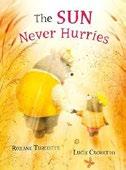
A bear cub learns to live in a leisurely way. Charlie asks her grandfather Papa Jo what his hourglass does, but she doesn’t understand his answer: It “reminds me to take my time to get things done. Just like each grain of sand, every moment of your day is precious.” Over the course of an unhurried day, she begins to comprehend. Together the two bears make a mountain of vegetable peels—and a delicious soup. Afterward, rather than driving, they walk to the village. Charlie notices wildflowers she’s never
Take a cue from this assertive protagonist: Rejoice in who you are and be all you can be.
OLIVETTE IS YOU
KIRKUS REVIEWS 134 MARCH 1, 2024 CHILDREN'S
A self-proclaimed ghost expert instructs readers on how to rid their homes of spirits.
HUGO’S HAUNTED HANDBOOK
observed from the car. Next: ice cream at Papa Jo’s friend’s shop and a trip across the lake to a nearby island. As Papa Jo rows them across, Charlie notices golden highlights on the lake and a bird diving into the water. Once ashore, Charlie watches dragonflies and frogs and sits with Papa Jo on a swing he built. Back home, Charlie overturns the hourglass and reflects on their day. “Did we take our time doing things today?” she asks. “We did,” says Papa Jo as they watch the sun set, commenting that the sun also takes its time. Originally published in French, this very sweet story is a gentle reminder to slow down and take in life’s small moments, especially with those we love. Charlie and Papa Jo’s relationship is realistic and warmly cozy; the delicate, soft, misty illustrations are a perfect complement. Take the time to savor this lovely tale—again and again.
(Picture book. 4-7)
Pup and Dragon: How To Catch a Dinosaur
Walstead, Alice | Illus. by Paul Gill Sourcebooks Wonderland (64 pp.)
$12.99 | April 2, 2024 | 9781728239545
Series: Pup and Dragon

Pup and Dragon are determined to trap a dino. The first entry in the series—a spinoff from the publisher’s holiday-themed How To Catch… picture books— saw the pair attempting to catch an elf. This time, they notice the local kids
working on a project in the hopes of winning the science fair; first prize is a brand-new bicycle. The kids intend to catch a living dinosaur—they’re everywhere, right? Pup and Dragon decide to help. Every time they concoct a plan, however, they wind up wrecking or otherwise falling for one of the traps built by the kids…before picking themselves up and starting again. This formula repeats several times throughout the book but stays fresh with each new contraption. Eventually, it dawns on Pup to help the kids use their talents to win the science fair another way. If Pup and Dragon’s determination and brainstorming set a positive example, then their shirking of blame for the destruction of others’ property is their countervailing vice. Most pages contain four to five panels or one large panel, with action demonstrating clear cause and effect. The cartoon images are appropriately exaggerated and over-thetop, with a Looney Tunes feel; a dinosaur charges through and evades capture every so often, like a mute Road Runner. The kids, who have no dialogue, are racially diverse. This pair may not catch their prehistoric prey, but they’ll definitely capture readers’ imagination. (how to draw a robot) (Graphic fiction. 6-9)
Hugo’s Haunted Handbook
Whamond, Dave | Owlkids Books (32 pp.)
$18.95 | March 12, 2024 | 9781771475877
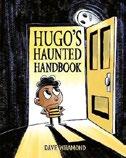
Hugo, a dark-skinned child with huge eyes and a mop of black curls.
“Thinkin’ about ditchin’ your apparition? Do you want to give your spirit a lift? Force out your phantom? Boot out your boo? Then you’ve come to the right book!” Hugo brags about having ousted a ghost, then suggests that readers try a few experiments to determine if they really have a ghost at home (look for ectoplasm, set up a camera). Hugo then identifies typical ghostly behaviors (spirits are prone to boredom and enjoy pranks) and offers suggestions for getting rid of them (shriek “Bam shicka lam shicka boom boom bam,” practice playing your recorder as loudly as you can). All the while, the ghost whom Hugo supposedly banished follows the unaware child from room to room. Eventually, child and ghost meet and talk, with encouraging results. This graphic novel aimed at younger readers features exaggerated cartoon illustrations and silly exchanges between Hugo and the ghost. The tale brims with wordplay, visual gags, potty humor, and whimsy. (Who knew ghosts love to short-sheet each other?) The text is concise, making it ideal for reluctant readers. Some sophisticated vocabulary is incorporated, and the burgeoning friendship between Hugo and the ghost is heartening.
Spook-tacular! (Graphic fiction. 5-8)
Kirkus Star
Finding Grateful
White, Dianne | Illus. by Faith Pray Chronicle Books (44 pp.) | $17.99 April 16, 2024 | 9781797211237
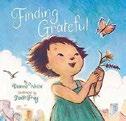
A self-proclaimed ghost expert instructs readers on how to rid their homes of spirits.
“GOT
GHOSTS?” asks
In a busy city, a mother and child go on a meditative journey. The title spread depicts the two protagonists, both beige-skinned and brown-haired, looking distressed as their car emits smoke. Soon, the two leave the broken-down vehicle, and Mama, undaunted, leads her apprehensive child on an impromptu
MARCH 1, 2024 135 KIRKUS REVIEWS CHILDREN'S
adventure through the city. Worry is replaced by curiosity as the child narrates their experience. “Mama says: / you don’t need a map / to find grateful,” the little one tells us.
“Grateful means / noticing / this thing / that thing / anything, really”—bending down to touch bright yellow flowers poking out from the gray sidewalk, smiling and waving to a friendly stranger, enjoying the cool spray of a sprinkler, chasing a boisterous puppy…even taking a tumble that causes sore knees and some tears. Comforted by Mama, the resilient little one continues to explore and then reflects on the simple moments of the day. Perhaps the young narrator has found “grateful” after all. White’s spare, lilting prose evokes the playfulness of this unexpected day with ageappropriate whimsy, using language such as “I tiptoe-lean” and “I stand tree-still.” Pray complements the text with soft, curved lines, a delicate pastel palette of pinks, blues, and greens, and varying perspectives that pinpoint tiny luminous details amid a bustling environment. This one’s just right for social-emotional storytimes. A pitch-perfect introduction to gratitude, reflection, and the art of noticing. (Picture book. 2-5)
Kirkus Star
Paige Not Found
Wilde, Jen | Scholastic (256 pp.) | $18.99 April 16, 2024 | 9781338880564

Autistic kids from New York discover they’ve been part of a billionaire’s experiment.
Eleven-year-old Paige doesn’t know what to think when an email with the subject “Paige Wells Daily Report” pops up on her dad’s laptop. She shouldn’t read her dad’s email, but he’s sleeping, and this is about her, after all. The email contains a GPS map of everywhere she’s been that
day as well as charts showing her heart rate and blood sugar, dopamine, and serotonin levels. She’s not going to ask her parents for the truth, especially not after her dad yells at her to “Be a normal kid!” But Paige’s best friend figures it out: Paige has a secret experimental chip in her head made by tech startup Nucleus. She didn’t actually have her tonsils out when she was 7; instead, they put the mind-controlling Dot in her brain—and it’s getting a software upgrade this Friday as part of Nucleus’ merger with social media company Homepage. The device is made by Elliot Preston, a contentious billionaire who enjoys Twitter feuds. Is Nucleus controlling her mind? Will it leak her private thoughts and feelings on social media? Armed with a list of other autistic kids who have Dots, Paige sets out to find them and stop Preston from experimenting on and profiting from their brains. This exciting story offers validation, intrigue, and diverse representation. Paige, who’s white, is closeted nonbinary and queer.
An empowering kids-versus-corporation quest packed full of disability pride. (Science fiction. 8-12)
Simple Thanks
Wiles, Deborah | Illus. by Bao Luu Roaring Brook Press (32 pp.) | $18.99 April 9, 2024 | 9781250780607
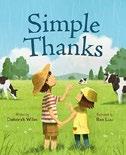
Children delight in nature. Two little ones marvel at their surroundings and thank the wonders all around: the clouds, the rain, and the land. Soon a friend arrives to help the protagonists
plant a sapling. “Love connects us, every one,” the children proclaim. “The world is one”—a phrase that’s repeated occasionally. Other friends appear, and the text suggests relationships among other natural phenomena: “the youngest bee, the oldest tree,” “the rocks, the springs, the birds that sing.” Once more, the youngsters give thanks—for the sea and the sky, for “blooms / for butterflies.” Everyone engages further with nature and each other. At the end, readers are assured that “we’re different, yet we’re all the same… / We’re all the colors of the world.” The story is narrated in sweet, gentle verse. The ideas are inspiring and ennobling, but children’s interest may flag, as the text is on the long side, and the concepts will likely waft over their heads. While the idea of getting kids excited by nature is a laudable one, youngsters may prefer spending time outside to reading this tale. The colorful digital illustrations are bland, though the final double-page spread is quite cheery. The protagonists are tan-skinned and brown-haired; other characters are diverse in skin color and physical ability.
Much-needed encouragement to engage with the natural world, if a bit on the lofty side. (Picture book. 5-8)
War of the Wind
Williamson, Victoria | Neem Tree Press (256 pp.) $12.95 paper | April 23, 2024 | 9781915584618
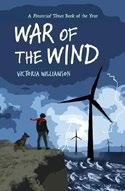
An accident aboard his dad’s fishing boat causes a Scottish boy to become deaf.
Two years after the accident, 14-year-old Max is still coping with
An empowering kids-versus-corporation quest packed full of disability pride.
PAIGE NOT FOUND
KIRKUS REVIEWS 136 MARCH 1, 2024 CHILDREN'S
Definitely for the birds, in a wonderful way.
BIRD REHEARSAL
this change. He’s frustrated with his family (which includes a new baby), his old gang of bullies, the challenge of learning sign language, and integrating with his new classmates. Having previously scorned kids like Erin, who was born deaf, Beanie, who has Down syndrome, and David, who uses a wheelchair, he has difficulty accepting their friendship and recognizing their intelligence. In exchange for permitting wind turbines, the residents of his small island, which was previously too remote for internet access, are promised smartphones and the latest technology. But, unbeknownst to anyone, a scientist is using the turbines to run wicked experiments, causing sleeplessness and outbreaks of aggression among the local population. Max and his new friends must work together and use their abilities to save the island. Max ultimately grows in his relationships and works to engage his former friends, showing them that differences can be positive. This contemporary techno-thriller is absorbing, tautly written, and frighteningly realistic. Dialogue in British Sign Language is distinguished through the use of a different font in all caps. Realistically portraying kids’ cruelty and the protagonist’s own self-doubts, this novel will encourage readers to think about their own actions.
An intriguing mystery combined with an emotional story of challenges and successes. ( British and American Sign Language alphabets, map, glossary) (Mystery. 9-13)

For more by Victoria Williamson, visit Kirkus
Kirkus Star
Bird Rehearsal
Winter, Jonah | Illus. by Stacy Innerst Cameron Kids (32 pp.) | $18.99 May 14, 2024 | 9781949480320
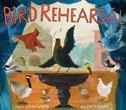
An avian chorus whistles, caws, coos, and calls as day brightens and then fades. In a set of luminously hued tableaux, a chorus of birdsong weaves between and around Innerst’s richly hued close-up portraits of robins and mourning doves, wrens, cardinals, mockingbirds, and over a dozen other common residents of urban and suburban trees and roosts. To go with art that rewards looking and then looking again, the all-birdsong narrative, read aloud, creates a kind of infectiously joyful mouth music: “TWEEDLE-DEE TOODLE-DO / TO-DE-REAR / POODLE-HOO.” “PERC-O-LATER PERC-O-LATER // Mine? Mine? Mine?” Here chickens cackle (“PLUCK PLUCK PLUCK AHHH”), there crows mob a silent hawk with a rapid barrage of caws; later on a mockingbird provides a quick medley as streetlights brighten. For the finale, the entire feathered company gathers for a grand coda. A closing who’s who invites readers and listeners to match headshots with the earlier images, and accompanying notes strike piquant chords: “The wren is a tiny bird with an enormous voice and almost no neck.”
“Canada geese can make quite a mess—watch where you step!”
“Like humans, crows feed on dead animals.”
Definitely for the birds, in a wonderful way. (Informational picture book. 6-8)
Wonderful Goodbyes
Wu, Kelly | Little, Brown (40 pp.) | $18.99 April 2, 2024 | 9780316313322

A family says goodbye to a beloved pet. An unnamed child eyes the fluffy white dog resting nearby: “You have been sleeping more but eating less, playing less, even barking less,” the young narrator observes. The little one is aware that the canine “will be going somewhere far” and only wishes “I could hold you forever.” As the methodically paced narrative continues, the child decides to fill the dog’s remaining days with “wonderful goodbyes.” A pattern is established as the duo visit favorite places and objects for a formal farewell. “Do you see your toys bowing their heads? Goodbye, toys.” “Perhaps you’d like a car ride around our hilly town, through the tunnel of trees?” “Goodbye mellow breeze.” Warm, blended colors, textured with soft lines, create a sentimental tone in sync with the emotional weight of the subject. The narrator reflects on a peaceful moment: “Remember when we’d fall asleep under the summer clouds, the sun hugging us with its gentle rays?” The repeated goodbyes guide young readers along as the narrator plays a favorite song before the dog closes its eyes, “falling asleep. / Goodbye, songs and heartbeats.” After the dog’s passing, the child notes that the dog’s memory will live on, “in all the wonderful hellos and goodbyes. And always with me. / Hello, my dearest. Goodbye.” Human characters present East Asian. Deftly crafted and poignant, a loving guide to farewells. (Picture book. 5-8
MARCH 1, 2024 137 KIRKUS REVIEWS CHILDREN'S
online.
Young Adult
 LAURA SIMEON
LAURA SIMEON
THESE FEMINIST READS ARE UPLIFTING— AND HONEST
THERE’S NO SHORTAGE of nonfiction for young people highlighting the women and girls who’ve achieved remarkable things, alongside fiction with strong and accomplished girl protagonists. This is certainly something to be celebrated. Yet it doesn’t change the fact that sexism remains rampant; it’s something young people experience—and participate in—daily in both their face-to-face and online lives.
How can young people reconcile girl-power messaging in books with the reality that girls are often still powerless?
The founders of Rise: A Feminist Book Project for Ages 0-18 (part of the Feminist Task Force of the Social Responsibilities Round Table of the American Library Association) addressed this issue by establishing clear and specific criteria for their mission of curating an annual book list of “well-written, well-illustrated books for young readers with significant feminist content.” Rise seeks
to honor books that explicitly “explain that there is a gender issue; they don’t leave the reader to guess.” In fact, “a book with a strong female character that does not demonstrate that an inequality exists” might not be a fit for Rise.
As co-chair of the 2024 and 2025 Rise committees, I’m delighted to share a few YA highlights from our latest list
I Kick and I Fly by Ruchira Gupta (Scholastic, 2023): This gripping novel by Gupta, a global activist who works to end sex trafficking, was inspired by her personal experiences with girls much like her 14-year-old protagonist. Growing up in a red-light district in India, Heera faces—and pushes back against—obstacles based on poverty, caste, and gender.
Inaugural Ballers: The True Story of the First U.S. Women’s Olympic Basketball Team by Andrew Maraniss (Viking, 2022): This page-turning nonfiction work tells a triumphant story of dedication to teammates and the pursuit
of athletic prowess. Often going unacknowledged and unsupported, the players and coaches who pushed for recognition and funding for women’s basketball faced both racism and misogyny on the long road to the Olympics.
Didn’t See That Coming by Jesse Q. Sutanto (Delacorte, 2023): Using laugh-out-loud humor to drive home trenchant observations of sexism in schools and the gaming world, Sutanto places her Jakarta high schoolers in situations that will resonate with teens worldwide. Kiki discovers that her online crush is cute classmate Liam—but will he understand why she hides behind the username Dudebro10?
16 & Pregnant by LaLa Thomas (MTV Books/Simon & Schuster, 2023): Two best friends navigate tremendous changes in this frank and
affirming novel inspired by a reality TV show. Black teens Erykah and Kelly come from different socio-economic backgrounds; now, Erykah is pregnant—and keeping her baby—while Kelly looks ahead to college. Thomas explores friendship, medical racism, and more with great nuance.
Nigeria Jones by Ibi Zoboi (Balzer + Bray/HarperCollins, 2023): This remarkable work combines accessibility with sophisticated insight. The book follows a young woman growing up in a Black nationalist movement that’s both highly progressive and rigidly patriarchal. Nigeria grapples with identity, community, belonging, and self-expression as she ventures beyond her father’s tightly
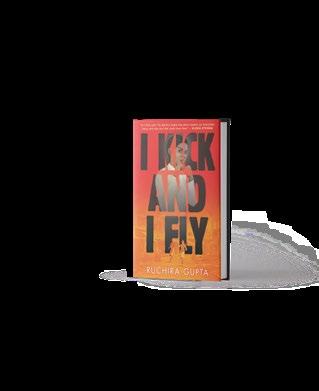
Laura Simeon is a young readers’ editor.
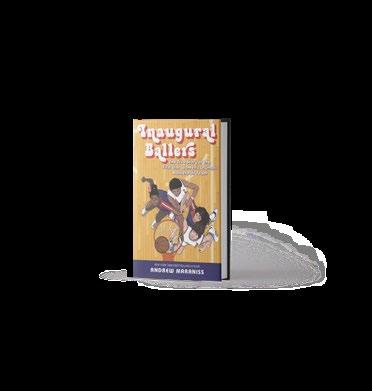
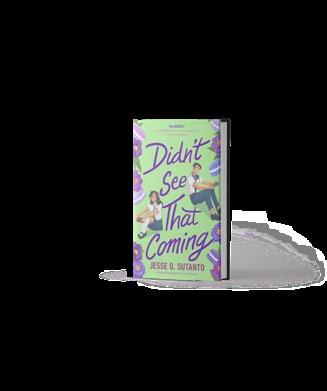


KIRKUS REVIEWS 138 MARCH 1, 2024
Illustration by Eric Scott Anderson
EDITOR’S PICK
Residents of a small town experience a reckoning when a mysterious app leads a group of teens to a dead body.
The first time he plays M anifest Atlas, an app game that people claim can give you anything you ask for, Willie Eckles wants a sign. Life feels stagnant in rural Calico Springs, a predominantly white Missouri town, and Willie yearns for some direction. He’s mystified to find that the app delivers on his requests— albeit with a cryptic twist each time—but no one believes him, not even Bones, his older brother. Eventually, Willie
convinces Bones and his friends (including Sarai from neighboring Lawton, a predominantly Black town) to play with him, but they get more than they bargained for when it leads them to the dead body of Sarai’s white stepfather, who was in a rare interracial marriage. Unconvinced by the authorities’ ruling out of foul play, Willie and his group begin an investigation that stirs up tensions in a community that doesn’t like people probing for answers. As Willie tests the limits of the game’s abilities, he finds that their small town holds darker secrets than he ever
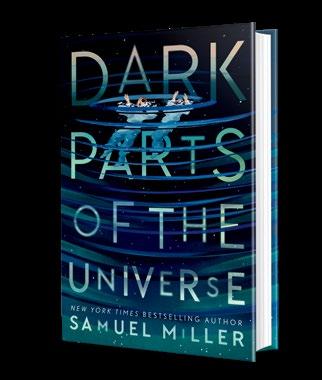
Dark Parts of the Universe
Miller, Samuel | Katherine Tegen/HarperCollins 432 pp. | $19.99 | April 23, 2024 | 9780063160484
expected. Willie’s journey is one of awakening— opening his eyes to social problems and choosing to face that reality rather than turn from it. The page-turning suspense is a draw, but the book’s
ultimate strength is its skillful exploration of racial injustice in rural America. A multifaceted thriller with a powerful social message. (author’s note, further reading) (Thriller. 14-18)
155
Darker by Four
By
June CL Tan
These Titles Earned the Kirkus Star
King of Dead Things By Nevin Holness 152 Crash Landing By Charmaine Anne Li 139 Dark Parts of the Universe By Samuel Miller 153 What’s Eating Jackie Oh? By Patricia Park 154 Relit Ed. by Sandra Proudman
147
MARCH 1, 2024 139 KIRKUS REVIEWS YOUNG ADULT
Struggles to deal with grief and mental illness are well drawn and sympathetic.
STAY WITH MY HEART
We’re Never Getting Home
Badua, Tracy | Quill Tree Books/ HarperCollins (320 pp.) | $19.99
April 16, 2024 | 9780063217805

A group of teens get stuck at a music festival when the keys to their van go missing.
Ever since her older sister’s unexpected return from college, her mother’s car accident, and her father’s expanded work hours, responsible Filipino American Jana Rubio has felt pressured to be constantly available for her family. Before, she could always count on best friend Maddy Parsons, who’s had her own share of family issues, to understand when she needed to cancel plans or hang out less. Jana and Maddy were planning to see their favorite band at a music festival, but their plans changed after an epic argument, and they’re no longer on speaking terms. Refusing to give up this opportunity of a lifetime, Jana decides to go with church friend Nathan Clark—only to discover that Maddy, Maddy’s boyfriend, and Nathan’s younger brother are along for the two-hour ride. Jana’s determined to have fun and be home by midnight as promised, but chaos ensues when Nathan loses his keys. Jana ends up running around the festival grounds with Maddy, trying to find them. Jana, who’s unlikable at times, is a relatable protagonist who unfairly carries the weight of her family’s problems and also acts as Maddy’s “Emotional Support Jana.” The wild concert hijinks are well balanced with Jana’s introspective thoughts as she navigates her fragile
friendship with Maddy and her need to control everything. Nathan and Everett are cued Latine; Maddy reads white. An entertaining and insightful romp. (Fiction. 12-17)
Girls Night
Belle, I.S. | Tiny Ghost Press (310 pp.)
$21.99 | April 16, 2024 | 9781915585134

Fight Club
reimagined with badass queer girls you can’t help but root for.
After self-proclaimed “gossip queen” Alex Veck sees her first fight, something shifts inside her. She starts digging into why new kid Clementine Rady was beating up popular class president Olive Barnes in a hallway at school, but in return for the inside scoop, Alex becomes indebted to someone dangerous: Tulsi Ortiz is a not-particularly-cheery cheerleader with a lot of social capital. Classmate Sunju Park also has secrets to hide. After the four girls attend a party that’s broken up by the police, they start to bond, forming an unlikely friend group. Alex has a wild idea: Maybe they could fight each other. For fun. And it is fun, so much that they don’t want it to stop. As the quartet grows closer, though, their clashing personalities and different backgrounds aren’t the only obstacles they face. Someone discovers the existence of Girls Night, their fight club—someone who has different plans for the group. This is an exciting, banter-filled story centered on girls who are finding themselves and finding each other. Their delightful moments of genuine rawness come not from when
they’re fighting but from when they’re not. The central cast of characters includes lightly developed diversity across multiple dimensions of identity, including disability, ethnicity, sexual orientation, and body size.
Endearing and fun. (content warning) (Thriller. 14-18)
Stay With My Heart
Bhuiyan, Tashie | Inkyard Press (384 pp.) $19.99 | Jan. 2, 2024 | 9781335010032

A music-filled offering that tackles mental illness and parental loss with heart and hope.
Bangladeshi American Liana Sarkar, a brandnew high school graduate, has a lot to grapple with over the summer before she starts studying music management and marketing at UCLA. She’s waiting to get help for her anxiety and depression until she’s at college, so that her dad—who’s mostly been absent since her mom died— won’t see the treatment on his health insurance and find out. Adding to her stress, Liana’s best friend has left Los Angeles for a summer program at Columbia, and in an attempt to help a cute boy in a local band, Liana majorly messes up. She not only accidentally sabotages the band’s chances for success, but the complications spill over into her working relationship with her music exec dad and her internship at the record company where he recruits new acts. As Liana tries to fix the mess, she gets closer to the band members, including handsome Korean American Skyler Moon. Bhuiyan’s multidimensional characters express heartfelt intensity, and Liana’s struggles to deal with her grief and mental illness are well drawn and sympathetic. The supporting cast of characters and their relationships— particularly those among the lovable boy band members—provide the story with depth and feeling, making it sing.
KIRKUS REVIEWS 140 MARCH 1, 2024 YOUNG ADULT
Snappy dialogue and sympathetic characters make for an enjoyable read.
LUCKY BREAK
Song titles open each chapter, and, along with the exploration of Liana’s love of the industry, they provide music lovers with much to enjoy. An emotional, lyrical read. (Fiction. 13-18)
Something Kindred
Burch, Ciera | Farrar, Straus and Giroux (304 pp.) | $19.99 | April 2, 2024 9780374389130
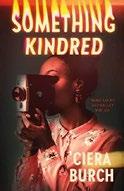
Jericka and her mom move to her parents’ hometown for the summer to take care of her dying grandmother.
Seven teen-yearold Jericka had the perfect summer planned out—she was going to hang out at the beach with best friend Leslie before Leslie left for college and work on her photography portfolio for her dream school, Parsons. But now, Jericka and her mom are on their way from New Jersey to Coldwater, Maryland, because her maternal grandmother is dying. She knows only two things about her grandmother: Her name is Carol Annette, and she left Jericka’s mom and uncle when they were young children. Jericka reluctantly decides to spend her summer establishing a relationship with Gram, reconnecting with her dad (who still lives in town but whom she hasn’t seen since she was a baby), and photographing Coldwater. As she gets to know the town, she also grows closer to local “ghost girl” Kat. Kat says the town is haunted and that there are “echoes” lingering everywhere. As Jericka’s romantic relationship with Kat
blooms, she too begins to sense the spirits and feel a pull toward Coldwater. Burch lovingly explores forgiveness and memory in this novel centering Black characters that has something—from paranormal discovery to queer romance in a small town—for everyone.
A moving story about home with a supernatural twist, exploring what happens to those who leave and the ones left behind. (Fiction. 14-18)
Lucky Break
Carter, Brooke | Orca (192 pp.)
$10.95 paper | April 16, 2024 | 9781459839724
Series: Orca Soundings
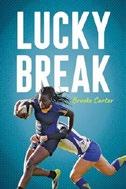
A teenage sports star battles rugby opponents and inner demons in this quick and compelling read.
Seven teen-yearold Lucy “Lucky” Graves is at the top of her game, both literally and figuratively. A straight-A student and her high school’s star athlete, Lucy excels both in the classroom and on the rugby pitch. Though she lost her father when she was 12, Lucy is surrounded by people who love and support her, including her single mom, best friend and fellow rugby player Emily, and her new crush, New Zealand transplant Andy. There’s nothing standing in the way of her earning a college scholarship, until a terrible hit during a rugby match results in a broken ankle. When a video of her accident goes viral, Lucy’s mental health also deteriorates, threatening both her rugby career and her relationships. In order to get back
on the pitch, Lucy must confront old demons and learn to love the game again. Readers will enjoy the actionpacked scenes, as well as the concise yet thorough explanations of all things rugby. Snappy dialogue, strong pacing, and sympathetic characters make for an enjoyable and easily digestible read. Mental illness is a recurring theme and is handled with care. Lucy is biracial, with a Black Trinidadian father and a white Irish mother; supporting characters read white. A relatable, realistic look at the pressures teen athletes face that will appeal to reluctant readers. (author’s note) (Fiction. 13-18)
Normal Kids
Di Lorenzo, Melinda | Orca (128 pp.)
$10.95 paper | April 16, 2024 | 9781459838574
Series: Orca Soundings
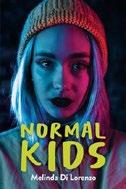
Seven teen-yearold Hannah Dresher is tired of being responsible for her dysfunctional family. Her alcoholic mother’s frequent benders leave Hannah concerned about the welfare of Seth, her younger brother. When she returns from work to find her mother passed out in bed with a strange man, Seth missing, and Seth’s broken cell phone on his bed, along with a bong and the empty rent money envelope, Hannah knows this is another problem that she’ll have to fix. With no reliable adults to turn to, Hannah begins a journey through dangerous parts of town in search of Seth. Fortunately, she comes across Eli, a cute and helpful boy she barely knows from math class, who joins her on her hunt. During an action-packed night, they question a drug dealer, run from cops, and almost get beat up. Over the course of their adventure, they go from strangers to something more. Hannah is a young person weighed down by unfair responsibilities, and in meeting Eli,
MARCH 1, 2024 141 KIRKUS REVIEWS YOUNG ADULT
she realizes that she wants to put her own needs first, setting off an internal conflict that becomes a running theme throughout the book. This thrilling story is ultimately realistic but optimistic, with Hannah learning to find hope in the people around her. Hannah and Eli are cued white. Reluctant readers will be engaged by this suspenseful and heartening tale. (Fiction. 14-18)
Playing for Keeps
Dugan, Jennifer | Putnam (320 pp.) | $19.99 April 30, 2024 | 9780593696866
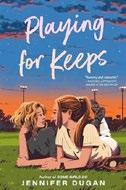
Ivy, an 18-yearold referee, and June, a 17-yearold pitcher, exasperate each other the moment they meet.
In this voicedriven, absorbing dual narrative, anxiety about college applications drives the protagonists’ behavior almost as palpably as their grief-stricken family dynamics do. Ever since June’s mother, a former softball pitcher, passed away from breast cancer, June and her retired minor-league baseball player father have made June’s athletic success their obsession. Meanwhile, Ivy’s parents pressure her to focus more on academics, just like her late brother Nicky, who died of leukemia, did. Both young women cling to intense perfectionism, their desperation a shrewd cautionary tale for anyone struggling toward demanding dreams. When Ivy and June realize they’re in the “big, gay, dead family club” together (June is a lesbian, and Ivy is bisexual; both are witty), they wind up bonding, then kissing, and then falling in love. Their motivations are clear and relatable—and the two are clearly bound for strife, given that players and officials aren’t allowed to date. Plus, June has been pushing her injured rotator cuff way too far, in part thanks to the complicity of irresponsible adults. Ivy’s and June’s flawed coping strategies clash with their adorable budding romance, propelling
them toward gut-wrenching heartbreak and terrifying, necessary, affirming new choices. Ivy and June are cued white; their respective best friends—Japanese American Mia and Javonte, who’s Black—are well developed in their supporting roles.
A page-turner that handles heavy topics with wisdom. (Romance. 13-18)
When Two Stars Collide
Eager, Cheryl | 5310 Publishing (360 pp.)
$26.99 | March 4, 2024 | 9781998839094

Two lost souls find each other in this emotional, gender-swapped novel inspired by “Cinderella.”
Eighteen-yearold Cinder Kato, who has Japanese and Scottish ancestry, performs music incognito on a popular video-sharing platform under the stage name Umbra. With his eyeliner, tattoos, and lip piercing, not to mention a less-than-perfect, secret-filled home life with an abusive stepfather, he self-identifies as a dark soul, channeling his pain into his musical talent. Beautiful, blond Henrietta Cunningham, who’s cued white, is the 18-year-old star of a hit rom-com TV series. Outwardly, Henri exudes confidence, when in truth, she’s quite naïve, suffers from anxiety, and needs to find her own path, free from the influence of others. After Cin rescues Henri from embarrassment at school, she pours out her true fears and regrets to him, and he becomes her safe person. Afraid to have a negative impact on the fragile Henri, Cin, who’s filled with rage and other intense emotions, is unable to admit his true desires and affection. In true fairy-tale fashion, both of them are looking for happiness, and they ultimately find it in each other, triggering an intense mutual desire to fulfill their needs. This passionate, sexy, angst-filled story will appeal to romance readers who appreciate strong characterization. An intense and absorbing tale of first love. (author’s note) (Romance. 15-18)
Merciless Saviors
Edgmon, H.E. | Wednesday Books (336 pp.)
$20.00 | April 16, 2024 | 9781250853639
Series: The Ouroboros, 2
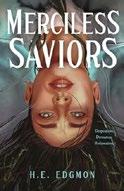
Gem’s adventures continue in the second book in the Ouroboros series.
Picking up where Godly Heathens (2023) left off, Gem upsets the balance of the universe by killing the Cyclone. They inherit the ability to practice magic without sacrifice, and they use that power to seek revenge against Rory’s abusive grandparents. Gem then goes missing, only to wake up in the Wheeler family’s barn two weeks later. Gem returns home with a new awareness of their own past trauma, and they’re devastated to discover that their loyal dog, Hank, needs to be put down. A police officer is also seeking to question Gem about Zephyr’s death. Gem stabs themself with the Ouroboros, which sends all the gods back to the Ether, while their human bodies lie comatose on Earth. Now Gem must simultaneously piece together the fragments of their traumatic past and restore the magical balance of the universe by fighting their nemeses, all while dealing with the annoying humans who worship them. Less polished than the previous entry but more action packed, this is a chaotic adventure in which the gore of the gods is interrupted by human flashbacks from many lifetimes. Though confusing at times and disturbing at others, the novel features complex queer Indigenous characters and portrays the persistence and resilience of survivors of abuse. An engaging, albeit messy, sequel. (content warning, map, list of characters) (Fantasy. 15-18)

For another Indigenous fantasy novel, visit Kirkus online.
KIRKUS REVIEWS 142 MARCH 1, 2024 YOUNG ADULT
Verse in various forms effectively conveys themes of sustainability and activism.
WILD DREAMERS
Wild Dreamers
Engle, Margarita | Atheneum (224 pp.)
$18.99 | April 23, 2024 | 9781665939751

Traumatized teens find each other and bond over a shared passion for conservation.
Ana, a Cuban American 17-year-old, is living in a car with her mother. Her mom’s job doesn’t pay enough to cover the cost of living in California’s Bay Area, especially now that they’re hiding from her dangerous father, who’s wanted by the FBI for domestic terrorism. A chance meeting with Leandro, a recent refugee from Cuba who’s also 17, leads to instant attraction, and a romance grows. Leandro witnessed his father drown during their dangerous journey to Miami from Cuba, and he can’t shake the guilt and psychological scars. Service dog Cielo is his constant sidekick, helping with Leandro’s panic attacks. Cielo proves to be a wise companion, sharing observations on emotions, nature, and the human condition in chapters written from her perspective, which are interspersed with chapters voiced by each teen. Ana and Leandro care deeply for the natural world around them, and they start a rewilding club at school to help support the work of environmental scientists and wildlife rescuers. The pair become involved with a pregnant puma who needs immediate support, and they work to make changes for the puma population. Verse in various forms, including beautiful concrete poems, effectively
conveys this story’s themes of sustainability, resilience, and activism. A transformative journey celebrating the power of overcoming personal struggles to make a lasting impact. (author’s note) (Verse fiction. 12-18)
Trajectory
Gordon, Cambria | Scholastic (304 pp.) $19.99 | April 2, 2024 | 9781338853827
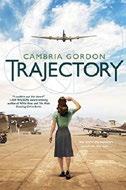
Seventeen-year-old Eleanor is recruited for her math prowess to support U.S. efforts during World War II.
It’s 1942, and Eleanor, who’s Jewish, lives with her family in Jenkintown, just outside Philadelphia. The Schiffs anxiously await news from abroad about the Nazis, Jewish ghettos, and the fate of family members in Poland. Following her participation in MathMeet, a competition for Pennsylvania high schoolers, Eleanor is recruited for the top-secret Philadelphia Computing Section of the Women’s Army Auxiliary Corps. Like her math professor father, who’s been disabled by a stroke, Eleanor has long had a gift and passion for math; she quickly sets herself apart from the rest of the group. Eventually, she’s even selected to go to an army air base in the California desert for a classified assignment involving a new bombsight called the Norden. Gordon anchors this work of fiction, which includes equations and models, in many real historical elements. Alyce, Eleanor’s new friend at the PCS and the only Black woman on the team, is a kindred
spirit. Gordon explores segregation in military and civilian life, the Japanese American internment, sexism, and the Holocaust in ways that are historically accurate and appropriately horrifying. Eleanor starts off unsure and unnoticed but slowly, believably blossoms in self-confidence; the supporting characters are also well drawn and likable. The plot moves quickly, and the brisk pacing will keep readers turning pages.
Compelling, fast-paced historical fiction. (image credits, author’s note) (Historical fiction. 12-16)
Star Wars:
The High Republic: Defy the Storm
Gratton, Tessa & Justina Ireland
Disney Lucasfilm (464 pp.) | $18.99
March 5, 2024 | 9781368093811 | Series:
Star Wars: The High Republic
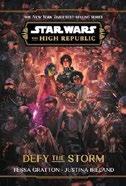
The Stormwall blockades hundreds of worlds from Republic aid, but as the Nihil expand their empire, cracks in the wall threaten the future of their impenetrable domination.
Avon Starros loathes everything about the Nihil. She lacks the ruthlessness that drove her ambitious senator mother to betray the Republic for a seat beside Marchion Ro. One year ago, during the fall of Starlight Beacon, Avon helped her friend Imri, a Jedi Padawan, hide from the Force Eaters, but it’s only a matter of time before the Nihil find him. With the help of an unlikely team, all with their own motives for breaking through the Stormwall, Avon embarks on a mission of rescue and revenge. Only one person, a Jedi, has ever cracked the Stormwall’s defenses, but that’s enough to give Avon hope. Chapters alternate between the perspectives of Avon (a teen genius), Xylan Graf (an opportunistic theoretician held hostage by the Nihil), Jordanna Sparkburn (a San Tekka in search of her family), and
>>>
MARCH 1, 2024 143 KIRKUS REVIEWS YOUNG ADULT
THE KIRKUS Q&A: TRACI CHEE
The acclaimed YA author reimagines a classic samurai film in her new fantasy novel.
BY VICKY SMITH
TRACI CHEE’S DEBUT NOVEL, a fantasy trilogy opener called The Reader, was a finalist for the 2016 Kirkus Prize; We Are Not Free, her 2020 historical novel about Japanese American teens detained during World War II, won multiple accolades; her 2022 fantasy, A Thousand Steps Into Night , made the National Book Award longlist. With her newest fantasy novel, Kindling (Harper/HarperCollins, Feb. 27), Chee adds to her unbroken string of Kirkus stars. As in the films that inspired it—the 1954 Akira Kurosawa classic, The Seven Samurai , and its 1960 American remake, The Magnificent Seven —seven warriors come to the defense of a peaceful village against a band of marauders, but Chee’s characters are teens whose martial magic literally burns its wielders out by their early 20s. Cast adrift after the war they’ve fought has ended, they bear scars both physical and psychological. Chee spoke to Kirkus via Zoom from her home in California; the interview has been edited for length and clarity.
The Kirkus review called Kindling an exploration of “shared trauma.” Was that something on your mind as you were writing it?
One of the reasons I wrote Kindling now is because of that collective-trauma element. I’ve been in love with the Seven Samurai and Magnificent Seven story for decades, and I’ve always wanted to write something inspired by those films. For
the longest time, I couldn’t figure out how to justify telling the story again, when it had already been told so perfectly in 1954. I watched the most recent Magnificent Seven, the one with Denzel Washington, during the pandemic. I started thinking, What if it wasn’t veterans of the Civil War or samurai, but children? Why would these former soldiers have to be


children? What kind of world would ask so much of its children—to give their lives for it, to fight for it, to sacrifice for it?
Then I stumbled upon [the idea of ] this magic system that literally shortens the lifespans of the people who wield that magic. We have these characters with their shortened lifespans, fighting for a future that they probably won’t see— and that is something that reflects on our world today. When I was growing up, we were promised certain things for our future. You could have stability, and safety. But Columbine happened when I was a teenager. Since then there have been more and more
mass shootings, often in schools, and since then we’ve seen the instability in our financial system [and] this divide between the haves and the have-nots. We’ve seen climate change—we’ve seen its effects; we’re living with them right now. And we’ve seen the forecasts for what that’s going to look like in the future. We can’t promise [safety and stability] to our young people. And yet they’re the ones on the frontlines of these fights. I think about young people organizing, mobilizing, voting, and fighting, because we haven’t been able to solve these problems for them. I felt like I could speak to that [idea] through fantasy.
YOUNG ADULT // Q&A
KIRKUS REVIEWS 144 MARCH 1, 2024
Topher
Simon
Kindling’s second-person narrative voice is incredibly striking—tell us how you found it.
I actually struggled against this voice for a very long time. I go through this process, in my early drafts, where I’m really just trying to home in on the voice, the tone, the language. Very early on, I came up with the second-person perspective, this you. I thought, OK, that’s really neat—but it’s not possible to [maintain] over the course of an entire novel. I did one chapter in second person for We Are Not Free, and I was like, No way, no, I can’t do 400 pages of this. It’s unsustainable; it will be unreadable
For the next, probably, 10 drafts, I tried writing anything but that second person, because it was terrifying. But none of those other drafts were working. Around draft 12
or 13, I finally embraced it. Once I [had decided on it,] I realized that the fun of second person is that it’s secretly a first person, and figuring out who was that secret first person was a real treat. I landed on this idea of [the narrator] being like a tragic Greek chorus of kindlings who have fallen in battle, literally haunting the seven main characters: narrating their own lives, their own actions, their own thoughts, their own feelings. That was so much fun, because if they’re ghosts, then that gives me the ability to be beautiful, ethereal, soaring, super poetic at points, and then because they’re children, it allows me to also be very petty, very jealous at times of the lives that these characters are allowed to live. They can call out the main characters, like,
I go through this process, in my early drafts, where I’m really just trying to home in on the voice, the tone, the language.
“You’re lying about that.” That was so much fun.
Reading Kindling sent me to Seven Samurai. I was struck by how closely you hewed to your inspiration while making it your own story. Oh, I’m so excited that you saw it! I love it. Did you also love it?
Oh my gosh, yes. It was a 3-1/2-hour movie made in 1954, and it was incredible. I know it’s so long, but also it’s just so good. And I love that slow burn of it, where you’re not sure about these characters at the beginning. But then, by the time you get to the end, each one of them is so precious to you. That was something that I really loved about it, and the 1960 Magnificent Seven as well. I wanted Kindling to be recognizable as a Seven Samurai story, and for me, that meant the shape of it.

We have the three acts. First, the warriors are gathering. Then they’re preparing for the defense of this little village [in the second act]. The last third is that very big battle at the end. And three always survive in a Seven Samurai story. I knew that I’d have to kill off more than half the kindlings by the end. I needed to figure out which ones were going to have the most impact in that way, and which ones needed to survive thematically as well. And I wanted to keep the idea that these characters who don’t have really that much to gain are fighting for this village of strangers because that’s who they are. They know that some fights have to be fought and are worth fighting, even at great cost to themselves. Those elements were important. But within that [aspect], I felt like I had a lot of flexibility in terms of who exactly these characters were. This is an advantage of telling it in a novel format—you can really get inside the heads of these characters and live through their pasts in a way that you can’t with a film. That was really, really fun. A huge challenge, of course, to do that for seven characters, but it was such a joy to really get to know each of them.
I confess I teared up more than once while reading your book. That appeals to the fantasy writer in me. I love making readers cry.
Vicky Smith is access services director at Portland Public Library in Maine.
Q&A // YOUNG ADULT Kindling Chee, Traci Harper/HarperCollins | 432 pp. | $19.99 March 5, 2024 | 9780063269354
MARCH 1, 2024 145 KIRKUS REVIEWS
Vernestra Rwoh (a grieving Jedi Knight, who’s on sabbatical). The first half of the book lags due to the slow setup, but once the characters set off on their personal missions, the pace flies at hyperspeed toward a satisfying cliffhanger ending. Most characters have brown or tan skin, and the story casually includes representation of queer characters and relationships. An adventure with a slow start but one that’s worth the wait. (timeline) (Fantasy. 14-18)
How To Manage Your Eco-Anxiety: An Empowering Guide for Young People
Grose, Anouchka | Illus. by Lauriane Bohémier | Magic Cat (96 pp.) | $18.99 March 12, 2024 | 9781419771361 | Series: 10 Steps to Change

A survey of practical strategies for young people to use to alleviate anxiety related to the effects of a warming planet.
As people experience the impact of our climate emergency, psychoanalyst Grose has seen more clients who exhibit stress over climate change. Acknowledging that ecoanxiety is “a reasonable response to a real problem,” she presents 10 steps, each with an accompanying toolkit, to support teens in managing their feelings, building resiliency, taking empowering action, and more. The book opens by identifying how these challenging feelings might show up, both mentally and physically. Throughout, Grose balances the need to be genuinely concerned about climate change with learning how to take care of oneself so the concern doesn’t harm one’s well-being. She acknowledges that people will need different things, especially when it comes to self-care, and offers a variety of concrete suggestions for common challenges, including striking the right balance with the amount and kind of
information we consume and finding a community of like-minded people who can offer support. The informal font, pastel-colored pages, and whimsical illustrations of flowers, rainbows, and toadstools give the work a journal-like feel and help lighten the mood. The human figures scattered throughout are diverse in skin tone.
An empowering guide to living with the stress of the climate change crisis. (author’s note, glossary, resources) (Nonfiction. 12-16)
Discovering Life’s Story: The Evolution of an Idea
Hakim, Joy | MITeen Press/Candlewick (192 pp.) | $22.99 | April 16, 2024
9781536222944 | Series: Discovering Life’s Story, 2
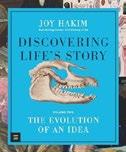
The second in a series about life sciences, this volume provides a comprehensive history of how the theory of evolution took root, grew, and flourished.
In 12 chronological chapters spanning from the mid-1700s to the turn of the 20th century, the book highlights a panoply of revolutionary ideas, brave thinkers, and careful researchers responsible for our understanding of geologic time, genetic mutation, and natural selection. Some of the figures Hakim introduces will be familiar to any high school biology student, such as Charles Darwin, Carl Linnaeus, and Gregor Mendel. Others are lesser known, such as Mary Anning (an English fossil hunter who made pivotal discoveries during the Enlightenment), Jeanne Baret (a Frenchwoman who disguised herself as a man in order to collect plants from around the world), and Geneviève Thiroux d’Arconville (an 18th-century French scientist who researched putrefaction and decay). While the scientific ideas presented are big, the straightforward prose simplifies the concepts so that the work reads almost like a novel, and the author’s use of the present tense lends immediacy.
The pleasing layout, with many photos, drawings, etchings, paintings, and textboxes, animates the text even further. Students seeking a good resource for a report on evolution and related matters will find a wealth of useful material here.
A compelling and important history of a seminal idea. (further reading, source notes, bibliography, image credits, index) (Nonfiction. 13-18)
Sound the Gong
He, Joan | Illus. by Tida Kietsungden Roaring Brook Press (368 pp.) | $19.99 April 30, 2024 | 9781250855367 | Series: Kingdom of Three, 2
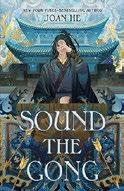
Unwilling to abandon Xin Ren in the war against the ambitious prime ministress Miasma, Zephyr puts her own existence on the line in this sequel to Strike the Zither (2022).
Zephyr, god of weather, was once banished from the heavens and forced to live the life of a human girl as punishment. She rose to prominence as strategist to the lordess Xin Ren, only to be killed in battle by Ren’s Southern allies, along with Ren’s general and swornsister, Lotus. Death frees Zephyr’s spirit from its mortal form, but she returns to Ren’s side by inhabiting Lotus’ body, and in the process, she inadvertently dilutes her divine qì. Hoping to save Zephyr from herself, Zephyr’s sisters beg her to live with them as a god again, and they reveal that Ren is fated to die without achieving her goal. Undeterred, Zephyr strikes a deal with the empress of deities and sets out to rewrite destiny. The packed, fast-moving plot reflects Zephyr’s narrowed focus and increasing desperation to maneuver Ren into a position of victory, no matter the cost. Her tactical brilliance is displayed with each stratagem she employs to further her ends, though her former arrogance is replaced with a mix of vigilance and
KIRKUS REVIEWS 146 MARCH 1, 2024 YOUNG ADULT
grief for what she sacrifices. The darker tone of this installment persists until the final twist, but the end offers hope and a measure of closure. This duology closer will linger with readers beyond the last page. (major figures, character illustrations, map, author’s notes) (Fantasy. 13-adult)
The Last Love Song
Holford, Kalie | Blackstone (250 pp.)
$15.99 Paper | April 9, 2024 | 9798212638012
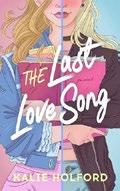
A recent high school graduate navigates love and the music world as she discovers the true story of her deceased mother.
Grams and Nana, her grandmothers, give Mia Peters an old letter from her mom, noted country singer Tori Rose Peters. Tori Rose, who was the pride of their small town of Sunset Cove, Oregon, died when Mia was young. The letter leads Mia on the scavenger hunt her mom set up for her to discover her missing diary pages and learn the truth about the woman behind the music, including the identity of Mia’s father. Although Mia shares her mom’s passion for music, she can’t imagine abandoning her grandmothers like her mother did, even though her best friend, Britt Garcia (who’s sometimes more than a friend), is leaving for Nashville and wants Mia to come along. In narratives that alternate between Mia’s present and Tori’s past, the young women find love and their voices. With song lyrics interspersed between lush, poetic prose, the novel maintains a strong sense of musicality even when the plot sometimes drags. Suspension of disbelief is required for readers to buy into the scavenger hunt, which all works too easily, but for those willing to go along for the ride and embrace the fun and drama of it all, it’s an emotionally satisfying journey of self-discovery filled with romance and friendship. Mia and Tori
are white; Britt is Colombian American. An appealing, lyrical, and romantic coming-of-age story. (Fiction. 13-18)
Kirkus Star
King of Dead Things
Holness, Nevin | Atheneum (320 pp.) $19.99 | April 16, 2024 | 9781665946919

Two Black teens in London take life, death, and magic into their own hands.
Eli and Malcolm couldn’t be more different. Although they’re both British Jamaican teens who wield magic, that’s where the similarities end. Eli uses his magic to heal people and do odd jobs for Pam, his cantankerous landlord. Malcolm’s magic can wake the dead, which attracts fear rather than friends. Eli can’t remember his past or who he is from before three years ago. Malcolm can’t escape the infamy of his absent father, Casper, the duppy king. When old associates of Casper’s turn up dead and robbed of their magic, Pam sends Eli and his friends Sunny and Max to find Osebo’s fang, a powerful weapon that can eat magic and even kill a god. What else could be responsible for these vicious killings? As Eli’s and Malcolm’s paths intertwine, they must learn to trust each other or risk losing London’s magic for good. Holness’ debut novel overflows with drama, culture, and fantastical realism. Anyone with roots in the Caribbean will chuckle at the familiar array of characters that populate this world. Readers will feel transported as the vivid scenes play out on each page, drawing them in with universal elements such as struggles with identity, family, and an uncertain future. Hopefully this will not be the last we see of Eli and Malcolm.
An electrifying debut. (Fantasy. 14-18)
YOUNG ADULT
The Reappearance of Rachel Price
Jackson, Holly | Delacorte (448 pp.)
$20.99 | April 2, 2024 | 9780593374207

The mother Annabel Price thought was dead returns with a story about where she’s been—but 18-year-old Bel knows she’s lying.
Ever since Rachel Price’s unexplained disappearance 16 years ago, true-crime fans have come up with plentiful theories about what happened. Bel and her family members, who are white, cobbled together lives for themselves after a jury found Bel’s father, Charlie, not guilty of murdering his wife. Beset with medical bills for his elderly father, Charlie recently agreed to participate in a documentary about the unsolved mystery. Black British filmmaker Ramsey Lee is well into the process of interviewing the Prices when his project gets an unanticipated boost after an exhausted, disheveled Rachel staggers back into town. Rachel is eager to resume her role in the family, but the inconsistencies in her accounts raise alarms for Bel. With the help of the youngest member of the filmmaking team, Bel sets out to learn what really happened. Along the way, someone else disappears, and Bel uncovers a tangle of lies that make it impossible for her to trust people she thought she knew. When things come to a head the night of her grandfather’s 85th birthday party, Bel ends up in a race for her life. The last quarter of the novel tears along at a breakneck pace before arriving at a satisfying and unexpected conclusion. Readers will be captivated by this twisty thriller and its uncompromising protagonist. (Thriller. 14-18)

For more by Holly Jackson, visit Kirkus online.
MARCH 1, 2024 147 KIRKUS REVIEWS
Ideal for anyone who’s longed for more than what the world tells them they can be.
THE SMOKE THAT THUNDERS
How Do I Draw These Memories?
Joshua, Jonell | Levine Querido (424 pp.) $24.99 | April 16, 2024 | 9781646142712
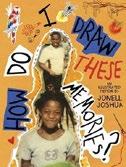
An illustrator unpacks memories of her upbringing through short stories, photographs, and drawings.
Opening with her earliest memories from Savannah, Georgia, Joshua leads readers through her life growing up with a mother who had bipolar disorder. Following a nonlinear track, the author presents a story about family, faith, and selfdiscovery, using excerpts from conversations with her family members, including her mother, brothers, and grandparents, alongside the memories she’s held on to. Through sharing elements of her life—such as her few memories of her father, who passed away early in her life, and her family’s migration between Georgia and Willingboro, New Jersey—Joshua’s goal seems to be to piece together not just memories but an understanding of how her family influenced the person and artist she would become. Colorful drawings interspersed with the text illuminate exchanges between Joshua and her brothers, giving breadth to the work’s presentation. The author includes some rough and emotionally difficult scenes among the brief stories, which vary in length from a few paragraphs to several pages. The individual entries sometimes end abruptly with no resolution before jumping to the next one. Since the narrative isn’t presented in chronological order, it can be difficult to stay
connected to the book, although the bursts of artwork and family photos help to reengage readers. A deep and sometimes confusing dive into memories through diverse media. (production notes) (Graphic memoir. 15-18)
The Harrowing
Kiesling, Kristen | Illus. by Rye Hickman Amulet/Abrams (240 pp.) | $24.99
April 16, 2024 | 9781419760846

A girl’s ability to predict crime embroils her in a troubling experiment. Rowan, who works on her family’s worm farm, is still mourning the violent murder of her mother 12 years ago. She has long since dropped the habit—instilled in her by her supposedly germophobic mom—of wearing red gloves out in the world. But now Rowan’s in her senior year of high school, and she discovers that the briefest contact of her hand against another person results in her having terrifying visions of death. Rowan is quickly whisked off to Rosewood, a boarding school, where she learns that she’s a Harrow, or a person gifted with the ability to see crimes before they occur. In this graphic novel that blends Shallow Graves by Kali Wallace with “Minority Report,” Rowan slowly learns that protection and rehabilitation are not Rosewood’s only goals, and that her mother’s fate might be connected to secrets she uncovered. The story is paced on the slower side, but the action builds up as Rowan realizes that the boy she has a crush on might soon be implicated
in her secretive new world, and that her own family might be hiding something in plain sight. The muted grayscale art makes the touches of red pop, but some jerky transitions between action scenes can make it hard to follow the plot.
Rowan reads white; Lucas has brown skin and curly black hair. An original, genre-blending graphic novel for patient readers. (Graphic horror. 14-18)
Breathe: Journeys to Healthy Binding
Kobabe, Maia & Sarah Peitzmeier | Dutton (64 pp.) | $19.99 | $10.99 paper | May 7, 2024 9780593855836 | 9780593855829 paper

Stories and information about chest binding from university researcher Peitzmeier and award-winning author/illustrator Kobabe, who’s known for Gender Queer: A Memoir (2019).
Through anonymized, illustrated interviews, female-assigned people of various ages, races, and genders share their experiences with chest binding. Within these meaningful personal stories, they touch upon issues of mental health and describe how binding has made them feel more at ease in their bodies, as well as some of the physical issues that can arise when binding. The authors approach the topic from a harm-reduction standpoint, providing advice on ways to minimize these problems without giving up binding entirely. This book is a valuable resource for people who bind or want to bind, and the stories are full of snippets of wisdom, such as never to use ACE bandages or plastic wrap. Unfortunately, the last third of the book, which is dedicated to offering direct advice, does not thoroughly compile the information discussed earlier in the stories: The content is excellent, but the presentation is disorganized, with self-reflection worksheets, brief tips, advice in comic
KIRKUS REVIEWS 148 MARCH 1, 2024 YOUNG ADULT
format, data, and simple physical exercises all thrown together, making the book difficult to use as a reference work. For example, Kobabe and Peitzmeier suggest choosing a binding method that is “kinder to your body” or trying a different style of binder, but readers must rely on self-reflection or comb through the interviews to determine exactly how to follow this advice.
A realistic, affirming guide to binding. (Graphic nonfiction. 14-adult)
The Smoke That Thunders
Kome, Erhu | Norton Young Readers (400
$18.99 | April 9, 2024 | 9781324052654
pp.)

A headstrong teen girl takes a leap of faith to forge her own future in this West Africa–inspired fantasy.
Naborhi Tanomare is fated—like many others in her small town of Kokori—to go through the rites of passage to womanhood, become betrothed to a man who’s willing to pay her family’s bride price, and live a quiet, docile life. Despite mastering the skills expected of her, Naborhi longs for freedom—the freedom to gain an education and make her own choices. But the only way to achieve this dream is to run away, even though it could mean leaving behind her sister, Tega. Before she can enact her plan, however, she’s visited by a magical, red-furred, foxlike creature that leads her to the forbidden land of Oron. What follows will change Naborhi and her future in ways she never expected. Along with friends Atai and Tamunor, Naborhi journeys across lands, where she faces many perils, discovers ways of life she’d dared not imagine, and saves kingdoms from never-ending bloodshed. In the end, she must weigh what she owes her family against what she owes herself. As readers make their way through Naborhi’s inspiring journey, the steadily paced, first-person narrative featuring a Black cast deftly balances exposition with action. The secondary characters
are also well developed, endearing them to readers. This is an ideal story for anyone who’s longed for more than what the world tells them they can be.
An enticing read. (map) (Fantasy. 13-18)
Calling of Light
Lee, Lori M. | Page Street (384 pp.) | $17.99 April 16, 2024 | 9781645676201 | Series: Shamanborn, 3
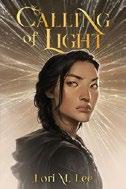
In this conclusion to the Shamanborn trilogy set in a fantasy world with Asian cultural influences, the bonds of friendship and family are strained to the breaking point by guilt and betrayal. With Prince Meilek now in power, Sirscha finds herself Shadow to the soon-to-be-crowned king, a position she once coveted. She’s now also a soulrender, a confidant and a symbol of hope for the newly freed shamanborn. Sirscha spends the first portion of the story navigating politics and evaluating the power players, which makes her seriously question whether she still wants the job of Shadow. The Soulless is still out there, however, seeking revenge on the Empire, regardless of who gets in his way. Because Sirscha’s the one best equipped to fight him—and because he is the cause of the rot endangering her best friend’s life—she’s drawn into the fray. Though they play important parts, Sirscha’s friends are less fully developed, while the focus remains on Sirscha: her choices, what could have been, and what still might be if she allows her powers to take over. Her empathy for the enemy creates friction with her sense of honor, but ultimately, Sirscha has made peace with her self-worth, and she decides what to do with her future in this story that digs into an orphan’s struggles to prove herself. This entry may not win new fans,
but returning readers will be satisfied.
A thoughtful final entry that brings closure for its protagonist. (Fantasy. 14-18)
Bad Like Us
Lepore, Gabriella | Inkyard Press (336 pp.) $19.99 | March 5, 2024 | 9781335453877

A trip to a private resort sounds like a great spring break—until someone dies.
At an Oregon beach resort, nine high school seniors from Seattle come together for an exclusive vacation. Eva and her friend Alice aren’t so sure about hanging out with popular girls Piper and Karly. But their friend Danny, Piper’s ex-boyfriend, seems to be in good spirits. Danny has invited Colton, his twin brother, and his friend Miles. Two of Colton’s friends are there, too—Noah and Javier, who’s also Piper’s current boyfriend. Tensions flare among the web of friends as they settle into the secluded beach lodge. As the group are drinking by the firepit one night, Eva goes for a walk on the beach and hears a “bloodcurdling sound.” The next morning, one of the friends is found dead—and the police think it was murder. Each of the eight surviving teens has something to hide, and if tensions were flaring before, they’re blazing now. Unfortunately, the characters are flat and feel reduced to their respective secrets; Piper and Karly are caricatures of vapid cliquishness, and the other characters’ interests are only briefly mentioned. Eva and Colton, who share the first-person narration, are the most fleshed out. Their alternating chapters are broken up by texts from various group chats, transcripts of Piper’s vlogs, and interviews with the police. Most characters are implied white; brown-skinned Javier is cued Latine, and Alice reads Black. A fun but ultimately forgettable vacation thriller. (Thriller. 14-18)
MARCH 1, 2024 149 KIRKUS REVIEWS YOUNG ADULT

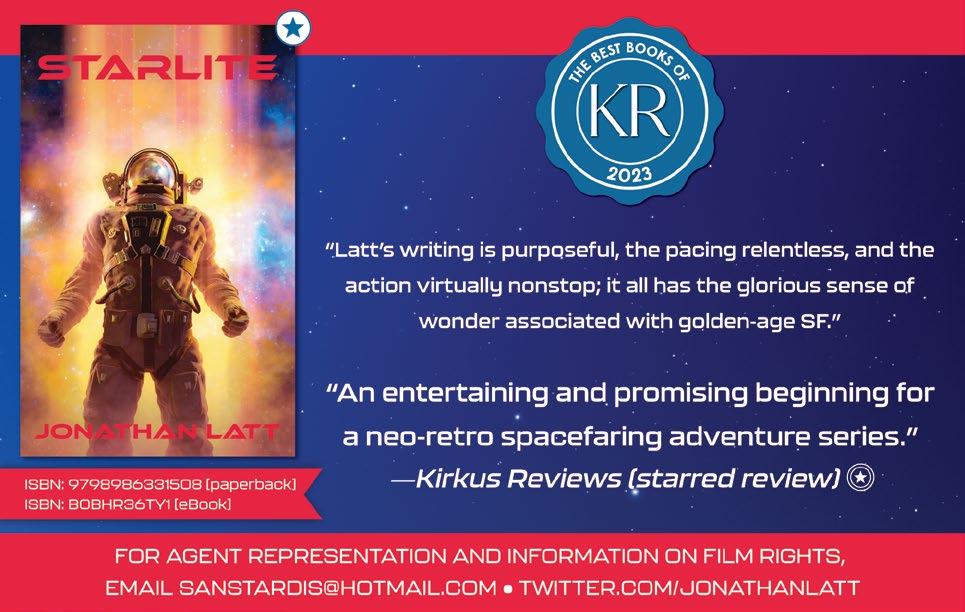
Book to Screen
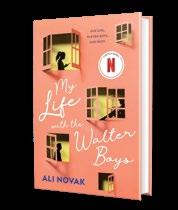
My Life With the Walter Boys Will Have Second Season
The Netflix series is based on Ali Novak’s 2014 young adult novel.
Netflix has ordered a second season of My Life With the Walter Boys, its series adaptation of Ali
SPONSORED CONTENT
Novak’s young adult novel, Deadline reports .
Novak’s book, published in 2014 by Sourcebooks Fire, follows Jackie, a teen girl who moves to a horse ranch with 12 children after her parents die in an accident.
The series adaptation stars Nikki Rodriguez as Jackie, alongside Noah LaLonde, Ashby Gentry, Johnny Link, and Connor Stanhope. The first season debuted on Netflix in December 2023 and garnered more than 12 million views in its first week.
Melanie Halsall, the showrunner for the series, told Deadline, “It’s been incredible. Phenomenal, actually. I think the audience response has just been so
SECOND LOOK
This review originally ran in the Dec. 15, 2023, issue.
Two teen girls accused of murdering their boss will be sent to their moon’s penal colony unless they can find the real killer.
Seventeen-year-old Aryl Fielding’s true passion is dance, but her coveted research apprenticeship at the Institute for Natural Exploration honors her parents’ sacrifices as immigrants from agricultural G-Moon Two to affluent G-Moon One. Sixteenyear-old black-haired and olive-skinned Ver Yun left her industrially ravaged home of G-Moon Three to
apprentice at the lab so she could search for a cure for the degenerative disease that has left her disabled. Aryl, who has “bronze skin and mahogany ringlets,” sees Ver as an opportunistic knowit-all; Ver thinks Aryl is a slacker who skates by on her intimidating physical superiority. When Investigator Cal Eppi, the girls’ supervisor, is murdered, the police automatically charge them, the immigrant offworlders. With only days left until their trial, they move from mutual distrust to working together. As their rivalry

overwhelming and enthusiastic and positive. We couldn’t have hoped for better audience reaction, really.”
Halsall also said she wants the writers of the show to “spread our wings” for the second season, while “still being true to Ali’s original story.”
“I was always thinking that [it] could be a long-running, returning series,” Halsall said. “That’s one of the reasons I love the book so much.”
Fans of Novak’s might get the chance to see more of her

turns to romance, they take on powerful people who are hiding big secrets. This dual-perspective tale maintains a vivid connection to each narrator’s voice while keeping up an exciting pace and unfurling a satisfying mystery. The portrayals of queer people, immigrant families, and those living with chronic pain and
books adapted to the small screen. Deadline reports that iGeneration Studios, which produces My Life With the Walter Boys, is developing a new show based on Novak’s Heartbreakers Chronicles series.—M.S.

Pangu’s Shadow
Bao, Karen Carolrhoda | (288 pp.)
$19.99 | Feb. 6, 2024
9781728477510
disability are well executed in this work, which is set in a world infused with Asian cultural elements.
Hard to put down: a strongly written work that pulls no punches while providing much-needed representation. (author’s note, discussion questions) (Science fiction mystery. 13-18)
BOOK TO SCREEN // YOUNG ADULT
Netflix
For books by Ali Novak, visit Kirkus online.
MARCH 1, 2024 151 KIRKUS REVIEWS
Nikki Rodriguez in Season 1 of My Life With the Walter Boys
An engrossing tale full of appealing characters and heart.
WHAT’S EATING JACKIE OH?
The Chaos Grid
Lewellen, Lyndsey | Enclave Escape (320 pp.)
$24.99 | April 9, 2024 | 9798886051063

A teenager with a dangerous secret is hotly pursued across wastelands devastated by eco-catastrophe in this Mad Max –style thriller.
Two hundred years from now, in a Texas that’s been reduced to a few fortified cities and farms surrounded by extreme storms and mutant wildlife, 17-year-old Juniper Conway hopes to escape a forced move back to the city where she was orphaned. She joins an outgoing convoy of venturesome commercial truckers. But as if the (un)natural hazards lying in wait along the route—ranging from sudden blizzards to gigantic tunneling terra cetus, or earth whales—aren’t bad enough, her murdered scientist parents left her with a key component to an addictive, strength-enhancing, widely abused nano drug they’d developed. Now, all sorts of bad actors are hot on her trail. Along with featuring reckless gangs of colorfully dressed whale hunters, metal spikes as fashion accessories, and high-tech body enhancements, Lewellen propels her dystopian tale on a bed of low-pressure romantic steam as Juniper, who reads white, is thrown into sustained contact with Dax Garza, the truckers’ hot Mexican lead driver, who has secrets of his own. Readers will certainly be on Juniper’s side from her initial escape until, in a memorably gross capper, she literally finds herself in the belly of the (cetacean) beast.
A dystopian thrill ride with room for sequels. (map) (Science fiction. 12-15)
Kirkus Star
Crash Landing
Li, Charmaine Anne | Annick Press (296 pp.) $19.99 | April 16, 2024 | 9781773218410
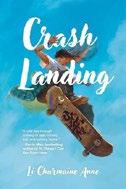
Skateboarding brings 17-yearolds Jay Wong and Ash Chan together in Vancouver.
It’s Labor Day, 2010. While she’s struggling to land a kickflip, Jay meets Ash, a talented skater who gives her some pointers. Jay learns that Ash is new in town, and that she’s going to be attending the same high school. They also bond over being Cantonese—and suddenly, Jay’s excited about senior year starting. At home, her mom and dad don’t understand her creative ambitions; her younger sister, a future doctor, is the star of the family. Jay and Ash become fast friends at school, and their romantic chemistry develops as they explore parts of the city that Jay’s parents want her to avoid. Jay begins filming and editing videos of Ash performing skateboard tricks, which opens doors for both of them: Jay builds a portfolio for art school using what she makes, and Ash is able to enter a competition after showcasing her skills on YouTube. Ash introduces Jay to a world of pushing boundaries and partying in which they find love and chaos. Candid discussions of the model minority myth and the challenges that their predominantly Asian circle of friends face deepen this layered novel. Surrounded by a richly developed supporting cast, Jay and Ash are caught oscillating between conforming to their parents’
expectations and rebelling because of them. Portraying their fears and desires with illustrative detail, Li delivers an impressive debut. A vivid, exhilarating ride.
(note on language and culture) (Fiction. 14-18)
Otherworldly
Lukens, F.T. | McElderry (352 pp.) | $19.99 April 2, 2024 | 9781665916257

In this Western mythology–inspired romance, a teen with a disdain for magic and an immortal familiar join forces to uncover the truth behind the relentless winter that devastates the region.
Before endless winter destroyed their family’s farm, 17-year-old Ellery Evans never questioned their parents’ devotion to the supernatural, but after five years of unanswered prayers, Ellery lets go of their faith and moves in with Charley, their cousin who lives in the city, seeking a steady paycheck as a real solution to their family’s problems. One night after work at the diner, they bump into Knox, the “hot weird guy” who never wears a coat when he picks up his takeout order. Danger follows in Knox’s shadow. During his last five years in the human realm, his goddess has mysteriously ignored all his attempts to contact her. Now, he’s hunted by her shades, who may be plotting against her. To stay in the human realm, Knox needs a contract with a human, or he’ll be powerless to fight the shades. At first, Ellery teams up with Knox reluctantly, but a complicated attraction soon stirs between them.
Amid looming, supernatural threats, Ellery confronts their insecurities over trusting others with the support of found family who challenge them to grow and affirm their self-worth. Both Ellery and Knox are cued white; Lukens’ characters reflect racial diversity in the world around the leads.
An irresistible elixir of romance and suspense. (Supernatural romance. 14-18)
KIRKUS REVIEWS 152 MARCH 1, 2024 YOUNG ADULT
Ruth Asawa: An Artist Takes Shape
Nakahira, Sam | Getty Publications (112 pp.)
$19.95 | March 19, 2024 | 9781947440098
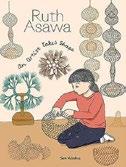
A graphic biography that paints a captivating portrait of a Japanese American artist’s road to success against the odds. The book opens with scenes of a teenage Ruth Asawa (1926-2013) working alongside her family—her Japanese immigrant parents and several brothers and sisters—on their California farm, where she daydreams of becoming an artist. But her reverie is abruptly cut short by news of the Japanese attack on Pearl Harbor. Asawa’s father was arrested by the FBI, while her mother and six of the seven Asawa siblings (one was living in Japan) ended up in an incarceration camp in Arkansas. A supportive white teacher helped Asawa get into a teachers’ college in Milwaukee, but when she was denied the chance to graduate because of her ethnicity, Asawa pursued her first love, art, transferring to the experimental Black Mountain College in rural North Carolina. There, she became embedded in a world of contemporary artists who were pushing boundaries, launching her own career as a celebrated sculptor. Nakahira’s lively black-and-white illustrations blend ink drawing with digital coloring. They convey her characters’ emotions as well as the wire sculptures for which Asawa is known. The spare text, which combines invented dialogue with reflections from Asawa’s first-person perspective, highlights with subtlety and touches of humor the obstacles women and Japanese Americans faced in mid-20th-century America. An inspiring, beautifully rendered book about an artistic dream that came true. (biography of Asawa, suggested reading, photos, image credits) (Graphic biography. 13-18)
Homebody
Parish, Theo | HarperAlley (224 pp.)
$26.99 | April 23, 2024 | 9780063319592
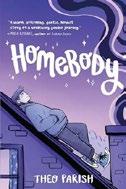
A gender-focused graphic memoir ideal for fans of Maia Kobabe’s Gender Queer (2019).
Parish breaks the fourth wall, introducing themself as a cat owner, a novelty teapot collector, and a transgender and nonbinary person. They employ the metaphor of a hiking trip, sharing their perspective on what gender means and feels like to them: “It’s okay…to make my own path.” The winding, meditative narrative recounts their upbringing, how they found belonging through art school, comic conventions, and tabletop role-playing games and their ever-evolving gender journey. The British artist thoughtfully reflects both gratitude for their body and feeling as if “it could do with some redecorating…renovating…trying things out…and seeing what works.” Thick, flowing strokes of color in pastel hues create a cozy and accessible vibe. Parish sometimes depicts themself with their torso drawn in the shape of a small house, representing moments of euphoria, growing understanding, and feeling at home in their body. They also show their own reflection in mirrors as a technique for illustrating deep introspection and perception. They take care to acknowledge that this is just one story of many, and that different possibilities for readers abound. Parish reads white; the pages feature people of varying racial identities, sizes, abilities, and gender presentations. The open-ended conclusion reminds readers that “we are all deserving of comfort and safety…a place to call home.”
An accessible, affirming story that models how anyone—cis or trans—can take steps toward self-knowledge and gender freedom. (sketchbook process pages) (Graphic memoir. 13-18)
Kirkus Star
What’s Eating Jackie Oh?
Park, Patricia | Crown (336 pp.) | $19.99 April 30, 2024 | 9780593563410
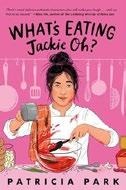
An aspiring teen chef breaks from stereotype to create her unique version of the American dream. Jackie, a sophomore at competitive Bronx Science in New York City, would rather cook than study, much to the chagrin of her Korean American parents, for whom success is defined by entrance into the Ivy League. Happiness for Jackie is Fridays with her grandparents in Bayside. Together they watch Burn Off! , their favorite cooking show, and she works in their deli, Melty’s, on Saturdays, where she enjoys inventing new dishes.
(Fans of Park’s previous outing, 2023’s Imposter Syndrome and Other Confessions of Alejandra Kim , may recognize the diner.) It’s at Melty’s that Jackie is scouted to audition for a new teen version of Burn Off! . She makes it onto the show, but the judges pigeonhole her, expecting her to cook Asian offerings, not the classical French cuisine she excels at. Can she convince them that she’s more than an ambassador for Korean food and assemble a winning meal representing the real, complicated Jackie Oh? Subtle layers of shame, sorrow, and pride within Jackie’s immigrant family ring true, and Jackie is thoroughly believable; her thoughts and dialogue feel snappy and fresh. A mild romantic interest appears but isn’t central to her story. Other characters, such as Jackie’s older brother, push back against the model minority trope, offering welcome evidence of the diversity of Asian American immigrant experiences. An engrossing tale full of appealing characters, foodie elements, and heart. (recipes) (Fiction. 12-18)
MARCH 1, 2024 153 KIRKUS REVIEWS YOUNG ADULT
Kirkus Star
Relit: 16 Latinx Remixes of Classic Stories
Ed. by Proudman, Sandra Inkyard Press (352 pp.) | $20.99 Feb. 6, 2024 | 9781335010018

The 16 short stories in this fantasy and science fiction collection center Latinx teen protagonists and their nuanced coming-of-age experiences through genre-bending reimaginings of classic tales.
Saraciea J. Fennell’s “Goldi and the Three Bodies” is a horror retelling of “Goldilocks and the Three Bears” that explores monstrousness and adolescent girlhood. “Shame and Social Media” by Anna Meriano offers a take on Jane Austen’s Pride and Prejudice that’s set on a spaceship carrying intergalactic teen vloggers. In “Evermore,” NoNieqa Ramos remixes Edgar Allan Poe’s “The Raven” into a story told in prose and verse that examines memory and coming out as queer. The contributors include many other popular and acclaimed Latinx authors, including Olivia Abtahi, David Bowles, Zoraida Córdova, Amparo Ortiz, Laura Pohl, and Ari Tison. Each entry completely transforms its source material into a fresh, culturally specific, and relevant new version. Woven throughout the stories are details that express each character’s Latinx heritage and traditions, even within fantastical settings. Propelling each original tale are undercurrents emphasizing themes such as the importance of personal autonomy, fate as a driving force in our lives, the power of love, and the transformative, freeing effect of believing in your own power. A diverse cast of characters leads each story, including a nonbinary protagonist and people from different socioeconomic, racial, and ethnic backgrounds. An expertly executed anthology remixing classics into empowering, modern vignettes. (contributor bios) (Speculative fiction anthology. 13-18)
Fate Be Changed
Rochon, Farrah | Disney-Hyperion (464 pp.)
$18.99 | April 2, 2024 | 9781368077958
Series: A Twisted Tale
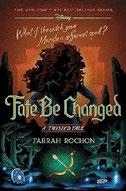
This fantasy/ romance story set in the world of the animated Disney film Brave reconciles Merida to her mother and her (slightly changed) future. Nineteen-yearold Merida believes that she’s “her father’s fierce lass, not her mother’s proper princess.” She wants to be free—to change traditions and escape her fate as a bride in a marriage of political expedience. After a heated clash with her mother, Queen Elinor, Merida comes across a witch, who gives her a magical cake that guarantees “a great transformation.” After eating it, Merida wakes up in the past, where she discovers that when she was Merida’s age, Elinor had similar fears and aspirations. The chapters switch between following the young Elinor and the time-traveling Merida. The narrative feels somewhat bloated, but the pace is generally swift enough, propelled by Merida’s need to help her young mother escape her betrothal and maneuver her future parents into love so that she can return to the present. A subplot follows another consequence of Merida’s consumption of the witch’s spell, one involving a Viking threat. Meanwhile, the spell is inexorably physically transforming Merida, while moments of reflection show that she’s changing emotionally. The medieval Scottish setting is not richly developed, but some vocabulary adds to the atmosphere. Readers see Elinor develop royal responsibility but never learn why her own past hasn’t helped her understand her daughter. The story refers glancingly to the film, but the novel can stand alone.
An entertaining and undemanding entry in a popular series. (Fantasy. 12-15)
The Merciless King of Moore High
Sparks, Lily | Flux (368 pp.) | $16.99 paper April 23, 2024 | 9781635830965
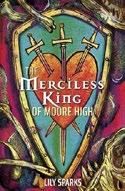
Teens in high schools that used to be rivals struggle to survive after the world ends.
Before, Kay Kim was Jefferson High’s Student Council secretary, famed for her inability to lie convincingly. For the past nine months, 18-year-old Kay, along with the rest of the student body, has been struggling to survive. Monstrous Growns, formed from the mutilated bodies of the town’s adults, have been killing indiscriminately. Despite sending out jocks to scavenge for food, Jefferson students are starving. The Council holds power through numerous laws. After they exile Kay, she’s given asylum by rival Moore High, where the students—under the rule of King Max, who’s inspired by an online medieval role-playing game, and Merlin, who calls herself a wizard—are well fed and battle ready. Kay hopes they’ll help save her school and find Kyle, Jefferson’s lost president, but instead she becomes embroiled in a tumultuous power struggle. The depiction of the current social hierarchy provides intriguing parallels with the Before times, and Kay’s challenges with dissembling and the importance of truth-telling are recurring themes. While the Growns are gruesome, the mechanics behind their creation require a suspension of disbelief. Similarly, the individual plot elements are intriguing and surprising, but they become overly complicated, diluting the impact of the new post-apocalyptic normal. The easily anticipated romance is a believable slow burn. Kay’s surname cues Korean ancestry; there’s some racial diversity among side characters. Thematically intriguing with shocking twists, but overly convoluted. (Post-apocalyptic. 14-18)
KIRKUS REVIEWS 154 MARCH 1, 2024 YOUNG ADULT
Kirkus Star
Darker by Four
Tan, June CL | HarperTeen (400 pp.)
$19.99 | April 2, 2024 | 9780063283848
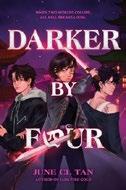
When a god of the underworld goes missing, the balance between worlds is upset, leading to an increase in the Blight, a supernatural virus, and the number of infected souls called Revenants.
Lin Rui is the top cadet at the Exorcist Guild; she’s skilled in combat against Revenants and possesses unusually high levels of magic due to the circumstances surrounding her birth. Her primary ambition is to exact revenge on the Hybrid monster responsible for her mother’s death. Rather than grotesque monsters, Hybrids are sentient Revenants who resemble humans—and many people don’t believe they even exist. Rui secretly visits a young man named Zizi, an eclectic underground mage who specializes in powerful spells, and feelings of attraction grow between them. Their fates become entangled with that of Song Yiran, a nonmagical normie, when he’s attacked by a Hybrid. When nothing else works, Rui uses one of Zizi’s experimental spells, transferring her magic to Yiran, who’s able to destroy the Hybrid, saving them both. Fearing the political repercussions of using Zizi’s spell, which has left Rui a normie and Yiran brimming with spiritual energy, the three seek to secretly reverse the spell. The tight narrative shifts viewpoints: One storyline follows underworld god Ten as he searches for his missing brother, Four, leading to a climax that pulls everything together. This duology opener is richly infused with Chinese and Southeast Asian cultural elements.
A darkly exhilarating ride rich with unraveling secrets and intrigue. (cultural note, author’s note) (Fantasy. 14-18)
A Different Kind of Brave
Wind, Lee | Interlude Press (224 pp.) | $12.99 paper | March 5, 2024 | 9781641609500
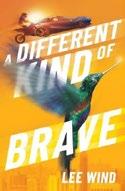
Queer teens get their James Bond moment—and then some. After his latest foster mom betrays him, sophomore Nicolas Hall winds up in a conversion therapy prison in California called the Institute. As inmate Number Seventy, Nico narrowly (but cleverly) escapes, promising to come back and save his friend Bec. Meanwhile, in Manhattan, James Bond–obsessed Samuel Solomon gets dumped by his boyfriend. Since “007 got his heart broken once too,” Sam tries to be “Bond-tough.” But it’s harder than it looks, and Sam’s therapist encourages him to focus on One Good Thing. Fate eventually brings Nico and Sam together in Mexico at a resort—though both of them are using aliases. Their romance is swift and sweet, until it all comes crashing down. The two boys get separated, but not before Sam learns the truth about Nico’s situation. As the police close in, can the would-be boyfriends bring down the Institute for good even when they’re miles apart? Wind’s latest effectively channels the Bond canon while reflecting the flaws of its poster boy’s toxic masculinity. The alternating third-person narration keeps the pace moving while also building anticipation of the boys’ first meeting. As the teens overcome each obstacle with almost debonair ease, this roller-coaster ride to a happy ending feels like wish fulfillment. Nevertheless, it’s refreshing to see queer kids saving each other—and finding love. The main cast reads white.
Thrilling. Positively thrilling. (list of aliases, author’s note) (Fiction. 12-18)

Dear Wendy
Zhao, Ann | Feiwel & Friends (368 pp.)
$19.99 | April 16, 2024 | 9781250885005

Two aromantic asexual college students face off online while bonding IRL. Chinese American first-year college student Sophie Chi (she /her) runs Dear Wendy, a popular anonymous Instagram account, where she provides relationship advice to her fellow Wellesley College students. She feels like she’s hitting her stride when a new anonymous Instagram account pops up, seemingly parodying her account. Fellow Wellesley student Jo Ephron (she /they), who’s white and has two moms, started Dear Wanda as a one-off joke for her friends. But as the account gains popularity, Wendy and Wanda begin to spar, creating a rivalry that wavers between playful and hostile. Meanwhile, Sophie and Jo meet as classmates and immediately strike up a friendship over their shared aroace identities, unaware of each other’s Instagram identities. As their friendship deepens and their online rivalry grows, the duo’s story hits all the beats and thrills of a will-theywon’t-they romance without compromising the deep satisfaction of an aroace love story. The first-person narration alternates between Sophie and Jo, although their voices are often difficult to distinguish. Still, their realistic concerns, excitement at their burgeoning friendship, and competitive sparring as Wendy and Wanda make them compelling protagonists. Relatable aroace concerns and conundrums provide an accessible window and mirror for anyone looking for quality representation that doesn’t tip into didacticism. Jo, Sophie, their friends, and their family members all have nuanced identities and strong relationships that enrich the narrative and worldbuilding.
The no romo love story aroaces have been waiting for. (Fiction. 14-18)
MARCH 1, 2024 155 KIRKUS REVIEWS YOUNG ADULT
For another page-turning queer thriller, visit Kirkus online.
Looking for new book releases, exclusive author interviews and book news?

Scan the QR Code to sign up now


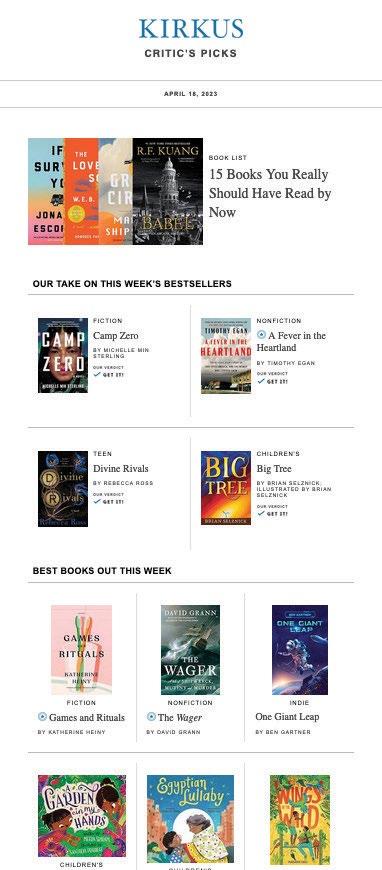


*CHICAGO STYLE* Title Case or ALL caps for CTA*
CALL TO ACTION HERE: *Can Use
TODAY! CRITIC’S PICKS EMAIL NEWSLETTER
SIGN UP
6 GraphicAbsorbing Novels
By
 By Molly
By Molly
5
49 Days
By Agnes Lee
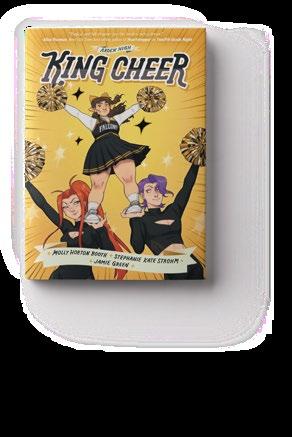

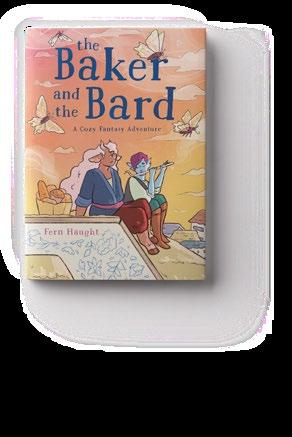

For

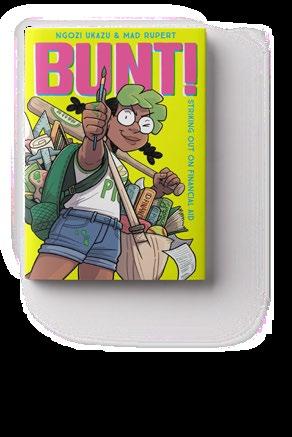
BOOKLIST // YOUNG ADULT
more compelling YA graphic novels, visit Kirkus online.
1 Call Me Iggy
Jorge Aguirre; illus. by Rafael Rosado; colors by John Novak
A pitch-perfect example of teenage explorations of cultural identity.
2
King Cheer
Horton Booth & Stephanie Kate Strohm; illus. by Jamie Green
High-spirited drama.
3
The Gulf
By Adam de Souza Evocatively captures adolescent earnestness and idealism for living meaningfully.
4
The Baker and the Bard
By Fern Haught Sweet and satisfying.
A moving portrayal of mortality and its aftermath, shown from both sides.
6 Bunt!: Striking Out on Financial Aid
By Ngozi Ukazu; illus. by Mad Rupert; colors by K Czap
1 2 3 6 4 5 MARCH 1, 2024 157 KIRKUS REVIEWS
A heartfelt story of passion, teamwork, and overcoming the odds.
Indie
SEEING THE WORLD THROUGH A PET’S EYES
ASK ANY PET OWNER, and they’ll tell you that they frequently have one-sided conversations with their companion animals—often on such topics as whether one’s furry friend is a good boy or girl. It’s just a short hop from such discourse to imagining what one’s pet is really thinking—and in these books, all recommended by Kirkus Indie, readers can enjoy stories told from the points of view of charming and sometimesheroic dogs and cats:
Darlene Dziomba’s 2022 mystery, Clues From the Canines, focuses mainly on Lily Dreyfus, a socially awkward animal shelter worker, as she investigates the death of a man she just started dating; he recently adopted a German shepherd named Burrow. Most of the tale is told from Lily’s close-third-person POV, but some sections are narrated by a Newfoundland named Nero Woof, owned by Lily’s close friend Mickey (whose own nickname is a reference to Mickey Spillane). Whodunit fans will
appreciate the hat tips, and our reviewer particularly enjoyed Nero’s sections: “The gentle giant’s cheerful tone is a welcome change from the staccato voice of the [third-person] narrator.” Here, for example, Nero prepares to meet with Burrow: “I know the drill, I’ve been through it lots of times, we each sniff, then we usually get some play time. I won’t be too exuberant but it’s hard. I’m a big guy; I have lots of enthusiasm.”
Scout of the Oregon Trail , a 2023 middle-grade historical novel by Todd Crickmer, tells the story of a stray dog in 19th-century St. Louis who’s adopted by a family with three kids on a 2,400-mile trek to Oregon City by steamboat and wagon train. “I promised myself I would be the best dog any family could have,” notes Scout, who goes on to perform many brave deeds to defend his new family from danger. The book is full of engaging historical facts for young readers, but the sweet-natured canine,
who narrates the tale, is the primary draw: “Scout’s love for and devotion to the Churchill family leaps from almost every page—he’s a dog every young reader will crave for their own,” writes Kirkus’ reviewer.
Lest we forget, felines also make excellent fictional characters, and Lisa Erixon’s 2022 YA novel, No Ordinary Cats, features several. The story initially follows two house cats after they’re adopted by a family who lives on a farm; their new humans give them new names—Riser and Dilly—and the animals, as they roam the outdoors for the first time, have adventures. Dilly decides to live with a group of strays in the woods, and a cat they meet,

Angel, becomes Riser’s companion. Angel later has two kittens as the result of an encounter with a stray, and Riser adopts the youngsters as his own: “Her family had become his family. And he promised himself he would do whatever was necessary to protect them.” The thirdperson narrative sticks closely to the cat characters and “captures the animals’ devotion to one another through the generations,” according to Kirkus’ reviewer, who notes the tale’s combination of charming moments and “tear-jerking losses, some peaceful and some decidedly less so.”
David Rapp is the senior Indie editor.


 DAVID RAPP
DAVID RAPP
KIRKUS REVIEWS 158 MARCH 1, 2024
EDITOR’S PICK
Queer activists’ fights for gay rights and other causes are explored in this probing collection of essays by Duberman.
In this work, the author, a City University of New York historian, has gathered pieces that appeared in the Gay & Lesbian Review and other publications, most of them biographical profiles that illuminate key aspects of the gay liberation movement. His subjects include Edward Sagarin, who broached the then-radical idea of gay self-acceptance in his 1951 book The Homosexual in America but later became a pariah in the movement for clinging to the belief that gayness is a psychological disorder; sexologist Alfred Kinsey, who exuberantly embraced a wide range of sexual behaviors as normal; Sylvia Ray Rivera, the celebrated
trans activist who argued for opening a carefully buttoned-down gay rights movement to drag queens; Andrea Dworkin, the radical feminist who denounced sexism in the gay rights movement; Joe Carstairs, a lesbian and champion speedboat racer who did whatever she wanted, gender norms be damned; and the group Queers for Economic Justice, co-founded by the author, which calls for solidarity between unions, socialists, and gay rights groups. Throughout, Duberman advances a stalwart radicalism: He advocates for building broad alliances between embattled minorities, rejecting rigid sex roles, celebrating erotic fluidity, and questioning monogamous marriage and the nuclear family. Duberman’s sparkling, whip-smart

The Line of Dissent: Gay Outsiders and the Shaping of History
prose mixes bracing political analysis with vivid, gossipy evocations of his subjects, many of whom he knew personally. His portrait of Dworkin, for example, brings out both her in-private gentleness— after an argument, she shyly presented him with a bouquet of flowers—and the strident maximalism of her theorizing (“She also reinforced my already
strong conviction that women, gay men, and people of color were involved in a common political struggle against a shared oppressor: the dominance of the heterosexual White male”). The result is an absorbing set of dispatches from the queer revolution. A colorful portrait gallery of gay leaders, full of compelling figures and challenging ideas.
161
By
162
163
By Katherine Davies
159
Martin
These Titles Earned the Kirkus Star
Family Ties Family Lies
Jacqueline Boulden
Managing the Unmanageable
& Peter Boatwright; illus. by Kurt Hess
By Jonathan Cagan
The Journey of Water
The Line of Dissent By
Design That Scales By Dan Mall
Voices From a Forgotten Letter By Seif-Eldeine
Duberman 170
180
Duberman, Martin | G&LR Books | 272 pp. $19.95 paper
Jan. 8, 2024
9798988815006
|
|
MARCH 1, 2024 159 KIRKUS REVIEWS INDIE
The Boohoo Boohoo Bear
Alston, Markedia | Illus. by Anastasiya Rudyk Self (32 pp.) | $16.99 | June 1, 2022
9780578370866
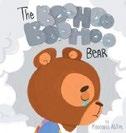
A melodramatic baby bear receives unexpected comfort in this picture book about toddler angst. When one of the Boohoo Boohoo Bear’s parents leaves for work, the cub is distraught. First, his ears flop down. Then the tears come, and he wails that no one cares about his misery. He stomps around the living room and slumps into a chair, claiming, “I’ll just sit in my DESPAIR.” But his mother has an idea to cheer him up, and soon she’s making a delicious chocolate pie that’s designed to lift her cub’s spirits. She offers it to him with the promise that she will always care when he’s feeling down. While there’s no investigation of why the bear is so unhappy and no grand peek into his feelings, that promise of comfort in the face of sadness does the trick. For parents familiar with toddler tantrums that seem to have no solution, the cub’s wallowing is sure to resonate—as is his mother’s loving decision to produce a tasty pie. Alston’s tale encourages young lap and independent readers to chime in on the large-print words ( flop, drip drop, stomp). In addition, the small amount of text on each two-page spread makes the occasional challenging word feel approachable. Rudyk’s bright, digital cartoon illustrations skillfully move the story forward, from introducing the problem in the opening pages to showing the cub’s transition from dismay to delight as soon as the smell of chocolate fills the air. A sweet, pitch-perfect treat for young readers (and their parents).

A Habit of Landscape
Armitage, Shelley | Finishing Line Press (64 pp.) | $34.61 | Oct. 13, 2023
9781599241753

Armitage’s body of poems draws from the earth, generations of family, and revery. The speaker is one with the grasslands, the farmlands, and the ancient landscapes that provide the settings of many of the poems. The imagery of trees and stones and a relic four-wheel drive transport readers to distant, quiet places where there’s room to meander alongside the speaker, whose memory dates as far back as dancing in the womb (“Invitro Bandstand”). There is a timelessness to this collection; the way memories live in the present through artifacts has a special way of transcending linear narratives. “In Aunt Alice’s Root Cellar” shows the speaker, sorting through 60 years of stored bric-a-brac under an inherited farmhouse, observing, “Out on these dry plains there was a vision of paradise. / Taking these steps one more time, in this scarab of self, / I realize death is making one light enough to leave.” In “A Butterfly Once Landed,” a mourning cloak butterfly and the speaker’s brother join forces in the Houston Botanical Gardens: “They had so much in common!/ Nymphalis antiope [sic] and multiple myeloma. / Both wore black wingtips. / Both were on oxygen.” Animals are revered, their histories considered as important as that of humans, in “Plainsong,” delivered from the perspective of an eagle: “You could read a long ancestral ecology from my nest, / reworked sometimes for over 100 years, / aerial dendrochronology…” The poem “Cecil” is dedicated to a beloved Zimbabwean lion killed by trophy hunters, his once-vibrant form reduced to humble remains. The speaker brings wonder and deliberation to the subjects of each piece. The formal elements of the work are masterful—the use of empty space on the page in some of the
poems, caesura, and the occasional inclusion of Latin terminology and (potentially) unfamiliar names of plants are a few devices that punctuate the verses and compel a deliberate reading. The poet has a way of extracting beauty from the most ordinary images, providing a reminder that everything in this world has significance, everything is connected, and we are all parts of an intricate web of life and death. The natural world and human nature unite in this essential collection.
Loves and Entanglements
Bogaty, Lewis | One Marble Desk Publishing (207 pp.) | Jan. 5, 2024 9798988405412

A volume of short stories explores the hidden but explosive nuances of romantic longing. In this assemblage of more than a dozen tales, Bogaty limns the fraught eccentricities that plague relationships between men and women with a perspicacious eye. In the first story, “Obsessed,” a married couple, Carol and Gary, meet a friend named Kempton for dinner. Kempton lives a soap-operatic personal life, one in which he is perpetually “at war with his corporate existence,” clinging fecklessly to his youth. But as messy and infantile as his romantic travails are, Carol can’t help but wonder if Gary is jealous of the adventurous uncertainty of these escapades. In “Hot and Sour,” Veronica, a 22-year-old woman, falls in love with Josh, a married man twice her age. After hearing Josh lie to his wife with an alarming expertise, she frets that her relationship with him is fated to devolve into a humiliating cliche. The stories focus on the foibles of attraction and the daunting distance that exists between erotic longing and a healthy, sustainable union, a theme intelligently expressed by the author. The pieces
KIRKUS REVIEWS 160 MARCH 1, 2024 INDIE
For more Indie content, visit Kirkus online.
often have a literary element to them—protagonists are sometimes students of English literature, and the stories include lots of references to works such as John Milton’s Areopagitica and Jane Austen’s Mansfield Park. While the stories include some allusions to their political backdrops—e.g., mentions of President Richard Nixon and the Iraq War— they remain only asides. Bogaty concentrates on the hyper-personal, which seems, in his vivid cosmos, largely sequestered from the political arena, though in one story, “Namby-Pamby,” political differences likely contribute to a couple’s romantic failure.
One charming aspect of the tales is the way in which they are dated—the author began publishing them in the 1980s. In “Obsessed,” Carol is purposefully set on getting the most out of her therapy sessions, given that they cost a whopping $75 each. But the author makes some missteps—“Obsessed” concludes with a commentary by Carol that gives the story a didactic tincture, one that only serves to undermine the tale’s power by commandeering readers’ interpretive territory. It doesn’t help that the conclusion—that the apparent movement of life toward a climactic peak is often an illusion, the “false hints of shape flattening into time gone by formlessly”—is somewhat trite. And in “Namby-Pamby,” Steven melodramatically explains to Brandy, a former flame, why he could never make their relationship work, a characteristic flaw of Bogaty’s writing: “Did you ever stop and ponder a jar of vinegar and oil?…No, I’m serious. You can stir it and shake it and it turns into a lovely mix, for a moment. But that’s it. You have to keep stirring and shaking forever to get the moments.” This image strikes a false note, one that feels not just maudlin, but also literarily contrived. Still, despite these occasional indulgences, the volume deftly displays an admirable sensitivity to the human frailty that always accompanies love. An impressively thoughtful and compelling collection of tales.
Kirkus Star
Family Ties Family Lies
Boulden, Jacqueline | Pine Place Press (322 pp.) | $16.99 paper | Jan. 30, 2024 9798986038438
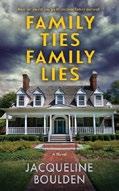
A woman caring for her dying mother probes her dead father’s infidelity and a string of bicycle thefts in Boulden’s luminous novel.
Rose Webster, a Philadelphia photojournalist, returns to her girlhood home of Lake Amelia, New York, when her mother Carly takes a bad fall after fainting. When Carly is diagnosed with stage three lung cancer, she opts to forgo treatment in favor of in-home hospice care. Much of the book fleshes out well-observed caregiving procedures as Rose (herself nursing a broken arm suffered when she was covering a strike) devotedly tends to sleeping arrangements, meds, and meals for the fading Carly. The compulsively curious Rose also makes time to delve into a rash of stolen bicycle reports that are being investigated by Maxi Stover, a by-the-book deputy sheriff whom Rose befriends and pumps for information about the thefts. At the same time, Rose explores a more intimate mystery when she unearths evidence of her deceased father Randall’s adulterous relationship with a woman with the initials KNT; when she asks Carly and her Aunt Tess about the affair, they angrily shut down her questions. Rose continues her own sleuthing and discovers answers that upend her understanding of her family’s history. Boulden’s story presents small-scale but beguiling mysteries backgrounded by a vibrant portrait of a small town that’s both warmly close-knit and slightly claustrophobic. It’s also a meditation on family love, loss, and remembrance, conveyed in plangent prose grounded in rich, concrete detail: “Her mom’s chin rested on her chest, lulled to sleep by the gentle motion of the car, the
passing view out the window of summer-green trees and open fields, and perhaps the acceptance of what lay ahead.” Readers will root for Rose as she seeks out truths that are as likely to wound as to heal.
A captivating saga that finds deep emotional resonances in quiet scenes of family life.
Skies of Blur
Burrell, Elijah | Eastover Press (74 pp.)
$19.99 paper | Jan. 23, 2024 | 9781958094433
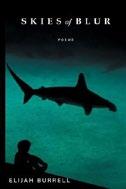
Burrell presents a deeply personal anthology of poetry. The author explores many themes in this evocative poetry collection, including family, loss, and social issues like mass shootings and Covid-19. Burrell’s strongest pieces touch on human connection and examine how people reconcile their past with their present, as illustrated by the piece “Midlife”: “Everything’s falling fast / like four decades of dominoes lined up / as something shaped like my life.” Much of the work is moving, like “This Is Asteroid Fell Out of the Sky,” which takes the form of a news interview mash-up following the 2017 mass shooting in Las Vegas. Burrell’s writing is vividly descriptive in its scene-setting, painting a clear and redolent picture of both the physical surroundings and the emotions contained in the verses, as in “Do Not Drive Into Smoke”: “That house had a cellar, / lightless, dingy, that smelled like pond mud, / like cigarette butts floating in a bucket / of rainwater.” Readers can feel the grief of the speaker in “Unable To Sing.” One of the standout pieces is “Exact Change Pantoum,” another example of the speaker contemplating one’s life and choices: “I followed loss through the forest and crossed fields… / …I had my head / in night clouds, and behind them years,
MARCH 1, 2024 161 KIRKUS REVIEWS INDIE
dulled stars, / like spit wads on a blackboard! I wasted all my breath / trying not to lose it….” Burrell’s pieces are sometimes more experimental in their composition, like the aforementioned “This Is Asteroid Fell Out of the Sky” as well as “Blind Spots Hide Motorcycles Look Twice: A Matching Quiz,” in which readers are tasked with matching up opposing statements that are poignant in any configuration they choose. A stirring and distinctively intimate compilation of poems.
Kirkus Star
Managing the Unmanageable: 13 Tips for Building and Leading a Successful Innovation Team
Cagan, Jonathan & Peter Boatwright Illus. by Kurt Hess | Rivertowns Books (210 pp.) $22.95 paper | March 5, 2024 | 9781953943415
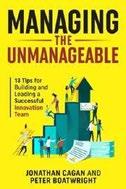
Cagan and Boatwright outline best practices for leading teams in developing breakthrough products in this nonfiction business guide.
Asserting that “nearly all innovation is done by teams” and that “innovation teams are not like other teams,” the authors, professors at Carnegie Mellon University, state in their introduction that they wrote this guide “to fill a gap in the knowledge base.” While there are many good books on innovation processes and methodologies (and on management and leadership in general), Cagan and Boatwright saw an unmet need to address the management of innovation teams specifically. What sets innovation teams apart is the fact that they’re “always trying to do something that hasn’t been previously done,” ideally producing a highquality result quickly. Despite the many unknowns and inherent unpredictability of innovation, the
authors posit that it’s possible to reliably optimize a team’s functionality by using management principles derived from Cagan and Boatwright’s considerable experience. They provide a toolkit of 13 best practices (“tips”) they have identified for leading such teams effectively, preparing them to anticipate roadblocks and respond creatively to unforeseen challenges. The authors also review traditional management styles and identify situations in which conventional management practices don’t work well with innovation teams, while approaches that may seem counterintuitive actually produce better outcomes, and they explain why. Beginning with the fundamental question “Why innovate?” the authors consistently emphasize the importance of creating value for customers and the company. Their best practices include managing the process rather than the outcome; building and nurturing the right team; balancing broad initial exploration with refining the best solution; reframing limiting beliefs; defining criteria for success; setting deadlines; establishing a price range for the final product early on; keeping up with new technologies such as AI; and using effective storytelling to engage stakeholders. Each tip concludes with a paragraph or two on how managers can apply it personally to their own work and professional development.
The authors, who established Carnegie Mellon University’s Integrated Innovation Institute, provide ample evidence to support their principles, including research findings from academic studies, real-world examples from well-known organizations including Apple, Ford, Nest, Waymo, DARPA, and various sports teams, and advice from experienced leaders at innovative firms and such luminaries as Peter Drucker, Daniel Goleman, and Benjamin Franklin. Their writing is consistently clear, straightforward, and upbeat, packed with excellent descriptions, logical explanations, and persuasive recommendations,
presented with empathy and humor (the book has a few tongue-in-cheek mentions of “Econ 101” when a mini-refresher on a basic market or business principle is needed). The text is also enlivened by numerous colorful illustrations by Hess. Throughout, Cagan and Boatwright suggest that readers should choose as needed from the various options presented rather than following a cookie-cutter approach. It’s likely that, after an initial read-through, many team leaders will find this guide handy to dip into again from time to time to review the tips most relevant to their current management dilemmas. An engaging collection of useful ideas for leading teams to tackle the unique challenges of innovation.
TeleShop USA
Cairo, Stash | Richards & Jones (355 pp.) $21.99 | Dec. 6, 2023 | 9798986395661

An aimless high school dropout challenges himself with a brand-new career path in Cairo’s novel.
It’s 1987, and Oklahoma City–based TV network TeleShop USA, anchored by a dynamic cast of seasoned presenters, has become a popular destination for shop-at-home customers. Hoping to leave behind his restless, vagabond, “unstructured” lifestyle, Robert MacKenzie, 25, waits in the wings to unknowingly seize the opportunity of a lifetime. MacKenzie desperately needs a job, and, despite having zero qualifications or experience in television production (and using falsified references), he interviews with company brass, shams his way through some practice pitches, and is providentially given the chance to prove himself at TeleShop. From this point, the narrative masterfully marches out a series of cleverly depicted program hosts, management personnel, and TeleShop employees. Chief among them is Dave Leonard, 43, better known as “the
KIRKUS REVIEWS 162 MARCH 1, 2024 INDIE
Dealmaker,” the network’s top salesman and TV’s unmatched “King of Bargains.” Yet fame has taken its toll, and Leonard has devolved into a snarky, heavy-drinking, unfaithful egomaniac recently dumped by his wife and estranged from his two daughters, living for months in a squalid roadside motel. As New York investors Triboro Media Group begin buying their way toward becoming majority stockholders and decision-makers at the network, management begins to nervously shift their projections and decisions accordingly. The novel works its charms through a series of dubious coincidences, as when MacKenzie takes a room in the same motel as Leonard and makes the most of their spontaneous orientation session, in which the new hire gets the lowdown on the company’s inner workings. As MacKenzie is drawn in deeper into the company’s fold as one of the newest “rare natural hosts,” things begin to fall apart, egos get bruised, rivalries simmer, and alliances form. Along the way, other ambitious and cleverly drawn peripheral characters spark to life within the TeleShop world, including the lonely, impulsive Yasmine Dubai, Director of Talent, who finds herself attracted to MacKenzie; lusty, unhinged assistant corporate counsel Sandiya King, who deceptively vies for Robert’s attentions; cutthroat network president Billy-Ray Newton; and Dixie Carter, aka “the Dragon Lady,” TeleShop’s other intimidating, highrevenue-generating core host, whose specialty is jewelry.
Though much of the plot contrivances are implausible and included for the sake of narrative thrills, the details about the machinations of the home shopping industry feel authentic and impressively well researched. Cairo taps into a niche market rarely explored in fiction and immerses his characters in the highstress, micromanaged nuances of successful on-air sales and the “steam cooker” atmosphere of televised commerce. (“‘For revenue calculation, we then examine each minute as a series of six, ten-second episodes.’ ‘Doesn’t that ever get the place feeling like an emergency room?’ ‘Exactly.’”) In addition to its sudsy melodramatic office
dynamics, Cairo’s book entertainingly taps into the beginnings of a market that would explode in popularity and profitability on multiple media platforms in the ensuing decades. Readers will cheer on MacKenzie as the formerly underachieving underdog tries to right his path and make the best of his life and career. Frenzied corporate machinations abound in this frothy re-creation of the early days of the home shopping industry.
Tread Loudly
Cherek, Kristine | Greenleaf Book Group Press (192 pp.) | $23.95 | Jan. 16, 2024 9781956072174

A businesswoman with more than two decades of experience in male-dominated industries shares her advice for working women.
Cherek, who writes that she was raised in the 1970s by a divorced “Gloria Steinem–loving, unapologetic feminist mom,” learned early on to be fiercely independent and nurture her drive for success. She did so first as an attorney, then as a corporate vice president, law firm partner, and law professor. Using anecdotes from her own life and those of her friends, she reveals the behind-the-scenes messiness that often came with being professionally successful. When a colleague once noted that she was overwhelmed with balancing work with the tasks of daily living—without the help of a stay-athome spouse, as many male colleagues had—Cherek revealed her secret: “‘My mom cleans my house. She does my laundry. She irons my clothes and puts them in the closet’.…That was the raw, brutal, truth. As a thirty-year-old professional woman, I literally could not have functioned as an adult with the career I had without the constant help of my mom.” The book reveals a dysfunctional corporate world in which workers don’t have time for
basic personal tasks, but it also reveals that it’s OK to ask for help. Interspersed with these stories are plenty of statistics that show how many women in the workforce are in tenuous positions. Each section concludes with “Key Takeaways” that highlight the most important points. Cherek is rightly proud of her career achievements, but she’s also charmingly self-deprecating throughout, as when she tells of attending the University of Wisconsin Law School “armed with a lifetime of good grades, a long resume of extracurricular activities, and the naïve ambition of a toddler.” While some readers may find some parts less appealing, as when Cherek boastfully claims that she never liked dolls or Disney princesses (which seems to suggest that women who do like such things can’t be strong feminists), her clear, to-the-point advice is likely to motivate professional women who’ve doubted their abilities and need a good pep talk.
A sharp guide with plenty of practical tips and emotional support.
Kirkus Star
The Journey of Water
Davies, Katherine | Spring Publishing (202 pp.) $15.99 | March 27, 2023 | 9781739184032

Davies’ novella follows one woman’s journey to find herself— on foot.
Elena Lees is tired—tired of her nursing job, tired of her boyfriend. Basically, she’s tired of her life. So, one day, the Australian ex-pat quits her job in London and starts walking. And walking. And walking. Save for the ferry from Dover to Calais and a couple of train rides, she walks from the bustling city of London through the beautiful countryside of France to the Alps. Elena’s journey is mostly premeditated—she takes practice walks and self-defense classes, and discards
MARCH 1, 2024 163 KIRKUS REVIEWS INDIE
needless possessions before her hike— but the journey itself brings some unplanned moments, including meeting (and sleeping with) a man dressed as a priest, picking up a guitar and soothing passengers on a stalled train outside of Paris with her music, and stumbling across an injured hiker named Dev, who helps her along her way. All the while, she often dreams, or hallucinates, about her mother, her co-workers, her former patients, and other people in her life. Eventually, the trek does its trick, and Elena is refreshed and ready to go—but whether that means back to London or forward to more adventures on the road is left up to readers. (“The only thing I know right now, is I have a mountain to climb. The rest will somehow become apparent. I strangely trust that.”) Though the book recalls Cheryl Strayed’s Wild (2012) and Jon Krakauer’s Into the Wild (1996), those bestsellers about isolation in the wilderness are much more menacing than this mild amble. Elena has her rough days, and one particularly scary tumble, but her journey is largely devoid of real drama, and that’s fine; instead of fearing what waits around the next corner, readers can enjoy the author’s lyrical prose and the endearing Elena. Davies has created a character and a scenario that many readers can relate to, and while most won’t shut their doors and set out to walk across entire countries, they will certainly relate to the impulse—and maybe learn a bit from Elena’s journey. A beautifully written tale of a woman trying to find herself via a walk through England and France.
Falling From Disgrace
Dietz, Tammy | Cynren Press (248 pp.) $29.00 | $17.00 paper | Nov. 14, 2023 9781947976450 | 9781947976481 paper
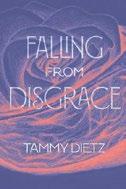
a region famed for its place in post-war progressive sociocultural and political movements, the author grew up in a deeply conservative environment. The book opens in 1976 as Dietz joined her family, devout members of the Church of Jesus Christ of Latter-Day Saints, on a vacation to Utah making a pilgrimage to “Mormon Mecca” to visit the Salt Lake City Temple. Awed by the city’s broad streets as a wide-eyed 9-year-old, Dietz recalls her father’s sincere explanation that, as a prophet and leader of the nascent religious capital, Brigham Young “knew there would be cars before there were cars.” The author’s childhood commitment to her family’s faith is juxtaposed with her later ostracism as a young adult when she ran away from home.
Does Anyone Love Me?: A Nature Odyssey for Children
Dussourd, David | Self (66 pp.) | $23.99 $14.99 paper | June 21, 2023
9798218194116 | 9798218229245 paper
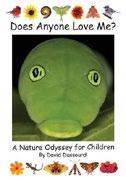
In this children’s book, colorful, detailed images of natural creatures and plants come with a request.
Dietz explores her religiously conservative upbringing in this debut memoir.
Despite living in California’s Bay Area in the 1960s and 1970s,
“Shamed and shunned” by her family and church as a sexually active teenager, she became disillusioned with the hypocrisy of a religion founded by a man whom she describes as “a cheating, polygamous, predatory hoarder of wives.” The author writes that she became cynical about the patriarchal nature of her tightknit Mormon community and “desensitized to [the] suffering” of her mother. While she frequently complained about being “stuck” in a one-sided, domineering marriage, her mother, per the book, was “willing to settle for helplessness” rather than push back against religious norms. With an MFA in creative nonfiction (Dietz was the editor of a literary magazine published by Pacific University), the author is a skilled writer whose engaging narrative effectively reveals how religious standards of devotion and piety can be abused by those in power. Her bracing condemnation of the church is balanced by a “softened…perspective” developed later in life that separates abusive power dynamics from nostalgic memories of the idealized faith of her childhood. In an effort to encourage other women who have been ostracized by religious families and communities, the book concludes with a list of “Questions for Discussion” for personal reflection or group discussion. A poignant, absorbing story of overcoming religious trauma.
“Does anyone love me even though I am such a skinny caterpillar / and I am so fat?” ask an inchworm and a caterpillar of a giant silk moth, helpfully labeled in bright, close-up photos. Luckily, children answer “We do! We love caterpillars, skinny or fat. They are cute and cuddly. / And they turn into gorgeous butterflies and moths!” A page of diverse, bizarre faces of caterpillars accompanies a photo of children holding the juvenile insects, unfazed; on a facing page are the winged adults, resplendent in a careful arrangement of glamorous natural hues. But flowers, too, worry that they won’t receive love—as do stick insects, raccoons, geese, and jellyfish, all represented in accurate, easy-to-parse, and, where possible, brightly saturated labeled photographs taken in the field by the author. Children answer that they love insects for their six legs and love “dogs, cats and other mammals” because they are soft, warm, and furry (a word of caution for touching raccoons might be interjected). Dussourd, a professor of biology at the University of Central Arkansas, casts a wide net when extolling the simple miracle of life’s variety. More animals step in—the many-legged, tall and small, young and old, insect-eaters and swimmers—to represent the vast diversity of the natural world. Young taxonomy enthusiasts will be thrilled to see so many lizards, bugs, slugs, and other creatures. Should we even love mosquitoes? The text is
KIRKUS REVIEWS 164 MARCH 1, 2024 INDIE
ambivalent: “If you don’t hurt me, I love you because you are beautiful in your own way…you are essential,” the omniscient narrator promises. Simple language and accessible, interesting photo images make this a great intro to animals for preschoolers. The author enthusiastically emphasizes the natural world’s bounty and encourages a lack of squeamishness when encountering novel living things. An addendum provides a guide to recognizing and avoiding harmful insects, which may require adult assistance for the youngest readers.
An exquisite, educational festival of animal photos to help preschoolers appreciate the natural world.
Firetrap
Eskin, Otho | Oceanview Publishing (320 pp.)
$27.95 | Jan. 16, 2024 | 9781608095704
Series: A Marko Zorn Novel, 3
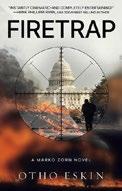
A detective investigates a homicide related to a new, powerful drug in Eskin’s mystery novel.
Washington, D.C.–based detective Marko Zorn arrives at a car fire that turns out to be a homicide; the person in the driver’s seat died in the blaze. Zorn’s then summoned to meet with local crime boss Sister Grace, who tells him there’s a new, lethal drug on the streets called Speedball, and that the gang dealing it is organized and dangerous (the ringleader goes by “Dr. Love”). Marko is able to identify the fire victim as a biochemist who worked with pharmaceuticals, including a painkiller called Zemlon. The investigation turns perilous when Marko confronts the mysterious Dr. Love and is assaulted by a couple of men likely under his command. Still, he continues to follow leads, both regarding the street drug Speedball and the massive pharmaceutical company, Altavista, that makes Zemlon (and is working on a new drug
to replace it). Marko gets stonewalled by everyone: Altavista, the FDA, and the new police chief, Kelly Flynn. It quickly becomes clear that the new medication is likely dangerous, and that the company making it is not above taking out anyone who is working to prove it’s unsafe. Marko investigates the connections between the pharmaceutical company, the street gang, and the shady capital management company that finances the pharmaceutical company. The mystery is complex, although it seems clear from the beginning that there’s a link between Speedball and the pharmaceuticals. Marko is a compelling character; he’s the archetypal cop who doesn’t always play by the rules, which puts him at odds with the powers that be in the police department, and he sometimes uses subterfuge and violence to get the information he needs to solve his case. (“I know your type,” the new chief announces. “You’re vigilantes at best and psychos at worst. There’s always one in every police department. Men—and they’re always men—who think they’re above the law.”) He maintains readers’ sympathy, though, because it’s never in question that he’s ultimately working on the side of good. The tightly constructed story moves along at a brisk clip. A complex, fast-paced mystery.
The Sixth Level: Capitalize on the Power of Women’s Psychology for Sustainable Leadership
Feiner, Stacy, Kathy K. Overbeke, Jack D. Harris & Rachel Wallis Andreasson
Amplify Publishing (312 pp.) | $30.00 March 4, 2024 | 9781637558560
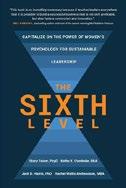
Feiner, Overbeke, Harris, and Andreasson present a compelling guide to compassionate leadership and living an interconnected life. Traditional leadership culture, per the authors,
has stressed power, profit, and competition. While this approach can yield short-term gains, such success comes at a high price for companies and individuals alike; as teams fight and fragment, underrepresented voices go unheard and employees are reduced to cogs in a corporate machine. The co-authors argue that these toxic cultures have been shaped by aggressively masculine values and winner-takeall dynamics that undervalue empathetic outlooks. Citing qualitative and quantitative research, they demonstrate that empathetic and human-centric leadership empowers collective growth, fosters happier teams, inspires corporate innovation, and increases bottom lines. (“These leaders have achieved profitability and sustainability by fostering relational cultures.”) Despite deriving the idea of “Sixth Level Leadership” from the five ascending levels of U.S. psychologist Abraham Maslow’s hierarchy of needs, the co-authors argue that self-actualization (Maslow’s top tier) is insufficient for lasting satisfaction; instead, they propose a higher form of realization called “Self-in-Relation,” asserting that interconnectedness is the ultimate form of fulfillment. The work’s tone is affirming throughout; the co-authors observe that limiting gender beliefs impedes the fulfillment of men and women equally. Highly analytical and drawing heavily from the fields of psychology and the social sciences, the work may feel more academic than many mainstream leadership books, although the presence of real-world examples, summarizing sections, and reflection questions will help readers of different backgrounds absorb and apply the information. By prioritizing a culture of respect, resilience, and love, the co-authors show that it is possible to create an inclusive leadership ideal that empowers all people to succeed. Insightful, engaging, and inspiring.
MARCH 1, 2024 165 KIRKUS REVIEWS INDIE
Scan the QR Code to listen now:
New episode every Tuesday


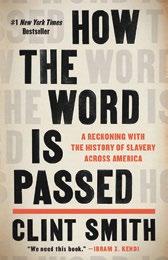


Helena Rozier
A POET REFLECTS ON HIS LIFE AND WORK
Before his death last June, George Franklin answered questions about his memoir,
Portraits From Life
Please tell us a little bit about yourself and your work. I grew up in Manhattan and on the North Shore of Long Island. I was dispatched to boarding school at age 11. Shortly thereafter, my grandiose childhood dream of being a senator was dashed when I realized that I was gay. My sophomore year at Harvard was interrupted when I was hospitalized with severe depression. Upon returning to school I read Ariel by Sylvia Plath in one sitting, immediately after which I was inspired to write several passable poems. It suddenly became clear that my vocation was to be a poet. I have begun to write prose only recently.
How did you choose your book’s genre?
Portraits From Life is something of a generic hybrid. It is part memoir and part critical study of a number of artists I came to know personally and whose lives and works I find both exemplary and admirable. Its first section consists of portraits of the eminent poet and translator Robert Fitzgerald, with whom I studied at Harvard; the editor and novelist William Maxwell; the choreographer Erick Hawkins; and the poet Marie Ponsot, whose poetry workshop I found revelatory and that I attended twice in my 50s. I delve into my identification as a gay man in discussing Maxwell’s The Folded Leaf, a superb gay coming-of- age
As a writer of prose, I simply feel an obligation to write as lucidly and gracefully as possible.

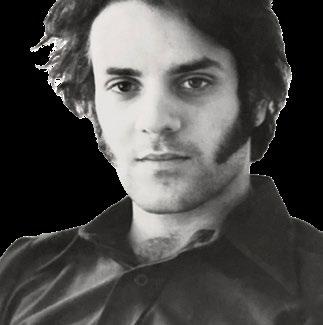
Portraits From Life: A Poet’s Mentors
Nicasio
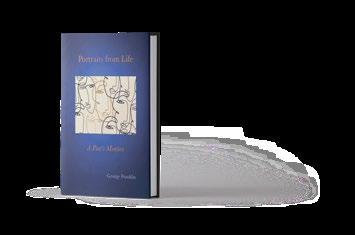 Franklin,
Franklin,
George
Press | 164 pp. | $16.95 paper April 13, 2022 | 9781737581451
novel that I have always found deeply moving. And I explore my sense of kinship with Hawkins, who was bisexual, and whose dances, which I likewise found moving, I attended on yearly pilgrimages to the Joyce Theater in New York.
The second section of Portraits deals with my changing attitude over time to the work of Robert Lowell. As a young man and aspiring poet, I felt antipathy toward his work. I had little sympathy with the confessional mode and was put off by what seemed to me a strain of reptilian cruelty in a number of his poems about his family. The last chapter of Portraits, informed by my own ongoing struggles with mental illness, attempts a more mature reappraisal of Lowell’s work and reflects an appreciation of the stamina and courage that must have been required to produce it.
Was your work influenced by any other queer texts?
Among the queer writers I admire the most are the usual suspects—Walt Whitman, Hart Crane, H.D., Djuna Barnes, James Baldwin, Elizabeth Bishop, and John Ashbery. Slightly less well known is the astonishingly brilliant work of the novelist and social chronicler James McCourt.
Who is your primary audience?
As a poet, I don’t identify with any particular school or espouse any prescriptive poetics. Nor do I have a target audience in mind. More recently, as a writer of prose, I simply feel an obligation to write as lucidly and gracefully as possible. I recently heard from a friend that his 97-year-old mother had just read and enjoyed Portraits. I would like to nominate her as my ideal reader!
Portions of the Q&A were edited for clarity.
SPONSORED CONTENT
Alphakazoo
Garcia, Edgar | Illus. by Darya Shch Nextcore (32 pp.) | $9.99 paper
Oct. 31, 2023 | 9781961166011
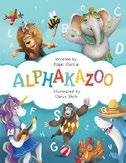
Garcia offers an animal-centric alphabet guide in this picture book. Like many traditional children’s alphabet primers, this book takes each of the 26 letters one at a time and assigns them to a related animal and situation. But the author isn’t satisfied with a single usage for each letter—instead, his sentences are jam-packed with alliteration, which makes for some incredibly silly circumstances that young children may find amusing (“Sienna the Spider surfs with silly sharks in sombreros ” describes the letter S). Each page also features extra elements in the background that begin with the featured letter, encouraging readers to find as many relevant objects as they can. There is no particular throughline from letter to letter and thus no overarching narrative; this debut picture book might instead lend itself best to being read selectively, rather than as a whole, especially for the youngest readers. Garcia sets himself apart by tackling the usually difficult letters with grace, introducing urchins for U, quokkas for Q, and xenops for X. Shch’s digital illustrations, as bright and playful as the text, tell their own self-contained stories on each page—for example, Ava the Alligator isn’t only avoiding aliens, as the text states; a closer look reveals that an axolotl is threatening her as well. A fun, mildly innovative addition to a familiar learning model.

A witty romp that’s sure to charm fans of Regency romance.
A BRILLIANT MATCH
Amerikaland
Goodman, Danny | LEFTOVER Books (283 pp.) paper | June 4, 2024 | 9798985107067
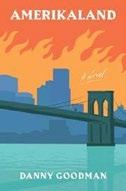
Goodman’s novel presents a vision of a grim American future in which two professional athletes confront escalating waves of discrimination.
The novel’s panoramic opening evokes that of Don DeLillo’s Underworld (1997) with its sweeping survey of the assembled audience for World Day, an international day of peace featuring an athletic competition held in New York City that’s reminiscent of the Olympics. Among the participating athletes are Sabine Hellewege, a native German and seasoned tennis star, and Sandy Katzmann, a Jewish American hometown hero and the shortstop for the local Brooklyn baseball team. Both are recovering from recent tragic events; Sabine was shot midmatch a few months ago by a mysterious assailant in Budapest, Hungary, and Sandy recently came home to find a dead Jewish boy he didn’t know on his doorstep, “battered and bloodied” and with the Yiddish word for traitor etched across his back in charcoal. Both are hoping for a return to normalcy on World Day, but it’s not to be; they and the assembled fans are instead met with sudden “light bombs,” which crumble the stadiums and kill over 120,000 people. Goodman effectively describes the scene with a choral we: “The concrete and earth beneath us give way. We are reduced. And when there is nothing left of our bodies, we become the air.” Later referred to as “the Event,” the catastrophic attack further alters the trajectories of Sabine’s and Sandy’s lives. During these middle passages of
recovery, the author deftly reveals the characters’ backstories in controlled reflections on their parents and their own shifting understanding of their places in the world. After grounding readers this way, Goodman picks up the pace considerably in the novel’s second half. Once the characters reunite in Berlin and Sabine is kidnapped, the twists come quickly in tense scenes that escalate earlier threats of violence. In his intertwining of personal tragedies with broader social issues, Goodman presents an unnerving picture of a world that seems not so far away.
A contemplative, richly imagined, and occasionally thrilling exploration of the near future.
A Brilliant Match: The Earl’s Sisters
Goutet, Jennie | Millefeuille Press (244 pp.) $14.99 paper | Nov. 15, 2023 | 9782494930186

The search is on for the perfect love match in Georgian London in Goutet’s first historical novel in a new series.
Lady Dorothea Rowlandson takes her responsibility as the eldest daughter of the late Earl of Poole very seriously: namely, that she should be using the London season of 1805 to find a husband with social credentials and a fortune to set her family up in English society. Of course, Lady Dorothea didn’t count on meeting Miles Shaw at her first London ball—a handsome, engaging, and well-spoken young man who’s in financial trouble. She immediately considers him an unviable prospect, but Miles, bewitched by her, tells her that he intends to restore his crumbling estate in Lancashire
For more Indie content, visit Kirkus online. KIRKUS REVIEWS 168 MARCH 1, 2024 INDIE
without a dowry. With this, Dorothea lets her guard down, and the two become friends amid a whirl of social occasions as the season progresses. Goutet situates readers firmly in the time period, from descriptions of dancing at balls (“Candles were lit in both grand chandeliers above the dance floor, and their flickering lights reflected on the glasses of champagne”) to depictions of the social customs of visiting among high society; it all creates a pleasurable jaunt through London. The author also excitingly portrays the push and pull between her two main characters, with Miles as the one who wants to marry for love and Dorothea aiming to find a person with the most secure fortune. The depiction of male friendship between Miles and his cousin, Lord Robert “Rock” Throckmorton, is also intriguing, since the latter complicates matters by being very rich and eligible. Rock is as much a confidant to Miles as Dorothea’s sisters are to her, which gives readers an entertaining window into both main characters’ feelings. A witty romp that’s sure to charm fans of Regency romance.
The Shadow Waiting on Its Throne: The Book of Scent
Hincker, Kevin | Self (330 pp.) | $15.99 paper | Aug. 14, 2023 | 9798987630181
Series: The History of Light, 3

The third installment of Hincker’s History of Light series takes its urban fantasy saga, featuring unstable former artist Asher Gale, in a much darker— and more apocalyptic—direction.
The story is set in Skysill Beach, an art colony on the Southern California coast that’s part tourist trap and part haven for “sighted” artists who use special ultraviolet paint to compel people to buy paintings. Gale is a possibly mentally ill alcoholic who, as the novel opens, has had visions of his own death on top of a terrifying “ghost mountain.” As tensions
rise between the Five Families—the factions that have kept the strained peace among supernaturally gifted people for generations—a critical Conclave is scheduled in Skysill. Meanwhile, Gale is seeing more and more ghosts and is suddenly able to see the circumstances of people’s future deaths when he touches them. He must figure out his place in a complicated world—one in which he’s trying to avoid a 500-year-old power-hungry painter, among other enemies who seek to murder him, and stay away from his psychic girlfriend, Caroline, as he believes that almost certain death will ensue. In addition, he must figure out how to defeat an “eternal ghost.”
Hincker’s novel suffers a bit from middle-book syndrome, as it lacks the excitement of an all-new storyline with fresh characters, as well as a satisfying conclusion. It also would have been improved by tighter editing. However, it still manages to deliver the goods, due to the storyline’s rapidly expanding scope, the relentless pacing, and the masterful use of multilayered tension. Gale’s premonitory visions, for instance, will give readers a grim feeling of looming disaster: “everything ends in three months.” But it’s Gale’s self-deprecating humor that keeps the pages turning; in one high-intensity scene in which Gale is told he should embrace his heroic side and become a “seeker,” he responds: “I have bruises on my bruises…I seek vodka and acetaminophen.”
Not the saga’s strongest volume, but an entertaining bridge book to what will hopefully be epic concluding installments.
Hell Is a World Without You
Kirk, Jason | Shutdown Fullbooks (314 pp.) | $14.99 paper Dec. 18, 2023 | 9781735492643

In Kirk’s debut novel, an American teen traverses his high school years while struggling to hold on to his Christian faith. It’s 2000, and 14-year-old Isaac
Siena Jr. is now a freshman in high school. As a conservative evangelical Christian, he faces numerous temptations in the secular school he attends. He (mostly) listens to Christian music, resists sexually laced thoughts about women, and tries to stick to a profanity-free vocabulary. All the while, Isaac is still tormented by the loss of his father years ago in a fatal car accident and the almost certainty that his non-Christian dad is in Hell. As high school passes by, the boy maintains cherished relationships with fellow Christians, including girls he may grow attracted to. He questions aspects of his religion, such as women not being considered as equals and homosexuality being outright condemned. He finds himself swayed by secular media and impious desires; as adulthood inches closer, Isaac must decide if he wants to leave his evangelical world behind. The bulk of Kirk’s narrative, which closely follows all four years of Isaac’s high school career, consists of theological debates. Sometimes they are internal, with an inner voice often chastising Isaac (its preferred refrain is the hilariously blunt “REGRET!”). In other instances, Isaac engages in Christian-themed discussions face to face or via the once-popular AOL Instant Messenger service. Although the author layers this story with humor, he meticulously examines Christianity as well; Isaac’s belief system, for example, seemingly holds women responsible for any and all sexual conduct (even when a man initiates it). This all comes through the teen’s endearing narration; he persistently apologizes for slip-ups (such as swearing), drops endless references to early 21st-century pop culture, and, along with many of his Christian pals, spells out forbidden words or simply replaces them with innocuous terms like gosh darn A consideration of evangelical Christianity that blends sublimely with a droll coming-of-age tale.

For more Indie content, visit Kirkus online.
MARCH 1, 2024 169 KIRKUS REVIEWS INDIE
Redeemed: A Memoir of a Stolen Childhood
Lane, Penny | She Writes Press (256 pp.)
$17.95 paper | June 25, 2024 | 9781647427009
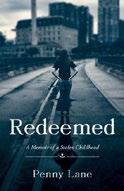
In this memoir, Lane revisits the twisting road she traveled to self-affirmation after suffering an abusive upbringing.
On a fateful day in 1963, 4-year-old Penny Lane was sitting happily on her tricycle, surveying her suburban New Jersey neighborhood, when a strange man walked up her driveway and began hugging her. Her Aunt Charlotte immediately appeared and began talking to the man; as Lane was to learn, the stranger was her biological father, a Hungarian immigrant who had come to retrieve his daughter and “take [her] home.” (Until that moment, she had thought that Aunt Charlotte was her mother.) Within hours, Lane was on a California-bound airplane, headed to Desert Hot Springs and a small, flat-roofed house, where an angry woman, speaking in a foreign language, greeted Lane’s father. After several days, the girl figured out that this woman was her stepmother. She would not see Aunt Charlotte again for more than 50 years. In 1965, things changed again: The family, which now included Lane’s half brother, Steven, moved to a small apartment in the Bronx in New York City. Lane’s “space” was the hallway between the kitchen and the bedroom, where she slept on a small cot. Treated as an outsider in the family, she was constantly derided, criticized, and beaten black and blue by her stepmother. In heartbreaking detail that will leave readers gasping, the author describes a childhood and adolescence filled with abuse that crushed her self-confidence and that her father did nothing to curtail. Lane desperately searched for love
and family, resulting in an early, disastrous marriage to a man who pulled her into an evangelical Christian church that almost broke her spirit. Articulate, emotional prose brings readers into the author’s struggle to reclaim her inner strength and begin a new life (“I felt a power…a strength in my physical being. My soul shifted. I would never stand down to him, or anyone, ever again”). Her intimate portraits of behind-the-scenes radical evangelical offshoots add disturbing, informative details to this personal story. A distressing but engaging chronicle of childhood trauma.
It’s Not Ewwww... It’s You!: Un-Yucking the Grossest Wonders of the Human Body
Leya, Sharon | Illus. by Janne Maru Self (28 pp. | $11.95 paper Nov. 21, 2023 | 9798986947389
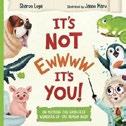
Leya explains some of the human body’s “yuckiest” processes in this picture book. In Professor Ewe’s science class, readers learn about bodily functions through humor, rhyme, and colorful illustrations. This short book will delight young children with its mild potty humor, especially if read aloud. But, beyond the laughter, children will also learn basic information about bodily functions. Gas in rhyming verse is described as: “Toot / Blaarrp / Braapp / Ffffff / Stinky gas might smell like poo, / but loud or soft or in between / it gets that air quick out of you!” Each function is described in rhyming verse laced with fun facts. More detailed information is included at the book’s end, such as “Sweat is mostly made of water and salt and acts like your body’s own air conditioner.” Maru’s full-color cartoon illustrations are colorful, and the engaging characters will appeal to kids. The illustrations support the story well and add a bit of whimsy, such as in the depictions of sweating animals as
Professor Ewe describes perspiration and its purpose. Ultimately, children learn that “our bodies are AMAZING. / Whether human, elephant or kinkajou— / And even though it’s sometimes gross…. / It’s not EWWWW! / …It’s You!” Overall, the story is a good steppingstone for student research. An entertaining book that makes science fun.
Kirkus Star
Design That Scales: Creating a Sustainable Design System Practice
Mall, Dan | Rosenfeld Media (240 pp.) $49.99 paper | Nov. 28, 2023 | 9781959029212
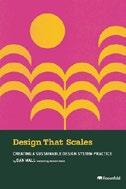
Mall offers a plan for implementing digital design systems that will suit all users. In his nonfiction debut, the author, a creative director, designer, and entrepreneur, lays out a detailed plan for making and implementing design systems in ways to make them useful and flourish rather than ending up in the “design system graveyards” he’s encountered many times in his long history of working with clients. He defines a “design system” as a software package “that contains the smallest set of components and guidelines a particular organization needs to make digital products consistently, efficiently, and happily.” Offering perhaps the most accessible example in the world—outlining how various Google functions such as searches, email, and documents all work the same way, at any scale, every time—Mall describes the ways such system designs are typically constructed and how they usually go awry. Addressing the ways things go wrong leads the author to a broader viewpoint that encompasses more than simple user-interface concerns. Mall champions a perspective that would ideally lead to a wider adoption of system designs and their components on the “cultural” level of corporations, all with the end goal of
KIRKUS REVIEWS 170 MARCH 1, 2024 INDIE
creating a toolkit everybody can use instead of re-creating each tool every time, because “Life and work have way more to offer than wasting your days making the same data table from scratch over and over again.” Mall conveys a vast amount of information with wonderful ease in these pages, which are full of colorful illustrations, tables, and even bits of code. He grounds his discussions of the various design system expressions in both annotated research and real-world examples such as Google and WordPress. The narrative tone throughout is both optimistic and gently chiding about the most common implementation mistakes he’s seen. His vision for design systems will be extremely useful to systems engineers at all levels. A lively and paradigm-challenging evaluation of what makes good system designs work at any scale.
Naked in the Now: Juicy Practices for Getting Present
McCandless, Marijke | O-Books (304 pp.)
$17.95 paper | July 1, 2024 | 9781803415673
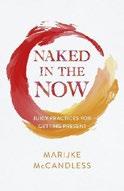
McCandless’s self-help guide combines spiritual techniques with nudity and intimacy.
The presence of the terms Naked and Juicy in this book’s title and subtitle, respectively, initially give the work the vibe of a sex manual, and chapter titles such as “Seeking Satisfaction,” “Getting Lucky,” and “Slipping Into Something More Comfortable” don’t dispel this impression. But the author ably goes on to show that there are many aspects of nakedness other than the erotic. Being unclothed, the author writes, also means getting in touch with one’s authentic self, which exists apart from social conditioning. The book offers numerous practices that aim to show readers how to access this self, beginning with counting one’s thoughts and letting each one float away during meditation, as well as physically lifting particularly
persistent thoughts up to the sky in one’s palm. Nudity is also characterized as a way to experience reverence; while bathing in a warm pool with other nude people at Harbin Hot Springs in Northern California, McCandless writes, she realized how beautiful all body types were. Shame is often associated with nakedness, but the author offers ways to heal from this self-perception. “Pink light” visualization entails imagining others with a loving glow, including those who’ve done us wrong. The author, who’s a sexual assault survivor, also discusses her reclaiming of the idea of being a “dirty girl” in the context of her erotic relationship with her husband. The book’s latter part deals with couples more specifically but effectively focuses on the emotional and spiritual aspects of their relationships. The book explores some dark themes, but McCandless maintains a playful attitude throughout most of it. She has a relatable style that reveals her own vulnerabilities in accounts of her husband’s infidelity and her negative thoughts about her own body. Her practices and techniques are inviting throughout, because they can be done anywhere, take little time, and require few additional materials. Refreshingly uncomplicated ways to improve relationships with a partner or with oneself.
Five Days in Bogotá
Moore, Linda | She Writes Press (304 pp.) $17.95 paper | May 14, 2024 | 9781647426125
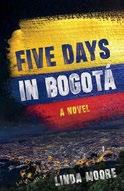
A gallery owner finds herself in over her head in Moore’s fastpaced novel of the early-1990s art world.
Ally Blake, a widowed mother of two and owner of a financially strapped art gallery in San Diego, risks everything to exhibit at a Bogotá art fair and hopefully make it big. Specializing in Latin American art, she’s joined by Uruguayan artist Mateo Lugano, who’s also hoping to get his big break at the fair. After struggling to get her crates full of valuable art—on which
her livelihood depends—free from customs, Ally notices additional paintings have been added to her collection. To her astonishment, the two mystery paintings are by Ponce Goméz, one of the most recognizable painters in the world, whose pieces go for millions. It’s revealed that David Martinez, an ex-boyfriend of Ally’s working in the U.S. State Department, is in Bogotá, conveniently at the same time that she discovers the Gomézes. After some prodding, David reveals that the American government has involved her in an off-the-books operation whose details are revealed later. Another shocking twist, which increases the tension of the already high-stakes narrative, involves none other than the notorious drug trafficker Pablo Escobar. Moore’s previous book, Attribution (2022), also involved stolen art, but this book presents a detailed, behind-the-scenes look at those who deal in paintings of a different era, while also offering all the elements of a nail-biting thriller. The author drives the narrative with the fact that Ally ultimately has no desire to add fuel to revolutionary fire in yet another South American country. It results in a pulse-pounding game of cat-and-mouse as she tries to avoid operatives of the U.S. government and the deadly cartel, as well as seedy art dealers trying to get their hands on the paintings. A beguiling adventure involving valuable paintings and international conspiracy.
Silver Vessels
Orlando, Steve | Illus. by Katia Vecchio Maverick (176 pp.) | $14.99 paper March 12, 2024 | 9781952303586

Three teenagers embark on a daring quest in Florida, where they use their ingenuity to find hidden treasure in this YA graphic novel.
Josh Friedman and his best friends, Hope Aguilar and Hunter Betancourt, leave suburban Virginia for a summer in the Florida Keys with Josh’s grandfathers. They plan
MARCH 1, 2024 171 KIRKUS REVIEWS INDIE
to search for a treasure horde connected with a sunken Spanish galleon, and Josh believes that three trinkets, deemed worthless by experts, provide clues that the treasure is buried under three nearby forts. Along the way, the friends have to contend with the Apex, a secret cadre of millionaires—classic villains who often wear shark masks to hide their identities. The Apex offer to team up with the kids for the treasure hunt, although the kids suspect that accepting high-tech gear from these devious adults could come at a cost. The camaraderie is infectious as Josh, Hope, and Hunter evade guards and find secret doors leading to caverns full of unexpected contents. Of the unexplained, fantastic wonders they discover, Josh simply says, “Everything here—it’s all just north of possible.” Orlando’s treasure-hunting scenes fly by at a fast pace, while sections where Josh interacts with his grandfathers sometimes drag. Vecchio’s visual style is clean, bright, and bold, and reminiscent of illustrations in classic series such as The Adventures of Tintin and Asterix but with a smooth, contemporary sheen. Relationships, gender identity, and sexual orientation are all prominent themes, as Hope is figuring out how to define herself and Hunter hopes that his crush on Josh might develop into a romance. Josh’s grandfather, Matt, and his husband, Ivan, reflect on their own challenges as a same-sex couple. An exuberant and thoughtful tale of adventure.
Tales of the Ravensdaughter:
Collection One
Rado, Erin Hunt | Self (305 pp.) | $27.95 $21.95 paper | Sept. 1, 2023 9798861413848 | 9781088066423 paper

who assaulted her—the mayor of the city of Navre. Following her lethal retribution, she flees, only to die at the hands of her pursuers. She awakens in “the Realme” and almost immediately stands in front of the spirit world’s rulers, the King of Shadows and the Raven Queen. Each one seeks her allegiance. She chooses the Raven Queen, who gives Alerice her dagger and the chance to “right wrongs done to others.” (“You may stand up for those who have no voice, those who truly need you, and in so doing you may discover your own path to self-forgiveness.”) Alerice, who travels between the Realme and Mortalia (the living world), completes various queen-assigned tasks, ranging from tracking down a mortal stealing souls from the Realme to helping repair potentially infecting breaches in the spirit world’s ether. Along the way, she garners welcome support from Realme herald Oddwyn as well as former army captain Kreston Dühalde, who’s courageous but saddled with a troubled past and an even thornier present.
But for Freedom: Across the Sea Beyond Skye
Rodger, Elizabeth | Lillibett Books (352 pp.)
$11.30 paper | Jan. 1, 2018 | 9781732585409
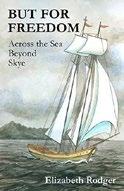
In this historical novel, a family strives for a new and better existence after the Scottish defeat in the Battle of Culloden in 1746.
In this epic fantasy, a woman becomes a powerful warrior in both the spirit and mortal worlds.
Tavern-keeper Alerice Linden seeks revenge against the man
Rado’s book collects six seamlessly connected novellas. After the first novella introduces Alerice and Kreston, each of the ensuing stories gets a bigger, richer cast and a more deliriously complicated plot. Kreston, for example, has a deeper tie to Alerice than she’s initially aware of, and every adventure they share strengthens their burgeoning relationship. The cast includes mythical creatures that genre fans crave, including kelpies, demon toads, and a “two-headed beast.” But recurring characters are wonderfully exceptional, including Oddwyn, who breezily oscillates between genders and pronouns, and the Realme’s rulers, whose bizarre union only adds to the volume’s curious pile of mysteries. The author keeps the riveting narrative moving by persistently coupling action scenes with shocking revelations. Most of the disclosures happen in the last two novellas, which end this collection in such startling fashion that readers will demand more tales.
Radiant, laudable characters and a gripping storyline fuel this magical collection of novellas.
Following their battlefield victory, the English forces are determined to punish the remaining Highlanders by burning their crops, killing or seizing their livestock, and pressuring them to flee. The Scottish MacKenzies, Donald and Morag and their children, eventually make it to the coast. But that proves to be just a respite with little future, so off they sail to the New World, specifically Virginia (on the way, their younger daughter dies and is buried at sea). Because they could not pay in full for the passage, Donald becomes indentured and treated no better than an enslaved person, while the rest of the family is taken in by a kindly widow, Mistress MacDiarmid (aka “Missiemac”), on her tiny farm. Robbie MacKenzie, not yet 13 years old, becomes the man of the house. The clan’s overriding goal is to save enough money to free Donald. Besides helping on the farm for room and board, Morag gets work in a tavern and Robbie in a print shop. Life is in many ways good to them; Donald is only a few miles away, so they can visit and keep up his spirits because his daily existence on a plantation is beyond cruel. But many tribulations lie ahead. Rodger is a very earnest writer. Her prose is somewhat arch, often reminding readers of an earlier time, as if she were channeling James Fenimore Cooper. For example: “Great was the need to replenish the fluids expended in the brawl” and “An amused twinkle” flitted “over his countenance at the youthful exuberance.” And there is almost a mismatch between some truly horrific and well-handled scenes of violence and misery, like the
KIRKUS REVIEWS 172 MARCH 1, 2024 INDIE
episodes below deck on the voyage, the brutalities on the plantation, and Morag’s almost dying in a blizzard (rescued by her son and the family’s heroic collie, Roy), and the happy events and developments. The upbeat episodes can be sentimental and tear-jerking (Dickens would be proud). Rodger is determined that her virtuous characters get what they deserve, even if it means obvious manipulation. Still, this is a story with a heart that will enchant readers who are willing to embrace the author’s feel-good liberties.
A captivating tale about a Scottish family’s turbulent journey.
Eleonora and Joseph: Passion, Tragedy, and Revolution in the Age of Enlightenment
Rodrigues, Julieta Almeida New Academia Publishing/The Spring (198 pp.) | $24.00 paper | July 21, 2020

In Rodrigues’ novel, largely set in the early 19th century, two prominent Portuguese intellectuals struggle to spread ideas of liberty while opposed by powerfully illiberal forces.
As a teenager, Joseph Correia da Serra fell deeply in love with Eleonora Fonseca Pimentel, a Portuguese noblewoman who was also a firebrand poet and intellectual. They planned to marry, but then Joseph suddenly left her; due to his father’s financial distress, he thought it more prudent to pursue a religious career offered to him with the support of the Duke of Lafões. Eleonora is devastated, but she goes on to become a notable author and the librarian to Carolina, the queen of Naples. But as Eleonora’s political views become more aggressively revolutionary, Carolina’s become more conservative. Eleonora finally becomes a fully committed Jacobin and the editor of the
progressive republican newspaper Il Monitore Napoletano, and she’s arrested for her views in 1799.
Decades later, Joseph, now in his 60s and famous for his achievements as a botanist, discovers Eleonora’s memoirs in Thomas Jefferson’s library while visiting his home in Virginia. Rodrigues conveys this emotionally gripping and philosophically lively story in two formats: Eleonora’s remembrance right before her execution, and Joseph’s conversations with Jefferson. Eleonora is effectively painted as a tragic figure; after Joseph left her, she endured an abusive marriage, and she paid a steep price for her political convictions. Joseph is shown to have never quite recovered from their separation; in fact, he devoted himself to his intellectual life at the expense of his emotional one: “I had split myself in two: I had crushed the emotional side of me, the part that had loved a young Portuguese woman with dark, contemplative eyes. The root of my spiritual alienation, if I could call it that, lay in this division.” The author’s research is impeccable, but her novel offers much more than historical edification; it’s also a riveting work of great psychological complexity.
A model of historical literature that combines scholarly rigor with subtle characterization.
All for You: A World War II Family Memoir of Love, Separation, and Loss
Romero, Dena Rueb | She Writes Press (344 pp.) | $17.95 paper May 7, 2024 | 9781647426545

Romero chronicles the courtship and separation of her parents—a Jewish man and a Lutheran woman—during World War II. After her father’s sudden death in 1980, the author discovered a box of letters at her parents’ house
dating back to 1938. While she’d grown up knowing her parents were refugees from Nazi Germany, they remained tight-lipped about what they had experienced to protect her. Romero’s relationship with her father had been difficult at times, and they frequently disagreed on politics; after his death, she finally came to understand his perspective. Emil Rueb was born in the small village of Guntersblum, Germany, the son of a successful Jewish businessman and vineyard owner. He met Elisabeth Bickel, nicknamed Deta, a Lutheran nurse, while she was working for a family in his village. Though Emil’s parents disapproved of him courting a non-Jew, and Nazi policies increasingly made the relationship untenable, they remained devoted to each other. In 1937, Deta obtained a nursing position in England. A year later, Emil emigrated to New York and then New Hampshire, intending to pursue a career as a photographer and secure passage for Deta, his parents, his sister, and her husband. As Europe headed inexorably toward war and Nazi policies became more restrictive, the possibilities for immigration narrowed. Deta and Emil spent over seven years apart, waiting to be reunited while World War II tore their homeland apart. Using her parents’ letters as a starting point, Romero retraced her parents’ steps in Europe, interviewed surviving acquaintances and relatives, and conducted extensive research to piece together Deta and Emil’s journey. The memoir includes photos and copies of important documents such as tickets, IDs, and postcards, which add a personalized feel to the narrative. Romero often intersperses her own reflections throughout the story. Though unable to reproduce exactly what her parents were thinking and feeling on some occasions, the author’s perspective as their daughter and her viewpoint of their history make this account uniquely poignant; as she writes, “May their story augment our understanding of the past.”
An affecting story of ordinary perseverance during terrible times.
MARCH 1, 2024 173 KIRKUS REVIEWS INDIE
36 Indies Worth

SPRING 2024
Kirkus presents Indies Worth Discovering , a sponsored feature spotlighting an array of fiction and nonfiction works recommended by Indie editors. Here readers can find a useful sampler that shows the excellence and breadth of Indie titles. Find pulsepounding thrillers, revealing memoirs, twisty mysteries, fiery romances, thoughtful business books, problem-solving self-help guides, and incisive poetry collections, among many other works. Searching for something new and exciting? Read on. Ripped paper:
SPONSORED CONTENT
Raul Ortin



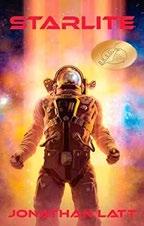
Holy Terror
By John R. Dougherty
Faith-based speculative fiction fans should enjoy this tale of an angel vigilante’s glorious journey.
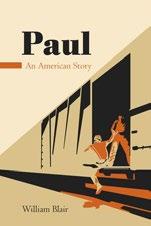
Deadly Keepsakes
By Anita Dickason
A fun rags-to-riches tale in an engaging mystery helmed by an appealing protagonist.

Restless
By Alicia Cahalane Lewis
A brief but memorable tale with prose that sings.
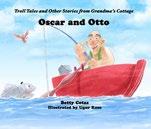
Paul
By William Blair
An enthralling celebration of an American cultural archetype.
Saving the Music
By Vincent B. “Chip” LoCoco
A historically bold and dramatically lively war tale.
Oscar and Otto
By Betty Cetas;
illus. by Uger Kose
A charming enemiesto-friends tale with big personalities.
Kirkus Star Starlite
By Jonathan Latt
An entertaining and promising beginning for a neo-retro spacefaring adventure series.
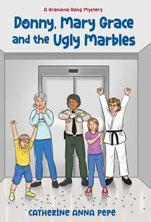
Donny, Mary Grace and the Ugly Marbles
By Catherine Anna Pepe
A warm, well-paced follow-up in an inclusive series that will keep readers coming back for more.
SPONSORED CONTENT

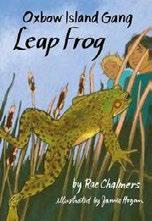


FDR Unmasked
By Steven Lomazow
An extensively researched and persuasive medical biography.

Oxbow Island Gang: Leap Frog
By Rae Chalmers;
illus. by Jamie Hogan
A tightly woven mystery that will leave readers excited to make changes in their communities.
French Holiday
By Sarah Ready
A charming dramedy featuring a promising sleuthing duo.
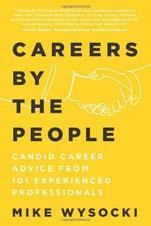

The Three Marias
By Donna Darling
A taut and often compelling novel of the Spanish American War.

All Things Under and Over the Sun and Stars
By Maurice James Blair
A quizzical, nonlinear journey through complicated SF plotlines involving philosophy and epistemology.
Careers by the People
By Mike Wysocki
A compelling examination of how to find satisfaction in today’s working world.
Open for Interpretation
By Alicia Blando
A contemplative consideration of incorporating astrology into daily life.
Immigrant Concepts
By Joachim O.F. Reimann & Dolores I. Rodriguez-Reimann
A well-researched and approachable survey of 21st-century immigration.
SPONSORED CONTENT
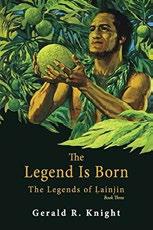
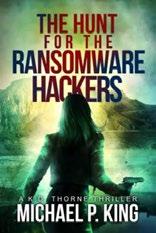

The Legend Is Born
By Gerald R. Knight
A slim but often effective coming-of-age story set in a Micronesia of long ago.
The Hunt for the Ransomware Hackers
By Michael P. King
The author ups the ante in this entertaining thriller series outing starring a troubled hero.
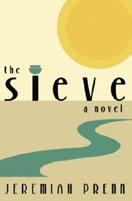
The Sieve
By Jeremiah Prenn
Dazzling and occasionally ponderous experimental fiction.

Hello, My Name Is Bunny! London
By Matt Bloom; illus. by Pippa Mayell
This romp’s adventures—and lessons in kindness— make a cat an adorable role model.
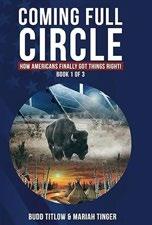
Coming Full Circle
By Budd Titlow & Mariah Tinger
An adventurous, passionate historical novel about an eco-friendly balance between humans and nature.

Of Mud and Honey
By Roxana Trabulsi
A gripping and emotionally affecting political tale.
Repurpose Your Pain
By Phinehas Kinuthia
A useful resource for readers looking to turn their pain into purpose.
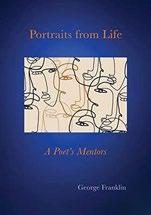
Kirkus Star Portraits From Life
By George Franklin
A revelatory, reflective, and gracefully drawn homage to a consummate group of poetic mentors.
SPONSORED CONTENT



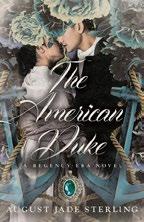
Orion’s Web
By Alexandra Manfield
A subtle, smartly crafted thriller that balances melancholy and hope.
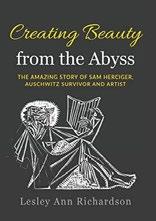
Transatlantic Train
By Vincent J. Miles
An impressive feat of historical research that illuminates the life of an unjustly neglected historical figure.

Legacy
By Chris Morehouse
A satisfying guide to comparable African and Christian teachings.
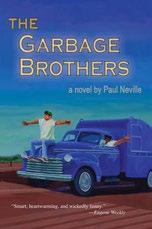
The American Duke
By August Jade
Sterling
An intriguing tale that pushes the traditional boundaries of its setting.

Kirkus Star
Creating Beauty From the Abyss
By Lesley Ann Richardson
A gripping, harrowing account of suffering and hard-won humanity.
Regenerative Agriculture
By Stephen Erickson
A well-written and informative guide to sustainable farming.
The Garbage Brothers
By Paul Neville
A colorful, bighearted novel about a summer of hauling trash.
The Courage To Be Courageous
By Dan Bolen
A provocative memoir, refreshingly candid and thoughtful.
SPONSORED CONTENT

Tomorrowville
By David T. Isaak
A cautionary tale of a cruel, authoritarian America of the future that’s leavened by barbed wit and irreverence.

Strangled by Simile
By Kelley Kay
A buoyant, frolicsome whodunit anchored by an unassuming, supersleuthing duo.
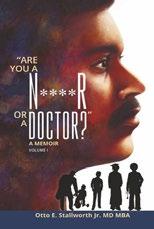

“Are You a N****r or a Doctor?”
By Otto E. Stallworth Jr.
A fascinating, moving memoir that focuses on one of the most tempestuous periods in American history.
Walking on Air
By Susan Powers
A highly personal, helpful, and affecting call to learn from life’s hardships.
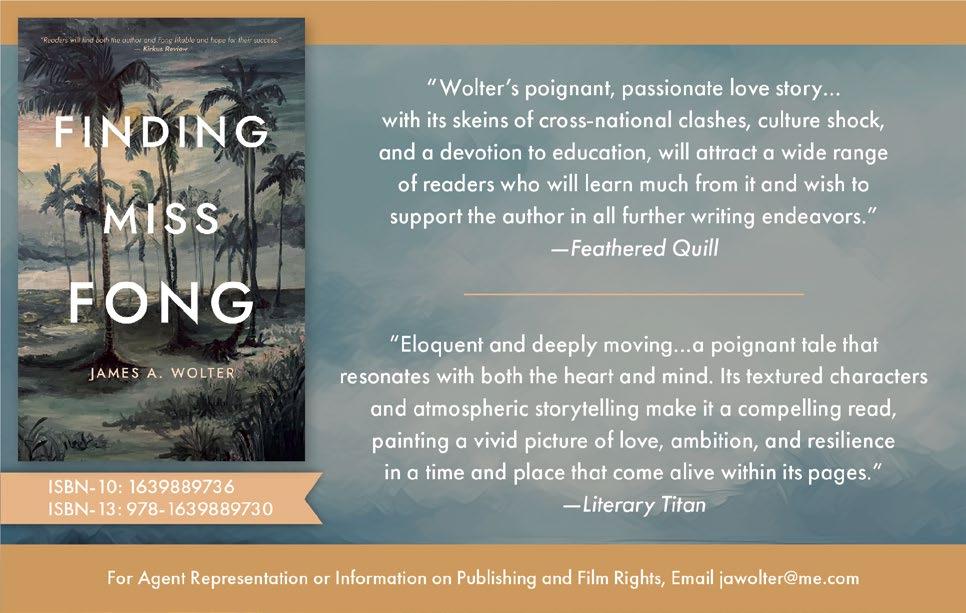
SPONSORED CONTENT
Fifty-Seven Fridays: Losing Our Daughter, Finding Our Way
Sack,
Myra | Monkfish Book Publishing (266 pp.) | $27.99 | April 2, 2024
9781958972250

Sack’s account of a parent confronting the death of her child presents a heart-rending tale of loss and survival.
In 2018, the Boston-based author and her husband, Matt, were happy new parents, raising their baby daughter, Havi. However, after Havi started missing some developmental milestones, they received upsetting news: She had Tay–Sachs disease, a rare genetic condition that stops nerve functioning. The form of the disease that she had is always fatal, and Sack and her spouse were told that Havi had only a year or two left to live. The emotionally shattered couple decided to forgo any treatment and to give Havi the best life possible in the time she had left. With support from family members, they took Havi across the country, enjoying simple pleasures of music, food, and nature. They felt acute gratitude and great sorrow, a tension that only grew stronger as Havi’s health foundered. After her death, Sack and her husband continued to find new ways to remember her. Sack’s detailed recollections of life with Havi effectively show her baby daughter as a person with personality and spirit. Equally compelling is the story of the author’s relationship with her husband, which grew stronger as they worked together to process painful emotions throughout their journey. Episodes from the family trip are broken up by the two parents’ touching letters to Havi. Sack concludes with many concrete and widely applicable suggestions about how to manage grief by honoring the people we have lost. The book contains many references to journaling, and this style of writing is the work’s weakness: Episodes from the
family’s journey are often overwhelmed by superficial details (such as who was at dinner each night, and what everyone ate), which makes the tone of the narrative feel less urgent.
An often-moving anatomy of grief that also affirms the enduring joys of life.
Kirkus Star
Voices From a Forgotten Letter: Poems on the Syrian Civil War
Seif-Eldeine | Self (53 pp.) | $9.99 paper Jan. 25, 2023 | 9798375000510

Seif-Eldeine’s debut chapbook acts as a vigil for the people of Syria.
Even when embedded, dedicated journalists can’t always fully capture the emotional cost of war and disaster. So, artists, writers, and poets step in to describe their impact for those who live beyond the headlines and to provide perspective to stories that might otherwise remain untold. In this chapbook, Seif-Eldeine chronicles the psychic damage of more than a decade of conflict in Syria, much like a reporter would; he oscillates between being an observer and a participant, conveying the experiences of ordinary Syrian citizens under violent oppression and intermingling them with accounts from first-person speakers who grapple with sacrifice and the sheer emotional weight of survival. In these works, war destroys even the most mundane objects and tasks. Prayer rugs become Kevlar vests in the poem “What Prayer Rugs Collect”; nuptials transpire in camps of those on the run from destruction (“Refugee Wedding”), and even the smallest pleasures vanish from everyday lives (“Who Wants French Cigarettes in Syria?”). Over the course of this collection, Seif-Eldeine is careful not to simply damn the perpetrators of violence, aside from president and dictator Bashar al-Assad. He considers
what motivates people’s support for al-Assad in “Talking Politics in Syria,” and he makes no value judgments about human losses on both sides; in his works, every soldier is a “wild / mouthed child of a war” (“The First Kill”). He records and honors the experiences of farmers, housewives, the highly educated, soldiers, and foreign-born nationals alike.
It’s the way the poet conveys these stories and alludes to his own personal burdens that’s so arresting and strikes so deeply. The poems convey grief without pity and pomp; the entanglement of sorrow and fury may catch readers off guard in lines such as “the pines we chop down / for Christmas: green and red. / Did the triage doctor mark me / green, or red like the sea?”
(“The Soldier’s Last Thoughts”) and “On days I am King, I give up / my lamb to my children. / Their stomachs are as empty / as a gun that has run out of clips” (“King or Queen for a Day”). In his Syria, neither death nor life has any dignity; bodies full of bullets expel excrement when retrieved, marriages buckle into isolation and abuse, and children are sold to pay for food and shelter. Concrete details are interspersed among lyrical accounts of such things as an offhandedly expressed death toll, al-Assad’s experience with dentistry (depicted as a metaphor for his tyranny), and the growth of refugee camps in neighboring countries. But Seif-Eldeine is most harrowing when he uses small moments and details to convey the true scale of suffering in an ongoing conflict, as when a woman paints in a blurry Van Gogh–like style because she lost her glasses in a bombing, or a farmer harvesting his crops remarks on his “watermelons larger than decapitated heads.”
A record of a country and people in crisis rendered in fearless, anguishing detail.

KIRKUS REVIEWS 180 MARCH 1, 2024 INDIE
For more Indie content, visit Kirkus online.
Murderous Means: A Southern California Mystery
Sideris, Lida | Level Best Books (272 pp.)
$16.95 paper | Dec. 5, 2023 | 9781685125004
Series: Southern California Mysteries, 6

An aspiring private investigator takes on a case at the behest of a psychic in Sideris’ sixth mystery in a series.
One week ago, 72-year-old JoJo Means, the matriarch of the wealthy but dysfunctional Means family, died alone in her well-appointed Victorian home in the tiny, elite Los Angeles suburb of Los Ranchos. There was no sign of foul play—she was found lying peacefully in her bed—but the deceased’s sister, Marti Means, is convinced that the fit, active JoJo must have been murdered, and Marti’s personal psychic, Heidi Honeyman, agrees. JoJo had signed a document stating that she didn’t want an autopsy (she “couldn’t stand the thought of being cut up in some lab,” says JoJo’s son, Bart), so Marti hires Corrie Locke, a junior attorney and not-yet-licensed private investigator, to dig into the evidence surrounding JoJo’s death. Corrie has a day job in the legal department of a film studio, but she and her assistant, Veera Bankhead, have been moonlighting as PIs. Corrie doesn’t think much of psychic intuition, although her boyfriend, Michael, pretends to be a psychic to attract supernaturally inclined clients, and Corrie isn’t afraid of bending the truth to get her small business off the ground. She’s initially skeptical that JoJo was killed, but as she starts sniffing around the Means family, she realizes there are several cash-strapped relatives with the motivation, and the means, to commit a murder—and maybe more than one. Over the course of this novel, Sideris writes in clean, taut sentences, inflecting moments of tension with humor: “A man lay on his side, arms bent in front of him, fingers clasped together. He could’ve been sleeping except for the pistol near his bloody head.” In Corrie, the author has created an endearing and energetic
protagonist who lies and trespasses with ease, and whose unusual weapon of choice is the Japanese throwing star (although she also carries a handgun, like many literary PIs). Overall, this is a well-plotted mystery that will surely win more fans to Sideris’ series.
A fun and finely crafted cozy L.A. whodunit.
Red Clay, Running Waters
Simmons, Leslie K. | Koehler Books (684 pp.) $28.95 paper | Dec. 19, 2023 | 9798888241714
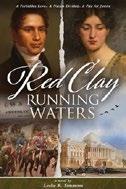
Simmons presents a thorough historical novel centered on the real life and legacy of Native American tribal leader John Ridge.
In 1818, a Cherokee teenager named John Ridge, whose birth name is Skaleeloskee, travels to a missionary school in Cornwall, Connecticut. There, he demonstrates his aptitude for academia and gets to know Sarah Bird Northrup, the white daughter of the school’s steward. Although Sarah reciprocates John’s romantic feelings, their relationship is met with various obstacles, including Sarah’s family’s disapproval of the union; John’s ongoing health issues, which have shadowed him since childhood; and the judgments of a racist society. However, they eventually marry, and the narrative shifts focus from their romance to ongoing conflicts between Native Americans and white colonizers, and John’s part, as a tribal leader, in various treaty negotiations. This climaxes in the signing of the Treaty of New Echota in 1835, which resulted in the cession of Cherokee land to the U.S. government. The treaty was extremely divisive, with the majority of Cherokee people opposing it. The decision by John, who aimed to keep his people safe, was seen as a betrayal by many Cherokees—including assassins who eventually took Ridge’s life. The novel effectively explores Ridge’s life, actions, and his integral role, not only in Cherokee history, but also in the broader
context of Native American relations with the U.S. government in the 19th century. His story reflects the difficult choices faced by Indigenous leaders during a period of profound upheaval. Simmons’ debut novel is well researched and clearly structured, with passages that shift between the third-person points of view of John and Sarah. The author handles these transitions deftly, without hindering the flow of the story or distracting from its themes. Simmons’ true talent is in adopting the cadence and syntax of the era’s language in a way that’s of the time, yet palatable for the modern reader: “As the blue light of evening’s chill encroached, the shelter, a satisfying meal, and prayers dulled the pangs of separation.” These factors all combine to make for a consistently enjoyable literary experience.
An immersive and engaging story of a prominent figure in Cherokee history.
Next of Kin
Skelter, Elton | Lethe Press (202 pp.) Feb. 14, 2024 | 9781590217764

Skelter presents a horror thriller about a gay serial killer romance in New York City. Jacob Mallory may seem like a mild-mannered graphic designer in his early 30s, but when the urge strikes him, he’s not above stabbing someone with a cheese knife in a Tribeca restaurant. Still, he’s careful to avoid capture and avoid identification as a serial killer. Naturally, he’s quite surprised when he’s summoned to Bellevue Hospital by someone he doesn’t know: A young man named Nathan McGuire is there after an apparent suicide attempt. Nathan happened to have Jacob’s business card in his wallet, making him a point of contact. When the young man is released, Jacob decides to take him home, thinking it should make for an easy kill. There’s only one problem: Jacob quickly takes a liking to Nathan; he may even love him. But just as it seems that the troubled newcomer could tame the
MARCH 1, 2024 181 KIRKUS REVIEWS INDIE
monster’s heart, it’s revealed that Nathan is not who he claims to be—and has a plan of his own. Skelter’s work moves quickly, alive with sex, violence, and plot twists. Some of the grim serial killer talk is familiar, as when Jacob mentions the “spiraling darkness” inside him. Likewise, the satirical moments can be on the nose, as when Jacob scoffs at someone who “did some unimportant job at some mid-level company producing something for no one in particular”—the type of thing one would expect from, say, the protagonist of Bret Easton Ellis’ American Psycho (1991). Still, Jacob’s odd touches of humanity make him a very different beast than Patrick Bateman, and Skelter is adept at building anticipation around his actions: If Nathan stays in the picture, how will he fit into Jacob’s life? Overall, it’s a fast-paced and thoughtful tale about killers craving some companionship. A page-turning story of murder and unexpected love.
It All Belongs: Love, Loss and Learning To Live Again
Smoot, Judy & Roy Smoot with Melinda Folse SparkPoint Press (299 pp.) | $46.95 Dec. 1, 2023 | 9780982696064

In this spiritual healing guide, the husband of an artist and therapist who died of brain cancer showcases her drawings and writings, as well as his own journal entries and poems.
In the winter of 2012, Judy Smoot embarked on an exciting new direction in her life: She’d enrolled in a two-and-ahalf-year certification course by the Expressive Arts Florida Institute. Later, she and her husband, Roy Smoot, sold their family home of 25 years in Westerville, Ohio, and relocated to a lovely rural cottage in the southeastern part of the state. In the fall of 2015, however, “came the nightmare we never anticipated,” Roy writes: Judy was diagnosed with glioblastoma—the same aggressive brain cancer that had taken the life of her beloved aunt. This book is Roy’s posthumous collection
of Judy’s expressive art (including mandalas with titles such as “Solace in the Cycle”) and journal entries, which often included meditations on biblical and other readings. Her writings date from prior to her diagnosis, during her treatments, and after she experienced a stroke; by the time of her death in 2016, she’d reached a state of spiritual acceptance. Roy also includes several of his own journal entries from the same time periods, and the book’s final section features the poems he wrote as he worked through his grieving process, culminating with the one that gives this book its title, which reads in part: “Love, grief / Joy, sadness / Laughter, sobs and tears / … / It all belongs.” Roy notes that reading Judy’s journals was a key element in his healing, and his inclusion of her thoughts in this book may offer inspirational support to others; she’d been a hospice volunteer and ran a nonprofit supporting the chronically ill. Both Judy and Roy (who are credited as co-authors, along with collaborator Folse) offer tangible ideas for readers facing similar circumstances—most particularly, they recommend engaging in expressive art and journal writing. Roy’s habit of writing in public, for example, led him to experience important conversations and make new connections.
An insightful and touching testament to enduring love.
America vs. Americans: How Capitalism Has Failed a Capitalist Nation and What We Can Do About It
Wade, Eric with Phil Herel | Forefront Books (304 pp.) | $26.00 | Feb. 6, 2024 9781637632369
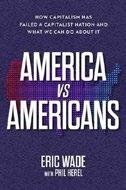
This nonfiction book offers an exploration of a simplified American mode of government.
Wade and Herel invite readers to consider a reformed government they call “American Laborism.” American Laborism aims to forge a federal government that abolishes much
of the bloat of the current system. While cuts are made, the model is not to be confused with libertarianism. American Laborism puts an emphasis on educating citizens in order to increase the value of their hard work. To start with, the federal government will be reduced to just three parts: the “Military Department,” the “Advancement Department” (sort of like the Department of Education), and the post office. While the roles of the Military Department and the post office are obvious, the Advancement Department would provide all Americans “unlimited, free, and lifelong education.” The beneficiaries include “people who have massive student loans, people who want to work for themselves, people who want to advance their education and then get a great job, and even people who want to stay in school forever.” The funding for this ambitious program would not come from a tax hike but in exchange for work. At a minimum, those seeking educational advancement would participate in one day of unpaid labor a week. The federal government would not be giving out money but rather opportunities. Many of these details are hammered out in portions of the volume where the authors engage in a dialogue with each other. In the world of books about how to fix America, readers will find it refreshing to come across something novel. Rather than clinging to far left or far right concepts, American Laborism creates something different. A system that aims to both lower taxes and create affordable education is one that certainly helps to bridge political divides. While this system provides much to contemplate, the presentation can at times get bogged down in finer points while neglecting larger issues. For instance, a discussion of what to do with excess federal employees after American Laborism is implemented may be relevant, but not much attention is given to what happens after beloved federal programs like the National Park Service cease to exist. Nevertheless, the concepts are well thought out and will spur further discussion.
An enticing look at government reformation that manages to bring something new to the table.
KIRKUS REVIEWS 182 MARCH 1, 2024 INDIE
Let Boys Be Kids First: Helping Boys To Be Who They Are and Feel What They Feel
Weaver, Raelene S. | Self (165 pp.) | $14.95 paper | March 29, 2023 | 9798987961704
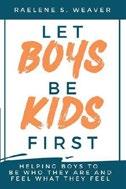
Boys and men are languishing under a code of toxic masculinity that requires them to suppress emotions and deny their humanity, according to this searching psychological study.
Weaver, a retired marriage and family therapist, argues that boys have as much emotional capacity and neediness as girls, but are held to cultural norms—injunctions like “don’t be a sissy” and “boys don’t cry”—that discourage them from discussing their feelings. In extreme cases, she warns, they may develop “alexithymia,” a disorder that renders them “emotionally numb or devoid of feelings.” As a result, she contends, boys are beset by anxiety, anger, and depression; are twice as likely as girls to be expelled from school; and have higher rates of alcoholism, drug abuse, violent crimes, and suicide. Drawing on her experiences counseling teen sex offenders, Weaver elaborates on Norbert Ralph’s “prosocial model,” which helps boys understand and regulate emotions to head off bad decisions. She calls for an overhaul of social expectations for boys and men, one that will license them to cry freely and talk about their sadness, body-image issues, and sexual insecurities. The author suggests interventions to help boys open up about their feelings, from the Let Me Run running club that encourages friendly camaraderie to schoolyard “buddy benches” that gloomy young people can sit on to signal classmates to come and comfort them. Pitched at parents and teachers, Weaver’s treatise combines insightful dives into social psychology with self-analysis questions—“Do you find yourself giving more hugs and affection to your daughters than your sons?”—to
get readers thinking. Her prose is evocative and down-to-earth in its depiction of the everyday psychic wounds of boyhood and the possibilities of soothing them. (“Instead of brushing off the event or simply flushing the fish down the toilet, he sat with his son and let him cry,” she writes of a dad helping his child cope with a goldfish’s death.) Traditionalists may bridle at Weaver’s vision of what manhood should look like. Among the nontoxic male role models she extolls is the South Korean pop group BTS, for its “neutral gender of masculinity” and “pastel hair colors.” Still, many boys and men will find her case for a more expressive, communicative, empathetic life to be compelling.
An illuminating, warmly sympathetic brief for replacing stoic, hard-bitten manliness with richly expressed feelings.
Artificial Wisdom
Weaver, Thomas R. | Chainmaker Press (368 pp.) | $29.00 Oct. 5, 2023 9781739434304
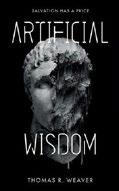
A fast-paced speculative thriller set in a morally desolate near future.
It’s 2050, and renowned independent journalist Marcus Tully is in a bad place. In the decade since his beloved wife’s death in an unprecedented heat wave, he’s struggled to find peace. As the story opens, he’s swilling artisanal rum before throwing the glass at a projected image of news commentators; the disaster that killed his spouse has become politicized—an event that some pundits claim never happened, despite evident international suffering. However, Marcus, unlike most other victims, has the knowledge and resources to fight back against this perception. In the run-up to a worldwide election, a mysterious whistleblower appears in Marcus’ life, claiming he has information about Marcus’ wife’s death, as well as tangible proof of major political figures
using dangerous tech to suppress the very constituents they’ve unhoused with irresponsible climate policies. And yet, the election that’s about to take place—filled, of course, with many of these same politicians—could be the last, best hope to prevent a climate apocalypse. As Marcus is drawn deeper into the darkness of a murder investigation, nothing is certain—not even his belief that his wife’s death was an accident. In this timely novel, Weaver seizes upon big-picture concerns of the real-world moment— including global warming, ethically bankrupt leadership, and the disintegration of trustworthy news sources—to create a vision of a future worth fearing. There’s also plenty of intriguing everyday tech scattered throughout—such as a sort of EpiPen that cures hangovers—that never seems far-fetched. The prose and dialogue aren’t particularly snappy, but readers inclined toward futuristic narratives about present-day issues will find this novel hard to put down. A taut tale with a disturbingly plausible what-if scenario.
Power & Light
Weaver, Will | Calumet Editions (390 pp.) $21.99 paper | Sept. 27, 2023 | 9781960250995
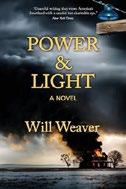
In Weaver’s historical novel, a Norwegian farm girl in North Dakota is assaulted by a prominent man, placing the family in a grimly precarious position.
In 1906, Karl Haugen, a low-ranking farmhand working for a despotic family in Norway, flees in the dead of night with his family to America. They settle in Skye, North Dakota, but Karl dies in 1925, and his wife, Petra, follows him to the grave shortly thereafter, leaving their four children—Emil, Dagmar, Sally, and Jenny—to fend for themselves on the family farm. In 1933, when Sally is only 17 years old, she is raped by the town doctor, Robert McConnell, while sedated during a medical procedure. She’s slow to tell anyone, especially Emil, now the head
MARCH 1, 2024 183 KIRKUS REVIEWS INDIE
of the family and prone to mercurial violence, since she believes no one will take her word over the doctor’s. However, she becomes pregnant from the assault, making the secret impossible to keep.
Emil leaves the baby girl that results with an unsuspecting family on a train and begins to plot a ghastly revenge upon McConnell, one as inventive as it is macabre, mesmerizingly depicted by the author (“The slimmest of trimming would make the boot rub slightly. Rub slowly. Over time”). The stoic Haugens are an unforgettable family; it seems impossible they could blend in well anywhere in the world. The author paints a bracingly unsentimental view of their toughness— Jenny draws this astonishing conclusion after the family weathers some terrible losses: “You’re never going to go soft on the world.” Weaver’s prose is beguiling, achieving a mercilessly spare poetry (“Ahead, a field mouse hung on a barb. A gray, masked bird sat nearby, a shrike, a bird who killed its own kind”) that perfectly matches the only kind of love of which the Haugens are capable: quietly inexpressive but also inexhaustible. This is an impressive literary achievement, a genuinely moving novel without a single line of treacly kitsch.
A consuming work of profound poetical depth and moral power.
Volk
Werkmeister, D. | Self (269 pp.) | $9.99 paper Jan. 29, 2024 | 9798873330720

A shape-shifter teams up with the FBI to take down a criminal organization.
Terri Watson is a hardworking and slightly harried agent for the FBI in Philadelphia, specializing in organized crime. Along with her partner, Marc Peterson, Terri has been investigating a ring of Russian mobsters led by Konstantin Kretzky. Concurrently, a series of murders have been committed in the city in which the victims appear to have been torn apart by wild dogs. While in pursuit of Dieter,
a money launderer working with the Russian mob, Terri and Marc witness a beast attacking their perp and begin entertaining the idea of werewolves. Alex Stepanova, a local university professor, wakes in a lab after being experimented on by Russian scientists to discover she possesses the power of shape-shifting. Alex becomes a sort of vigilante werewolf, targeting “bad boys,” many of whom seem connected to the Russian mob as well. After Terri and Marc learn about Alex, the three team up and work together to bring down their targets. Werkmeister’s story is engaging, with a couple of surprising twists, the biggest being the inclusion of lycanthropy in a police procedural (the refreshing premise is sufficiently rooted in realism to feel believable). The prose is accessible—not too descriptive, but rather spare and d irect—and the story is well paced. The characters are enjoyable, though Alex is undeniably the most intriguing; fleshing out the other players a bit more would be appreciated, but Terri and Marc are still engaging, particularly in their moments of humor (“I am not going to be Dana Scully to your Fox fucking Mulder, all right?”). The glimpses into their personal lives further endear them to readers. The ending, though satisfying, feels a tad abrupt and underwhelming. Still, Werkmeister’s unique premise, paired with a triedand-true crime drama, makes for an enjoyable mad-scientist formula. A thrilling detective story with a sprinkling of werewolves—who could ask for more, really?
Unsettled
Woodford, Laurie | Unsolicited Press (244 pp.) | $17.69 paper | Jan. 2, 2024 9781956692853
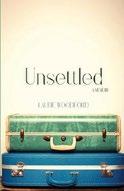
A middle-aged woman embarks on a yearslong adventure around the world in this memoir. Feeling a bit too settled (“like the soft sweatpants I’d
fish from my dresser drawer each Saturday morning”) in Rochester, New York, after her divorce, the 49-year-old author decided to let her growing feeling of wanderlust take the lead and headed to South Korea to teach English at a university. Each place that Woodford visited over the next few years, whether volunteering at an orphanage in Ethiopia or working on a goat farm in Spain, brought both the sense of adventure she so deeply craved and a nagging sense of loneliness: “The woman carried an Ethiopia guidebook in one hand. The man shouldered a small backpack. They held hands. They looked a team. I felt a warm flush of desire. They were explorers, together. Who needed a compass when they had one another? I named them the Travelsmiths.” When the author eventually found herself back in the United States, this time teaching at the English Language Institute of Arkansas, she experienced a growing relationship with the affable Bruce. The select stories that Woodford chooses to tell, such as her opening account of a gynecologist visit in South Korea, may not always be the most expected ones—they are, however, all highly entertaining. The author’s conversational tone and refreshingly frank language make the reading experience feel like listening to a friend’s fascinating travel stories. The narrative could benefit from added length—readers will likely be left longing for more details (perhaps about the logistics of living abroad) or for a deeper reflection on her emotional connections to each stop along her journey. That being said, what Woodford does include will leave many readers joyful, hopeful, and with the distinct feeling that anything is possible.
An amusing and heartwarming memoir that shows it’s never too late to begin an adventure.

KIRKUS REVIEWS 184 MARCH 1, 2024 INDIE
For more Indie content, visit Kirkus online.













Follow us on our socials for all the book recommendations and book-related encouragement you could ever need! @kirkus_reviews @KirkusReviews
New Picture Books From Names You Might Recognize!



From #1 New York Times bestselling author and cohost of the TODAY show Hoda Kotb comes a book about finding hope in ordinary places.

Bestselling duo Jamie Lee Curtis and Laura Cornell explain why waiting can be wonderful—and give young readers a reason to cheer all year round!
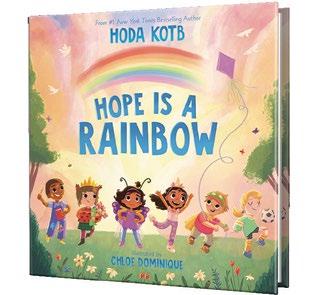
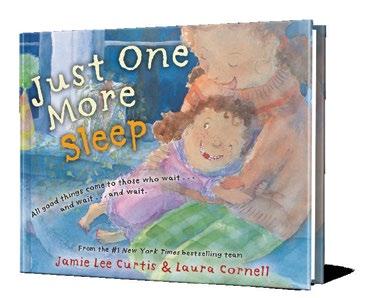
A celebration of self-expression from Jonathan Van Ness, New York Times bestselling author and star of the hit show Queer Eye.
 Photoby Jake Chessum/TrunkArchive
Photo by Danielle Levitt
Photoby Jake Chessum/TrunkArchive
Photo by Danielle Levitt
On Sale 3/5 On Shelves Now On Sale 6/4
Photo by Ol ver Bukowsky






 FROM THE EDITOR’S DESK
FROM THE EDITOR’S DESK



































 Novel by Taffy Brodesser-Akner
Novel by Taffy Brodesser-Akner

 Author Taffy Brodesser-Akner
Author Taffy Brodesser-Akner



















































































































































































































 By Ross Gay
By Ross Gay
 By Chris Anderson
By Chris Anderson
































































































































 By Nick Brooks
By Nick Brooks

















































 LAURA SIMEON
LAURA SIMEON



























































 By Molly
By Molly









 DAVID RAPP
DAVID RAPP






















 Franklin,
Franklin,




















































































 Photoby Jake Chessum/TrunkArchive
Photo by Danielle Levitt
Photoby Jake Chessum/TrunkArchive
Photo by Danielle Levitt